-
by
Daniel I. Rubenstein
| Dec 19, 2025
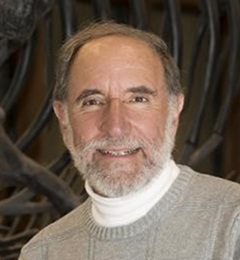
The last week of October was a busy week for Sigma Xi, as board members and chapter delegates assembled for the Society’s annual business meeting. It kicked off the 2025 International Forum on Research Excellence (IFoRE), an exciting virtual gathering of student and professional scientists from across the globe to present and share ideas around the theme of “Science and Society: Crafting a Vision for a Sustainable Tomorrow.” Insightful and engaging symposia, panel discussions, and keynote presentations explored topics on energy production, greener manufacturing, AI, science policy, and more. It was inspirational to hear from “Next Gen” student scientists, as well as our many award-winning keynote speakers.
After hearing the diversity of futures, a question emerged on how we can enable Sigma Xi to translate these ideas into reality. President-elect David Allison reminded members of the board and Chapter Delegates that science is wondrous, joyful, and awe inspiring. But how should Sigma Xi cultivate these feelings to foster science for all? Like David, I too focused on 3 words that I believe could enable Sigma Xi to craft a sustainable society for all—power, inspiration, and integrity.
Inspiration and integrity are the heart and soul of the Society and are ideals that are familiar to all. Sigma Xi inspires and cares about supporting honest, ethical, and integral science, rewarding those leading the way. But I suggest that power is underappreciated. While hard power leads to change, Sigma Xi will have little clout in shaping science policy. But “soft power” can energize and give our members agency to make a difference from the bottom up. Sigma Xi can be a powerful agency to create change. But to do so, we must retain and motivate our members and find ways to financially enable our chapters to demonstrate that science and the knowledge it generates can create sustainable tomorrows.
We have often sought ways of providing benefits to active members. But we also must focus on how chapters as collectives can act to better our planet. Accordingly, I challenged the board and the delegates to excite members to act locally. To paraphrase John F. Kennedy’s famous inaugural question, “Ask not what Sigma Xi can do for you—ask what you can do for Sigma Xi to help sustain Science and Society.” My aim is to gather the activities that successful chapters are doing, share them with all chapters, and raise money so that Sigma Xi can financially and logistically help chapters make science matter in their communities. Soon I will be reaching out to our chapters to learn what is helping create a sustainable tomorrow. Stay tuned!
Sincerely,

Daniel I. Rubenstein
Sigma Xi President
-
by
Daniel I. Rubenstein
| Dec 17, 2025

Way back in the 1960s, the United States created wide-ranging “alphabet soup” academic curricula to improve scientific literacy and the nation’s technological competitiveness. The Soviet Union had just launched Sputnik, and the United States now saw the urgency of educating our next generation of scientists. Hence, new curricula like BSCS (biology), CHEMS (chemistry), and PSSC (physics ) were established. This was 60 years ago, but I remember it well. It sparked my interest in science and launched my career!
During graduate school, I became a next-generation scientist, or Next Gen, and I worked to expand the study of animal behavior by helping create the field of behavioral ecology. We quantified natural history, modeled animal decision-making using game theory, and tested our models via manipulative experiments, all to help unravel how the environment—both the physical and the social—shape behavior.
Given that the U.S. government is now suppressing any scientific endeavor that does not support its political or economic interests, many scientists of my generation feel that we are at another “Sputnik moment,” one not created by an outside threat, but rather created from within. When Sputnik was launched, President Dwight Eisenhower signed the National Defense Education Act, and the NSF and NIH sprang into action to create the aforementioned curricula, the benefits of which are now crystal clear. Today, sadly, no top-down action is likely to rescue science and maintain the pipeline of talented youngsters displaying moxie, creativity, and entrepreneurship. Instead, the challenge must be met with bottom-up action. And this is where Sigma Xi and its members must play a leadership role.
It begins with our virtual conference, the 2025 International Forum on Research Excellence (IFoRE), where scientists of all ages come together to share interdisciplinary research insights. With the theme of “Science and Society: Crafting a Vision for a Sustainable Tomorrow,” IFoRE ’25 will welcome hundreds of STEM students presenting their research and sharing their vision of what a sustainable tomorrow looks like.
Furthermore, because Sigma Xi is a network of Chapters, we should seek to expand the Society’s ability to accelerate and advance the imagination of Next Gens worldwide. When I was president of the Princeton Chapter, I worked with Rush Holt—then deputy director of the university’s Plasma Physics Lab and later our region’s U.S. congressional representative—to create the Science Advisors Program. We collaborated with science directors from local pharmaceutical companies and superintendents of local schools, to implement hands-on science kits that encouraged thinking, hypothesis generation, and testing of predictions at all grade levels. It made a difference. Given that today’s students have not performed well in science on the recent Nation’s Report Card, it is clearly time for Sigma Xi scientists to get involved again and figure out how to find, mentor, and nurture the new Next Gens.
Challenge your chapters to get involved. Otherwise, I fear that the nurturing of minds to solve the scientific problems confronting society today will fall by the wayside. And please share your ideas with me at dir@princeton.edu so that I can broadcast them widely to our members.
Sincerely,

Daniel I. Rubenstein
Sigma Xi President
-
by
Daniel I. Rubenstein
| Jul 01, 2025

I’m pleased to invite you to help shape the program of the 2025 International Forum on Research Excellence (IFoRE), Sigma Xi’s annual signature event celebrating the pursuit and practice of research excellence. Our theme for this year—Science and Society: Crafting a Vision for a Sustainable Tomorrow—reflects our shared responsibility as scientists and engineers to ensure that research advances the well-being of humanity and our planet.
IFoRE '25 convenes Sigma Xi members, our colleagues, and students to promote fellowship in science and engineering and the advancement of knowledge through ethical research, service, and mentoring. This year’s conference will be held virtually, with all sessions conducted via Zoom.

Sigma Xi is now accepting general session proposals that reflect the depth and complexity of the scientific enterprise. We encourage you to submit a proposal for a session that highlights the many ways research contributes to a sustainable future. We are trying something new this year. The committee will review the titles and abstracts and craft sessions that build around a collection of illuminating papers.
We have already received several compelling proposals, many of which focus on the promises and implications of artificial intelligence across scientific disciplines. While these sessions are sure to enrich the conference, we are also eager to broaden the scope of IFoRE to reflect a more comprehensive range of scientific topics and sessions that serve all career stages. We especially welcome proposals that:
-
Address innovative scientific investigations and interdisciplinary collaborations
-
Support students and early-career researchers with practical tools, mentoring, and professional guidance
-
Foster meaningful networking and community-building across generations of researchers
-
Explore the societal impact of research and new models for ethical, reproducible science
-
Areas ranging from chemistry to ecology to molecular biology to agriculture to energy to controlling disease transmission and improve human health and well-being to name a just a few areas will have much to say about how science can shape tomorrow in sustainable ways--ways that improve livelihoods, reduce stresses on the environment and limit planetary stressors.
IFoRE sessions can include panels, mini symposia, interactive workshops, public interviews, or individual talks. Your talks, though, are the keys to creating these learning fora. We are looking for papers that address:
-
Research Practice (ethics, open science, interdisciplinary collaboration)
-
Broader Impacts (science communication, policy, entrepreneurship)
-
Professional Development (grant writing, publishing, mentoring, career navigation)
-
STEM Education (K–12, undergraduate research, teaching innovations)
Our goal is for every IFoRE session to provide actionable insights, spark new ideas, and inspire excellence in research and scholarship in ways that chart a course for a better future. Whether you are a seasoned researcher or a rising scientist, we hope you will contribute your voice and vision to this year’s program.
Submit your session proposal today! Proposals will be reviewed and accepted on a rolling basis, and the IFoRE program committee may assist in shaping your concept by recruiting expert participants or co-presenters.
To submit a proposal or learn more, visit experienceIFoRE.org/submissions. Questions may be directed to programs@sigmaxi.org. If you don't submit a proposal, we hope you'll attend the conference online. Registration is now open at experienceIFoRE.org.
Let’s work together to make IFoRE '25 a dynamic and inclusive space for ideas, collaboration, and solutions. I look forward to seeing your proposals.
Sincerely,

Daniel I. Rubenstein
Sigma Xi President
-
by
Jamie Vernon
| May 16, 2025
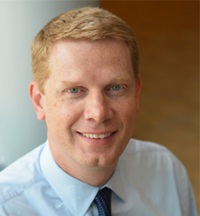
Dear Sigma Xi Members,
As we recently celebrated the 75th anniversary of the National Science Foundation (NSF), a pillar of American scientific achievement, we now face an alarming challenge that could undermine the very foundation of our nation’s research enterprise. In March, I sent a letter to President Trump calling for his administration to provide a plan for the future of science in the United States. Although we have not received a formal response to this letter, the President’s FY2026 Budget Request provides insight into his vision. The budget request proposes a staggering 56% cut to NSF’s budget, reducing it from $8.8 billion to $3.9 billion. This includes directives to cancel active research grants, halt the initiation of new ones, and implement personnel reductions at the agency. These unprecedented cuts would jeopardize the United States’ ability to conduct basic research, support the next generation of scientists, and lead in global innovation. Further, these setbacks would undermine the president’s goal of ushering in the Golden Age of American Innovation.
Since its authorization in 1950 by President Truman, NSF has played an essential role in advancing science and improving lives. As highlighted by the Coalition for National Science Funding (CNSF), NSF-supported research has given rise to remarkable technological advancements including the internet, Google, and smartphones—technologies that define modern life. During times of crisis, NSF investments enabled cancer detection breakthroughs, the development of Doppler radar, and advances in earthquake resilience. From supporting fundamental discoveries to seeding transformative industries, NSF has continuously propelled American science and economic growth.
The proposed budget would dismantle programs that have long nurtured discovery and broadened participation in science, technology, engineering, and mathematics. Among the cuts are significant reductions to NSF’s Directorate for STEM Education (EDU) and the Established Program to Stimulate Competitive Research (EPSCoR), which supports research in historically underfunded states. These changes threaten not only the integrity of American science but also the development of a strong domestic scientific workforce and broad geographic distribution of scientific resources.
While Sigma Xi continues to call on the administration to provide a plan for achieving its noble goals and offers its support to the administration in strengthening the research enterprise, we stand with our colleagues across the research enterprise in urging Congress to reject these harmful cuts and instead invest in NSF for the future. We encourage every member to take this moment to speak out—share your NSF story, highlight the value of federal research investment, and help protect a legacy that has empowered American innovation for three generations.
Please consider joining the #SaveNSF social media campaign beginning the week of May 12–16 and going forward. In the future weeks and months, we invite members to help raise awareness about these issues and promote investment in scientific research. Contact your elected representatives today to voice your support.
Use this suite of helpful tools to tell your story:
On social media, include hashtags like #SaveNSF, #NSF75, and #NSFfunded. Tag your members of Congress and let them know that NSF is not just a budget line, it’s a driver of discovery, prosperity, and national strength.
Let’s work together to ensure that NSF not only survives but thrives for the next 75 years.
Sincerely,

Jamie L. Vernon, PhD
Executive Director and CEO
Sigma Xi, The Scientific Research Honor Society
-
by
Kathy Lu
| Apr 17, 2025
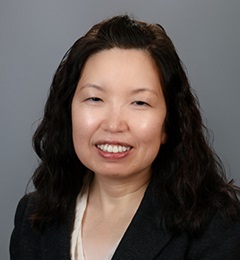
As we approach the end of the 2025 fiscal year, I have been reflecting on my own year as Sigma Xi president with great pride. Our journey has been one of growth, collaboration, and commitment to scientific excellence. We have made remarkable strides in expanding our community, fostering interdisciplinary partnerships, and reinforcing our dedication to research integrity.
Over the past 12 months, Sigma Xi has strengthened its role as a beacon for research excellence. Thanks to the collective efforts of the entire Sigma Xi community, we have seen a historic 12% increase in membership, marking the first membership increase in decades. This surge reflects renewed interest in the Society’s mission. We have also made significant progress in narrowing our budget gap, putting Sigma Xi back on a strong financial footing.
The 2024 International Forum on Research Excellence (IFoRE) brought together researchers from diverse fields to celebrate excellence, foster interdisciplinary collaboration, and emphasize ethical research practices. We provided opportunities for emerging scientists—high school, undergraduate, and graduate students—to present their work, gain valuable feedback, and engage with seasoned researchers.
Moreover, our international outreach efforts continue to grow, with new members and partnerships expanding our footprint beyond North America.
Despite these many clear successes, we must recognize the challenges that lie ahead—ones that we must meet with resilience, creativity, and a shared sense of purpose.
Misinformation and distrust in science have become widespread. Scientists must not only conduct rigorous research but also advocate for evidence-based decision-making. Cuts to funding could slow down groundbreaking discoveries, limit access to essential resources, and put increased pressure on researchers. This challenging environment may also disproportionately impact emerging scientists and underfunded research areas, exacerbating existing disparities in the scientific community.
Sigma Xi members have a responsibility to engage both the public and policymakers. We must continue to communicate our findings effectively, advocate for evidence-based policies, and inspire a deeper public appreciation for scientific inquiry. Sigma Xi is more than just a peer group organization. It is a community bound by shared values—research excellence, ethics, and honor. Our strength lies in our ability to support one another, to foster collaboration, and to champion the role of science in society.
As we move forward, I encourage each of you to actively engage in Sigma Xi initiatives, promote science tirelessly, mentor young researchers, advocate for responsible science, and contribute to our collective mission. And I encourage you to remember: Science is about the responsibility we bear to use knowledge for the betterment of humanity.
Sincerely,

Kathy Lu
Sigma Xi President
-
by
Kathy Lu
| Mar 05, 2025

As we honor Women’s History Month this March, let’s take this opportune time to reflect on the remarkable contributions of women in science, technology, engineering, and mathematics (STEM). Women have played pivotal roles in advancing human knowledge and achieving groundbreaking discoveries, often while overcoming formidable barriers. This month is not just about celebrating their achievements, but also about recognizing the work that remains to be done across all scientific disciplines.
The stories of pioneering women in science should be remembered and celebrated. We remember individuals like Marie Curie, Rosalind Franklin, Mae Jemison, and many more. Their legacies remind us of the importance of curiosity, perseverance, and an unwavering dedication to discovery. While we celebrate these icons, we must also highlight the contributions of women who have worked behind the scenes and whose names do not usually make headlines. From research assistants to principal investigators, from teachers nurturing young scientists to data analysts shaping critical results, women play an integral role in the global scientific ecosystem. And, if you’ll allow me, the same can be said for all the talented women scientists in my own research group.
Unfortunately, the path for women in STEM remains fraught with challenges. Numerous studies have documented the challenges that women scientists still face. As a woman scientist myself, I would like to emphasize that being a scientist is not just about exciting discoveries and accolades. It is more about determination, the drive to discover, the pursuit of truth, and the responsibilities we carry as citizens. It is hard work that sometimes involves heartbreaking moments. But we must keep going, to keep blazing the path so that future women scientists will have a slightly easier way forward, in our collective pursuit of science and the realization of our collective human potential.
At Sigma Xi, we remain committed to fostering a scientific environment that brings out the best and the most in every woman scientist. We encourage all members to mentor, support, and advocate for women scientists in their communities, workplaces, and networks. We must also facilitate policies and social structures that are conducive for women to succeed. Together, we can continue to break down barriers and empower the next generation of women in science.
As we celebrate Women’s History Month, let us not only recognize the accomplishments of women past and present, but also reaffirm our commitment to the women scientists of the future. Let us support practices that advance women in STEM and actively contribute to a future where every scientist has the opportunity to thrive. Let’s take this month as both a celebration and a call to action.
Sincerely,

Kathy Lu
Sigma Xi President
-
by
Kathy Lu
| Dec 03, 2024

I am writing to you today to reflect on a topic that lies at the heart of Sigma Xi’s mission: research excellence. As members of Sigma Xi, we are bound by a shared commitment to advancing the cause of science and promoting excellence in research across all disciplines. This commitment entails that we all strive to understand the following: what research excellence truly means, why it is of paramount importance, how we can measure it, and what steps we can take to promote it.
True research is the pursuit of knowledge with rigor, integrity, and innovation. It is characterized by intellectual curiosity, a commitment to ethical conduct, and a relentless drive to push the boundaries of human knowledge. We all intuitively understand that research excellence does not involve as metrics the number of papers published or the number of citations earned. Instead, it is defined by the pursuit of outstanding quality and impactful outcomes. It is characterized by the originality, rigor, and significance of research that not only advances the frontiers of scientific knowledge but also addresses complex challenges facing our society.
Research excellence is important because it fuels breakthrough discoveries, drives technological innovation, and addresses pressing global challenges. Excellence in research can transform societies, inform policy decisions, and advance the frontiers of science. Thus, our pursuit of research excellence is fundamental to the global standing of our scientific community.
Measuring research excellence should encompass both qualitative and quantitative metrics. These metrics are not limited to publications, citations, grant applications, or awards. We must consider factors such as the significance and impact of research findings, the rigor of the methods employed, the contributions made to advancing knowledge within a particular field, and the ability to replicate and build upon research findings.
Promoting research excellence requires a concerted effort from all of us. It begins with fostering a culture of integrity, collaboration, and intellectual curiosity within our institutions and research teams. Our endeavors also require adequate backing from federal agencies, industries, and private foundations, all of which must support necessary resources and mentorship opportunities for younger generations of scientists.
As we continue to navigate the complexities of the modern research landscape, let us remain steadfast in our commitment to research excellence. It is our duty and privilege as members of Sigma Xi to uphold these standards, thereby enriching the scientific endeavor and contributing to the betterment of humanity.
Sincerely,

Kathy Lu
Sigma Xi President
-
by
Kathy Lu
| Jul 03, 2024

It is with great honor and enthusiasm that I address you for the first time as your president. As we embark on a new fiscal year here at Sigma Xi, I am thrilled to share some impressive accomplishments and upcoming plans for the Society.
Over the past 12 months, Sigma Xi membership has surged an impressive 11.7 percent, marking the first increase since 2008. As of February 2024, our total operating revenue was up 8.3 percent, while our operating budget deficit was down 2.3 percent. While significant financial challenges remain, these achievements signify that the Society is on a solid upward trajectory.
Our work is far from over, however. In today’s complex world, your participation and contributions are more crucial than ever, and the future of our Society depends heavily on your engagement. To bolster the future of Sigma Xi, we are focusing on several key initiatives:
-
Enhancing Science Policy and Engagement: We must continue to increase efforts to engage with the science research community and the public at large. This is the core mission of our Society.
-
Building Strategic Alliances: We aim to forge stronger relationships with science advocacy organizations such as the National Academies, AAAS, and Phi Beta Kappa.
-
Expanding Internationally: We are committed to increasing the international presence of Sigma Xi by working closely with chapters and partners to initiate growth and activities outside North America.
-
Reinvigorating Membership: A crucial aspect of our mission is to revitalize inactive members and grow membership-at-large to advance program initiatives.
I am also very excited to announce that Sigma Xi’s annual meeting, the International Forum on Research Excellence (IFoRE), is scheduled for November 14–17, 2024, in Washington, D.C. This year’s gathering will feature a diverse array of symposia on topics such as research education access, STEM life stories, and the intersection of research, AI, and science. These sessions are designed to foster collaboration and inspire our community.
As we move forward, I am eager to visit different chapters, connect with current and new members, and listen to your ideas and ongoing efforts to promote science. Together, we can continue to rejuvenate and grow Sigma Xi. Please reach out to me at klu@uab.edu if you’d like to ask a question or discuss ideas. Your efforts are essential to our collective success, and I look forward to what we will achieve together.
Sincerely,

Kathy Lu
Sigma Xi President
-
by
Marija Strojnik
| Apr 11, 2024
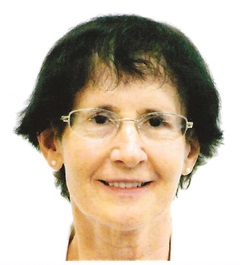
Over the last few years, one can scarcely open a prestigious national magazine or newsletter without coming across a sordid story about plagiarism at the highest echelons of science. There have been incidents at some of our most renowned institutions: Stanford, Massachusetts Institute of Technology, Caltech, Harvard, and others. It’s both hard to wrap your mind around and very discouraging—and you’d be forgiven for wondering if there truly is an irresistible temptation for competitive scientists to take shortcuts. Adding to this is the fact that the publication of scientific literature has become big business. The number of new publications in traditional and interdisciplinary fields has been increasing steadily.
Even before we had the help of computers and powerful algorithms, a few skilled individuals seemed able to predict the next steps in research with reasonable confidence. And they were often right, though not always. But today’s highly competitive landscape has culminated in the creation of a new kind of scientist: the accomplished technician who seemingly publishes a new paper every 37 hours. Such successes—or maybe we should call them abscesses—indicate not so much that certain individuals have mastered the publish-or-perish game, but rather that the standard that society has set for scientists is no longer tenable.
Clearly, we must reassess the core values of scientific research. In my opinion, the work of the true research scientist must include enhancing the health of the overall research enterprise, fostering integrity in science, and promoting the public's understanding of science for the purpose of improving the human condition. Put more simply, all scientists should practice and promote ethics and excellence at all times in their research. The true scientist is also dedicated to mentorship and to the advancement of knowledge through research, service, and teaching. And then, of course, there is the work itself: The true scientist must painstakingly check and recheck their results, methodologies, and assumptions. Only in that way, in community with equal-minded peers, can we build the scientific advances and engineering bases of our increasingly technological society.
This, I submit, is the profile of a Sigma Xi member.
With this letter, I prepare to conclude my one-year tenure as president of Sigma Xi. I am very proud to report that we’ve seen our first increase in membership in the last 10 years, along with our largest ever in-person annual meeting attendance at the 2023 IFoRE conference. I thank the Sigma Xi staff and our amazing membership, who were all instrumental in achieving these accomplishments during my presidency.
In July 2024, I will transfer leadership to our current president-elect, Kathy Lu. She will chart the future course of Sigma Xi and its continued prosperity.
Sincerely,

Marija Strojnik, PhD
Sigma Xi President
-
by
Marija Strojnik
| Feb 27, 2024

Sigma Xi is a multidisciplinary scientific research honor society that champions the principles of ethical scientific research and calls on members to introduce future scientists to the responsibilities incumbent in this essential work. One of Sigma Xi’s strategic goals has always been the advancement of STEM appreciation and education, from grade school through graduate school.
Sigma Xi leadership believes that the annual International Forum on Research Excellence (IFoRE) is an excellent place to address this goal. The 2023 IFoRE conference was held in Long Beach, California, with about 300 students participating. Most of them presented research, either in oral or poster form. About 170 professionals also presented research, led workshops, participated in panel discussions, and took part in mentoring and judging. Many attendees and volunteers expressed that this was the best Sigma Xi conference they had ever attended. It was also the Society’s best-attended in-person conference in the past 10 years.
Because a large number of Sigma Xi members represent biological and chemical disciplines, many IFoRE presentations focused on research in those areas. The popularity of these fields means that today’s high school students should have an easy time finding laboratories at nearby universities where important genetic and biological research needs helping hands, and where their curiosity and youthful drive can be put to work.
In my experience, STEM youngsters have an ambitious and novel way of looking at global problems. As we continue to deal with major concerns like pandemics and global warming, the next generation of scientists wants to change the world by doing applied research that leads directly to improved conditions for all humankind.
Jim Sullivan, executive director of the Harbor Branch Oceanographic Institute at Florida Atlantic University, presented on global warming, sea level rise, and climate change in his keynote session, “Florida’s Ecological Crises and How They May Inform Our Future.” Dr. Sullivan put in perspective the importance of the welfare of our oceans to our own well-being and survival. He also outlined how academia, government, and the public can interact to keep oceans—and specifically low-lying Floridian marshes—clean and healthy. There was an important note of hope in his message: Florida is succeeding in restoring its oceans to their primordial status as a giver and preserver of life.
With Sigma-Xi keynote lectures, our young scientists were given the knowledge, tools, and motivation necessary to develop advanced civic skills to introduce scientific input as an additional guiding influence to preserve our home planet.
Sincerely,

Marija Strojnik, PhD
Sigma Xi President
-
by
Marija Strojnik
| Dec 11, 2023

Like many scientists of my generation, I read Isaac Asimov’s novel I, Robot at a young age, many years before Hollywood got their hands on it and twisted its simple message. In the original book, all robots were hardwired to follow a set of basic laws that placed the sanctity of human life as their prime directive. Because of the humanistic promise of I, Robot and of many other books and films of that era, many of us grew up imagining a future full of robots that would enhance and simplify our daily existence.
From this premise, certain questions logically followed: What happens if and when the robots become smarter than we are? Given humans’ incredible talent for committing errors, should robots one day be tasked with running the world for us? Robots—machines unencumbered by feelings, the need for individualistic glory, and the megalomaniacal obsession to make an impact on human history—would they perhaps be wiser stewards of humanity than humans themselves? That sounds reasonable, right?
These days, I’m not so sure, and I think a lot of people share my concerns. Today’s “robots” do not yet pretend to be fully anthropomorphous. And they can’t quite yet be handed the task of running the world. But they have, however, read many books, so they know what sentence structures and what words tend to follow other words and sentence structures. They have also studied the work of many great visual artists and can make brush strokes that imitate those artists.
I may be among those humans who designed a smart device that is now in general use, to the degree that we cannot live without it. Nowadays, a computing machine has installed an algorithm, access to data, the ability to select and disregard data, organize data, and output them: this assembly of instructions has been given a catchy term: intelligent machine.
Hollywood has had its share of AI boogeypersons over the years, but the practically omnipotent Borg from Star Trek: The Next Generation are unsurpassed. I’ve always thought that the writers of Star Trek copped out by declaring the Borg part of the universe off-the-limits, essentially confining them to the “forbidden zone,” keeping the greatest threat to humanity at bay via wishful thinking.
Had Star Trek been written by a variant of ChatGPT, the story could have been much different. Humans would be happily assimilated into the Borg, in constant contact with other elements of zetta processing, and never having the time for another solitary creative, loving, or original thought. The architects of today’s intelligent machines seem to be inspired by the Borg concept of humanness.
Sincerely,
Marija Strojnik, PhD
Sigma Xi President
-
by
Marija Strojnik
| Nov 01, 2023

In the world of mice, with whom humans share a common ancestor according to one theory of evolution, an interesting experiment was performed over 15 years ago. In the experiment, a mouse is confronted with two paths: one leading directly to chocolate, the other leading to a second mouse whose access to the chocolate can only be facilitated by the first mouse. After some hesitation (that we still refuse to call moral thinking), the first mouse invariably chooses the second door to help the fellow mouse, and they go to eat the chocolate together.
The liberator mouse displays empathy. It also shares its own assured food supply. Subsequently, the mouse acquires an ally, so this decision is also profitable.
I also recall the story of John Jay O’Connor, late husband of Sandra Day O’Connor, the first female associate justice of the U.S. Supreme Court. While living in a care facility due to his progressing Alzheimer’s disease, he develope a relationship with another woman at the facility. Surprisingly, it was reported that his wife was happy with the comfort he had found, an empathetic acknowledgment that patients with Alzheimer’s disease sometimes develop new romantic relationships as their old ones fade from memory. It warms my heart that this couple enjoyed mutual emotional support, alongside a rare level of compassion and understanding from the former justice.
I reference these stories to reflect on some of our current moral compasses; humanity, empathy, and support of mental health. This fall, the campus of the University of North Carolina at Chapel Hill experienced multiple traumatic events, including the fatal shooting of a faculty advisor in the department of applied physical sciences. With Sigma Xi’s headquarters right down the road in Research Triangle Park, the safety and well-being of our local members became one of our top concerns. That month, Sigma Xi scheduled a special emotional health workshop with our wellness partner, Happy. These recurring support sessions have been offered as a benefit to all members since 2021, when stress and loneliness were skyrocketing for many during the COVID-19 pandemic. We continue our dedication to supporting our members across the country—not just through grants, awards, and career development, but also through investing in their emotional well-being.
As scientists, we know we can learn a great deal from lab mice. However, all too often we only look at scientific data and experimental results. But if we look a little closer, a seemingly empathetic mouse may have something more to teach us (or remind us) about companionship and humanity.
Sincerely,
Marija Strojnik, PhD
Sigma Xi President
-
by
Marija Strojnik
| Aug 31, 2023

Paul was a particularly bright student. On the day of the defense of his doctoral dissertation, just before his committee started deliberations, I opened questions to the public. I am confident that my students are sufficiently prepared to answer any question. But then Paul was tripped up by a question concerning how long it would take for tissue-transillumination with near-infrared light—the subject of his thesis—to solve the cancer problem.
Ten years later, I was giving an award to another bright young scientist who had developed a technique for generating near-infrared light to image cancerous cells in the brain, an approach that he promised would replace drilling holes in the skull to image tumors. I was in shock when I heard this researcher also overpromise the potential of his technique. The researcher in the last case obviously told the same promising story to the funding source as he wrote in the published paper. If mouse skull were actually there during his experiment, imaging with infrared light would not be possible.
I tell these stories to illustrate one of the reasons why there now seem to be so many people who no longer trust science. This erosion of trust in science was most obvious during the COVID-19 pandemic, resulting in an everincreasing chasm between those who trust science blindly and those who are skeptical about its promises, potential, and actual accomplishments. Who tells the stories that, at least to some people, carry little credibility?
The general progress of medical research has been extremely slow. Fifty years ago, President Nixon promised that cancer would be cured before the end of the century, just as President Kennedy had promised to put a human on the Moon by the end of the 1960s. But space travel proved a simpler puzzle than progress in health science. Today, one in two people will experience a brush with cancer, compared with one in three only 20 years ago. When President Kennedy first talked about conquering space, the most promising medication against several cancers, including the extremely stealthy ovarian cancer, was being discovered. In its less harsh form, doxyl was not generally available forty years later because of incredible difficulties in process control. While young medical and scientific researchers were promising hyped-up breakthroughs in cancer research, exasperated cancer patients pleaded with the government to streamline the production of an existing, proven, and effective medication, doxyl, a so-called last defense. Finally, the U.S. government designated it an orphan drug, and assured its production.
May scientists never forget that, while they have the current skills and ideas to forge the scientific progress, the humans in their own heads and in dusty libraries keep stored all the knowledge that the world acquired through the ages.
Sincerely,
Marija Strojnik, PhD
Sigma Xi President
-
by
Marija Strojnik
| Jul 03, 2023
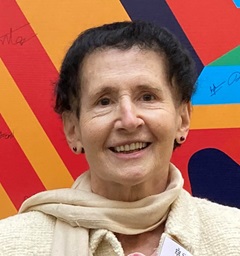
We are scientists. Every year, our mission becomes more complex. We must confront global warming; the depletion of underground reserves of clean water; the evolution of viruses and the resistance of bacteria to antibiotics; interrupted supply chains and inadequate resource management. We are surrounded by, and we are ourselves, struggling humans on whom far too many demands have been placed, some of us with children who are expected to be perfect even though they are constantly measured by impossible standards. Humans started using science to improve our living conditions at least 4,000 years before the fathers of the Enlightenment codified the basic steps of the scientific method. In ancient Mesopotamia, the priestess Princess Enheduanna charted the paths of heavenly bodies so she could determine the best times to plant and harvest crops. There is a direct line from her important work to the great challenges we face today.
Vision is central to the work of scientists. Having a sense of vision is not dependent upon the eyes, but rather, the brain and its ability to extract knowledge from experience. Through interaction with our environment, we acquire and selectively store information that allows us to create mental images. When observation inspires visualization, we can design plans to surmount challenges and achieve goals toward creating a better world. Another central facet of scientific work is communication. Since before the times of Enheduanna, humans have developed complex, flexible communication systems so that Earthlings may partake of available knowledge.
Thus, the vision of one generation can be passed to the next. For the scientific enterprise to prosper in our complex modern world, we must devise and implement teaching strategies that will allow young people to develop autonomous skills to evaluate the quality of information. They must learn to discriminate what information is useful to collect, store, and incorporate into their working knowledge. Isaac Newton famously said that he owed his greatness to all the great people who preceded him and on whose shoulders he stood. He was referring to the skills of scientific vision and knowledge acquisition, under the constraints of moral principles, and to the incorporation of the available body of knowledge to the task of improving the human condition for future generations. The scientific method of addressing and, with great effort, solving problems requires primarily the ability to think. We must strengthen the capability of students at all levels of the educational system to develop independent judgment, moderated with the humanistic goal of improving the human condition everywhere. The members of Sigma Xi are just the community to chart the way.
Sincerely,
Marija Strojnik, PhD
Sigma Xi President
-
by
User Not Found
| May 08, 2023
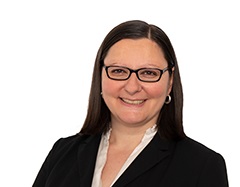
Last year, the CHIPS and Science Act was signed into law. This important legislation will fund research to help boost U.S. global competitiveness in science and technology. While many articles have been written on the CHIPS and manufacturing side of the bill, a focus on the science-related provisions is necessary. This is especially true when it comes to advocating for “real money” to make programs on the next generation of scientists a reality.
Previous articles on the legislation relate to improving the scientific environment, as well as including and retaining international talent within the U.S. research enterprise, both of which are critical to our nation’s competitiveness in science and technology. In addition to supporting research funding, another important element is the education and training of the next generation in science, technology, engineering, and mathematics (STEM). A recent article highlighted the lack of the legislation’s focus on broad-based career education, outreach and awareness, including mentorship and career services, which can lead to the loss of valuable talent in the sciences if not properly addressed.
To this end, for the past several years, efforts have been made to include specific language in the legislation on graduate students and postdoctoral researchers, who are the backbone of the enterprise. While graduate students and postdoctoral researchers drive the future of science forward, emphasis on their long-term career paths in science has traditionally been somewhat limited legislatively. Moreover, professional and career development in the sciences is often an afterthought for academic advisors and those who may partner with universities to improve the STEM pipeline, often following the publication of papers and grants as the main measure of success, and this needs to change.
Section 10313 of the CHIPS and Science Act (Graduate STEM Education) contains provisions focused on mentoring, career training, and professional development funding for graduate students. During my prior work, I was fortunate enough to contribute language to this section of the legislation that enabled postdoctoral researchers in particular to be recipients of the professional development supplement. This is significant given that postdoctoral researchers are often forgotten within the pipeline despite their role in driving scientific innovation forward.
My hope is that this change in the legislative language included in the bill will raise awareness for the need to not only support graduate students, but also postdoctoral researchers in their research endeavors. It also has the ability to place an emphasis on STEM training and education through acquiring important skills that contribute to societal change. At the federal level, the release of the President’s Budget in March 2023, which includes significant funding for the science agencies and STEM workforce programs, and the arrival of a new Congress this year, are both opportune times to engage in policy changes that can make a difference for the future of science.
At the state level, the CHIPS and Science Act emphasizes regional innovation and creating opportunities everywhere. Therefore, these elements are critical to overall societal improvement. Many groups have developed various opportunities for trainees to participate in policymaking at the state level, whether through state-level policy fellowships, local science policy boards and committees, state capitol visits, as well as organizing training workshops and policy discussions at their institution. This includes Sigma Xi’s new platform (coming late 2023), which will provide a roadmap for scientists, including early career scientists, to learn about and engage in the policymaking process through training opportunities, resources and connections to achieve desired policy change at the state and local level.
Across the country, and regardless of the level of engagement, now is the time for policy change. The ideas outlined in the CHIPS and Science Act need to support the next generation of scientists and implement much needed research and educational programs. It's time to see an emphasis placed on diversity that can lead to cultural change in research and a competitive edge in global science and technology.
A promising way to build a strong STEM pipeline is by emphasizing diversity in STEM and broadening participation through legislative provisions. This is particularly important when it comes to the National Science Foundation. NSF’s FY 2024 Budget Request to Congress requests for STEM education to closely align with the Administration’s priorities in supporting diversity and expanding opportunities across the U.S. in order to build a strong and highly skilled STEM workforce. This includes partnership development to better move forward the ecosystem outside the classroom, as well as improving better practices for STEM education by teachers and students training the next generation.
As a scientist who has advocated for placing a stronger focus on future scientists and their future in science for the past several years, these developments are promising. I hope that we will see continued investments in the future of science for generations to come, through the CHIPS and Science Act and future legislation that drives research forward.
Sincerely,
Adriana Bankston
Senior Fellow, Civic Science & Public Policy
Sigma Xi
-
by
Nicholas A. Peppas
| Apr 25, 2023
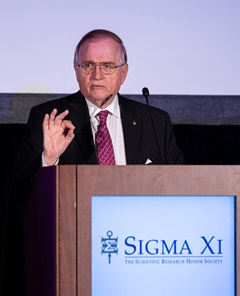
I am delighted once again to greet our Sigma Xi members. This is the last column I will write in my capacity as president of Sigma Xi. By the time it is published, I will be nearing the end of my presidency, and Dr. Marija Strojnik will be taking over. I note with pleasure that a Greek will be passing the baton to a Slovenian. This small observation shows the internationality of our Society. We are home to thousands of scientists from around the world, scientists who care about what they do, how they do it, their professionalism, and their dedication to achieve something good for this world, for its citizens, and for all our patients.
This past year, the Society has addressed a number of important concerns affecting science. We were reminded once again how crucial it is that our data are collected carefully and accurately, as well as being properly disseminated throughout the world in a way that can be clearly understood. We must both understand our scientific results and prevent the misinterpretation of those results, which has become a major problem in our society. In the end, if we are not able to communicate what our findings truly mean, then we are just as responsible as those who would misuse them.
Another major challenge in modern science is reaching the younger generation. My recent trips to Vanderbilt University and the University of Texas at San Antonio showed me yet again that the younger generation is hungry to learn, to ask questions, and to understand how to contribute and respond to societal needs. I saw the same thing internationally in my recent trips to Romania and Portugal.
Thinking ahead to the future, I am always trying to identify new ways to attract younger scientists to Sigma Xi. I became a member of Sigma Xi exactly 50 years ago this month, as a graduate student at MIT. It was a great honor to be elected then, and I still believe it is a great honor today. Last November, I saw that same pride in the eyes of our new inductees (and their parents) at the Society’s induction ceremony in Alexandria, Virginia.
So, my final message is a simple one: Let’s reach out to more young scientists, let’s make them active members of Sigma Xi, and let’s keep building the scientific infrastructure of our world.
Sincerely,
Nicholas A. Peppas, ScD
Sigma Xi President
-
by
Jason Papagan
| Mar 08, 2023
The following is a guest blog post from Clemson University's June J. Pilcher, who has served as a Sigma Xi Distinguished Lecturer and was awarded Society Fellowship in 2022.
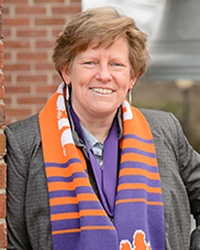
As a child growing up in the 60s and 70s, I was a tomboy before being a tomboy was acceptable. I dared to play tag with the little boys during recess instead of jacks with the other little girls. This concerned the teachers and principal at my elementary school so much that they talked to my mother. Fortunately, she told them not to worry about it. I had three older brothers at home and playing with boys was normal for me. But it was also my mother who repeatedly told me that I couldn’t do what my brothers could do.
Things have changed. More girls are pursuing careers, advanced degrees, and a redefined work/life balance. Yet, women in science are still cited less often than men, receive less funding than men, are more likely to be adjunct lecturers or full-time lecturers than men, and are less often seen in leadership roles than men. And, yes, “mansplaining” continues. As a Biopsychologist, I realize that these female-male inequalities are difficult to overcome, in part, because of lingering disparities in the culture of our work environments. Fortunately, our big human brains make it possible for us to recognize what is happening and develop plans to address the ongoing inequities between women and men scientists.
Universities, research institutes, and research societies are implementing programs to help address the disparities between women and men. New mentorship programs and programs in diversity are being implemented. However, there are also approaches that we can take as individuals, especially as newer scientists, to help ourselves and our institutions.
-
Remember that we are capable and “smart enough.” Women are more likely to feel like imposters instead of viewing themselves as capable and deserving of their position. We don’t have to think that we are the smartest person in the room. We just need to be smart enough and keep taking steps toward our goals.
-
Remember to listen and absorb the ideas and feedback that work for us, and discard the ideas and feedback that hold us down. Many other scientists will expect less of us and will view our accomplishments as being less because we are women, we don’t have to allow those expectations or perceptions to change our effort or change our goals.
-
Remember not to wait for support or recognition and ask for support when needed. Women scientists often receive less support and recognition for their efforts than men. We can’t wait for positive feedback, even when it is well-deserved. We must keep moving forward. It can also be important to ask for support, for example, when asking for recommendations for a fellowship application or assistance with grant proposals.
-
Remember to use our strength to help propel ourselves and others forward. Our teams accomplish more when we encourage everyone to contribute to their fullest. We can help to bring everyone on board as workers committed to excellence, not just as passengers along the way.
-
Remember to say “no.” Women are asked to help on more committees and other types of tasks that may distract them from their main scientific effort. We should accept if the committee or task could be interesting or useful, but we must be willing to say no to help control our own time and effort.
I wish that scientists were talking about these ideas and issues when I was new on the scene. There were slightly increasing numbers of women in graduate school back then (particularly in psychology), but the expectation for women was different. Assumptions were made that we would just get married to another graduate student and start a family. Or perhaps, we would become teachers, but not academics. Not scientists. Don't let others’ expectations change you or change your goals. There is so much research to be done, so many questions to ask, so many answers to find, and so many ways to excel. Choose your path forward and be the scientist you want to be.
Sincerely,
June J. Pilcher, PhD
-
by
Marija Strojnik
| Mar 08, 2023

Currently, I am a senior professor at a university engaged in research and development. I dedicate most of my time to five activities—conducting independent research, teaching classes, advising and directing student research projects, collaborating with industry to assist in solving problems within my specific area of expertise, and disseminating scientific knowledge through public talks.
Perhaps the least known aspect of my work as a university professor is that of a thesis director or academic advisor. In this role, I advise young women and men on how to achieve their professional goals. Sometimes, this requires counseling my students, offering perspectives, and proposing options for persisting through difficulties. I encourage my students and remind them that we all encounter obstacles. I try to reinforce a spirit of perseverance by noting that overcoming challenges can be interesting and satisfying.
I like all aspects of my job. I feel useful when I contribute to the discovery of new knowledge, often in collaboration with my fellow researchers, technicians, and students. At the same time, I enjoy an enormous amount of satisfaction seeing my former students progress as productive, accomplished researchers. People who are satisfied with their life tend to give back to society far more than they receive from it. When I see my mentees advance professionally and hold key positions at their universities, I simply feel proud. It is a feeling like that of a parent who guided their children to be respectable and responsible adults. All this work requires a reflective process that includes patience, confidence, and sound judgment.
I remember helping my parents with their work as a child. When I was five years old, I started doing housework and taking care of my younger siblings. Little by little, my responsibilities increased. My parents saw me as a very mature girl. My father, who was an engineer, began asking me to collect data and check his scientific articles for typing errors. I was very proud to be able to work alongside him. For his part, my father was happy with what he was doing. Although I was afraid of not being smart enough, I thought “Someday, I would also like to do the same work as my father.”
At the end of seventh grade, I received a book about atoms as a prize for my academic achievements. The following year, I prepared a talk at school about fission — the process nuclear reactors utilize to generate electricity, and fusion—the process of generating energy inside the Sun to create electricity on Earth. These experiences led me to a previously unknown world. This new world would encourage me to continue dreaming of science. Despite my desire to learn, I was once again afraid that I did not know enough to undertake such an arduous and difficult (yet fascinating) field of study.
When I was a young student pursuing an education in physics, there were very few other women studying physics, engineering, or technology. I lacked female role models due to the societal standards of the time. There were no female university-level professors in the technical departments at any of the universities that awarded me a degree. I felt isolated in classes where the teachers spoke only among men. It took me additional psychological effort to get closer to classmates who were uncertain of my abilities, especially when carrying out laboratory assignments or group projects. Fortunately, I found eventual success working in group environments, but the initial integration was always difficult.
Today, I feel happy in my work as a scientist. I encounter new and interesting research challenges every day. I feel comfortable in confirming that I was born to be a scientist. I am excited to apply and share my knowledge to undertake engineering or technology tasks. I invite all girls and women with interests in science, engineering, or technology to pursue projects in those fields. Unfortunately, many girls and women have learned to avoid this experience. However, I think that a girl can always read books on her own and sign up for school or community projects for extracurricular and complementary education.
Interest in science should grow along with traditional classes. Science and engineering must be integrated together with the general education studies of literature, languages, humanities, and computing. For example, I studied at a humanist school with an emphasis on language arts. It was not until I got to college that I dedicated myself to studying science, math, and engineering. A broad education presents young women and men with an appreciation for life and a wide variety of life options. Comprehensive preparation and knowledge can solve urgent national and global problems. When we see the world with more inclusive eyes, we are able to appreciate the differences among human beings and take advantage of them to make the world more equitable, just, beautiful, and hopefully… happy.
Sincerely,
Marija Strojnik, PhD
Sigma Xi President-elect
Read More stories from Women's History Month 2023
-
by
Nicholas A. Peppas
| Mar 07, 2023
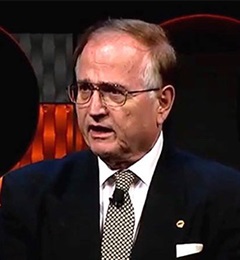
Since the conclusion of our recent IFoRE conference, I have been thinking about the future of science and the way we do research. Many of us once pursued purely fundamental research. Why? Well, first, it was satisfying. It was always being built upon the edifice we had already started building. I am an engineer by training, and I believe many engineers are (or were) cryptoscientists. The funding system and the way we were doing things in the 1970s and 1980s were very favorable for many of us. I distinctly recall a senior colleague at Purdue University, where I worked at that time, looking at my CV and commenting, “What is this paper in the Journal of Applied Polymer Science? What does ‘applied’ mean? Science is science.”
He may have had a point: Fundamental research simply had to be done. Let’s not forget just how many fundamental leaps later led to major advances in computers, microelectronics, sensors, nanomaterials, and so much more. But things changed drastically by the mid-1980s. The days of limitless funding for academic projects had passed. By the early 1990s, it became clear that what academics like me were doing had to have more applicable or applied aspects. Questions first came from the public—and one or two maverick senators (at least in the United States)—asking what the purpose of research even was. Affected by this new way of thinking, scientists began to realize that working on fundamental problems because “we like to work on them” was not enough, and was no longer appropriate in the modern cultural milieu. I recall my first talk at a European university in 1992, where I uttered the opinion that European taxpayers should be supporting professorial salaries for the purpose of the proliferation of awards, and because professors should be allowed to continue doing what “they like best.”
Now research has taken on yet another new face. It must be translational in the broad sense of the word, in that it must be applied and communicated to all fields. Many scientists still do not realize that we are responsible first and foremost for effective communication. Many continue to believe that ignorance about science simply amounts to a lack of information, and that if people are simply given facts, they will become science supporters. Yet the best means of effective science communication include cultural sensitivity, finding common ground, employing accurate narratives, and connecting with people. Thus, there is an obvious need to bring together researchers and science communicators for closer collaboration.
As evidenced by the recent COVID-19 pandemic, scientific misinformation can spread quickly, causing serious damage to society. Effective, accurate science communication skills can have a broad, positive impact on society, as well as the culture and norms of scientific academia itself.
Sincerely,
Nicholas A. Peppas, ScD
Sigma Xi President
-
by
Nicholas A. Peppas
| Dec 23, 2022

The theme of Sigma Xi’s recent International Forum on Research Excellence (IFoRE) was convergence, and appropriately, IFoRE brought together scientists from various backgrounds to address important medical and societal problems. One topic of lively discussion was how the outcome of disease treatment is influenced by the time of day of therapeutic agent administration. Over the past four decades, new findings have shown that the time of treatment is a crucial factor in therapeutics. It is now well established that nearly all functions of the body, including those influencing pharmacokinetic parameters, display significant daily variations or patterns. Researchers suspect that the chronological point of treatment may affect the outcome of a host of conditions, including hyper-tension, asthma, ulcers, arthritis, cholesterol, and even cancers.
New findings have led to the merging of disparate focuses into a new research area, that of chronopharmacology, which is the study of coordinating biological rhythms (chronobiology) with medical treatments. Chronobiology is the study of the temporal relationships of biological phenomena. Early 1970s data provided the first evidence that the “biological clock” is not fiction but is, in fact, genetically determined and can even be transplanted from one subject into another, thereby inducing the rhythmicity of the donor into the recipient.
Chronopharmacology takes a person’s biological rhythms into consideration in determining the timing and sometimes the quantity of medication needed to optimize a drug’s desired effects. Revising the dosing schedule, reformulating a therapeutic agent so its release into the bloodstream is delayed, or using programmable pumps to deliver medicine at precise intervals are some of the simple, chronopharmacology-inspired innovations that may lead to enormous benefits.
Many chronic and acute disorders have a prominent circadian pattern of symptom appearance. For example, allergic rhinitis is an early morning dis-order, thrombotic stroke risk is greatest in the morning, and hemorrhagic stroke risk is greatest in the late evening. Many cardiovascular diseases seem to be affected by circadian rhythms, such as myocardial infarction, stroke, high blood pressure, and angina pectoris.
The science seems clear that administration of therapeutic agents at different times of the day has a significant impact on medical outcomes. This burgeoning field of chronopharmacology also adds credence to the concept of convergence science—that is, fully integrating different areas of science to solve complex research problems that focus on societal needs and pressing health challenges. Convergence, one of the National Science Foundation’s “10 Big Ideas,” was explored deeply at IFoRE, If you missed the conference, keep an eye out for ways that members can access recorded content from the IFoRE sessions, a benefit of being an active member of Sigma Xi.
Sincerely,

Nicholas A. Peppas, ScD
Sigma Xi President
-
by
Nicholas A. Peppas
| Dec 23, 2022

We are just days away from the start of the inaugural International Forum on Research Excellence (IFoRE)—the refreshed, refocused, and rebranded Sigma Xi annual conference. Our theme this year is of particular interest: “Science Convergence in an Inclusive and Diverse World.” Convergence is much more than a buzzword: It is the crucial effort over the last 15 years stressing the importance of collaboration in solving important societal and global problems.
Take just one example: urban planning. The design of new cities that will meet the needs of modern citizens can no longer be based on principles from the 1950s. Infrastructure no longer means simply clean water and efficient transportation. Now, the quickly changing requirements of modern urban life require scientists and engineers to work together for the most effective solutions. Clearly, new modes of city planning, new materials, and new transportation systems will require all of us to work together to provide solutions to sustain a megalopolis of 20 to 30 million people.
Looking at a much smaller scale, the multifaceted entity that is the human body can also benefit greatly from the collaboration of an army of specialists: medical, scientific, engineering, and food science, to name a few. Where better to relish the potential of convergence than in longer, healthier lives?
So how do we all work together—or converge—to overcome such huge challenges? First and foremost, we must include people with differing expertise, experience, talent, and backgrounds in the research endeavor. Then we must proceed by truly listening to what everyone has to say. Innovative results are rarely the most obvious; the most glorious stained glass windows have pieces of completely different colors, shapes, and sizes, and the full art would be incomplete without every one of them.
A few weeks ago, Sigma Xi moved to its new facilities in Research Triangle Park, North Carolina. As always, our enthusiastic and adventurous staff members are working hard to improve service to our members. We now also have a group of scientists from diverse backgrounds who are very passionate about “giving back” to the Society . . . and to society in general. We have a new plan to increase Sigma Xi’s membership by identifying and electing active scientists from a wide variety of disciplines and backgrounds. And excitingly, our annual conference is becoming a magnetic pole for a diverse group of scientists. At this year’s IFoRE, it will be a pleasure and an honor to hear the “call to arms” from true leaders like Cato Laurencin, Gilda Barabino, Jim Collins, and Patrick Couvreur.
Personally, I am most excited to hear the fresh ideas of Lola Eniola-Adefeso and Kelly Stevens on diversity and inclusivity. They both have the uncanny ability to inspire hope when the clouds are darkest.
For these and many other reasons, I am thrilled about the future of Sigma Xi.
Sincerely,
Nicholas A. Peppas, ScD
Sigma Xi President
-
by
Nicholas A. Peppas
| Aug 26, 2022

I am writing this letter on the eve of my first-ever trip to Bucharest, Romania, for a scientific meeting on the future of biomaterials. At this meeting, I am looking forward to connecting with friends, colleagues, and many young scientists from around the world who are thirsty for knowledge and eager to help their countries. Such interactions always remind me that science is about more than simple academic endeavors and recognitions. In fact, scientific collaboration is at the core of our ideals at Sigma Xi—"Science without barriers.”
When I stand on the shore of the Danube River near Bucharest, looking northeast toward Moldova and Odessa, Ukraine, I will be reminded that many global societal problems are also scientific problems in need of brilliant scientific solutions. How do we feed people everywhere in the world? How do we address transportation, flooding, and climate problems? These are not only problems for the Danube Delta, but also for the Mississippi Delta, the lowlands in the Netherlands, the Ganges Delta in South Asia, and the rest of the world.
Perhaps most importantly, how do we address medical problems across the globe? Contributions to the design of biomaterials for various medical applications, and micro- and nanodevices for the medical and pharmaceutical industries, are leading to major new solutions to significant medical problems. No longer are the treatments for diabetes, osteoporosis, asthma, cardiac problems, cancer, and other diseases based solely on conventional formulations. Many of the methodological advances in biomedical sciences will be the result of serious molecular understanding.
Other significant opportunities have appeared in the medical sciences over the past 30 years with new advanced medical devices. Picture a day in the near future when insulin will be delivered only when needed, and when siRNAs for the treatment of Crohn’s disease will bypass the stomach and be delivered directly to specific cells. Imagine “intelligent” biomaterials that respond to light, temperature, pH, magnetic field, radiation, or even the existence of specific molecules in the body—with the ability to treat a disease before it progresses.
Such developments require the collaboration of countless chemists, physicists, mathematicians, statisticians, medical doctors, and engineers—all without barriers. We need young and old, men and women, experienced and novice, and as much cultural and international diversity as possible in the medical sciences. We have to be inclusive and work together. That’s the promise that brings science back to the center of our activities. It’s what bridges the world and gives hope for solutions to societal problems.
In the long run, it is the journey of discovery that matters. As the Greek poet Constantine Cavafy wrote:
As you set out for Ithaca,
hope your road is a long one,
full of adventure, full of discovery.
. . .
But don’t hurry the journey at all.
Better if it lasts for years.
Sincerely,

Nicholas A. Peppas, ScD
Sigma Xi President
-
by
Jason Papagan
| Jul 21, 2022
The following is a guest blog post from Robert Boily, reflecting on his experience serving on and leading the Committee on Nominations as a representative of the Canadian/International Constituency Group.
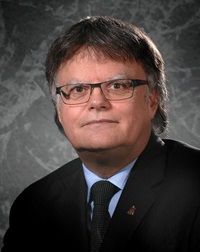
I was elected to the Committee on Nominations to serve as the representative of the Canadian/International Constituency Group. After serving my first year, I was chosen to serve as deputy chair, and in my last year I was designated the chairman of the committee. Serving alongside 16 individuals, including past presidents of the Society and elected representatives from each of the constituencies and regions, I worked to identify qualified and accomplished candidates for the presidency of the Society.
The progression of my term provided valuable learning opportunities to understand the intricate workings of a committee, parliamentary processes, and most importantly, to learn more about the Society’s strategic plan and how important it is to select a slate of distinct presidential candidates whose visions align with and integrate the immutable mission and values of Sigma Xi.
Serving on the committee was a great experience for me, on both personal and professional perspectives. It was an opportunity to share time with distinguished colleagues from different scientific backgrounds, to discover new talents for the most senior leadership position, and even to be creative by suggesting new ways to improve the evaluation process. I encourage Sigma Xi members to volunteer for this or any other committee. You will certainly benefit from being part of the action.
Helping to guide the future of the Society helps to strengthen the voice of its membership. Won’t you engage in the process today?
You can view our Strategic Plan and Annual Report to learn more about what your Society is doing. Visit sigmaxi.org/elections22 to view a list of open positions. Nominations for leadership positions should be sent to elections@sigmaxi.org.
Sincerely,
Robert Boily
-
by
Nicholas A. Peppas
| Jul 01, 2022

I have been a member of Sigma Xi since 1973, when I was a graduate student at MIT. Now I am writing my first letter to Sigma Xi members as president of the Society, with the hope of sharing my thoughts and sincere emotions about the future of science and global research.
Over the past year as president-elect, I have been working on the goals of the upcoming International Forum on Research Excellence (IFoRE). The theme of “Science Convergence in an Inclusive and Diverse World” captures some of the major trends in our fields and the important new directions of science worldwide.
Recent changes in science have led to a major emphasis on addressing and solving societal problems. The technologies driving infrastructure development, scientific breakthroughs, and translational research are multifaceted and require major contributions from various disciplines that have not necessarily come together in the past. We must be inclusive in everything we do.
We are all observing a revolution in scientific approach, a new way of working together to solve societal problems that cannot be addressed by just one discipline. About 12 years ago, MIT’s Phillip Sharp, a Nobel laureate, coined the term “convergence” to describe this merging of different disciplines and scientific areas that could solve important problems by creating jobs, speeding products to market, and improving agriculture, energy, and the environment—all with the ultimate goal of enhancing quality of life worldwide.
These goals, however, will not be possible if they come from only a fraction of the scientific population. For that and many other reasons, I believe we need to address the diverse approaches offered by scientists who have not been heard before. There is a new generation of scientists emerging from all backgrounds. This is the time to recognize the diversity in the scientific enterprise, and to become more equitable and inclusive. And this must be done with bold initiatives and actions. That’s what we intend to bring to IFoRE ‘22.
We all need to recognize that many scientific discoveries of the last seventy years have been achieved by diverse groups of scientists, mathematicians, and engineers. We must push the notion that there is clearly a need for new approaches, new solutions, and a restructuring of how teams do research. The scientific problems of the future—growing populations, climate change, post-traumatic stress disorders and other disabilities, new bacterial and viral illnesses, and the significant increase of auto-immune, chronic, and emergent diseases—will demand ceaseless, innovative research to find better solutions.
In closing, I share a quote from 1947 Nobel Prize recipient and French author André Gide, who said, “One doesn’t discover new lands without consenting to lose sight, for a very long time, of the shore.”
Sincerely,
Nicholas A. Peppas, ScD
Sigma Xi President
-
by
Jason Papagan
| Apr 26, 2022
The following is a guest blog post from Cristina C. Gouin, the director of Sigma Xi's Industry, State, and Federal Laboratories Constituency Group
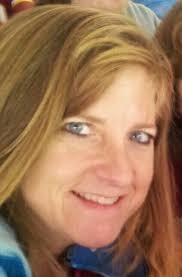
This year marks a milestone in my relationship with Sigma Xi. I will be rotating off as Director of the Area Groups, Industry, State and Federal Laboratories Constituency Group after serving 2 terms as Director. Prior to this I was Director of Mid-Atlantic Region for 2 terms, previously serving as Associate Director of both as well. Doing the math, I have served the Society in various leadership roles for 18 years. In addition, I have served as a committee member or committee chair on the Committee for Qualifications and Membership and President of the DC Chapter, and I am currently on the Committee for Finance and ad hoc Committee on Revitalization.
I do not share this to boast – my career and my cup have been filled through service with Sigma Xi. The camaraderie I have experienced with my fellow Sigma Xi members as well as my "thing," the public understanding of science has kept me involved with this Society. Now more than ever, we need as many loud voices for science as we can find and because Sigma Xi is multi-disciplinary we are able to learn and share knowledge about more fields of research than our own. That said, I am not becoming an inactive member of Sigma Xi, but we need fresh voices!
If you feel that researchers from across science need to band together, to share their passion and knowledge of science, holding an office in Sigma Xi is a way to multiply the sound of your own voice. Please consider running for office. The job is not difficult or overly time consuming. Help steer Sigma Xi into the future! As we see on TV and social media every single day, there is a serious lack of even the simplest scientific concepts. Your input can help Sigma Xi make a dent in that.
Won’t you nominate yourself or a fellow member today for vacancies for the July 1, 2023 – June 30, 2026 term? Active, full members of Sigma Xi are eligible for office. An inactive member may become active at any time through payment of current dues. Please visit the 2022 Sigma Xi Elections page to learn more about open leadership positions and the duties and responsibilities for each.
You can view our Strategic Plan and Annual Report to learn more about what your Society is doing. The deadline to submit nominations is June 30, 2022. Nominations should be sent to elections@sigmaxi.org.
Sincerely,
Cristina C. Gouin
Director
Industry, State, and Federal Laboratories Constituency Group
-
by
Robert T. Pennock
| Apr 18, 2022
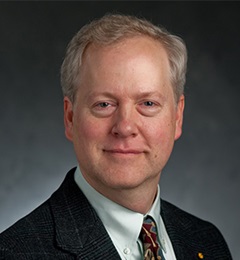
It has been an honor to serve as president of Sigma Xi for fiscal year 2022 and to carry its banner. During my term, I have often had occasion to explain what our Society is and what it does. I usually begin by mentioning its network of chapters and its tens of thousands of members . . . its Companions in Zealous Research. I speak of the Society’s deep historical roots and its unique mission of recognizing and advancing scientific excellence and integrity. I describe its 100 years of providing Grants in Aid of Research to science students; its mentoring, education, and ethics activities; its Distinguished Lectureships, Science Cafés, and other public outreach programs. And I always mention American Scientist, which continues to set the standard for science magazines.
What I mostly do, however, is try to emphasize what stands behind all these and many other programs—the scientific values that the Society was founded to encourage. The virtues of the scientific mindset are what animate us. These ideals and the many individuals who strive to embody them are what we seek to honor and to advance. It is in these terms that we can best express what is best in science and what we stand for. That is the message of our Society.
What does Sigma Xi do?
We honor…
The spirit of curiosity
The spirit of innovation
Those who wonder why
Those who wonder why not
The discoverers of what is
The makers of what may yet be
Noticing what others overlooked,
They seek a truer picture of the world
Rejecting pronouncements of authority,
They follow the evidence wherever it leads
Seeing failure as informative,
They test and troubleshoot
They investigate tirelessly,
With care and precision
To discover
To build
To better understand our world
And make our lives the better for it
What does Sigma Xi do?
We honor their spirit . . . the spirit of research.
Sincerely,
Robert T. Pennock, Ph.D.
Sigma Xi President
-
by
Jason Papagan
| Mar 24, 2022
The following is a guest blog post from Dr. Allison C. Augustus-Wallace, the associate director of Sigma Xi's Research and Doctoral University Constituency Group.
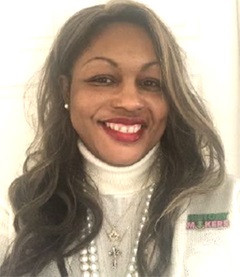
Learning that I had been nominated for membership into Sigma Xi was and remains one of the most joyous moments of my twenty-five-plus year professional career. I remember sharing the news with my husband that evening and erupting into an emotion of exhilaration, similar to the emotion that I experienced when I successfully defended my dissertation. Since my Sigma Xi induction, the opportunities to serve our Society beyond membership alone have been numerous. As important for me, membership has meant and continues to mean active participation in ongoing opportunities to contribute to the growth and well-being of our organization, which includes receptivity for my ideas in various areas.
For example, relatively earlier in my membership, my professional experience, energy, and commitment to contribute actively to Sigma Xi and the Research and
Doctoral University Constituency Group were identified. As a result, when the need for replacement in leadership arose, I was appointed and therefore, afforded the opportunity to serve as an Associate Director for our Research and Doctoral University Constituency Group. As a result of my desire to continue this contribution to Sigma Xi, I decided to run for election to this role. Excitedly and humbly, I was elected to this position in November 2021, and will serve a three-year term which begins July 2022.
Additionally, I am engaged with local Sigma Xi members to re-constitute our local Sigma Xi Chapters in south Louisiana, and I serve as a member of the newly created planning committee for our new annual conference, the International Forum on Research Excellence (IFoRE). As a biochemist-molecular biologist and an Associate-Professor-Research/faculty-administrator who works to create greater educational access and equitable inclusivity for historically excluded and marginalized groups at my beloved institution, my roles with Sigma Xi have afforded me the opportunity to expand my contributions in this area outside of my institution. In turn, my roles with Sigma Xi, as well as my experience from active memberships with other professional organizations, benefits Sigma Xi, as well as my institution. Therefore, I encourage you strongly to
consider the pursuit of the various opportunities to serve Sigma Xi, to benefit our organization and its members, as well as to promote growth, both professionally and personally.
Won’t you nominate someone today for vacancies for the July 1, 2023 – June 30, 2026 term? Active, full members of Sigma Xi are eligible for office. An inactive member may become active at any time through payment of current dues. Please visit the 2022 Sigma Xi Elections page to learn more about open leadership positions and the duties and responsibilities for each.
You can view our Strategic Plan and Annual Report to learn more about what your Society is doing. The deadline to submit nominations for the President-elect position is March 30, 2022 and all other nominations by June 30, 2022. Nominations should be sent to elections@sigmaxi.org.
Sincerely,
Allison C. Augustus-Wallace, PhD, MS, MNS, DEIC
Associate Director
Research and Doctoral University Constituency Group
-
by
Jamie Vernon
| Mar 07, 2022
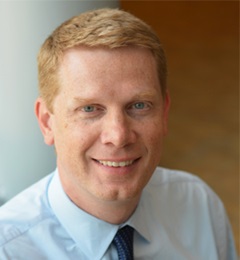
Sigma Xi, the honor society for scientists and engineers, recognizes research excellence in all scientific disciplines and sectors of the research enterprise. The Society relies on its members worldwide to determine the qualifications for membership based on an individual’s scientific contributions. Generations of scientists and engineers have crossed this threshold of excellence to become members. However, the definition of scientific excellence has evolved in recent years. To bridge the divide between the scientific community and the expectations and needs of broader society, metrics associated with inclusivity, accessibility, and usability of science have emerged as critical factors in determining the value of scientific research. Later this year, researchers worldwide will have an opportunity to weigh in on these discussions at the inaugural International Forum on Research Excellence, powered by Sigma Xi.
The effort to redefine research excellence has been underway for several years. In 2012, a group of editors and publishers of scholarly journals met to develop a set of recommendations for evaluating the output of scientific research. The resulting San Francisco Declaration on Research Assessment (DORA) recommends numerous research assessment practices for funding agencies, institutions, publishers, and researchers, including a general recommendation to avoid using “journal-based metrics, such as Journal Impact Factors, as a surrogate measure of the quality of individual research articles, to assess an individual scientist’s contributions, or in hiring, promotion, or funding decisions.”
DORA, widely accepted by individuals and organizations worldwide, set off a series of efforts to rethink research recognition and reward programs. The United Kingdom established the Research Excellence Framework, which is a system for assessing the quality of research in UK higher education institutions. This system assesses three distinct elements: the quality of outputs (e.g., publications, performances, and exhibitions), their impact beyond academia, and the environment that supports research. The Global Young Academy, which gives a voice to young scientists around the world, suggests that research excellence not only includes achievement in scientific research, but also excellence in connecting science to society, in teaching and mentoring scientists, in science management, and in science advice to policy makers. As a global leader, Sigma Xi has always emphasized the ethical aspects of research and has recently explored broader factors, including whether science is inclusive and accessible to all.
As evidence of the evolving definition of research excellence, one objective of the 2020-2025 Strategic Plan from the National Academy of Sciences (NAS) seeks to ensure that the NAS membership represents all dimensions of excellence in science: geography, gender, race, and scientific field. The plan recognizes that some organizations fail to acknowledge the importance of different kinds of merit, such as “traditional metrics, service, and diversity.” In addition, the NAS has cataloged a complicated array of requirements and policies, all roughly intended to ensure the excellence and integrity of research, in two reports, Optimizing the Nation’s Investment in Academic Research (2016) and Fostering Integrity in Research (2017). Both reports suggest a new body with the capacity to influence a complex network of researchers, institutions, funders, governments, and businesses is needed to provide clarity and leadership on these issues. The NAS has stepped into that role for the US-based research enterprise by establishing the Strategic Council for Research Excellence, Integrity, and Trust and its goal “to optimize the excellence and trustworthiness of research for the benefit of society.”
Sigma Xi's launch of the International Forum on Research Excellence (IFoRE) will contribute to these goals and recognize the importance of this issue to science and society worldwide. IFoRE will be part of the global discussion about trends and traditions that affect the quality and impact of scientific research. Scientists, engineers, research organizations, and the public worldwide are invited to help define excellence in scientific research and determine the ways to deliver it. The outputs from these conversations will inform the design of research environments and the policies and practices that maximize the value of scientific research.
Each annual forum theme will focus on an important issue or trend facing the research enterprise through keynote and plenary sessions, while tracks will address ongoing opportunities and challenges, such as broadening participation in science, improving STEM education, increasing accessibility and reliability of scientific information, building trust in science and technology, and increasing impact on society. The conference will also feature many of Sigma Xi’s traditional programmatic elements including student and professional research presentations, the Sigma Xi research excellence awards, and the STEM art and film festival.
We welcome your ideas and participation in planning for the first International Forum on Research Excellence, which will take place in Alexandria, Virginia and online November 3-6, 2022. This year’s theme will focus on "Science Convergence in an Inclusive and Diverse World." Please feel free to contact program chair and Sigma Xi's FY2023 president, Dr. Nicholas Peppas or me at executiveoffice@sigmaxi.org.
Sincerely,

Jamie L. Vernon
Sigma Xi Executive Director and CEO
-
by
Robert T. Pennock
| Feb 23, 2022

As is clear from Sigma Xi’s original 1886 Constitution, the honor of Society membership was never meant to be a concluding recognition of one’s achievement in science or engineering, but rather an encouragement to advance further and to help others do the same. Membership was intended to be an invitation to join the Society’s efforts to promote and encourage “the highest and truest advances in the scientific field.” Thus Sigma Xi has always promoted honor in science, though recent initiates have wondered what this exactly means in terms of professional conduct in the modern era.
This past year, Sigma Xi developed and formally adopted an explicit code of ethical conduct that serves to unpack what it means to take on these vocational ideals and to conduct oneself with honor. The full code, which I encourage you to read, can be found on sigmaxi.org, but here I want to highlight a few of its key elements.
The code's preamble begins with our mission statement, which expresses the goals of the Society: “To enhance the health of the research enterprise, foster integrity in science and engineering, and promote the public's understanding of science for the purpose of improving the human condition.” The preamble also includes Sigma Xi’s core values of excellence, integrity, and companionship, and articulates norms for achieving those values:
-
Excellence refers to the ideals of methods, practices, and character that guide researchers in their search to discover truths about the natural world and to create technologies to improve the human condition.
-
Integrity refers to the integrated expression of honesty, objectivity, and the other virtues that make for a trustworthy research enterprise.
-
Companionship refers to the fellowship, collegiality, and mutual respect among members of the scientific community who cooperatively seek to achieve these goals.
Specific expectations with regard to professional conduct are then organized under three headings:
-
Responsibility to science involves how to advance honor, integrity, and honesty in all research activities.
-
Responsibility to the scientific community deals with how to treat all persons involved in the research enterprise with respect.
-
Responsibility to the public involves how to ensure that the wider public can have confidence in the research enterprise.
Unlike many codes of conduct, ours does not just deal with avoiding misconduct, but also incorporates virtues and ideals we should aspire to. From the inception of Sigma Xi, the awarding of the honor of membership was intended to signify to recipients both a welcome and an aspirational challenge: "Come up higher!" Our new code reaffirms that message and makes it concrete.
Sincerely,
Robert T. Pennock, Ph.D.
Sigma Xi President
-
by
Joel Primack
| Jan 25, 2022
The following is a guest blog post from Joel R. Primack, Distinguished Professor of Physics Emeritus at the University of California, Santa Cruz. Dr. Primack served as Sigma Xi's president in 2018–2019.

The James Webb Space Telescope is now successfully assembled, and it has arrived at its home a million miles from Earth on the opposite side from the sun. Webb is a huge leap in astronomical observing power. Its pathbreaking observations will surely transform our view of the universe. It will enable us to look back in time to see the first stars forming and exploding in the first galaxies. It will be able to see the light from planets around nearby stars while blanking out the stars’ much brighter light, which may allow it to see the signatures of life. The Webb Space Telescope is an international collaboration built by the U.S., Canada, and the European Space Agency, and launched by a French rocket. It will join several other new astronomical instruments that are now in operation or under construction, each of which has a special superpower. Thanks to these ongoing technological improvements in telescope capabilities, astronomy is enjoying an exponentially expanding universe of data.
Theoretical astrophysicists like me have been making detailed predictions about what all these telescopes will see. But we theorists can never tell you what’s true, just what’s predicted according to current understanding. Our theories are likely to have left out some crucial ingredients. Only observations and experiments can tell us what’s true. Interpreting the observations forces us to improve our theories. Thus, the progress of science depends crucially on getting new data.
Webb’s most important superpower is its ability to collect and analyze light of much longer wavelengths than visible light, including heat radiation from planets and the light from very distant galaxies. Our ears can hear up to ten octaves (factors of 2) of sound wavelengths, but the light that our eyes can see — the main light emitted by long-lived stars like the sun — is less than one octave of light wavelengths. Hubble Space Telescope’s Wide Field Camera 3, installed in the last service mission in 2009, can see about four octaves of light wavelengths, making galaxies whose light was emitted about ten billion years ago the most distant galaxies all of whose visible light Hubble can see. This is because the wavelength of light from distant galaxies expands with the expansion of the universe, so light that was once visible shifts into longer infrared wavelengths. The earlier the light was emitted, the farther away the galaxy is now, and the more its light has shifted. There is so much expanding space between us and the galaxies that emitted light ten billion years ago or earlier, that these galaxies are now moving away from us faster than the speed of light.
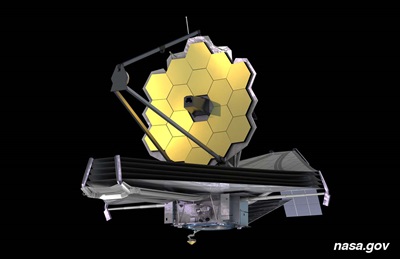 Webb’s 21-foot diameter segmented mirror will collect almost ten times more light than Hubble’s 8-foot mirror. And Webb’s much more advanced cameras and spectrographs can record and analyze the once-visible light whose wavelengths have expanded by a factor of about 20, revealing stars formed in the first galaxies about 200 million years after the Big Bang. These first stars were made only of hydrogen and helium, the two lightest elements, which formed in the first few minutes after the Big Bang. Theory predicts that these first stars were much more massive and much brighter than the sun. During their brief lives of only a few million years ending in gigantic supernova explosions, these stars began the process of forming all the heavier elements, which were then incorporated into subsequent generations of stars and planets. Webb will be able to see these first supernovas and we expect that Webb will also help us understand the mysteriously rapid formation of the supermassive black holes that power the earliest quasars.
Webb’s 21-foot diameter segmented mirror will collect almost ten times more light than Hubble’s 8-foot mirror. And Webb’s much more advanced cameras and spectrographs can record and analyze the once-visible light whose wavelengths have expanded by a factor of about 20, revealing stars formed in the first galaxies about 200 million years after the Big Bang. These first stars were made only of hydrogen and helium, the two lightest elements, which formed in the first few minutes after the Big Bang. Theory predicts that these first stars were much more massive and much brighter than the sun. During their brief lives of only a few million years ending in gigantic supernova explosions, these stars began the process of forming all the heavier elements, which were then incorporated into subsequent generations of stars and planets. Webb will be able to see these first supernovas and we expect that Webb will also help us understand the mysteriously rapid formation of the supermassive black holes that power the earliest quasars.
Like geology and evolutionary biology, astronomy is a historical science. The goal of the historical sciences is to reconstruct the past and thereby understand the present. But astronomy has a great advantage over these other sciences. Landforms on Earth erode and only a tiny fraction of organisms fossilize, but almost all the energy that was ever radiated by galaxies is still streaming through the universe in some form. The trick is to be able to detect all this light and be clever enough to understand it. The most violent astronomical processes emit very short wavelengths of light, some of which are absorbed by dust. That heated dust re-radiates the energy at longer wavelengths. To figure out what happened in the cosmic past, it is therefore necessary to see the entire electromagnetic spectrum, from the highest energy gamma rays to the longest wavelength radio waves. Fortunately, the new observatories on the ground and in space are making this possible.
Who else is in the super-telescope league with Webb? Here are my favorites:
National Science Foundation’s LIGO opened a new window on the universe when it started detecting gravity waves from merging black holes in 2015. LIGO is now working with the VIRGO gravity-wave detector in Italy and they will soon be joined by similar detectors in Japan and India. The LIGO-VIRGO discovery of gravity waves from merging neutron stars in 2017 led to the discovery that such neutron-star mergers generate many of the heaviest elements in the universe, including most of the silver, gold, and uranium.
The European Space Agency’s Gaia satellite, launched in 2013, is mapping more than a billion stars in our Milky Way galaxy so precisely that it can measure their velocities across the sky by seeing how their locations change over a few years. This is allowing us to run the clock backwards, showing that many of these stars came from other galaxies that were eaten by the Milky Way.
The eROSITA instrument, on a German-Russian satellite launched in 2019, is an X-ray telescope that for the first time is cataloging the 100,000 brightest clusters of galaxies and the brightest quasars over the entire sky.
DESI, the U.S. Department of Energy’s Dark Energy Spectroscopic Instrument on the Mayall telescope at the Kitt Peak National Observatory in Arizona, is measuring the redshifts of 100,000 galaxies per night more than ten times faster than ever before. In a few years of operation, it will increase the number of mapped galaxies by more than a factor of ten. By precisely measuring the expansion history of the universe over the last ten billion years, eROSITA, DESI, and other instruments, including the European Space Agency’s Euclid satellite, will help determine the nature of dark energy, the energy powering the accelerating expansion of the universe.
The NSF-DOE Vera Rubin Observatory in northern Chile will see its first light in late 2022. It is the first wide-field giant telescope and its Legacy Survey of Space and Time (LSST) will soon begin making a high-resolution movie of the entire southern sky. All the conventional telescopes in the world together discover a few thousand supernovas per year, but we expect that the data gathered by LSST will reveal 10,000 new supernovas each night. Adding together all the light observed by LSST will lead to a catalog with information about 20 billion galaxies.
In a few years NASA will launch the Nancy Roman Space Telescope which is like Hubble on steroids. Every image of the sky from Roman Space Telescope will cover about 100 times the area of each Hubble image with almost the same resolution as Hubble, allowing Roman to act as a finder telescope for the distant universe. It will also discover and help to characterize thousands of planets around nearby stars.
The Cherenkov Telescope Array, being built in Chile and the Canary Islands, will be a huge leap in our ability to detect the highest energy photons, most of which come from blazars, quasars whose beams happen to point in our direction. Such observations also allow indirect measurement of all the starlight emitted in the history of the universe.
The Square Kilometer Array (SKA) of thousands of radio telescopes, now being built in southern Africa, Australia, and New Zealand, will discover how the universe evolved during the cosmic dark ages, before the first stars formed. It will provide exquisite new tests of cosmological theory. SKA will also be a huge leap in our ability to detect radio signals from planets around other stars, invigorating the search for extraterrestrial intelligence (SETI).
It is remarkable that many billions of dollars are being invested in these new astronomical facilities, even though they will not lead to cures for diseases or other direct human benefits beyond new knowledge. But astronomy is a gateway, attracting young people to learn more about science and technology. Astronomical discoveries in the past have had profound impacts on humanity and our understanding of our place in the universe. This will no doubt continue to be true. Such discoveries may be among our era’s greatest legacies for the future.
Sincerely,

Joel R. Primack
-
by
Robert T. Pennock
| Dec 14, 2021

Everyone is born with the basic capabilities needed to learn about the world. Babies are proto-scientists; evolution endowed us all with the disposition needed to attend to and explore our surroundings and discover its useful regularities. Attentiveness, curiosity, and related character traits are the seeds of science. These traits must then be systematically cultivated if we are to not only survive but thrive. Cultivating these traits and developing the systematic habits needed for exemplary science is not easy. For the tree of science to flourish and bear fruit requires not just fertile soil and sun, but also careful tending by a supportive community.
Sigma Xi’s Grants in Aid of Research (GIAR) program, whose 100th anniversary we celebrate this year, has long supported mentored research experiences for students. These are seed grants in two senses of the term. They do not just support early research; more fundamentally, they support the growth and development of young scientists-to-be. Since initiating the GIAR program in 1922, Sigma Xi has awarded over $14 million in research funding to more than 30,000 graduate, undergraduate, and high school students. As you read quotes and stories from past GIAR recipients on the next two pages, you’ll get a sense of how meaningful these mentored experiences can be.
For seeds to germinate and grow requires a hospitable environment. Sigma Xi added the Student Research Conference to its annual meeting in 2001 to provide a welcoming venue where GIAR recipients can present and get feedback on their early research. Professional development workshops at the meeting provide budding scientists with the chance to develop their skills. Most significantly, the Conference provides an environment where students have the chance to interact with eminent researchers and educators who recognize their responsibility to be role models and mentors for the next generation, so students can learn to cultivate the scientific mindset in themselves. These and other programmatic activities are part of Sigma Xi’s deep commitment to advancing the values and virtues that underlie a flourishing research culture.
What can you do to lend your own support to these efforts? Identify talent and nurture it. This is especially significant for those who might not have recognized in themselves the traits that could ground a career in science. Encourage promising students to apply for a GIAR—the next application deadline is March 15—and offer to help them as a Research Advisor. Tend to the seeds. And consider contributing to the GIAR Centennial Fund so Sigma Xi can run this successful program for another 100 years.
Sincerely,
Robert T. Pennock, Ph.D.
Sigma Xi President
-
by
Jamie Vernon
| Oct 20, 2021

The summer of 2021 was the hottest in 126 years of records for the contiguous United States, according to a climate report released by NOAA in September. Temperatures across the nation were 2.6 degrees above average, slightly higher than the heat experienced during the Dust Bowl summer of 1936. U.S. cities often experienced temperatures that exceeded those of the surrounding areas. Researchers have identified areas of concentrated heat within cities called heat islands, which are typically landlocked areas laden with concrete and containing little to no grass, trees or bushes.
People living and working in these environments can experience hotter days, less nighttime cooling, and higher air pollution than surrounding areas. The Environmental Protection Agency has shown that these conditions can contribute to heat-related deaths and illnesses such as stroke, respiratory difficulty, cramps, and exhaustion. Without adaptive measures, health threats in these communities will increase as the planet warms, raising serious concerns about the safety and well being of people living in urban environments.
A recent article published in Nature Communications found that people of color are more likely to reside in surface urban heat islands than non-Hispanic whites in all but 6 of the 175 largest urbanized areas in the contiguous United States. The disproportionate distribution of people of color in high-risk areas has been attributed to historical practices of real estate, urban development, and planning policies that promoted spatial and racial segregation in U.S. cities. Although everyone will be affected by climate change, these factors indicate that people of color are facing more significant urban heat island-associated health risks as the planet grows increasingly warmer.
Heat islands, flood risks, crop failure, and wildfire worldwide will also disproportionately affect people of color and those living below the poverty line. These communities are often most aware of the impacts of climate change but least equipped to address them. Engaging affected communities with educational information, mitigation plans, and adaptive technologies can increase understanding of the problem and help advance solutions. Scientists and engineers can play a role in promoting equity and justice while disseminating climate solutions to disadvantaged communities.
Sigma Xi has launched an initiative to help scientists and engineers develop communication projects that will educate and prepare at-risk communities to mitigate the causes of climate change and adapt to climate threats. #SciCommMake is a collaboration between Sigma Xi and Science Talk that brings together interdisciplinary teams of scientists, artists, and science communicators. The teams compete for funding to create innovative artwork, social media campaigns, publications, and films that effectively and broadly communicate scientific information to the public.
The third cohort in this series will be convened during the Sigma Xi Annual Meeting and Student Research Conference to participate in a virtual matchmaking session to identify partners and develop a project concept that addresses the needs of vulnerable communities. Teams will be formed based on participants' ranked choices and complementary expertise. Matched teams will meet with coaches for feedback and pitch their ideas to a panel of judges. Winning teams will receive funding to complete their projects.
I look forward to sharing these projects with you in the coming months. For more information about #SciCommMake or to volunteer your support for this program, please email executiveoffice@sigmaxi.org.
Sincerely,

Jamie L. Vernon
Sigma Xi Executive Director and CEO
Related links:
-
by
Janelle Simmons
| Oct 14, 2021
Thank you for following along with the seventh year of Sigma Xi's Nobel Prize prediction contest, October Madness! We are pleased to announce that the participation in our contest was record-breaking for Sigma Xi with 467 votes cast (310 in chemistry, 72 in physics, and 85 in physiology or medicine). We look forward to another successful year of predictions in 2022.
Drawing Winner
Thanks to all who submitted nominations. Nominations for the October Madness brackets were submitted before the Nobel Prizes were announced. Those who submitted nominations had a chance to win a Sigma Xi prize package. The winner of the Sigma Xi prize package is Annette Aiello.
What's Next
Check back here on Keyed In next summer for the 2022 edition of October Madness! You can also follow along on Sigma Xi's social media with #OctoberMadness.
A Look Back at the 2021 Edition of October Madness
Announcement of Champions
Finals Round
Final 4 Round
Elite 8 Round
Sweet 16 Round
Call for Nominations
-
by
Robert T. Pennock
| Oct 12, 2021

Much of science is done in solitude and silence. Think of Jane Goodall, alone in the forests of the Gombe for months, quietly watching the behavior of chimps. Think of the scientist at the bench, oblivious to everything but what is happening on a microscope slide. Even in a group lab, researchers typically work alone—at the fume hood, hunched over their pipettes or flasks, or at a computer, mesmerized in the glow of some SPSS statistical analysis. Such focused observation and analysis of evidence is the foundation of science.
But there are times that scientists do come together and converse. They meet to show off beetles they collected or to demonstrate a curious phenomenon. They challenge and check each other’s work. They swap stories of failed experiments. They talk excitedly about the glimmers of emerging discoveries. These parts of science are done in community and conversation.
The first word of Sigma Xi’s motto—Companions in Zealous Research—highlights this collaborative aspect of scientific practice. Sigma Xi has long nurtured the communal values that support excellence in the research community. Its Grants in Aid of Research program will celebrate its 100th anniversary next year. These seed grants have helped many budding scientists get their start. Its Distinguished Lectureship program began in 1937 to sponsor talks for local chapters. I was honored to be a Sigma Xi Distinguished Lecturer in 2000 and spoke at some two dozen chapters. The stimulating discussions in these events demonstrated to me the vibrancy of the community. Many chapters run a Science Café program to engage the public in the conversation.
This year, Sigma Xi launches two new initiatives to extend the Society’s program to advance science’s ethical culture. The first is what we are calling Curious Conversations. Rather than giving a prepared talk, invited researchers will be interviewed in a conversational format. And instead of talking about their research findings per se, the discussion will focus on what motivated their research and the values and character traits that are important for discovery and innovation. We also aim to pilot round table mentoring meetings that use structured discussions to explore how the scientific virtues undergird excellence and integrity in research. We will kick these off at this year’s Annual Meeting and Student Research Conference and hope to find funding that will let us expand them so they can impact a broader, national audience.
Sigma Xi’s mission is to celebrate and give voice to the scientific spirit. I hope you’ll think of how you can contribute to these efforts, support the community, and join the conversation.
Sincerely,
Robert T. Pennock, Ph.D.
Sigma Xi President
-
by
Janelle Simmons
| Oct 01, 2021
After collecting public nominations and four rounds of voting, we're ready to announce your top predictions for the 2021 Nobel Prizes in chemistry, physics, and physiology or medicine. Congratulations to these researchers!
Your prediction for the Nobel Prize in Chemistry is...
Omar M. Yaghi and Makoto Fujita, for the development of metal-organic frameworks/coordination polymers and reticular chemistry; for pioneering reticular chemistry.
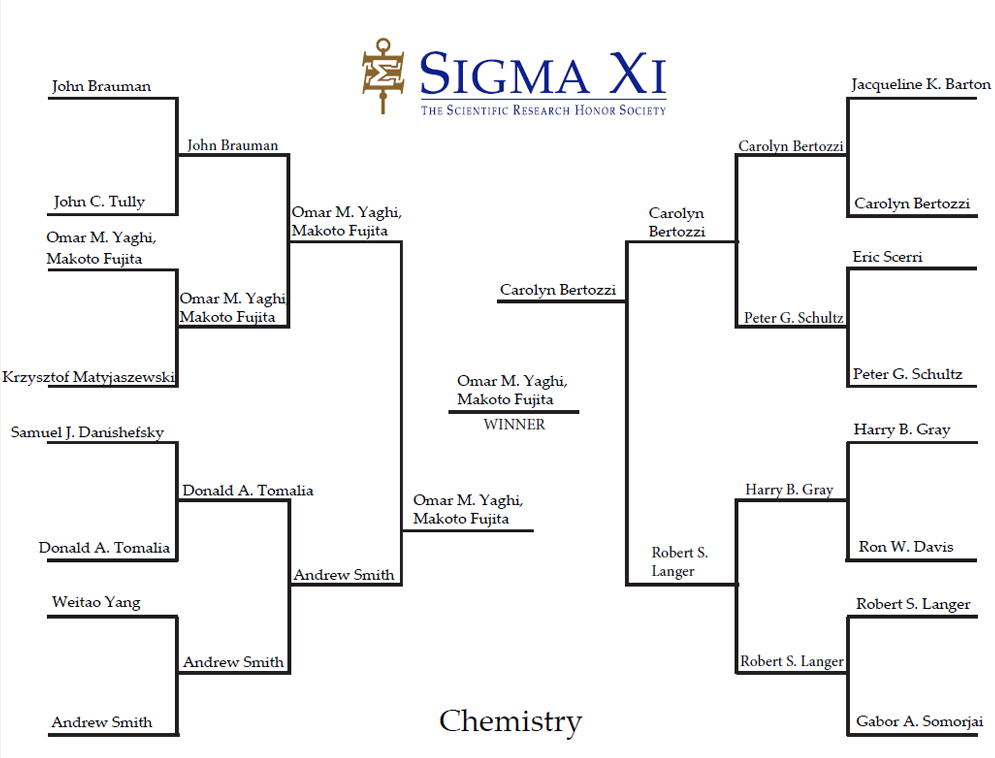
Your prediction for the Nobel Prize in Physics is...
Jocelyn Bell-Burnell, for her work on the discovery of pulsars, one of the major astronomical discoveries of the 20th century
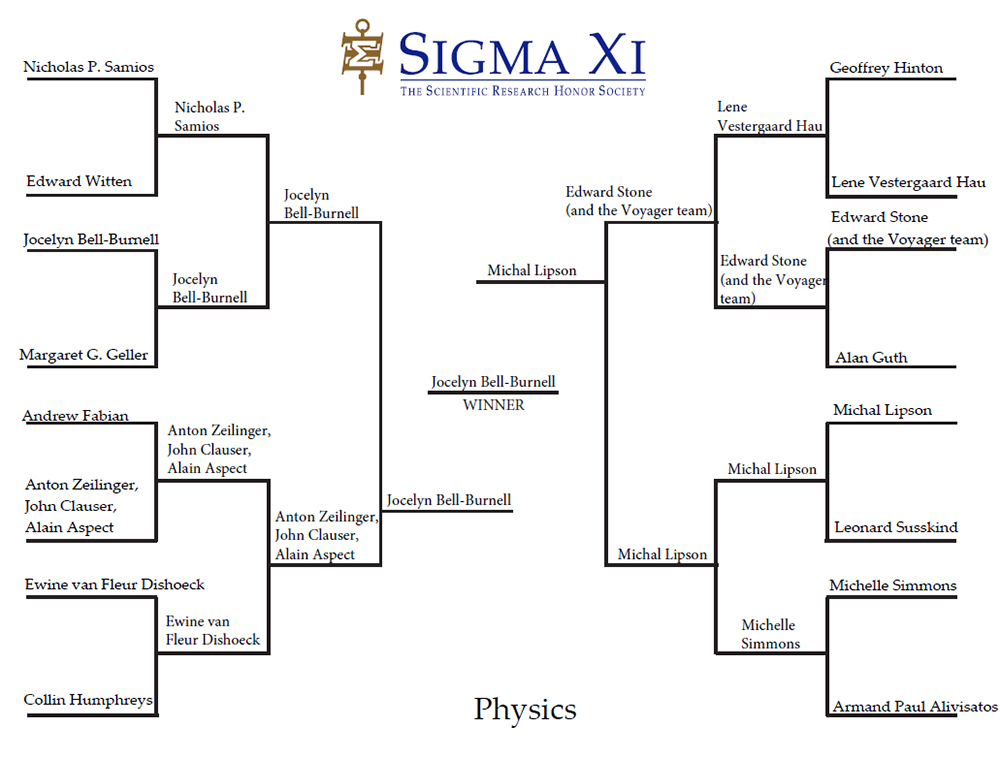
Your prediction for the Nobel Prize in Physiology or Medicine is...
Katalin Karikó and Drew Weissman, for the idea to harness the power of mRNA to fight disease and the discovery and commercialization of mRNA vaccines
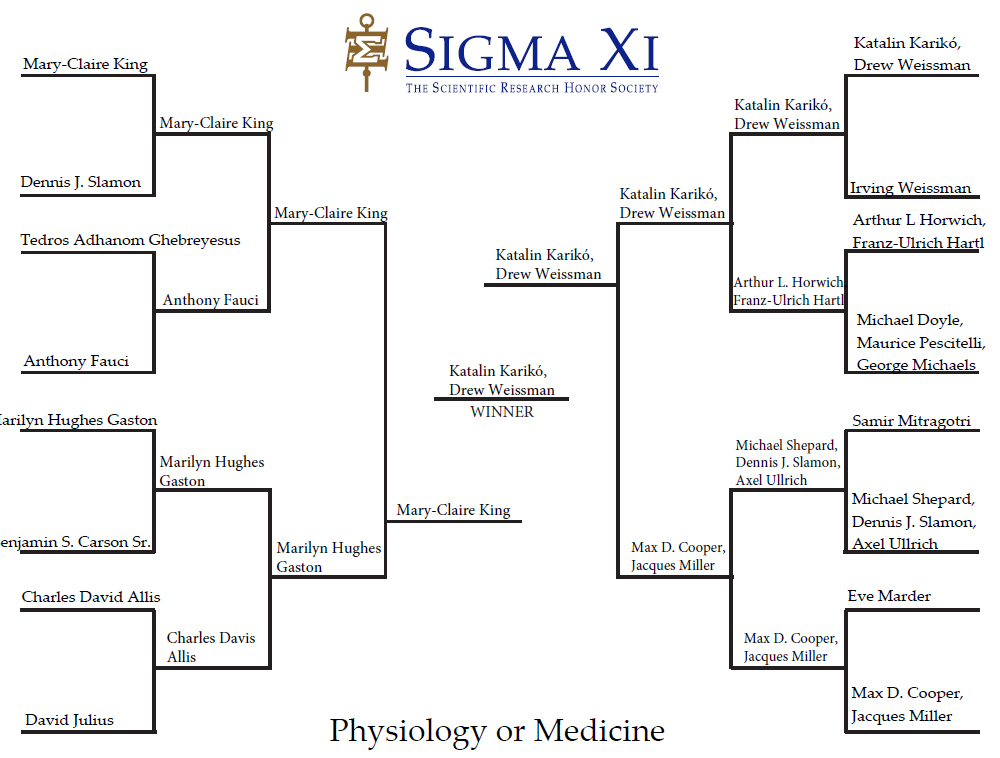
Thanks to everyone for voting!
What Happens Next?
- Watch for the official Nobel Prize announcements.
The Nobel Prize in Physiology or Medicine - Monday, October 4, 11:30 a.m. CEST at the earliest
The Nobel Prize in Physics - Tuesday, October 5, 11:45 a.m. CEST at the earliest
The Nobel Prize in Chemistry - Wednesday, October 6, 11:45 a.m. CEST at the earliest
The Nobel Peace Prize - Friday, October 8, 11:00 a.m. CEST
The Sveriges Riksbank Prize in Economic Sciences in Memory of Alfred Nobel - Monday, October 11, 11:45 a.m. CEST at the earliest
The Nobel Prize in Literature - Thursday, October 7, 1:00 p.m. CEST at the earliest
Times listed are local time in Sweden.
- See what others are predicting for this year's Nobel Prizes.
The 2021 Clarivate Analytics Citation Laureates
- Check back here on Keyed In on October 13 to see if anyone won the prize of one year of dues for Sigma Xi membership (for current members only) or for the Sigma Xi Affiliate Circle. Those whose October Madness nominees win a Nobel Prize are eligible for the raffle.
- Take a look back on October Madness through the years:
2020 Predictions
2019 Predictions
2018 Predictions
2017 Predictions
2016 Predictions
2015 Predictions
-
by
Janelle Simmons
| Sep 28, 2021
We're down to the finals of Sigma Xi's Nobel Prize prediction contest, October Madness! Your votes this week are more important than ever because you can help your top picks become October Madness champions!
Voting is open until September 30, 2021, at 11:59 p.m. Pacific Time.
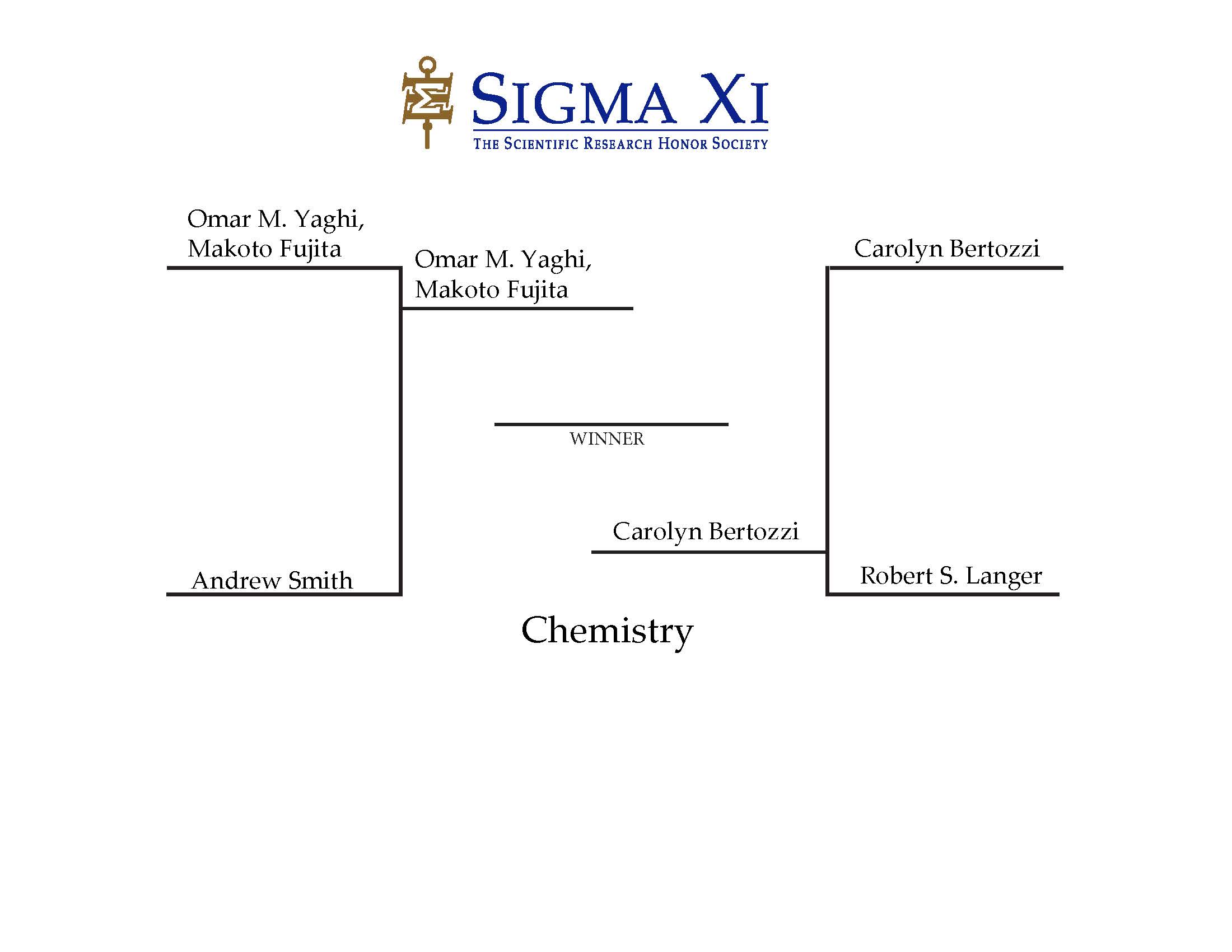
The final chemistry match-up is:
Omar M. Yaghi and Makoto Fujita, for the development of metal-organic frameworks/coordination polymers and reticular chemistry; for pioneering reticular chemistry
Vs.
Carolyn Bertozzi, for founding bio-orthogonal chemistry, and applying this novel chemistry to install artificial sugars on the surface of living cells, enabling the study of their roles in cancer and the immune system.
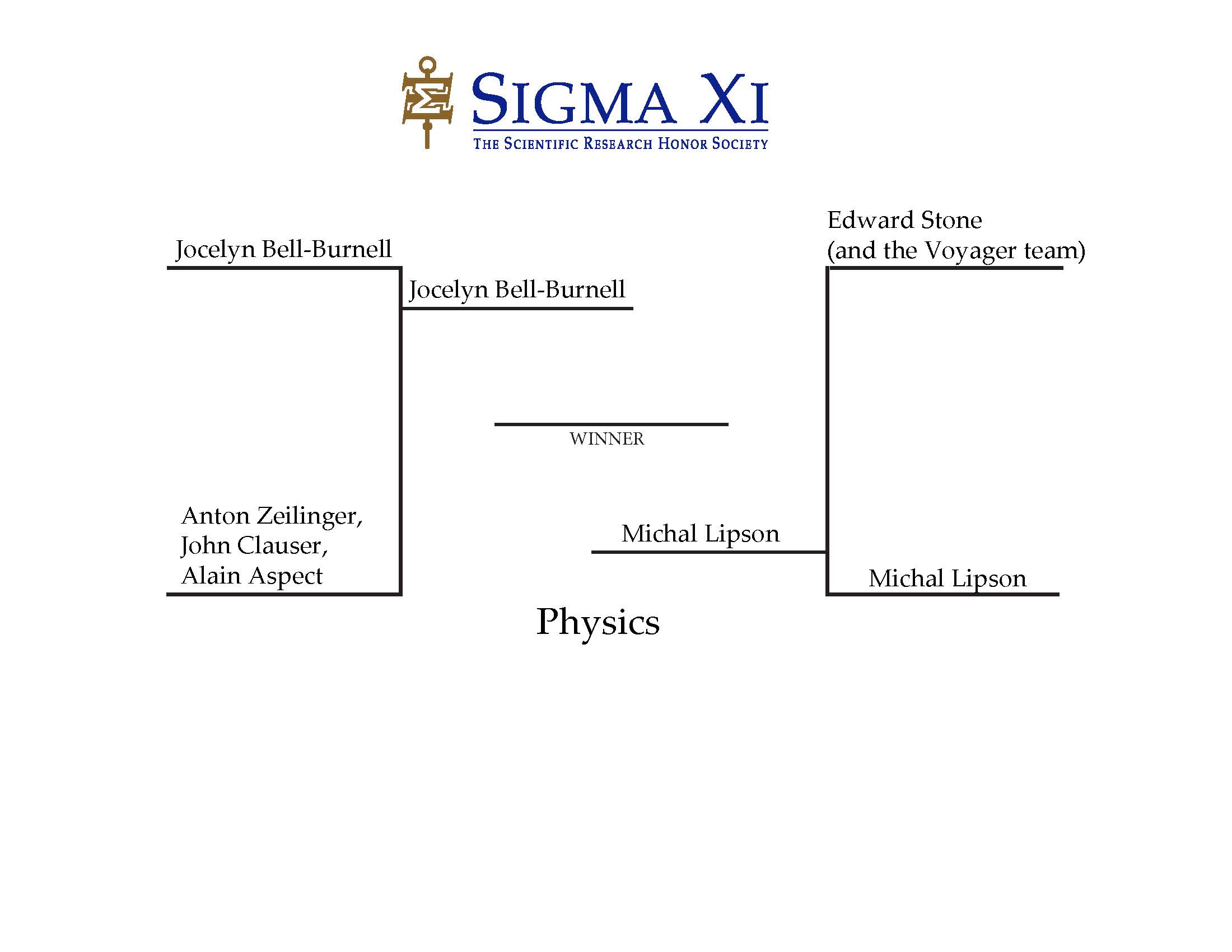
The final physics match-up is:
Jocelyn Bell-Burnell, for her work on the discovery of pulsars, one of the major astronomical discoveries of the 20th century
Vs.
Michal Lipson, for her pioneering research that established the groundwork for silicon photonics
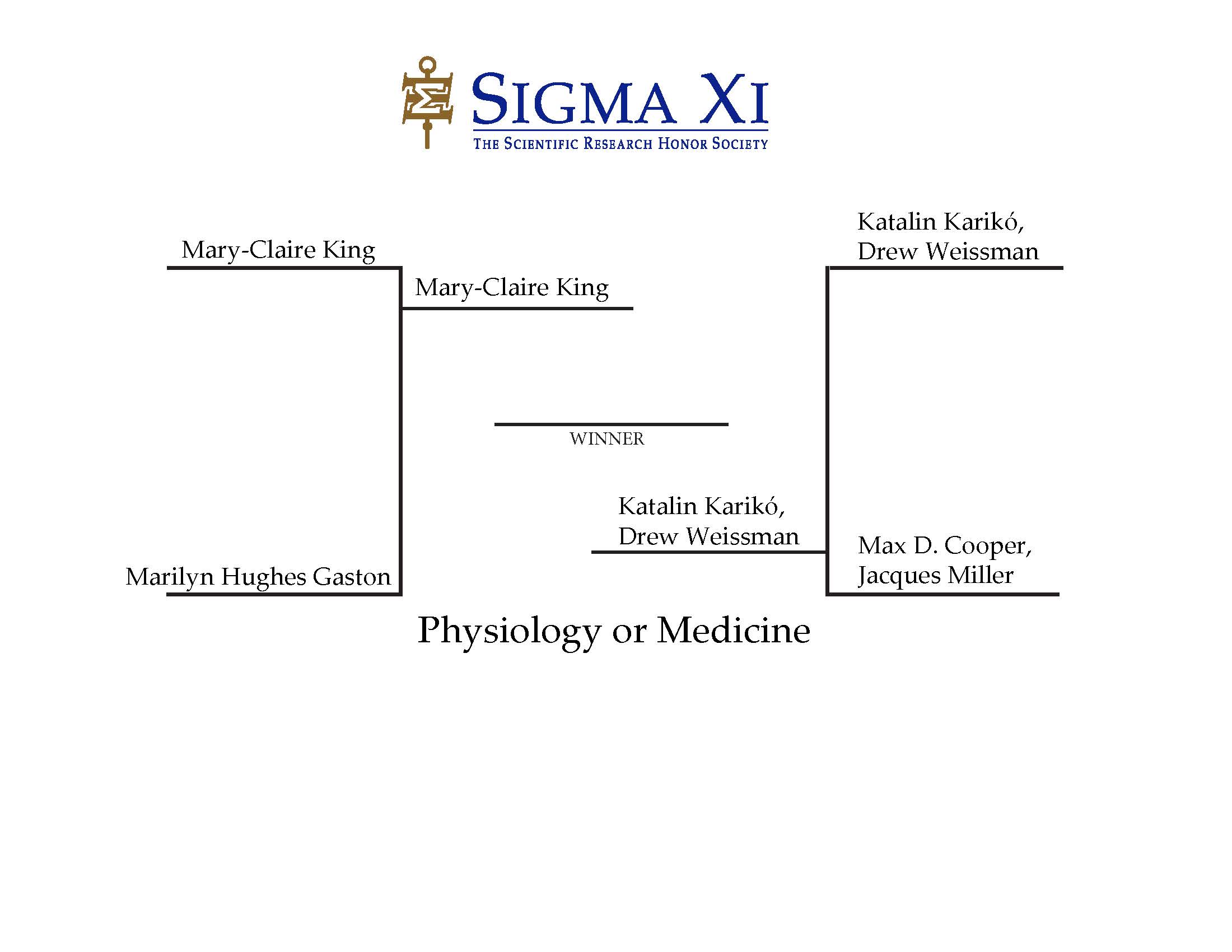
The final physiology or medicine match-up is:
Mary-Claire King, for the discovery of BRCA1 Linkage and confirmation of an inherited risk of cancer
Vs.
Katalin Karikó and Drew Weissman, for the idea to harness the power of mRNA to fight disease and the discovery and commercialization of mRNA vaccines
What Happens Next?
Results for the brackets will be announced here on Keyed In and Sigma Xi's social media on October 1. Good luck!
October Madness is not affiliated with the Nobel Prize.
-
by
Janelle Simmons
| Sep 23, 2021
We're down to the Final Four of Sigma Xi's Nobel Prize prediction contest, October Madness! Vote to make sure your top picks make it to the finals. Each person is eligible to cast one vote per category, for a total of three votes.
Voting is open until 11:59 p.m. Pacific Time on September 27, 2021, for the Final Four round.
Final Four Voting
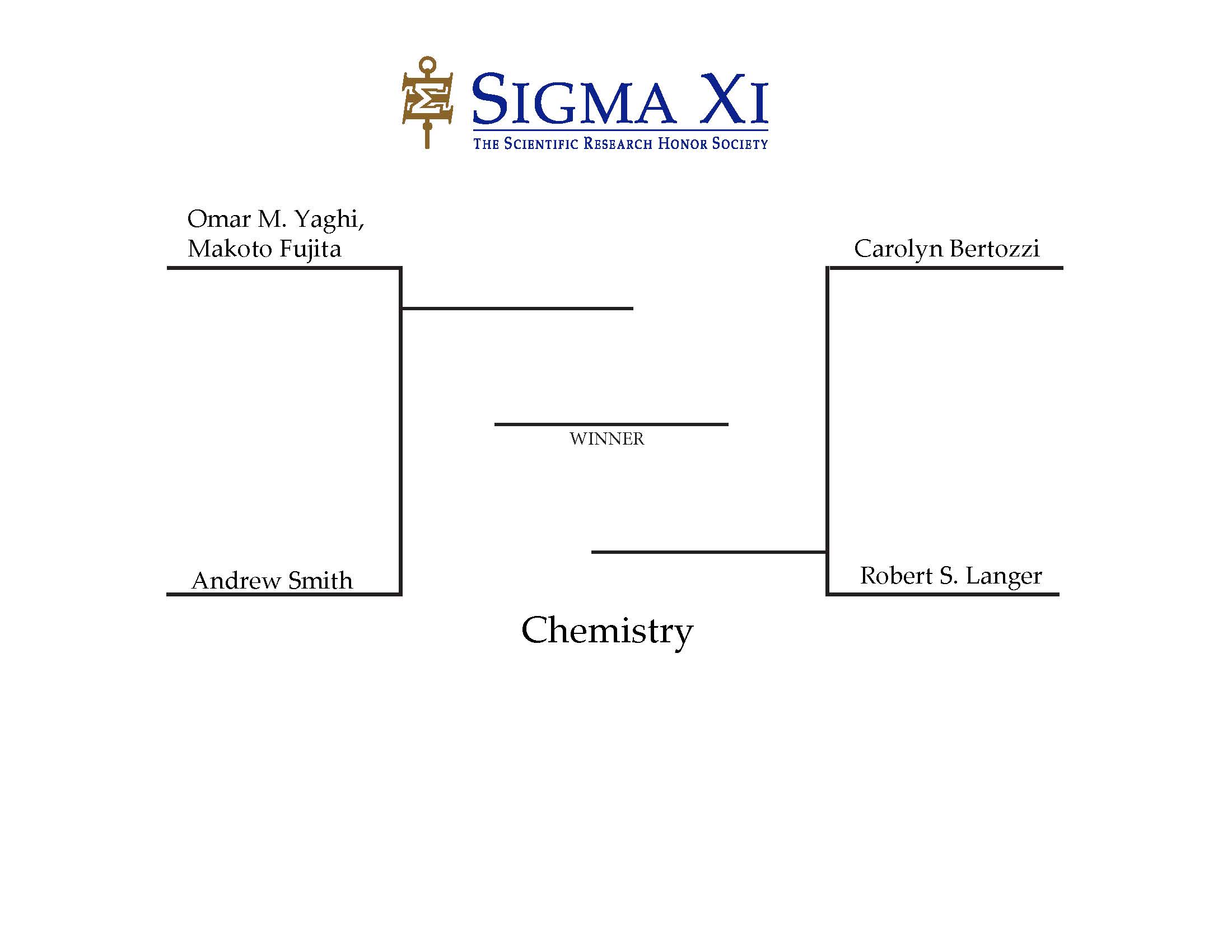
1.
Andrew Smith, for the development of organocatalysis methodology to synthesize new heterocyclic ring systems
vs.
Omar M. Yaghi and Makoto Fujita, for the development of metal-organic frameworks/coordination polymers and reticular chemistry; for pioneering reticular chemistry
2.
Robert S. Langer, for development of nanocarriers as a platform for cancer therapy, and other biotechnology using his background as a chemical engineer, inventor, and entrepreneur
vs.
Carolyn Bertozzi, for founding bio-orthogonal chemistry, and applying this novel chemistry to install artificial sugars on the surface of living cells, enabling the study of their roles in cancer and the immune system.
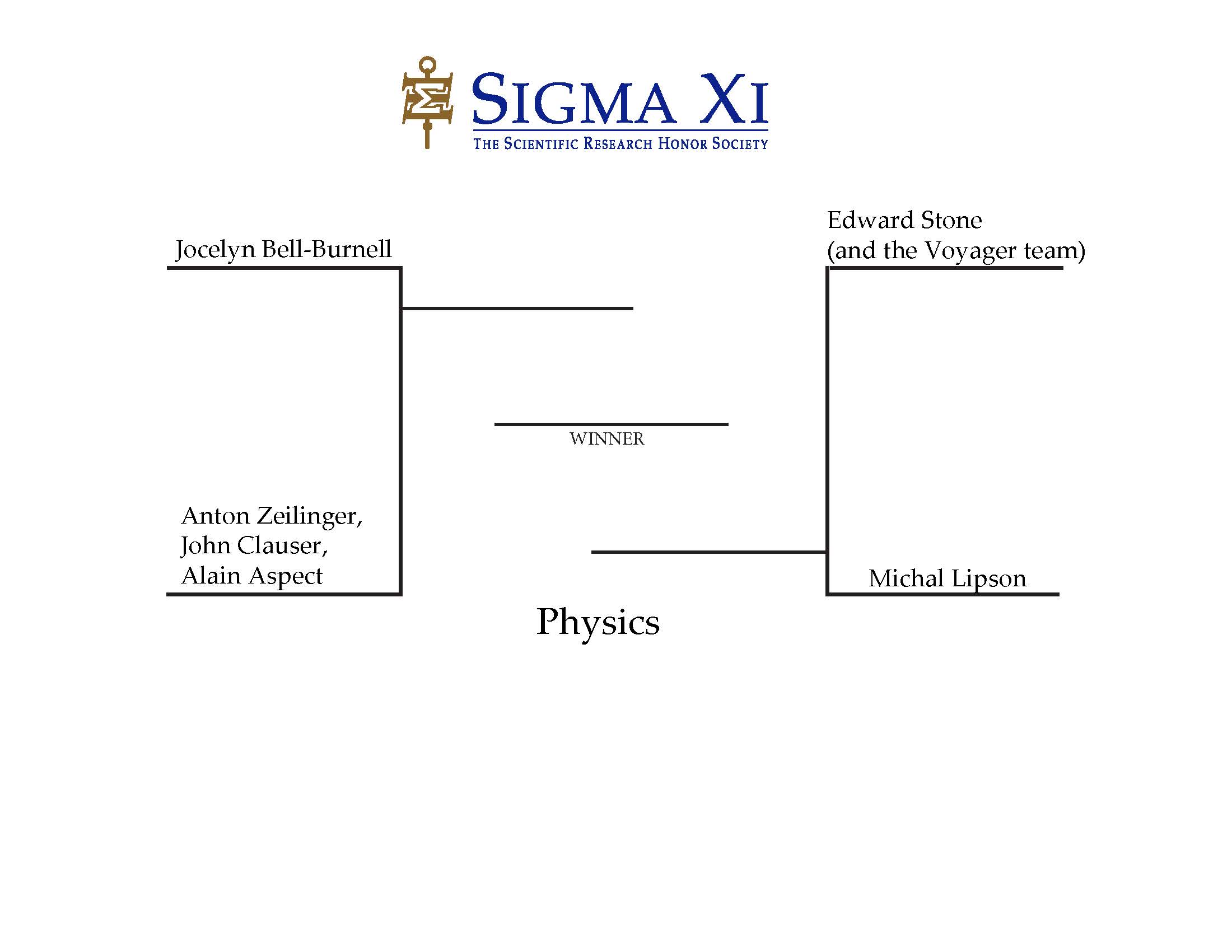
1.
Anton Zeilinger, John Clauser, and Alain Aspect, for their Bell’s inequality experiments, which established quantum entanglement
vs.
Jocelyn Bell-Burnell, for her work on the discovery of pulsars, one of the major astronomical discoveries of the 20th century
2.
Edward Stone (and the Voyager team), for heading the Voyager I/II missions, which have explored all of the outer planets and are now cruising interstellar space (the first human-made objects to do so)
vs.
Michal Lipson, for her pioneering research that established the groundwork for silicon photonics
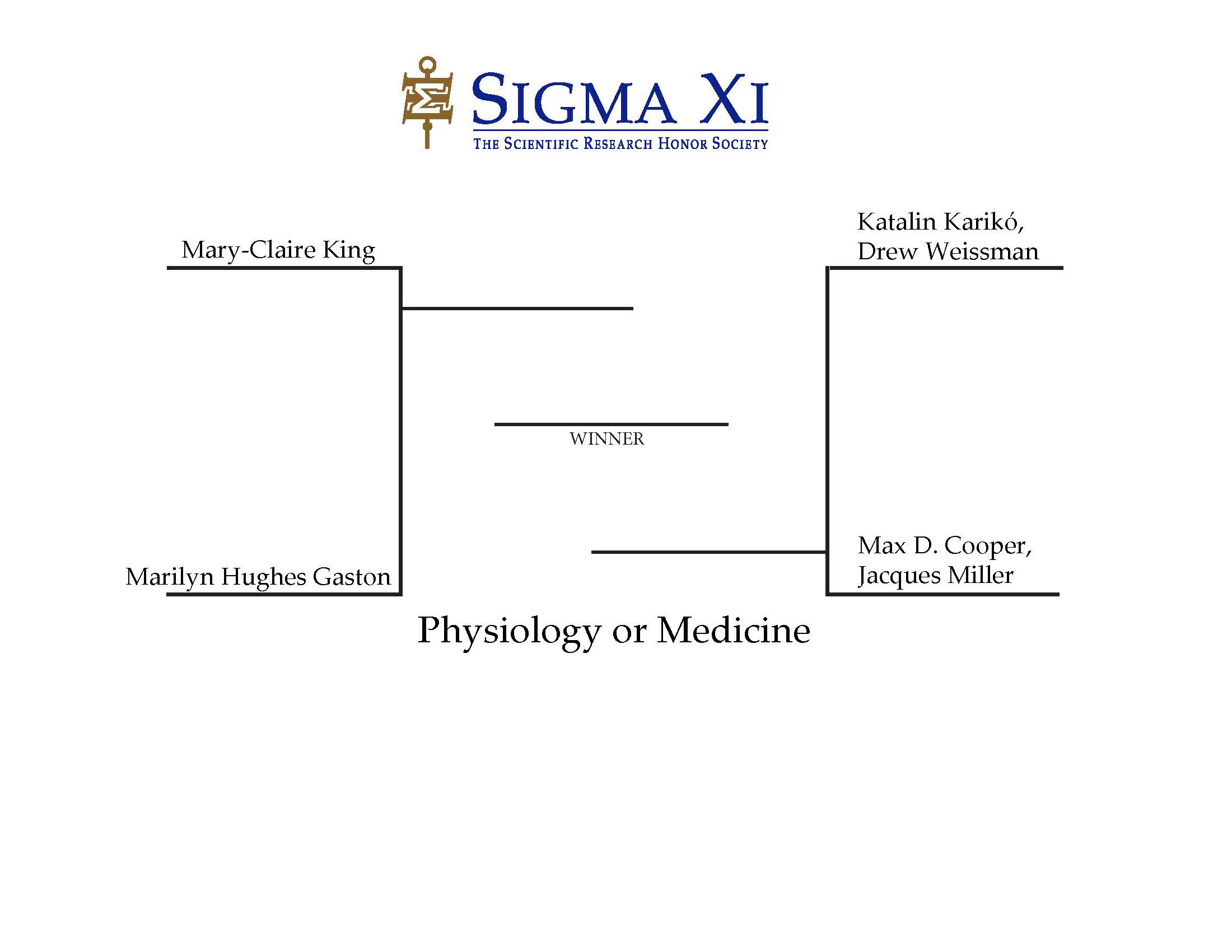
1.
Mary-Claire King, for the discovery of BRCA1 Linkage and confirmation of an inherited risk of cancer
vs.
Marilyn Hughes Gaston, for her work on sickle cell disease screening program for newborns and her research showed both the benefits of screening for sickle cell disease at birth and the effectiveness of penicillin to prevent infection from sepsis, which can be fatal in children with the disease.
2.
Max D. Cooper and Jacques Miller, for their discovery of the two distinct classes of lymphocytes, B and T cells – a monumental achievement that provided the organizing principle of the adaptive immune system and launched the course of modern immunology
vs.
Katalin Karikó and Drew Weissman, for the idea to harness the power of mRNA to fight disease and the discovery and commercialization of mRNA vaccines
-
by
Janelle Simmons
| Sep 16, 2021
Thanks to everyone who submitted nominations for the 2021 October Madness, Sigma Xi's Nobel Prize prediction contest!
Voting is open until September 21, 2021 at 11:59 p.m. Pacific Time for the Elite 8 round.
Make sure to vote to keep your favorites in the running!
Elite 8 Voting
Chemistry
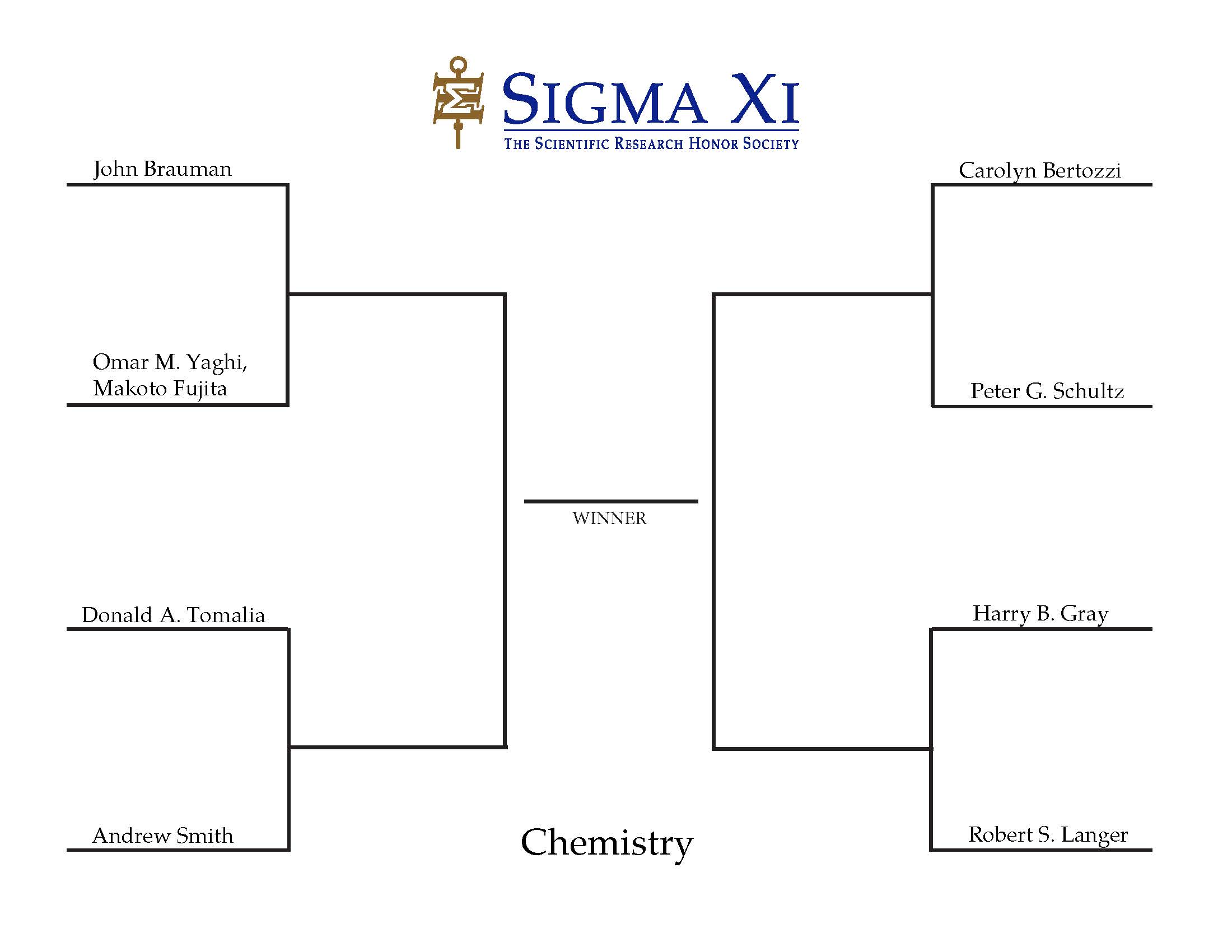
1.
John Brauman, for his contributions to the understanding of the factors that determine the rates and products of chemical reactions
vs.
Omar M. Yaghi and Makoto Fujita, for the development of metal-organic frameworks/coordination polymers and reticular chemistry; for pioneering reticular chemistry
2.
Andrew Smith, for the development of organocatalysis methodology to synthesize new heterocyclic ring systems
vs.
Donald A. Tomalia, for the invention of the dendrimer family of polymers that have the capability of transporting pharmaceutical agents through cell walls for medicine
3.
Peter G. Schultz, for his work in the exploitation of molecular diversity in the synthesis of new medicines and materials
vs.
Carolyn Bertozzi, for founding bio-orthogonal chemistry, and applying this novel chemistry to install artificial sugars on the surface of living cells, enabling the study of their roles in cancer and the immune system.
4.
Harry B. Gray, for his work in electron transfer research; tunneling, bioinorganic chemistry
vs.
Robert S. Langer, for development of nanocarriers as a platform for cancer therapy, and other biotechnology using his background as a chemical engineer, inventor, and entrepreneur
Physics
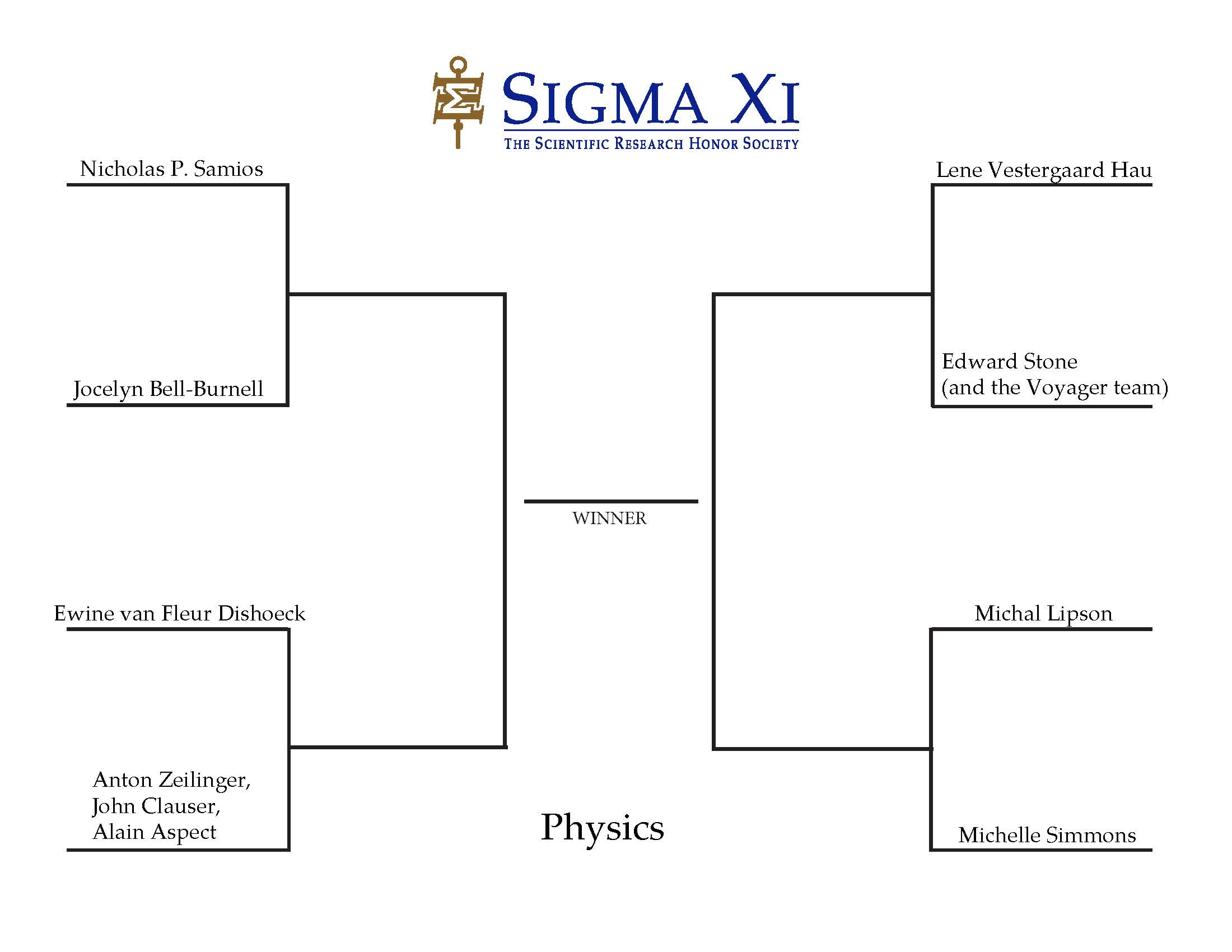
1.
Nicholas P. Samios, for the discovery of the Omega hyperon confirming the quark model
vs.
Jocelyn Bell-Burnell, for discovery of first radio pulsars
2.
Ewine van Fleur Dishoeck, for her research aimed at the determination of the structure of cosmic objects using their molecular spectra
vs.
Anton Zeilinger, John Clauser, Alain Aspect, for taking data which was loop-hole free and demonstrated that hidden variables could not be an explanation for quantum entanglement
3.
Edward Stone (and the Voyager team), for heading the Voyager I/II missions, which have explored all of the outer planets and are now cruising interstellar space (the first human-made objects to do so)
vs.
Lene Vestergaard Hau, for her work on slowing down and stopping light
4.
Michal Lipson, for her pioneering research that established the groundwork for silicon photonics
vs.
Michelle Simmons, for seminal contributions to our understanding of nature at the atomic-scale by creating a sequence of world-first quantum electronic devices in which individual atoms control device
Physiology or Medicine
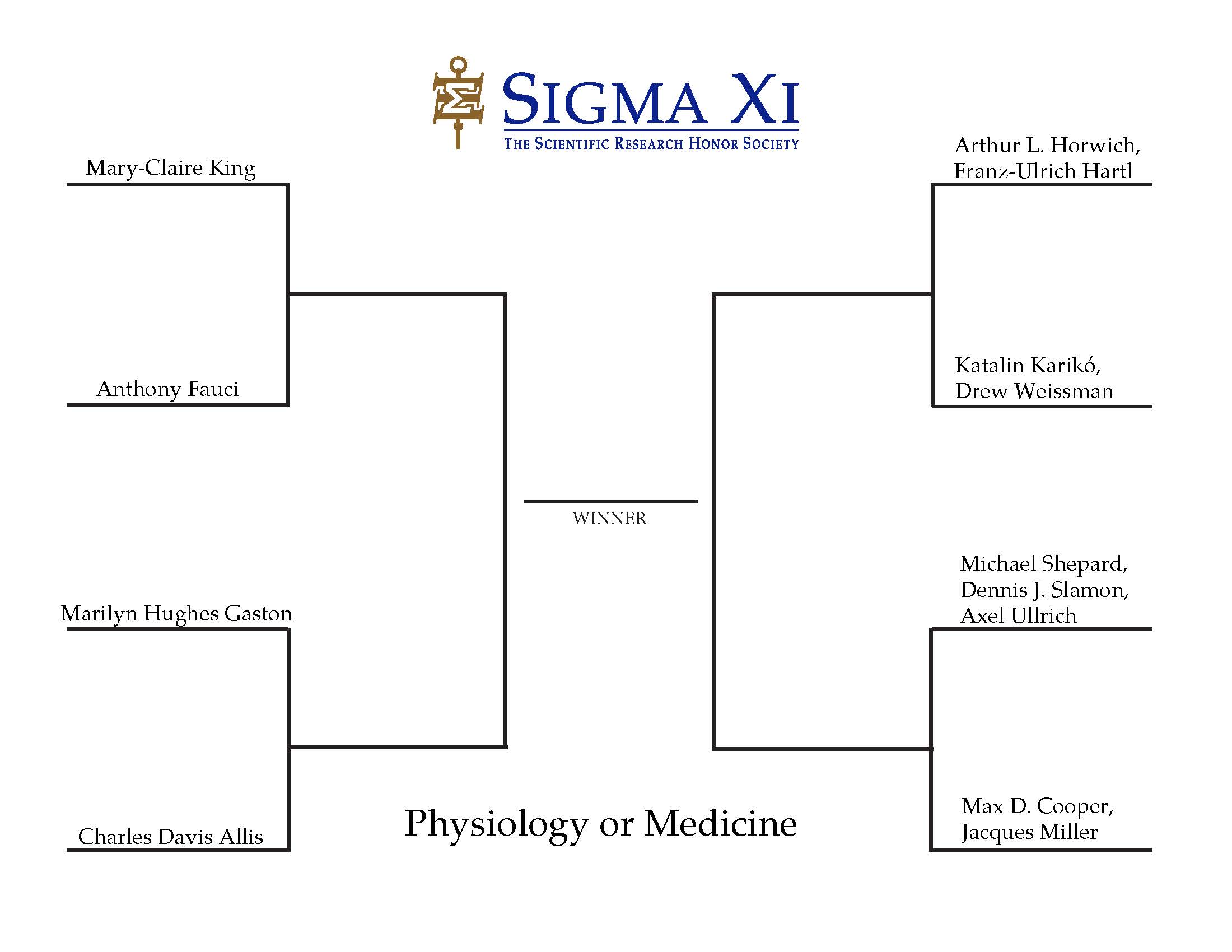
1.
Anthony Fauci, for his work during the COVID-19 pandemic
vs.
Mary-Claire King, for the discovery of BRCA1 Linkage and confirmation of an inherited risk of cancer
2.
Marilyn Hughes Gaston, for her work on sickle cell disease screening program for newborns and her research showed both the benefits of screening for sickle cell disease at birth and the effectiveness of penicillin to prevent infection from sepsis, which can be fatal in children with the disease
vs.
Charles David Allis, for discovery of epigenetics and histone modification
3.
Katalin Karikó and Drew Weissman, for the idea to harness the power of mRNA to fight disease and the discovery and commercialization of mRNA vaccines
vs.
Arthur L Horwich and Franz-Ulrich Hartl, for discovery of the role of molecular chaperons in protein folding in health and disease
4.
Max D. Cooper and Jacques Miller, for their discovery of the two distinct classes of lymphocytes, B and T cells – a monumental achievement that provided the organizing principle of the adaptive immune system and launched the course of modern immunology
vs.
Michael Shepard, Dennis J. Slamon, and Axel Ullrich, for their invention of Herceptin, the first monoclonal antibody that blocks a cancer-causing protein, and for its development as a life-saving therapy for women with breast cancer
-
by
Janelle Simmons
| Sep 14, 2021
Thanks to everyone who submitted nominations for the 2021 October Madness, Sigma Xi's Nobel Prize prediction contest!
Voting is open until September 15, 2021 at 11:59 p.m. Pacific Time for the Sweet 16 round.
Make sure to vote to keep your favorites in the running!
Sweet 16 Voting
Chemistry
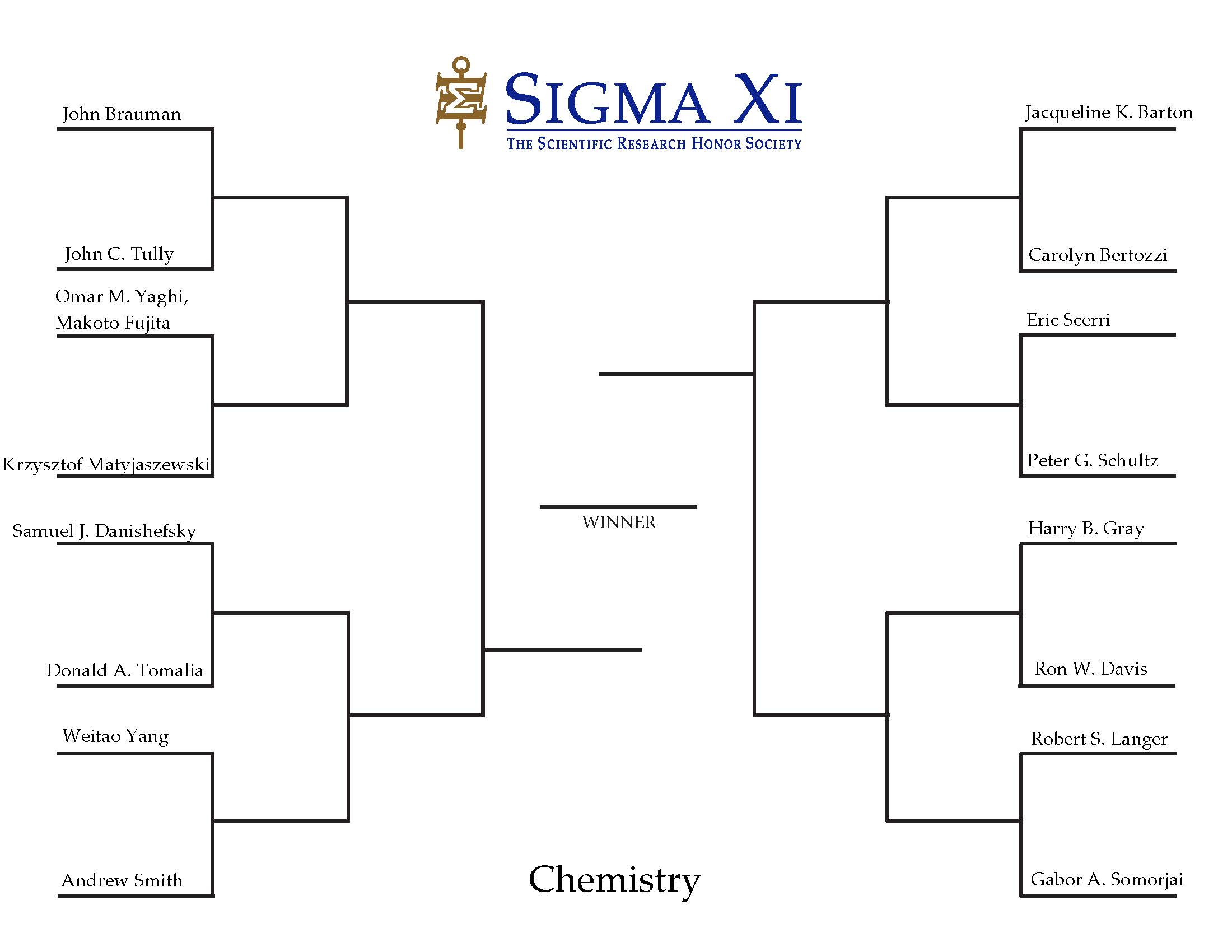
1.
John Brauman, for his contributions to the understanding of the factors that determine the rates and products of chemical reactions
vs.
John C. Tully, for his contributions to our understanding of the rates and pathways of chemical processes in gas phase, condensed phase, and surfaces through insightful analyses and creation of computational tools such as surface hopping
2.
Omar M. Yaghi and Makoto Fujita, for the development of metal-organic frameworks/coordination polymers and reticular chemistry; for pioneering reticular chemistry
vs.
Krzysztof Matyjaszewski, for the discovery of Atom Transfer Radical Polymerization (ATRP)
3.
Samuel J. Danishefsky, for his wide-ranging accomplishments in natural products total synthesis and for his pioneering chemical synthesis of carbohydrates for the development of anticancer vaccines.
vs.
Donald A. Tomalia, for the invention of the dendrimer family of polymers that have the capability of transporting pharmaceutical agents through cell walls for medicine
4.
Weitao Yang, for his contributions to density functional theory development, and its applications to chemistry
vs.
Andrew Smith, for the development of organocatalysis methodology to synthesize new heterocyclic ring systems
5.
Jacqueline K. Barton, for her pioneering contributions to our understanding of the chemical, biological and spectroscopic properties of the DNA double helix
vs.
Carolyn Bertozzi, for founding bio-orthogonal chemistry, and applying this novel chemistry to install artificial sugars on the surface of living cells, enabling the study of their roles in cancer and the immune system
6,
Eric Scerri, for his cross-discipline work on the Periodic Table of Elements
vs.
Peter G. Shultz, for his work in the exploitation of molecular diversity in the synthesis of new medicines and materials
7.
Harry B. Gray, for his work in electron transfer research; tunneling, bioinorganic chemistry
vs.
Ron W. Davis, for advancing technology in genomics, gene editing, and cloning
8.
Robert S. Langer, for development of nanocarriers as a platform for cancer therapy, and other biotechnology using his background as a chemical engineer, inventor, and entrepreneur
vs.
Gabor A. Somorjai, for his pioneering experimental and conceptual contributions to the understanding of surface chemistry and catalysis at a microscopic and molecular level
Physics
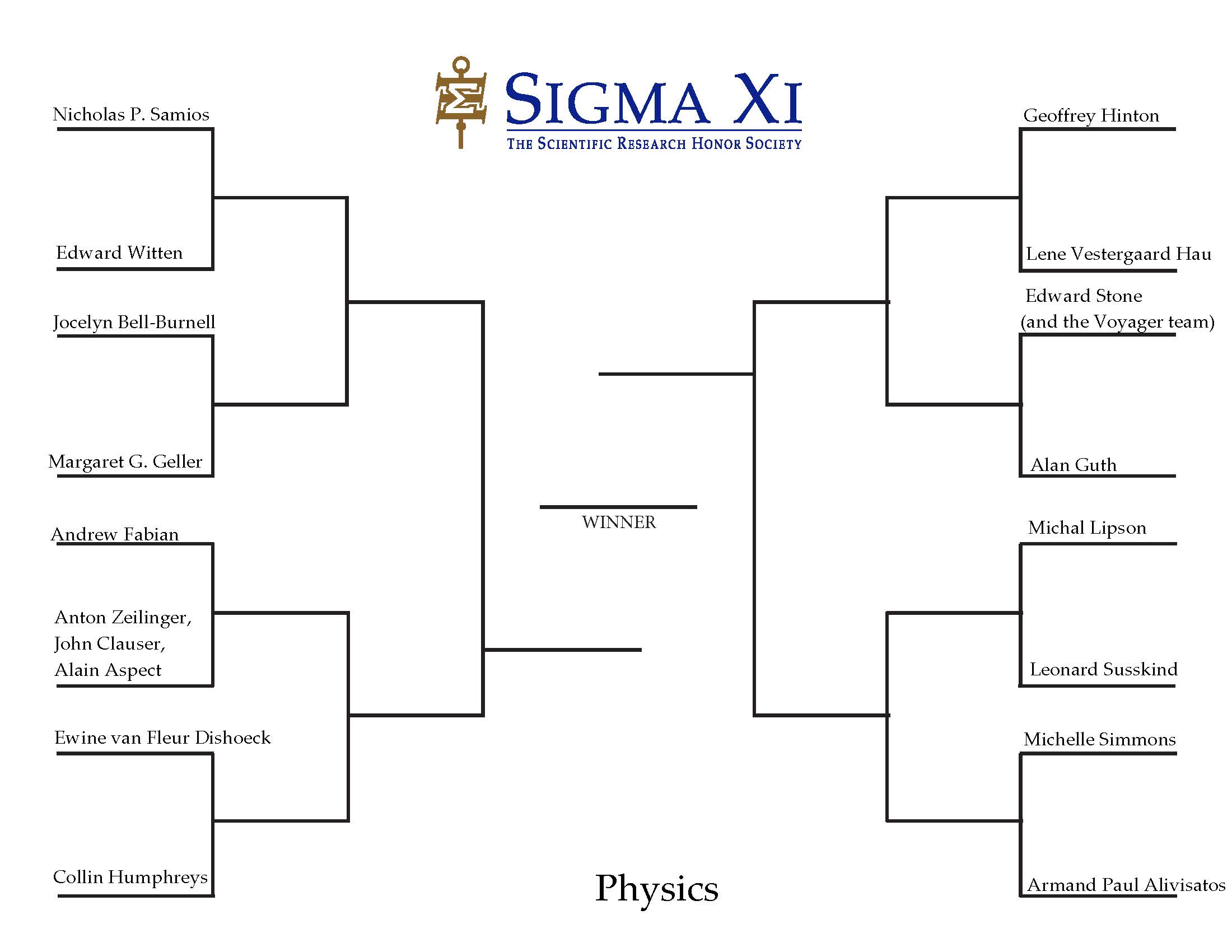
1.
Nicholas P. Samios, for the discovery of the Omega hyperon confirming the quark model
vs.
Edward Witten, for his work on string theory, quantum gravity, and supersymmetric quantum gravity
2.
Jocelyn Bell-Burnell, for her work on the discovery of pulsars, one of the major astronomical discoveries of the 20th century
vs.
Margaret G. Geller, for her work in mapping the nearby universe, providing a new view of the enormous patterns in the distribution of galaxies like the Milky Way
3.
Anton Zeilinger, John Clauser, and Alain Aspect, for their Bell’s inequality experiments, which established quantum entanglement
vs.
Andrew Fabian, for his research in the field of observational X-ray astronomy, from gas flows in clusters of galaxies to supermassive black holes at the heart of galaxies
4.
Collin Humphreys, for his research on gallium nitride (GaN), which has improved the understanding of this important material with a wide range of technological applications
vs.
Ewine van Fleur Dishoeck, for her research aimed at the determination of the structure of cosmic objects using their molecular spectra
5.
Geoffrey Hinton, for establishing the backpropagation algorithm to train multi-layer neural networks
vs.
Lene Vestergaard Hau, for her work on slowing down and stopping light
6.
Edward Stone (and the Voyager team), for heading the Voyager I/II missions, which have explored all of the outer planets and are now cruising interstellar space (the first human-made objects to do so)
vs.
Alan Guth, for providing observational evidence corroborating the cosmic inflation hypothesis
7.
Michal Lipson, for her pioneering research that established the groundwork for silicon photonics
vs.
Leonard Susskind, for his contributions to the string theory
8.
Michelle Simmons, for seminal contributions to our understanding of nature at the atomic-scale by creating a sequence of world-first quantum electronic devices in which individual atoms control device
vs.
Armand Paul Alivisatos, for making fundamental contributions to the controlled synthesis of colloidal inorganic nanocrystals, measuring and understanding their unique physical properties, and utilizing these properties for applications ranging from light generation and harvesting to biological imaging
Physiology or Medicine
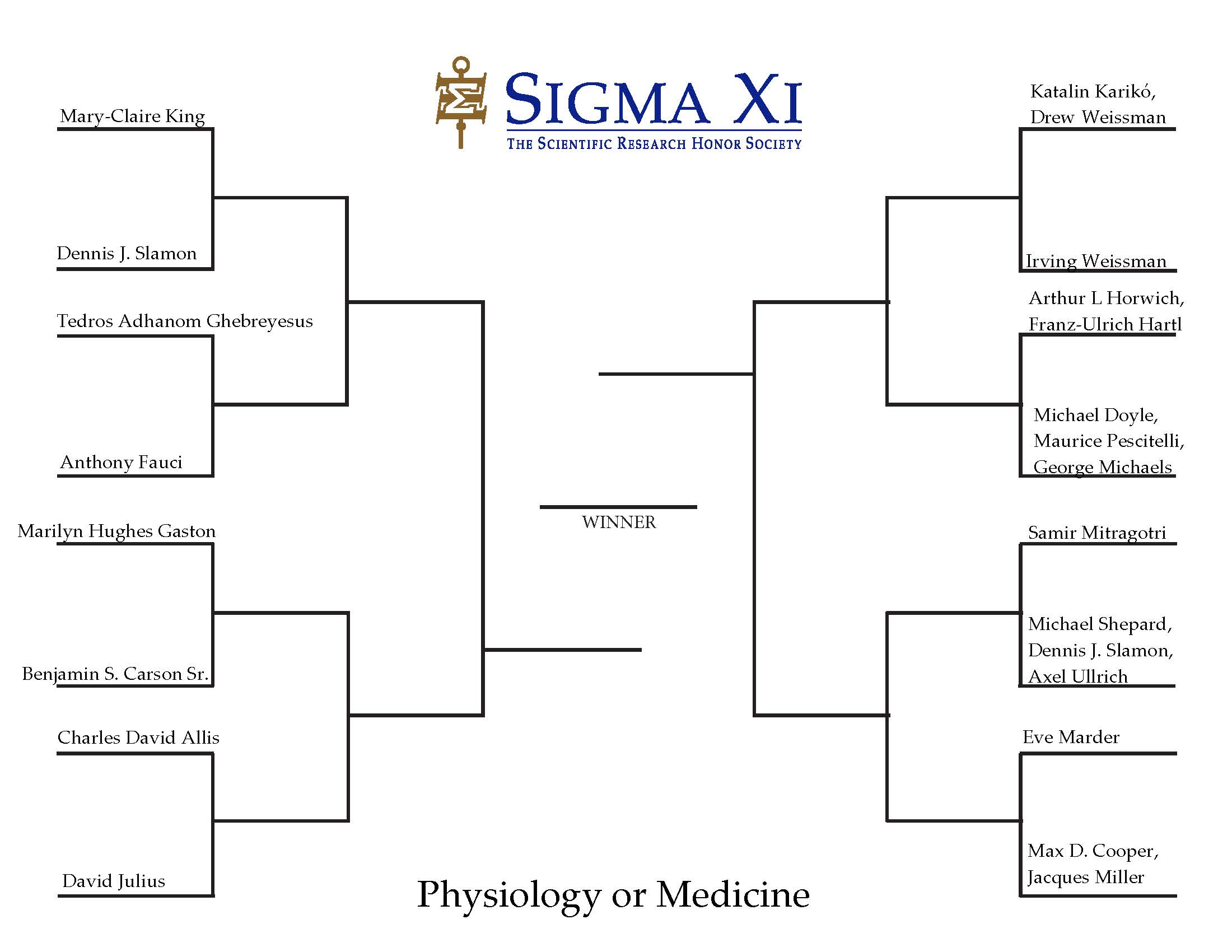
1.
Mary-Claire King, for the discovery of BRCA1 Linkage and confirmation of an inherited risk of cancer
vs.
Dennis J. Slamon, for discovering a breast cancer gene called HER2/neu and the treatment to reverse its tumor-growing effects
2.
Tedros Adhanom Ghebreyesus, for spearheading the response to the COVID-19 pandemic as the Director General of the World Health Organization (WHO)
vs.
Anthony Fauci, for his work during the COVID-19 pandemic
3.
Marilyn Hughes Gaston, for her work on sickle cell disease screening program for newborns and her research showed both the benefits of screening for sickle cell disease at birth and the effectiveness of penicillin to prevent infection from sepsis, which can be fatal in children with the disease.
vs.
Benjamin S. Carson Sr, for his work as the only neurosurgeon to successfully separate twins who are joined at the back of the head
4.
Charles David Allis, for discovery of epigenetics and histone modification
vs.
David Julius, for the identification of the biophysical basis of nociception
5.
Irving Weissman, for advances in immunology and stem cell biology
vs.
Katalin Karikó and Drew Weissman, for the idea to harness the power of mRNA to fight disease and the discovery and commercialization of mRNA vaccines
6..
Michael Doyle, Maurice Pescitelli, and George Michaels, for the invention of spatial transcriptomics
vs.
Arthur L Horwich and Franz-Ulrich Hartl, for discovery of the role of molecular chaperons in protein folding in health and disease
7.
Samir Mitragotri, for the discovery of red blood cell hitchhiking using nanoparticles for the intravenous cure of diseases
vs.
Michael Shepard, Dennis J. Slamon, and Axel Ullrich, for their invention of Herceptin, the first monoclonal antibody that blocks a cancer-causing protein, and for its development as a life-saving therapy for women with breast cancer
8.
Eve Marder, for her research over more than 40 years which provided transformative insight into the fundamental processes of animal and human brains
vs.
Max D. Cooper and Jacques Miller, for their discovery of the two distinct classes of lymphocytes, B and T cells – a monumental achievement that provided the organizing principle of the adaptive immune system and launched the course of modern immunology
-
by
Janelle Simmons
| Aug 31, 2021
October Madness, Sigma Xi's Nobel Prize prediction contest is back for its seventh year!
How it Works
Sigma Xi collects nominations from members and the public and then runs voting to advance researchers on our sports-style brackets. We hope you join in the fun as we wait for the official Nobel Prize announcements in October. But we need your nominations to get the contest kicked off! This is another way we can promote researchers and their outstanding achievements.
Tell us who you think will win a prize this year! We are calling for sixteen nominations each for the:
How to Nominate
Anyone can nominate and vote; Sigma Xi membership is not required to participate in October Madness. Send in your nominations by 11:59 p.m. PT on September 8 by using our nomination survey.
Please include:
-
Your nominee's name (you can submit as many nominations as you would like, and you can submit a group of researchers who worked on a project together)
-
Which prize you think this person, or group, should win
-
The reason why you think the person, or group, should win (such as, "for the discovery of XYZ")
-
The institution of employment or affiliation for your nominee(s)
-
Your name and email address
How to Vote
We will announce the October Madness nominees on September 10 and open the brackets for voting on Keyed In. You can also follow along on Sigma Xi's social media accounts on Twitter, Facebook, and LinkedIn. Remember to use #OctoberMadness!
Prizes
All nominators will be submitted into a drawing to win a Sigma Xi prize package!
If you nominate someone who goes on to win a Nobel Prize, you will also be entered into a raffle. Raffle winners who are not Sigma Xi members, affiliates, or explorers will receive a free year in the Sigma Xi Affiliate Circle* (a $50 value), which includes a one-year subscription to American Scientist magazine. Members, affiliates, or explorers who win the raffle will have their dues paid by Sigma Xi for Fiscal Year 2022 (July 1, 2021–June 30, 2022). Those who already renewed will have their dues paid for Fiscal Year 2023. We will select one winner per prize category for a total of three winners.
Schedule
August 31–September 8: Send in your nominations
September 13: Nominees announced; Sweet 16 voting begins and runs through September 15
September 17: Elite 8 winners announced; Elite 8 voting begins and runs through September 21.
September 23: Final 4 winners announced; Final 4 voting begins and runs through September 27.
September 28: Final voting begins and runs through September 30.
October 1: Prediction winners are announced.
October 4-11: Official Nobel Prize winners named.
October 13**: Winners announced from the raffle will win a year in the Sigma Xi Affiliate Circle or a free year of dues for members, affiliates, or explorers.
*Affiliate Circle status does not qualify one for full or associate membership in Sigma Xi's nomination-based honor society.
**If Sigma Xi receives less (or more) than 16 nominations per prize, then its staff will select the nominees who are put on the bracket. But we prefer to use your nominations! Please nominate anyone you feel is worthy of the prize. October Madness is not affiliated with the Nobel Prize.
Example of 2019's Finals Bracket for Chemistry
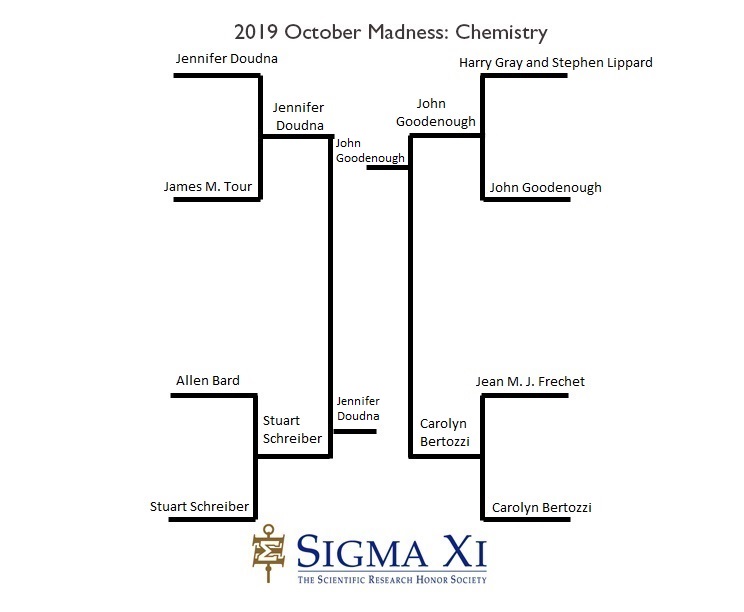
Sigma Xi looks forward to receiving your nominations!
-
by
Robert T. Pennock
| Aug 17, 2021

Sigma Xi has deep roots. The 2021 Annual Meeting and Student Research Conference, scheduled for November 4–7, will take place in conjunction with the Assembly of Delegates, which dates back to 1893. The long, rich history of the Society’s promotion of research excellence is well known, but the roots I have in mind run deeper still—the scientific virtues that ground the integrity of research practice. This year’s conference theme, Roots to Fruits: Responsible Research for a Flourishing Humanity, highlights these values and how they serve society.
Deliberations about ethics and science are a regular part of Sigma Xi meetings and have stimulated my own participation. In Vancouver in1998, I attended my first Sigma Xi Annual Meeting and gave a talk about justice and attribution of credit in research publications. In 2000, at the Albuquerque meeting, I organized a session on bioethics and gave a paper about how the virtuous scientist should address ethical concerns about human cloning. It was a small part of that year’s conference theme of New Ethical Challenges in Science and Technology. Such discussions help us make science better.
Often the phrase “ethical challenges” in this context is used to suggest areas in which research or its applications may need to be curtailed or adjusted to avoid something that is morally problematic. This is important, but not doing harm is only part of the challenge. Ethics also challenges us to do good. This year’s theme of Roots to Fruits provides an opportunity to consider how to grow efforts toward the ideal. How can cultivation of the deep scientific virtues contribute not only to a flourishing research culture but also to the larger goal of human betterment? Conference tracks will focus on our responsibility as scientists in research and discovery, technology innovation, and STEM education.
The lovely poster created for the conference (see inside back cover) illustrates the theme with the image of a tree. The fruits of science—discovery and innovation—are fed by the virtues that root the tree—curiosity, honesty, objectivity, and others. These values provide the integrity that gives the tree trunk its strength. The image also depicts some of the tasks that we must share as caretakers of the tree—watering its roots and pruning dead branches to maintain its vigor. The annual meeting is one venue where the scientific community gathers to contribute to this vital work. Registration for the conference is now open. I hope to see you there to help Sigma Xi continue to nurture the tree of science and its valuable fruits.
Sincerely,
Robert T. Pennock, Ph.D.
Sigma Xi President
-
by
Jamie Vernon
| Jul 27, 2021

Earlier this year, I reported on the Endless Frontier Act, which was legislation winding its way through Congress that would result in a dramatic influx of research funding to create a new Directorate for Technology and Innovation in the National Science Foundation (NSF) and increase the overall NSF budget. The bill has since been integrated into the United States Innovation and Competition Act (USICA), which was passed by the Senate in June.
The Endless Frontier Act provisions included $29 billion over five years to the new directorate and an increase in the overall annual budget of the NSF from $8.5 billion to $12 billion over the same period. It would establish a regional technology hub program; require a strategy and report on economic security, science, research, innovation, manufacturing, and job creation; and establish a critical supply chain resiliency program.
The USICA, which increases the total investment in science and technology to more than $200 billion over the next five years and includes national security measures, is a response to growing challenges to U.S. competitiveness on the global stage. As China and other nations continue to increase their investments in innovation, the U.S. has been slow to adapt to this new environment. This legislation could position the U.S. to advance in highly competitive technology markets including semiconductor manufacturing, artificial intelligence, robotics, and biotechnology.
While much attention has been focused on technology, the increase in the traditional NSF budget would also be a significant development. The NSF budget has remained near or below $8 billion since 1990. The new $12 billion budget represents a renewed commitment by the U.S. to its core system of innovation, including support for academic research. This system has proven effective for decades and makes sense to preserve and expand to ensure long term technological advancement.
The focus on science and technology has not been limited to the Senate. The House of Representatives advanced two complementary bills, as alternatives to the USICA. The National Science Foundation for the Future Act and the Department of Energy Science for the Future Act were both passed by the House in late June. These two bills represent a substantial increase in funding for scientific research and technology development. However, they differ based on the scale and focus of funding for basic and applied research. For example, the NSF for the Future Act would create an NSF Directorate for Science and Engineering Solutions (SES) with a ramping budget up to $3.4 billion in 2026, expand education and research on STEM, and increase NSF funding to $11 billion in the first year and up to $14.5 billion over the next five years.
I applaud the efforts of Congress to invest in the research enterprise. Scientific inquiry is fundamental to economic competitiveness and improving the human condition. Investment in research ensures that new questions will be answered, and new solutions will emerge. As with any legislation, I expect that the House and Senate will negotiate a bill that will look quite different from the original bills. However, my hope is that the final product will underscore the importance of science and technology and provide adequate support to meet the needs and expectations of the nation, while allowing for American research to remain a cooperative and inclusive endeavor. Our role in this process, as members of Sigma Xi, is to offer our support to the champions of science in Congress and to encourage them to continue this journey toward new and exciting frontiers.
Feel free to share your thoughts about these bills or how you plan to help improve or advance them by emailing executiveoffice@sigmaxi.org.
Sincerely,

Jamie L. Vernon
Sigma Xi Executive Director and CEO
-
by
Jamie Vernon
| Jun 25, 2021

On November 2, 2000, American astronaut Bill Shepherd, alongside Russian cosmonauts Sergei Krikalev and Yuri Gidzenko, swung open a bulky door to enter a darkened compartment that would serve as their home for the next 131 days. Their first acts as occupants of their new vessel were to turn on the lights, heat up water for drinks, and activate their lone toilet. And so it began: humankind’s longest continuous presence in space and the start of an unprecedented scientific collaboration aboard the International Space Station (ISS).
For the next four and a half months, the crew would activate critical life support systems, initiate computer controls, and unpack supplies. During its nearly 21 years of operation, the space station has expanded from its initial three-room design to feature 12 rooms, six sleeping compartments, three toilets, and a lookout tower, where it has conducted thousands of scientific experiments.
The space station is the culmination of a cooperative trend that has come a long way from the competitive nature of the Cold War era “space race.” While nations have historically relied on scientific innovations to drive economic competitiveness and demonstrate military capability, international scientific collaborations are now yielding benefits that would unlikely be achievable by any individual nation. Notable scientific partnerships include the discovery of the Higgs boson at CERN, sequencing of the human genome, the establishment of the Millennium Seed Bank, and the discovery of gravitational waves via the Laser Interferometer Gravitational-Wave Observatory (LIGO). Countries are now incentivized to maintain access to collaborative research or risk incalculable losses.
A small group of countries, bound by mutual linguistics and historical interests, previously constituted the bulk of global scientific cooperation. The traditional partners included the United States, the United Kingdom, Germany, France, Canada, Switzerland, and Japan. In recent years, openness among contributing nations has enabled greater access to the global research network and changed the landscape of partnerships.
The relationship between the U.S. and China has grown under the 1979 U.S.-China Science and Technology Cooperation Agreement. China has replaced the United Kingdom, Germany, and Japan as the top U.S. collaborator as measured by co-authored research papers. Chinese students have become the largest cohort of foreign science and engineering doctorates from American universities and the U.S. has benefited greatly from Chinese scientists who have chosen to become American citizens and join the U.S. research workforce. These changes have coincided with major investments in education, research, and development by the Chinese government, which has reduced the technological asymmetry that previously existed between the two nations. The cooperation agreement has expanded from primarily government agencies to include companies, universities, professional societies, non-governmental organizations, and individual collaborations. Overall, the science and technology relationship has become increasingly complex and productive.
Despite the increased cooperation, commercial competition and national politics have threatened the relationship between the U.S. and China. While the U.S. has allowed its investments in research and development to fall to a consistently low percentage of gross domestic product, China has increased its investments. Political uncertainties and budget disputes have also raised questions about U.S. commitment to research, imperiling its global technological leadership. These internal complications have created opportunities for other nations to take the lead on major scientific initiatives and capture the economic benefits of scientific and technological advancements. As a result, there is a growing tension between the U.S. and China on issues of collaborative research and development.
An emerging culture of science and technology nationalism in both nations now threatens global cooperation and scientific advancement. Ongoing challenges to intellectual property rights and criminal dissemination of corporate and national security secrets by Chinese scientists based in the United States have garnered national attention and resulted in legislation governing specific U.S.-China collaborations. While historical openness of the U.S. science and technology community has greatly strengthened China’s research capability and the flow of research talent to the U.S. has allowed for widespread and economically advantageous innovations, the nationalistic approach to research raises questions about the sustainability of the current relationship without adjustments that account for intellectual property and national security concerns.
These issues are not limited to the U.S. and China. International scientific collaborations continue to be the predominant trend in science. Research from international collaborations is regarded as higher quality and papers with multi-national authors are more highly cited. As international partnerships become more prevalent, it will be critical to determine the basis for sharing the benefits of the research products and to foster a culture of trust and cooperation that serves all participating nations.
A recent article in Issues in Science and Technology suggests that research funders are facilitating fair, open, and reciprocal international cooperation by broadening their portfolio of funding measures beyond basic research to mission-oriented and use-inspired research. The COVID-19 pandemic has been a common focus for many nations. Funders have come together across national borders to collaborate on SARS-COV-2 research to understand and resolve the health crisis. For similarly common challenges, such as climate change and global diseases, funders can create the conditions for successful international collaborations. Beyond supporting the technical resources, funders must help establish the cultural and ethical framework for effective cooperation. The authors cite seven general values and principles that must be discussed by funders:
- A strong research culture and commitment to international scientific standards of excellence
- Mutual respect, trust, and understanding of different scientific systems
- Research integrity and ethical conduct
- Reciprocity and equal access to funding and resources
- Independence, openness, transparency, and accountability
- Gender equality (e.g., hiring practices and pay)
- Free movement of people and ideas
Given these key values and principles, we must recognize the important role that professional societies, such as Sigma Xi, play in cultivating international collaborations that allow for greater peace, prosperity, and security. As a leader in fostering ethics and integrity in the research enterprise, Sigma Xi has promoted effective international scientific cooperation for decades. Although the Society is predominantly a U.S.-based organization, it supports several international chapters, inducts numerous foreign-born scientists annually, and conducts programs that serve international scientists and scientific collaborations.
Sigma Xi members pledge “…to foster companionship and cooperation among scientists [and] to maintain honor, integrity, and honesty in all scientific activities…” These commitments establish a foundation for common values that can serve as the basis for international collaboration. However, there is still work to be done to ensure the definitions of these values are clear and mutually agreed upon. To this end, Sigma Xi is committed to engaging scientists from all nations to discuss the requirements for promoting an ethical framework for international cooperation.
If you’d like to help Sigma Xi engage on this topic, please feel free to contact me at executiveoffice@sigmaxi.org.
Sincerely,

Jamie L. Vernon
Sigma Xi Executive Director and CEO
Related reading:
How National Science Funders Can Strengthen Global Collaboration and Avoid Isolationism
Issues in Science and Technology
International scientific collaborative activities and barriers to them in eight societies
Taylor & Francis Online
The Fourth Age of Research
Nature
First Science Adviser in US President’s Cabinet Talks COVID, Spying and More
Nature
Trends in U.S.-China Science and Technology Cooperation: Collaborative Knowledge Production for the Twenty-First Century?
U.S.-China Economic and Security Review Commission
Barriers to International Research Collaboration due to U.S. Sanctions
International Journal of Critical Illness and Injury Science
What is the International Space Station?
NASA
Tourists, Toilets, and 20 Years: Stories From the Space Station
Christian Science Monitor
Op-ed | 20 Years in Space: Lessons in Cooperation From the International Space Station
Space News
10 Badass International Science Collaborations That Will Blow Your Mind
BuzzFeed
Astronauts Growing New Organs on International Space Station
Independent
Chinese Scientists Ensnared in U.S. Visa Fraud Legal Battle
Reuters
-
by
Robert T. Pennock
| Jun 14, 2021

Registrants of the 2020 Sigma Xi Annual Meeting received a face mask sporting the Society’s gold key emblem and the phrase “Science Saves Lives.” I have seen a lot of masks with messages this pandemic year; one read simply: “Trust the science.”
Unfortunately, many Americans don’t trust the science. As we all know, mask wearing became politicized. One mask for sale online declares, “This mask is as useless as Joe Biden.” But science’s astounding success in confronting COVID-19 is evidence that it doesn’t deserve such mistrust.
Within a month of the appearance in Wuhan, China, in late December 2019 of an unknown acute respiratory disease, scientists had identified a novel coronavirus—SARS-CoV-2—as the cause. By the first week of February, the CDC was distributing the isolated virus strain to academic and industry researchers. Diagnostics tests that virologists developed appeared by spring and were broadly available by summer. It took a bit longer to determine that the risk of transmission by surface contamination is low; the virus spreads mostly by airborne droplets from the breath of infected people. (Yes, mask wearing is a useful preventive measure.) Vaccines were developed in record time. New masks express appreciation for this heroic achievement: “Thanks, Science. Vaccinated.”
But science cannot save lives if people don’t trust its findings, and too many also mistrust vaccines. In a March 2020 poll, a quarter of Americans said they were unwilling to be vaccinated. That’s too high for herd immunity, the level where enough individuals have been immunized to retard contagion. We now face a situation that favors the evolution of resistant strains. So, what can we do?
For science to be trusted, it must resist politicization and neutrally present the facts. Anti-vaxxers come from both political extremes—but the virus doesn’t discriminate, nor does the vaccine. Mask wearing is useful no matter which presidential candidate you supported or opposed. One mask message expressed that sentiment bluntly: “Science doesn’t care what you believe.”
Nonpartisan messaging may help allay one source of mistrust, but we must dig deeper to the roots of what makes science trustworthy: its values. Curiosity and the search for truth provide a moral structure to science. With its focus on honor in science, Sigma Xi has long been a standard-bearer for scientific values. This year we highlight them, beginning with this themed issue of American Scientist on science and trust. In the coming months, I’ll write about Sigma Xi’s other ethics initiatives. Please join us in helping make science both trusted and trustworthy; it does save lives.
Sincerely,
Robert T. Pennock, Ph.D.
Sigma Xi President-Elect
-
by
Jamie Vernon
| May 28, 2021
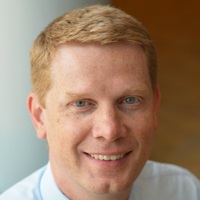
Earlier this month, Sigma Xi leadership installed two new chapters of the Society. These chapters, based at Whitworth University in Spokane, Washington and Midwestern University in Glendale, Arizona, represent the latest expansion of Sigma Xi’s local reach. For more than 130 years, Sigma Xi has built and nurtured a community of scientists and engineers joined together by their commitment to research excellence. The research enterprise today is much more complex, but the need to belong to a community has never been more important for early career researchers. These new chapters represent an important part of our growing community.
Sigma Xi chapters have been integral to fostering a culture of research excellence on nearly every major educational campus in the United States, numerous federal research facilities, industry laboratories, and many institutions around the world. Our chapters are the primary means by which the Society identifies and recognizes new talent as each generation puts forth its best and brightest students to advance our understanding of the universe.
Members have often shared with me the feeling of pride when they were nominated by their mentor or colleague based on their scientific achievements. It is thrilling today to see social media posts from students from around the globe sharing their feelings of satisfaction and validation after being nominated to be a part of this distinguished organization. And it is exciting to attend and witness induction ceremonies occurring in conjunction with graduations worldwide.
The requirements to become a member of Sigma Xi are not simply quantitative, such as GPA or class rank. The qualification for becoming a member is based on the recognition by a fellow researcher that one's scientific contributions are meaningful and noteworthy. The nature of this recognition brings joy to the faces of students who are nominated at the Sigma Xi Annual Meeting after winning their research division competition. I share these feelings each time I wear my Sigma Xi lapel pin to a conference or gathering of scientists and engineers and I have enjoyed invoking these feelings with each nomination of an accomplished colleague or student.
As executive director, I’ve also come to appreciate the broader role that Sigma Xi serves in mobilizing the research enterprise. Our chapters have historically provided support and encouragement during difficult times. After the1906 San Francisco earthquake, a three-member engineering team from the Sigma Xi Stanford chapter was commissioned to oversee reconstruction of the campus. The Berkeley chapter separately publicized its concerns about public health in the devastated city of San Francisco, where rapidly breeding rats gave rise to cases of bubonic plague. An eradication campaign led by the Berkeley chapter prodded public officials to action and raised funds. In recent years, we have seen chapters assist in the responses to Hurricane Harvey in Texas and Hurricane Maria in Puerto Rico.
The past year has challenged our ability to provide the connectivity that we have come to expect from our chapters. The pandemic disrupted activity at all levels. Research was slowed or halted, early career researchers were not able to demonstrate their talents, and many students have not had the privilege of being recognized for their accomplishments.
There have been glimmers of hope and moments of success. Sigma Xi members and chapters have responded directly to the pandemic, serving in official and unofficial roles to save lives. Sigma Xi headquarters and several chapters have filled the vocational void by providing Internet-based events, including a virtual annual meeting, online inductions, and research symposia. We have monitored research accomplishments throughout the year and nominated scientists and engineers who exhibit attributes of excellence when chapters were unable to do so. To help with feelings of anxiety, Sigma Xi offers 24/7 emotional support through our partnership with Happy the App. We have also continued to provide research funding to students who have been fortunate to resume their research projects.
As we emerge from isolation and social distancing, we should seek to honor the resiliency and persistence of all our members as well as those who seek to acquire a career in STEM. It will be important in the coming months to support one another as we return to our labs, plan trips for field work, fire up the core facilities, and get back to the work of discovery and development.
In addition to ramping up our research activities, I hope chapter leaders will consider the important roles they play in providing a network to help members as they attempt to return to normalcy. A simple social gathering could go a long way toward easing anxiety of the past year. These events can serve as the basis for discussions about how we maintain or restore our commitment to excellence.
For those chapter leaders who wish to do more, Sigma Xi will be reaching out to you to determine what types of programs you might like to organize to strengthen your community. We have identified six areas of excellence in which we will be seeking funding to support chapter programs: diversity, equity, and inclusion; ethics; STEM education; science communication; policy; and research support.
Feel free to contact me at executiveoffice@sigmaxi.org if your chapter would like to be a part of grant-seeking exercises or a pilot to support these types of events in your member community.
Sincerely,
Jamie L. Vernon
Sigma Xi Executive Director and CEO
-
by
Robert T. Pennock
| May 25, 2021

Sigma Xi has woven diversity, equity, and inclusion into the fabric of its culture. By combining diverse perspectives, we are equipped to discover a unified understanding of the world. Sigma Xi promotes universality and objectivity and welcomes the human differences that constitute the richness of our common humanity.
Scientific conclusions are to be drawn on the basis of the evidence, without bias, which is the basic principle of objectivity in scientific methods. Aiming to make assessments in fair and unbiased practices, Sigma Xi applies this principle to our treatment of people as well.
The Society welcomes all scientists and researchers without regard to age, sex, gender, religion, or race into this fellowship which is expressed in our name and motto “Companions in Zealous Research," where we work to strengthen those unrestricted ties of friendship, a common thread of Sigma Xi’s values.
Wouldn’t you like to be a part of the leadership of an organization that is founded on such values? Please consider nominating yourself or someone that you believe would contribute to the Society’s leadership today.
Sincerely,
Robert T. Pennock, Ph.D.
Sigma Xi President-Elect
Helpful Resources
-
To learn about open positions for the November 2021 Election and view duties and responsibilities for each, please visit www.sigmaxi.org/2021-elections.
-
Nominations should be sent to elections@sigmaxi.org.
-
Active, full members of Sigma Xi are eligible for office. An inactive member may become active at any time through payment of current dues.
-
by
Jason Papagan
| May 25, 2021
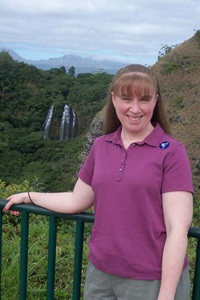
The following is a guest post written by Dana Baum, director of the Southeast Region of Sigma Xi:
Serving as a chapter delegate to the national Sigma Xi meeting opened my eyes to the many things that Sigma Xi was doing to strengthen the scientific enterprise at all levels. When approached to run for a leadership position, I saw this as my opportunity to step outside of my own scientific bubble and to work with an interdisciplinary group for the common goals of advancing STEM education and communication in the face of significant anti-science sentiment, addressing issues of diversity and inclusiveness, and re-energizing Sigma Xi’s history of leadership on ethics.
In my time as a Regional Director, I have learned so much and I am excited to engage in activities that extend beyond my home institution. I highly encourage you to consider running for a leadership role in Sigma Xi because you will gain new perspectives about what it means to be a researcher and how we can have a broader impact on society.
Respectfully,
Dana Baum, Ph.D.
Director, Southeast Region
• Nominations should be sent to elections@sigmaxi.org.
• Visit the open positions page for the November 2021 Election to view duties and responsibilities for each.
• Active, full members of Sigma Xi are eligible for office. An inactive member may become active at any time through payment of current dues.
-
by
Jason Papagan
| May 11, 2021
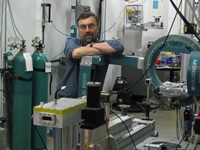
The following is a guest post written by Carlo Segre, director of the North Central Region of Sigma Xi:
Serving Sigma Xi as the director of the North Central Region has been very rewarding and has provided me the opportunity to contribute to the continuing health and vitality of the Society. While I had previously served as president of the Illinois Tech chapter, the opportunity to view the Society from a different perspective has given me new ideas that I will bring back to our chapter to make it better than ever. It has been a great experience and I hope to continue working with the Sigma Xi staff in the future whenever I can be of help.
The board needs new directors with new points of view and you can make a difference by standing for nomination. I would heartily recommend all Sigma Xi members to stand for directorship positions and nominate fellow members for candidacy. Serving on the board provides opportunities to broaden perspectives, shape future endeavors, and give back to the Society. Self-nominations are welcomed. Please follow the links below to learn more and submit nominations.
Respectfully,
Carlo Segre, Ph.D.
Director, North Central Region
• Nominations should be sent to elections@sigmaxi.org.
• Visit the open positions page for the November 2021 Election to view duties and responsibilities for each.
• Active, full members of Sigma Xi are eligible for office. An inactive member may become active at any time through payment of current dues.
-
by
Jamie Vernon
| Apr 27, 2021

This week we will mark the 100th day of the Biden presidency, which presents the opportunity to assess the impact the new administration has on the research enterprise. As with any transition of leadership in the federal government, the scientific community uniquely experiences changes in federal research priorities and policies. The scientific workforce is particularly sensitive to adjustments to levels of funding for research and education programs. Sigma Xi actively monitors these changes and strives to inform senior government officials and its members about their impact on the conduct of scientific research.
The Biden administration has expressed strong support for science. Prior to the election, candidate Biden stated that his administration would “listen to the scientists” and his initial actions have shown that to be the case. President Biden quickly moved to appoint Anthony Fauci as chief medical advisor to lead a team of experts in overseeing the administration’s response to the COVID-19 pandemic, which has largely proven to be successful based on recent reports that more than 200 million vaccinations have been administered to Americans in the past three months; cases, hospitalizations, and deaths from the virus have dramatically fallen; and the Centers for Disease Control and Prevention is cautiously advising businesses and schools to open. Science was also the basis for the United States to return to the Paris climate agreement and for the president’s decision to rejoin the World Health Organization. This commitment to the use of science in decision-making promises to improve the outcomes for the U.S. and the world.
The new administration has taken several steps to strengthen the federal research enterprise. On his first day in office, Biden announced a diverse and talented group to assume top scientific leadership positions within the federal government and that he would elevate the science advisor and director of the Office of Science and Technology Policy to a Cabinet level position. On January 27, the administration made a commitment to end political manipulation of scientific evidence by releasing a memorandum on scientific integrity. President Biden’s first proposed budget, unveiled on April 9, calls for major funding increases to research and development programs across non-defense agencies, including an increase of $9 billion to the National Institutes of Health, $1.7 billion added to the National Science Foundation, an additional $400 million to the Department of Energy Office of Science, and increases for other research departments and agencies. The administration puts additional focus on the nation’s aging highways, railways, and bridges in its $2 trillion infrastructure package, which heavily invests in building scientific and engineering capacity.
While these developments represent only a fraction of the actions taken, the administration has clearly demonstrated significant support for science and engineering. However, questions remain about how the new investments in research and development will be managed. There have been discussions about establishing multiple research units based on the Department of Defense Advanced Research Projects Agency (ARPA). Joining the Department of Energy’s ARPA-E, NIH would use $6.5 billion of its budget increase to establish an Advanced Research Projects Agency-Health to focus on cancer, diabetes, and Alzheimer's. There is also a proposal for an Advanced Research Projects Agency-Climate to develop a more aggressive global warming mitigation and adaptation strategy. The National Science Foundation is exploring a new technology directorate to achieve the nation’s innovation goals. Details about these proposals will be provided through forthcoming legislation and executive actions.
Sigma Xi is closely following the progress of several bills that are making their way through Congress, including the following:
Endless Frontier Act
The Endless Frontier Act was reintroduced last week in the Senate by a bipartisan group from the House and Senate. The bill adds a technology directorate to the National Science Foundation with a recommended budget of $100 billion over five years and creates a Commerce Department initiative to establish “technology hubs” in regions that are not already leading R&D centers.
National Science Foundation for the Future Act
This bipartisan bill, submitted by the House Science Committee, would add a directorate focused more broadly on societal science issues and double NSF’s budget over the next five years. The committee considers the bill to be an alternative to the Endless Frontier Act.
Securing American Leadership in Science and Technology Act (SALSTA)
Submitted by House Republicans on March 23, the act would authorize a doubling of basic research funding over the next decade at the Energy Department, National Science Foundation, National Institute of Standards and Technology, and National Oceanic and Atmospheric Administration with a wide range of specific mandates for each of those agencies and the Office of Science and Technology Policy.
Research Investment to Spark the Economy Act (RISE Act)
The bipartisan RISE Act would provide $25 billion to help restore our nation’s research capacity to its pre-pandemic strength, prevent setbacks against the formidable challenges our nation faces, and further the goal of a robust, diverse, and inclusive STEM workforce.
COVID-19 Hate Crimes Act
The bill, passed by the Senate on April 22 with a bipartisan vote of 94-1, is written to address the rise in hate crimes and violence against the AAPI community. The measure creates a Justice Department position to focus on this issue and increase state and local hate crime reporting.
To learn more about plans for the future of U.S. innovation, join tomorrow’s meeting of the Congressional Subcommittee on Research and Technology featuring testimony by National Science Board Chair Ellen Ochoa and NSF Director Sethuraman Panchanathan at: https://t.co/sxBYv169mH.
I am confident that the scientific community will continue to thrive under the Biden administration. However, it will be important to remain engaged to understand how any proposed changes to the system will affect our members and their ability to conduct research with excellence and with the ultimate goal of improving the human condition.
Please let us know about any research-related policies or legislation we should be following. Feel free to share your thoughts about the administration’s science policy initiatives by contacting me at executiveoffice@sigmaxi.org.
Sincerely,
Jamie L. Vernon
Sigma Xi Executive Director and CEO
-
by
Jason Papagan
| Mar 29, 2021
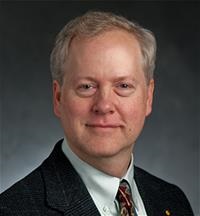
The following is a guest post written by President-elect Robert T. Pennock:
In November 2020, Sigma Xi adopted a new Diversity, Equity, and Inclusion resolution at the Society's Virtual Annual Meeting and Student Research Conference. The resolution states, “Sigma Xi, The Scientific Research Honor Society is committed to building an equitable and inclusive scientific and engineering community for all persons without regard to ethnicity, race, creed, cultural background, gender identity, national or native origin, physical ability, religious affiliation, or sexual orientation, and recognizes that all these vast diversities exist among, and benefit our membership.”
In my remarks at the meeting, I echoed these values and emphasized the Society's responsibility and commitment to the ideals of diversity, equity, and inclusion. Below is a transcript of those remarks:
"I want to join with the rest of the Society in extending my congratulations to those of you who have just been inducted into Sigma Xi, and I’d like to use my 10 minutes to say a bit of what I think that means.
Being elected to Sigma Xi is not like receiving an award that one displays on a shelf or just adds to one’s CV. Rather, it is an honor that involves being welcomed into a community. One is elected to membership. It is to be welcomed into a society of individuals who are called to a life of research, who share scientific values, and who commit to support each other in our shared passion to discover what might be learned about the natural world and to make it a better place for everyone.
I have spent the last six years collecting data in interviews from over 1100 scientists about the values and character virtues that are important for excellence in science. They center on curiosity and honesty. They include perseverance, objectivity, and others that together constitute integrity. Sigma Xi has always carried the banner for scientific excellence and integrity. The honor of being elected to the Society is the honor of being recognized as a role-model for others who may also be inspired to join in this curious vocation.
I’d like now to illustrate how these ideals are exemplified in the resolution on diversity, equity, and inclusion that was adopted by the Sigma Xi Assembly of Delegates. The resolution is new, but I contend that the values it describes were already contained in the fundamental values of the Society.
Let us begin with diversity.
Diversity refers to the human differences that constitute the richness of our common humanity. Sometimes we let our differences divide us rather than make us stronger together. But we know in science that it is by combining our diverse perspectives that we are better able to discover a unified understanding of the world.
The basis of science is the rejection of authority in favor of evidence. The idea is that nobody has any special privilege to pronounce what is true about the world. Rather, we are called to be humble to the evidence. That’s one of the key scientific virtues.
It does not matter the sex nor race nor party nor creed of who brings forth a hypothesis; it is the evidence they present that determines whether science should or should not accept it.
This is what we aim for with the values of universality and objectivity. These notions lead us to the second element of the resolution – equity.
Equity refers to evenhandedness, whereby judgments are made in ways that are fair and unbiased. In law and ethics, this ideal is depicted as the goddess Justitia, wearing a blindfold and holding the balanced, even scales of justice. The even scales denote the methods of judgment are to be unbiased. The blindfold denotes that the person holding the scales must be unbiased as well.
As we noted, scientific conclusions are to be drawn on the basis of the evidence, without bias in favor of one’s biased preference of one hypothesis over another. The equivalent scientific image should depict Justicia as a scientist in a lab coat holding an analytical balance and wearing a facemask to avoid sample contamination.
The point we should see in the DEI resolution is that this basic principle of objectivity in scientific method—aiming to make assessments in fair and unbiased procedures—applies in our treatment of people as well, which takes us on to the value of inclusion.
Inclusion refers to the openness of a community that, without prejudice, welcomes everyone into fellowship. This value flows from a key part of what is expressed in the name and motto of Sigma Xi, which is Companions in Zealous Research. There is much that could be said about this, but I will just point to the very roots of the society.
The Sigma Xi Constitution of 1886 speaks of the importance of “Friendship in Science." It states, "While those whose heart and soul is in their work are coping with the great problems of nature, let them remember that the ties of friendship cannot be investigated, but only felt. Let them join heart and hand, forming a brotherhood in Science and Engineering; thus promoting and encouraging by those strong, personal attachments of friendship, the highest and the truest advances in the scientific field.”
The reference to “brotherhood” reflects the gendered terminology of the day, but this scientific “fraternity” was not limited to men; five women were elected to full membership within the first three years. Inclusion in these “ties of friendship” and the ideals of science is, of course, unrestricted and we must work to strengthen them.
Today we speak of a fellowship in science and engineering where all curious seekers joyfully join in seeking to discover truths about the natural world and to create technologies to improve the human condition.
Some people get cynical about ethical ideals. We know that we are not perfect. Sometimes we are blind to our biases. The methods of science are crafted to help us keep from fooling ourselves. Scientific methods continue to be improved when biases are identified, and we must strive to do the same thing in our own character and mindset. These are ideals we aspire to. These are the values that make us who we are as scientists. This is the banner that Sigma Xi waves.
The theme of next year’s conference will focus on another implication of these values, namely the responsibility that science has to improving the human condition. We do this with our curiosity, our honesty, and our devotion to the unbiased pursuit of discovering truths about the natural world. We will consider the relationship between scientific flourishing and human flourishing.
I hope you will join us again next year in Niagara Falls, New York. I look forward to welcoming you all again then. In the meantime, continue to wave the banner of science, invite others into its fellowship, and, as always, stay curious.
-
by
Jamie Vernon
| Mar 16, 2021

In September 2020, I wrote about the mental health crisis among STEMM students, researchers, and educators. Despite increased attention to this issue at higher education institutions, the problem appears to be worsening during the COVID-19 pandemic and it is time for more creative and robust efforts.
According to a December 2020 survey by the American Council on Education, 68 percent of university presidents ranked their top two most pressing concerns as “student mental health” and the “mental health of faculty and staff.” The consequences of this crisis are not clear, but the insufficient response thus far has resulted in increasing levels of mental illness, substance use, and other forms of emotional distress among students.
A report from the National Academies of Sciences, Engineering, and Medicine (NASEM), released in January, calls for U.S. colleges and universities to undertake initiatives to improve the culture on their campuses and increase support for the well-being and mental health of their students. This request involves a multi-pronged approach, including “a focus on prevention, identification of high-risk students in a thoughtful way, effective community-based approaches, treatment services for identified cases, and relapse prevention and post-treatment support.” The authors of the report also suggest that higher education institutions should address institutional culture that can contribute to the increasing incidence of mental health and well-being concerns.
In 2019, the Council of Graduate Schools launched a two-year project, Supporting Mental Health and Wellness of Graduate Students, in collaboration with The Jed Foundation, a non-profit that exists to protect emotional health and prevent suicide for teens and young adults. This initiative will recommend evidence-based policies and resources to support graduate student mental health and well-being, prevent psychological distress, and address barriers to effective support and care.
While these initiatives will provide insightful guidance to higher education institutions and we look forward to their implementation, Sigma Xi recognizes an immediate need to offer emotional support during the pandemic emergency, economic turmoil, and social disruption its members are currently experiencing. Emotional support is a fundamental human need, and three in five Americans and many more worldwide are not getting nearly enough of it.
Therefore, I am pleased to announce that Sigma Xi has signed a one-year agreement with Happy the App, a 24/7 phone-based emotional support service. This partnership will allow Sigma Xi to offer free-of-charge support services to its members.
Happy ensures that people have on-demand access to genuinely caring people who are there to listen, console, and encourage them, any time day or night. Using their phone from the comfort of home, Sigma Xi members can make a call and immediately receive emotional support through Happy’s secure and confidential service.
Because we recognize that stress and anxiety are universal challenges across the research community, particularly during the pandemic, Sigma Xi members from all career stages and research sectors are encouraged to use these services.
Active members will receive an email this week that will provide additional details about the Sigma Xi and Happy partnership and our commitment to addressing the mental health needs of our community in a safe and healthy way. We will share how and when to use the free service, including the opportunity for wellness checks from Happy support givers and we cannot wait to share this new resource with all of you.
If you have questions or suggestions about improving mental health and well-being within the research enterprise, please send them to me at executiveoffice@sigmaxi.org.
Sincerely,
Jamie L. Vernon
Sigma Xi Executive Director and CEO
Related Reading:
As the pandemic erodes grad student mental health, academics sound the alarm
Source: Science
Amid concerns about grad student mental health, one university takes a novel approach
Source: Science
A Very Mixed Record on Grad Student Mental Health
Source: Inside Higher Ed
New Council of Graduate Schools initiative focuses on graduate student mental health and wellness
Source: Carolina Graduate School
Mental Health, Substance Use, and Wellbeing in Higher Education
Source: National Academies Press
Graduate students need more mental health support, study highlights
Source: Science
Evidence for a mental health crisis in graduate education
Source: Nature
Grappling with graduate student mental health and suicide
Source: Chemical and Engineering News
Trainees and mental health: Let’s talk!
Soure: Science
Science careers and mental health
Source: Nature
Supporting the Whole Student: Mental Health and Well-Being in STEMM Undergraduate and Graduate Education
Source: National Academies Press
College and university presidents respond to COVID-19: 2020 fall term survey, Part II
Source: American Council on Education
Graduate Student Mental Health and Well-being
Source: Council of Graduate Schools
-
by
User Not Found
| Feb 02, 2021
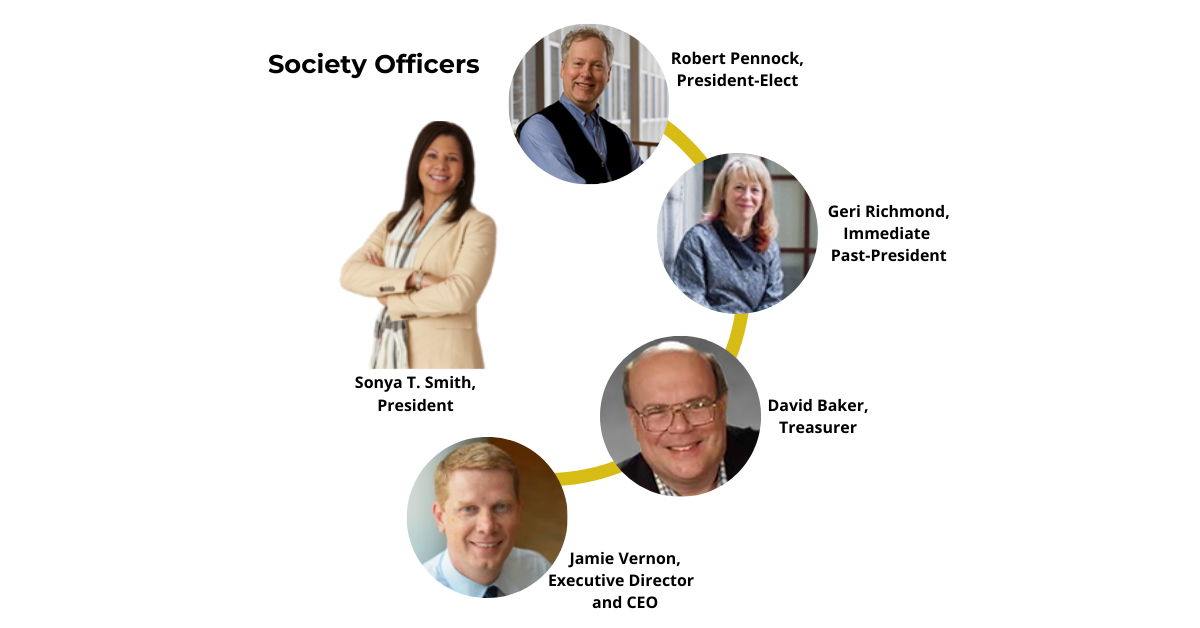
Many have looked forward to 2021 with hope and optimism for recovery from COVID-19, greater economic performance, and critical scientific advancements. Sigma Xi shares these expectations as we seek new leaders to guide us. Every organization and institution benefits from strong leadership to support their missions and move their visions forward.
Sigma Xi is fortunate to have such leaders who are experienced, knowledgeable, and actively involved with the membership and functions of the Society; leaders who are nominated and elected by our members.
The Society relies upon its members to nominate individuals who represent diverse backgrounds and experiences from within the membership and serve the Society well as officers, Directors, Associate Directors, and representatives on the Committee on Nominations.
Over the next few weeks, you will receive messages from past and current leaders who will share their experiences as leaders of the Society. Please consider nominating someone who will be a great leader, who shares the vision, and who will work to fulfill the Society’s mission. Self-nominations are welcomed. We want to hear from you, our members. LET YOUR VOICE BE HEARD, please nominate today.
To learn about open positions for the November 2021 Election and view duties and responsibilities for each, please visit www.sigmaxi.org/2021-elections
You may view the Strategic Plan and Annual Report to learn more about what your Society is doing.
Nominations should be sent to elections@sigmaxi.org.
Sincerely,

Jamie L. Vernon, PhD
Executive Director and CEO, Sigma Xi
Publisher, American Scientist
Active, full members of Sigma Xi are eligible for office. An inactive member may become active at any time through payment of current dues.
-
by
Jamie Vernon
| Jan 19, 2021
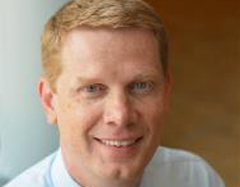
A recent survey of more than 1,000 people in 14 countries that was conducted before the pandemic, then again in 11 countries during the pandemic, found that trust in science has increased to a three-year high. These results are most likely attributable to the COVID-19 response led by the scientific community, which provided public health recommendations and developed multiple vaccines to prevent the spread of the COVID-19 virus. The media emphasis on biomedical science has brought new attention to the role of science in society. While the coverage of the pandemic has dominated science news and captured the public’s attention during the past year, the research enterprise has continued to generate insights and understanding in other areas that will become more evident as the threat of COVID-19 comes under control.
Here are a few of the things that might have been overlooked in the past year:
• SpaceX launched in May the first private vehicle to deliver astronauts to the International Space Station (ISS).
• New analysis of the Australian Murchison meteorite found grains of stardust that are the oldest material yet found on our planet, between 4.6 billion years and roughly 7 billion years old.
• The artificial intelligence company, DeepMind, developed an approach to predict the 3D structure of proteins faster than all other known techniques.
• NASA scientists determined that the recent unprecedented dimming of Betelgeuse, one of the brightest stars in the sky, was likely due to a cloud of stardust emitted by the star.
• A research team at the University of Rochester created the first room-temperature superconductor from a compound of hydrogen, carbon and sulfur, paving the way for the development of zero-resistance materials that can function at lower pressures.
These scientific achievements represent the breadth of research that advanced even as the pandemic brought much of the planet to an economic standstill. Sigma Xi continued its commitment to research by supporting hundreds of young scientists through its Grants in Aid of Research program by funding such projects as “Deciphering the role of ApoE4 in blood-brain barrier dysfunction in late-onset Alzheimer’s disease using human induced pluripotent stem cells” by Paulina Eberts of the University of Minnesota, Twin Cities and “Building an eyeball robot mechanism that can simulate eye movements with an eccentric preferred retinal locus in people with macular degeneration” by Kassia Love of Harvard University. We applaud the scientists and engineers who persisted with their research while simultaneously navigating the challenges created by the pandemic.
Sigma Xi’s promise to society is to improve the human condition by supporting a strong, ethical research enterprise and sharing the fruits of scientific research with the public. We exist to ensure that the steady progression of science creates opportunities to address other challenges facing humanity. To do so, we depend on strong, ethical leadership at the highest levels of government.
We were pleased to learn last Friday that president-elect Biden had chosen to elevate the director of the Office of Science and Technology Policy to a Cabinet-level position for the first time. The position will be held by Dr. Eric Lander, a mathematician and geneticist who helped map the human genome and founded the Broad Institute, a biomedical research center known for their work on the gene-editing technology CRISPR-Cas9. In addition, Biden has assembled a remarkable science team to lead the nation’s federal scientific enterprise. Dr. Alondra Nelson will serve as deputy director for science and society of the Office of Science and Technology Policy and Dr. Maria Zuber and Dr. Frances Arnold will serve as co-chairs of the President’s Council of Advisors on Science and Technology. Dr. Francis Collins will stay on as Director of the National Institutes of Health. The team will focus on five key areas: the coronavirus pandemic, the economy, the climate crisis, industry technology advancements, and the long-term health of science and technology in the country.
With new breakthroughs, new leadership, and renewed public support for science, there is much reason for optimism as we enter this New Year.
Let us know how you feel about the prospects for science in the coming years and how Sigma Xi can play a role by contacting Sigma Xi headquarters at executiveoffice@sigmaxi.org.
Sincerely,
Jamie L. Vernon
Sigma Xi Executive Director and CEO
-
by
Jamie Vernon
| Dec 15, 2020

Yesterday, Sandra Lindsay, a critical care nurse at Long Island Jewish Medical Center, became the first non-clinical trial subject in the United States to receive the Pfizer-BioNTech vaccine against SARS-CoV-2, the virus that has taken more than 300,000 American lives. By Friday, the U.S. Food and Drug Administration is expected to approve a second vaccine produced by Moderna. News of the vaccines offers a glimmer of hope in a year that has been plagued by hardship and suffering brought on by an otherwise highly flawed national response to the pandemic.
From the public’s perspective, the research and development that led to these new vaccines happened at a record setting pace, bringing with it the promise of relief from the pandemic. Operation Warp Speed, the U.S. federal program that enabled this breakthrough, was only announced on May 15, 2020. The strategy involved an unusual investment of $10 billion in several companies to simultaneously promote mass production of multiple vaccines. Although Pfizer did not accept Warp Speed funding, their “Project Lightspeed” was motivated by an advance purchase of 100 million doses of the vaccine for $2 billion. Despite such a massive investment, producing a vaccine in such a short time seemed improbable. Yet, the scientists rose to the challenge and delivered highly effective vaccines with unprecedented speed.
The funded companies took distinct approaches to develop the vaccine, and the most successful strategy has proven to be a relatively new technology based on mRNA. Both BioNTech and Moderna designed vaccines that rely on injection of RNA to stimulate an immune response in the body. While the technology underpinning these vaccines is quite new, the process that resulted in these remarkable medical advances has actually taken more than 100 years with contributions from countless, diverse scientists and society’s unwavering commitment to scientific discovery.
To provide some context, the following milestones paved the way to this pivotal moment:
Early 1900s – RNA was discovered.
1930s – RNA localization in the cell was refined.
1950s – Francis Crick at Cambridge University proposed the “Central Dogma of Molecular Biology,” which assigned a function of RNA as the template for protein production in the cell.
1955-1957 – Heinz Fraenkel-Conrat, Bea Singer, and Robley C Williams at the University of California, Berkeley demonstrated that RNA was involved in viral infectivity.
1960s – Researchers characterized the role of messenger RNA and elucidated the genetic code.
1965 – David Tyrrell at the United Kingdom’s Medical Research Council discovered the first human coronavirus, identified by a crown-like surface morphology.
1978 - Katalin Karikó began investigating RNA in Hungary.
1989 - Katalin Karikó wrote her first NIH grant proposal as a professor at the University of Pennsylvania to use mRNA as a therapeutic.
1990 – John Wolff, Phil Felgner and colleagues at the University of Wisconsin demonstrated that native RNA could be injected directly into muscle in mice to express proteins.
1990s - Peter Lijestrom at the Karolinska Institute used self-amplifying viral replicons to reduce the amount of material required to raise an immune response.
1994 – X. Zhou and Peter Berglund at the Karolinska Institute published the first evidence that an RNA vaccine could elicit both humoral and cellular immune response against a pathogen.
2005 - Katalin Karikó and Drew Weissman at the University of Pennsylvania demonstrated that modified nucleosides allowed synthetic RNA to circumvent the human immune system.
2008 - Ugur Sahin and Özlem Türeci co-founded BioNTech and licensed Karikó and Weissman’s technology to create personalized vaccines that teach the immune system to eliminate cancer cells.
2010 - Derrick Rossi, Robert Langer, Noubar Afeyan, and another physician-researcher formed Moderna, a new word created by combining modified and RNA, to deliver an entirely new drug category to the pharmaceutical market.
2013 – Novartis (with funding from DARPA and the Biomedical Advanced Research and Development Authority, BARDA) partnered with Craig Venter’s Synthetic Genomics and Synthetic Genomics Vaccines teams to raise neutralizing antibodies in mice against a synthetic RNA based on the Chinese H7N9 viral genome sequence.
This history reminds us that science is a continuum that creates opportunities as it progresses. While few could have predicted the challenges we would face due to COVID-19, it is entirely predictable that a strong research enterprise through industry, philanthropy, and federal funding has made it possible to defeat this virus. Sigma Xi is proud to have at the heart of its mission the goal of maintaining a strong research enterprise to ensure that no technical problem goes unsolved and no call to action goes unanswered. Though the road ahead is long and winding, thanks to the research community, past and present, the future looks promising.
According to a recent public poll conducted by ScienceCounts, a nonprofit organization working to strengthen public support for science, 63% of respondents said when they hear the word “science,” “hope” comes to mind. These results suggest that scientists are in the business of providing hope. During this time of the year and under these circumstances, it’s entirely appropriate to embrace that role.
Happy holidays!
Sincerely,
Jamie L. Vernon
Sigma Xi Executive Director and CEO
-
by
Jamie Vernon
| Nov 11, 2020
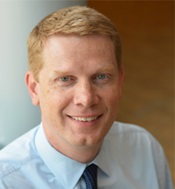 In February, just as the first cases of COVID-19 were being reported within the United States, I traveled to the National Academy of Sciences building in Washington, DC to commemorate the 75th anniversary of the publication of Vannevar Bush’s monumental report, Science: The Endless Frontier. This report established the nation’s rationale for government-sponsored basic research and ushered in the golden age of American science in the post-World War II era.
In February, just as the first cases of COVID-19 were being reported within the United States, I traveled to the National Academy of Sciences building in Washington, DC to commemorate the 75th anniversary of the publication of Vannevar Bush’s monumental report, Science: The Endless Frontier. This report established the nation’s rationale for government-sponsored basic research and ushered in the golden age of American science in the post-World War II era.
Following on the wartime successes credited to national investments in science and technology, President Franklin D. Roosevelt tasked Bush with devising a plan for expanding the nation’s research activities for more peaceful purposes. Bush’s report called for a centralized approach to federally funded research that backed undirected individual scientists while minimizing political influence in their work. It led to the formation of the National Science Foundation and the development of the modern American research university. Dramatic increases in government funding for science in subsequent decades led to the establishment of additional federal agencies to conduct and administer intramural and extramural research, inform policy decisions, and fuel unparalleled progress toward national policy goals involving health, environment, defense, and the economy.
This system has enabled the United States to lead the world in scientific and technological productivity for decades. Because the system is intended to benefit society through mostly unfettered curiosity-driven science, the public has come to expect certain norms from the federal research enterprise. They expect federal scientists to be independent from political or industrial influence; protected from censorship; and empowered to speak freely to the public and the news media about their work. They expect scientific information produced by federal scientists to be made available to the public in a timely manner and they expect federal scientists to follow scientific integrity guidelines.
The system has proven to be imperfectly safeguarded and protections must be established to preserve scientific integrity. In recent years federal science has experienced significant erosion of public trust due to a failure to uphold basic norms. The Union of Concerned Scientists has documented numerous actions by the Trump administration that have undermined public trust in information coming from federal science agencies, including the sidelining of expertise and independent scientific advisors, compromising of public protections, and reducing public and media access to government science and scientists.
The COVID-19 pandemic has magnified the administration’s antipathy toward aspects of the federal research enterprise. Throughout the pandemic, President Trump has criticized and refused to enforce the guidance of the White House Coronavirus Task Force. He has promoted unproven COVID-19 treatments and ridiculed the wearing of masks, which the Centers for Disease Control and Prevention argues is the most effective way to prevent the spread of the virus. He has opposed Federal Drug Administration safety procedures, compromised data collection and reporting, and pressured researchers and manufacturers to deliver a vaccine in time to influence the Presidential election.
In the past few weeks, the President has threatened to terminate Anthony Fauci, director of the National Institute of Allergy and Infectious Diseases, while he has embraced advice from a neuroradiologist, Dr. Scott Atlas. Dr. Atlas has made several statements that contradict what experts say about COVID-19. Some have argued that he is promoting a flawed herd immunity approach to controlling the virus that could increase death rates in the United States. His comments prompted a group of 98 of his Stanford University colleagues to publish an open letter calling attention to his falsehoods and misrepresentations of science.
The administration’s public opposition to expert advice on COVID-19 has politicized the response to the pandemic and gravely undermined the public’s trust in the nation’s public health institutions. Large segments of the population have been persuaded by the President’s arguments and have chosen to reject the recommendations from local, state, and national health agencies. As a result, the United States has suffered more than 10 million cases and at least 230,000 deaths from the virus.
Having just completed a Presidential election in which former Vice President Joe Biden has defeated the incumbent President Donald Trump, the country will now undergo a transition of power that will be accompanied by a transition of management of the federal research enterprise. Sigma Xi has an interest in restoring and promoting scientific integrity in all aspects of the research enterprise; therefore we will be calling on the Biden administration to audit the federal agencies to determine where it is necessary to restore public trust. By rebuilding its relationship with the public, federal scientists can return to the pursuit of Bush’s endless frontier and focus on delivering the benefits of scientific research to society.
While there are no guarantees that the incoming Biden administration will reinstate the appropriate standards for scientific integrity, there is reason to believe that the administration will take a friendlier approach to science. Biden has stated that he will “listen to the scientists” in regards to the COVID-19 response. It is incumbent on us to encourage him and his administration to embrace science and promote scientific integrity across the federal government—from public health to climate change. In addition, the scientific community can directly recommend science policies and scientific expertise to be adopted and developed by the administration.
Just as we did in 2016 during the transition to the Trump administration, Sigma Xi is gathering nominations of experts from its membership and beyond to submit to the Biden transition team. If you would like to recommend a colleague or yourself for consideration, please contact Sigma Xi headquarters at executiveoffice@sigmaxi.org.
Sincerely,
Jamie L. Vernon
Sigma Xi Executive Director and CEO

-
by
User Not Found
| Oct 16, 2020
Thank you for following along with the sixth year of Sigma Xi's Nobel Prize prediction contest, October Madness! We are pleased to announce the prediction you made for the 2020 Chemistry bracket, Jennifer Doudna, won the Nobel Prize along with Emmanuelle Charpentier. They were selected to win the 2020 Nobel Prize in chemistry for their development of a method for genome editing.
Drawing Winner
Nominations for the October Madness brackets were submitted before the Nobel Prizes were announced. Those who nominated someone who went on to win a 2020 Nobel Prize were entered into two drawings. Those who submitted nominations had a chance to win a Sigma Xi blanket and also could win a free year of membership dues if their nomination won a Nobel Prize!
Thanks to all who submitted nominations. Congratulations to David A. Hunt, the winner of the Sigma Xi blanket. The winner of this year's drawing for a free year of membership is Sigma Xi member Dr. John Hidebrand, who nominated Jennifer Doudna and Emmanuelle Charpentier for our brackets. Congratulations on winning a year of membership dues, Dr. Hildebrand! Watch for an email from me with more details.
What's Next
Check back here on Keyed In next summer for the 2021 edition of October Madness! You can also follow along on Sigma Xi's social media with #OctoberMadness.
A Look Back at the 2020 Edition of October Madness
Announcement of Champions
Finals Round
Final 4 Round
Elite 8 Round
Call for Nominations
-
by
User Not Found
| Oct 01, 2020
After collecting public nominations and three rounds of voting, we're ready to announce your top predictions for the 2020 Nobel Prizes in chemistry, physics, and physiology or medicine!
Your prediction for the Nobel Prize in Chemistry is...
Jennifer Doudna, for her co-discovery of CRISPR-Cas9 genetic engineering technology.
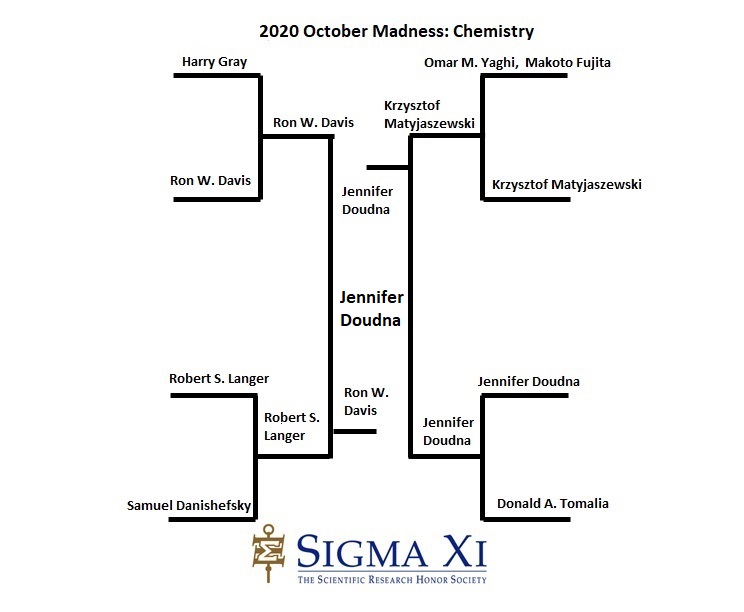
Your prediction for the Nobel Prize in Physics is...
Lene Vestergaard Hau, for her work on slowing down and stopping light.
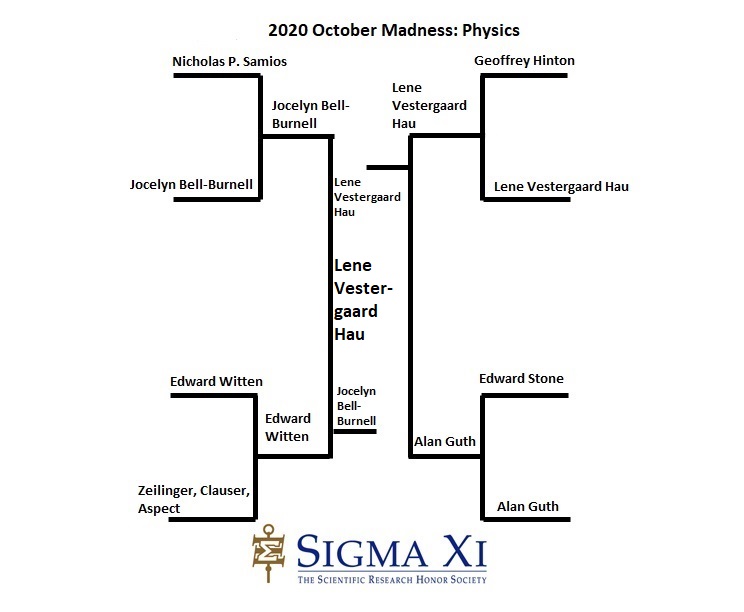
Your prediction for the Nobel Prize in Physiology or Medicine is...
Mary-Claire King, for the discovery ofBRCA1 Linkage and confirmation of an inherited risk of cancer
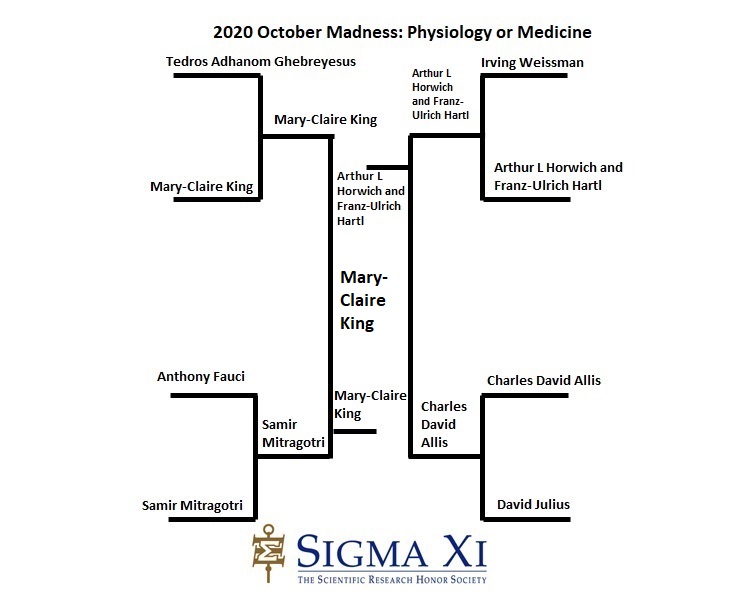
Congratulations to these researchers!
Thanks to everyone for voting!
What Happens Next
- Watch for the official Nobel Prize announcements.
The Nobel Prize in Physiology or Medicine - Monday, October 5, 11:30 a.m. CEST at the earliest
The Nobel Prize in Physics - Tuesday, October 6, 11:45 a.m. CEST at the earliest
The Nobel Prize in Chemistry - Wednesday, October 7, 11:45 a.m. CEST at the earliest
The Nobel Peace Prize - Friday, October 9, 11:00 a.m. CEST
The Sveriges Riksbank Prize in Economic Sciences in Memory of Alfred Nobel - Monday, October 12, 11:45 a.m. CEST at the earliest
The Nobel Prize in Literature - Thursday, October 8, 1:00 p.m. CEST at the earliest
Times listed are local time in Sweden.
- See what others are predicting for this year's Nobel Prizes.
The 2020 Clarivate Analytics Citation Laureates
- Check back here on Keyed In on October 13 to see if anyone won the prize of one year of dues for Sigma Xi membership (for current members only) or for the Sigma Xi Affiliate Circle. Those whose October Madness nominees win a Nobel Prize are eligible for the raffle.
- Take a look back on October Madness through the years:
2019 Predictions
2018 Predictions
2017 Predictions
2016 Predictions
2015 Predictions
-
by
Jamie Vernon
| Sep 29, 2020
 In a recent post on Twitter, Dr. Anthony Ocampo, assistant professor of sociology at California State Polytechnic University, Pomona and a Ford Foundation Fellow, wrote that he asked his students to respond anonymously to the prompt “Things You Wish Your Professors Knew." With their permission, he paraphrased the responses in subsequent posts. The first response that he shared from a student stated, “quarantine is impacting my mental health.” I think it’s fair to say that this student is not alone. The COVID-19 crisis is affecting all of us in unexpected ways, and anecdotal evidence suggests that the current situation is likely to be exacerbating mental health challenges within the research community.
In a recent post on Twitter, Dr. Anthony Ocampo, assistant professor of sociology at California State Polytechnic University, Pomona and a Ford Foundation Fellow, wrote that he asked his students to respond anonymously to the prompt “Things You Wish Your Professors Knew." With their permission, he paraphrased the responses in subsequent posts. The first response that he shared from a student stated, “quarantine is impacting my mental health.” I think it’s fair to say that this student is not alone. The COVID-19 crisis is affecting all of us in unexpected ways, and anecdotal evidence suggests that the current situation is likely to be exacerbating mental health challenges within the research community.
Prior to the coronavirus pandemic, Nature assembled a collection titled “Science careers and mental health” that included numerous reports and articles on this important issue. The collection covered a variety of topics including stress, anxiety, imposter syndrome, perfectionism, grief, depression, and burnout. The editors cited a 2017 Nature survey, which showed 12% of all respondents had sought help for anxiety or depression caused by their PhD studies. A 2018 survey found that about 40% of graduate students experienced moderate to severe depression and anxiety. In social media posts, letters, and essays written by faculty and students working in STEM fields, we’re learning that COVID-19 is adding to an already prevalent problem and that students, researchers, and educators are facing a mental health crisis.
Efforts are underway by universities and colleges to provide help and assistance. The approaches range from cultivating mentorship skills to developing and promoting peer support for colleagues. In 2018, the Higher Education Funding Council for England announced it would put a total of $2 million (£1.5 million) towards improving mental health at 17 of its universities with several initiatives designed to better train and equip PhD supervisors to mentor their students. According to a recent C&EN article, at the University of Detroit Mercy, Matthew Mio, chair of chemistry and biochemistry, personally checks in with the 16 faculty members in his department and physics weekly. To support his own mental health, he meets with a therapist and uses the Calm app, which promotes meditation and is free for educators.
While there is a lot of activity in this area, it appears individual institutions are developing initiatives based on their own needs and there are few overarching, systemic approaches. In 2019, the Council of Graduate Schools and the Jed Foundation launched a research project to assess the state of mental-health resources and support for graduate students. The initiative will provide recommendations for future approaches to promote mental and emotional well being in students. The results of this monumental project will be released later this year.
On October 10, 2020, the World Health Organization will recognize World Mental Health Day. Given the unique circumstances created by COVID-19, it will be of utmost importance to consider how to immediately help invest in mental health. Sigma Xi is exploring ways to serve its members and the broader research community. From healthcare workers providing support under difficult circumstances to students who are adjusting to remote classes, we welcome your recommendations for providing relief to those who need it.
Please also let us know in the comments below if there are successful steps being taken by your institution so that we may share them with others who are exploring solutions to these challenges.
Related Reading
A better future for graduate-student mental health
Source: Nature
Staying in and Staying Healthy: Insights for Positive Mental Health in Graduate School
Source: The Behavioral Neuroscientist and Comparative Psychologist
Science careers and mental health
Source: Nature
The Emotional Toll of Graduate School
Source: Scientific American
I wish I’d taken my mental health more seriously in grad school
Source: Science
Mental Health Crisis for Grad Students
Source: Inside Higher Education
Jamie Vernon is the executive director and CEO at Sigma Xi, The Scientific Research Honor Society, and publisher of American Scientist.
-
by
User Not Found
| Sep 25, 2020
We're down to the finals of Sigma Xi's Nobel Prize prediction contest, October Madness! Your votes this week are more important than ever because you can help your top picks become October Madness champions!
Voting Deadline
Voting is open until September 30, 2020, at 11:59 a.m. Pacific Time.
Chemistry
Who Could Win the 2020 Nobel Prize in Chemistry? Vote Now!
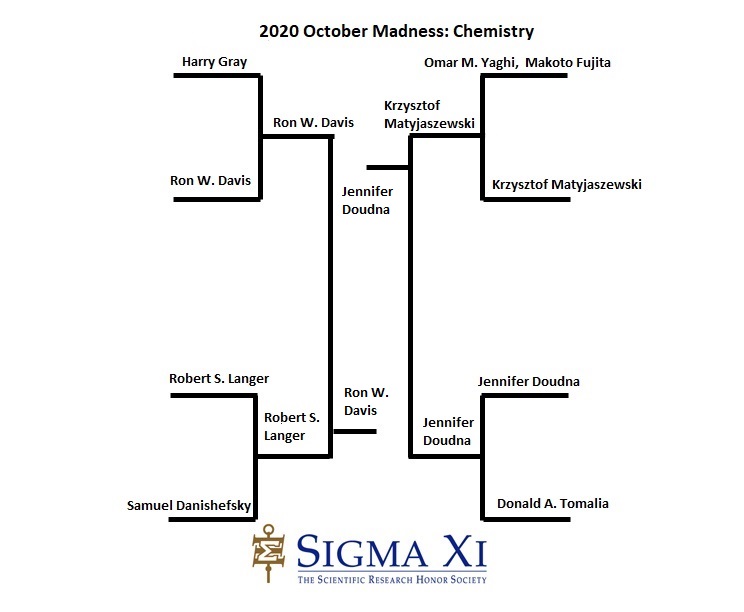
The final chemistry match-up is:
Jennifer Doudna, for her co-discovery of CRISPR-Cas9 genetic engineering technology
Vs.
Ron W. Davis, for advancing technology in genomics, gene editing, and cloning
Physics
Who Could Win the 2020 Nobel Prize in Physics? Vote Now!
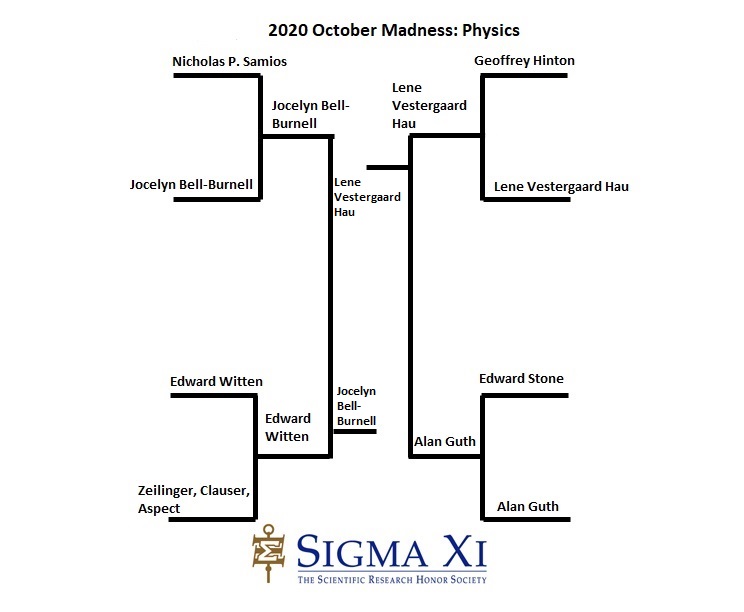
The final physics match-up is:
Lene Vestergaard Hau, for her work on slowing down and stopping light
Vs.
Jocelyn Bell-Burnell, for discovery of first radio pulsars
Physiology or Medicine
Who Could Win the 2020 Nobel Prize in Physiology or Medicine? Vote Now!
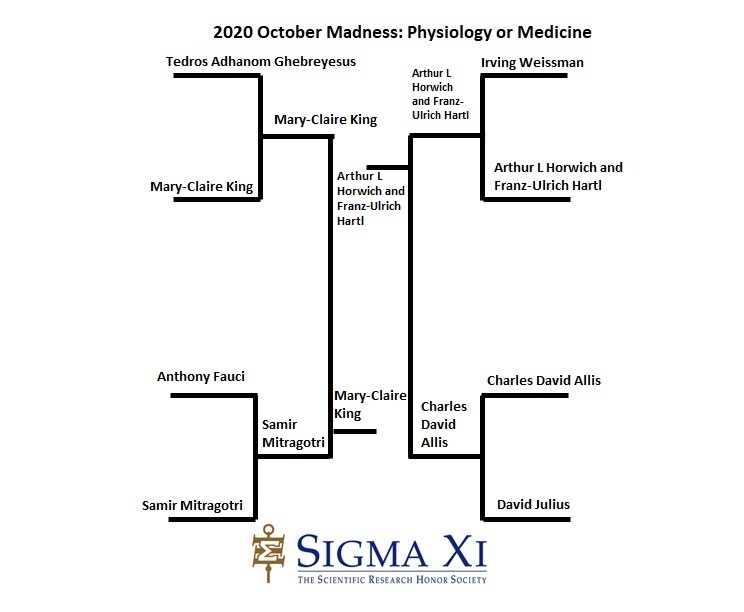
The final physiology or medicine match-up is:
Mary-Claire King, for the discovery of BRCA1 Linkage and confirmation of an inherited risk of cancer
Vs.
Arthur L Horwich and Franz-Ulrich Hartl, for discovery molecular chaperon and quality control of protein folding in health and disease
What Happens Next?
Results for the brackets will be announced here on Keyed In and Sigma Xi's social media on October 1. Good luck!
October Madness is not affiliated with the Nobel Prize.
-
by
User Not Found
| Sep 18, 2020
We're down to the Final 4 of Sigma Xi's Nobel Prize prediction contest, October Madness! Vote to make sure your top picks make it to the finals. Each person is eligible to cast one vote per category, for a total of three votes.
Voting is open until 11:59 p.m. Pacific Time on September 23, 2020, for the Final 4 round.
Final 4 Voting
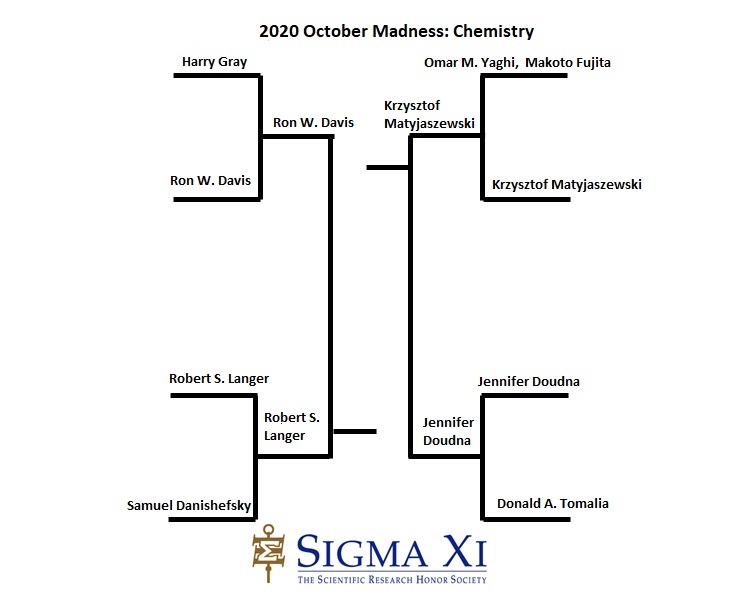
The Final 4 chemistry match-ups are
1.
Ron W. Davis, for advancing technology in genomics, gene editing, and cloning
vs.
Robert S. Langer, for his development of nanocarriers as a platform for cancer therapy, and other biotechnology using his background as a chemical engineer, inventor, and entrepreneur
2.
Krzysztof Matyjaszewski, for the discovery of Atom Transfer Radical Polymerization (ATRP)
vs.
Jennifer Doudna, for her co-discovery of CRISPR-Cas9 genetic engineering technology
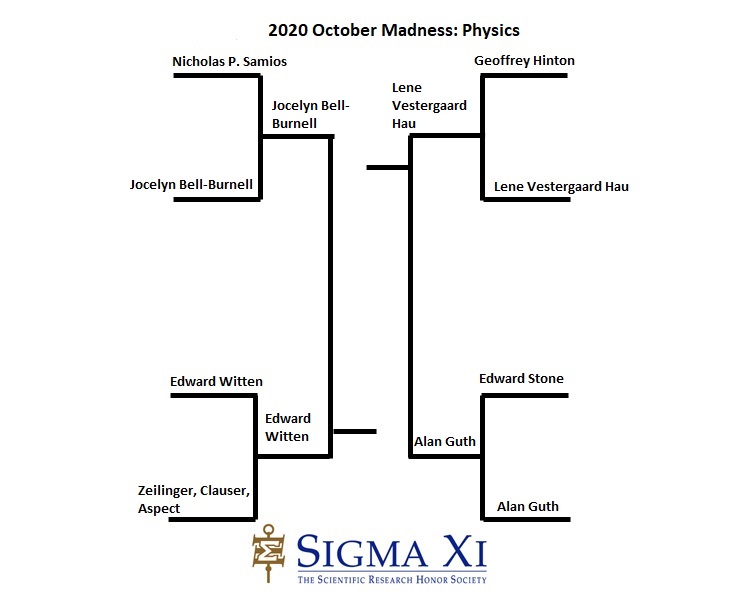
The Final 4 physics match-ups are:
1.
Jocelyn Bell-Burnell, for discovery of first radio pulsars
vs.
Edward Witten, for his work in string theory, quantum gravity, and supersymmetric quantum gravity
2.
Lene Vestergaard Hau, for her work on slowing down and stopping light
vs.
Alan Guth, for providing observational evidence corroborating the cosmic inflation hypothesis
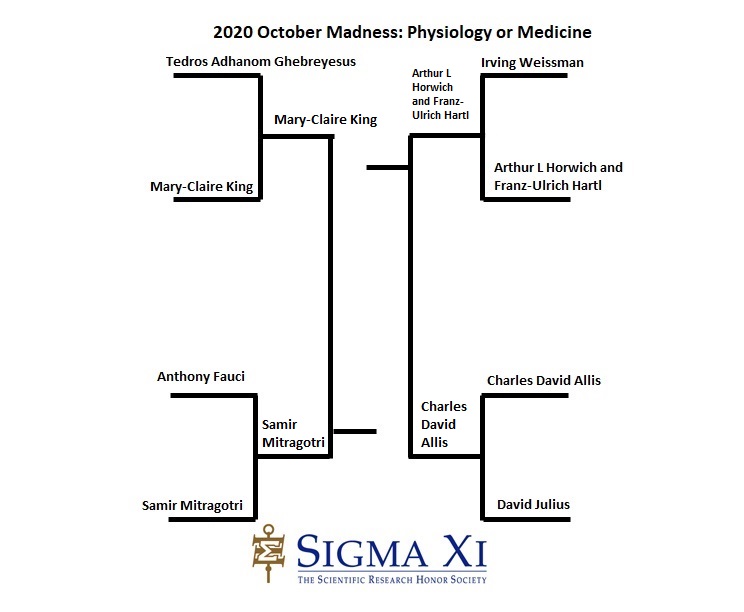
The Final 4 physiology or medicine match-ups are:
1.
Mary-Claire King, for the discovery of BRCA1 Linkage and confirmation of an inherited risk of cancer
vs.
Samir Mitragotri, for the discovery of red blood cell hitchhiking using nanoparticles for the intravenous cure of diseases
2.
Arthur L Horwich and Franz-Ulrich Hartl, for discovery molecular chaperon and quality control of protein folding in health and disease
vs.
Charles David Allis, for discovery of epigentics and histone modification
-
by
User Not Found
| Sep 14, 2020
Thanks to everyone who submitted nominations for the 2020 October Madness, Sigma Xi's Nobel Prize prediction contest!
Voting is open until September 17, 2020 at 11:59 p.m. Pacific Time for the Elite 8 round.
Make sure to vote to keep your favorites in the running!
Elite 8 Voting
Chemistry
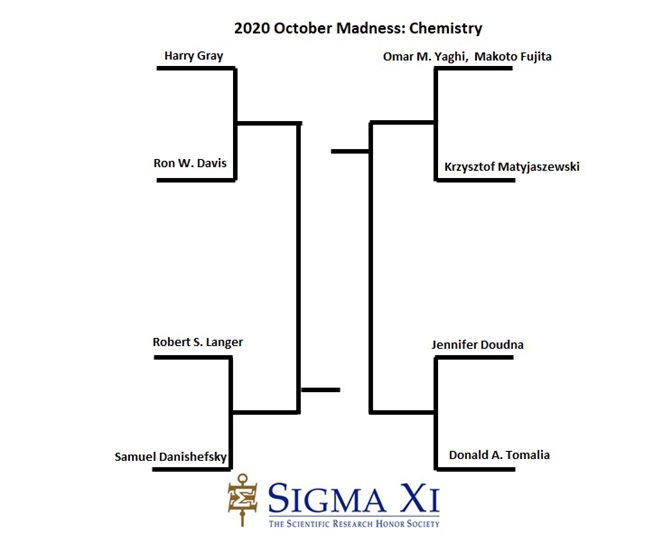
1.
Harry Gray, for his work in electron transfer research; tunneling, bioinorganic chemistry
vs.
Ron W. Davis, for advancing technology in genomics, gene editing, and cloning
2.
Robert S. Langer, for development of nanocarriers as a platform for cancer therapy, and other biotechnology using his background as a chemical engineer, inventor, and entrepreneur
vs.
Samuel Danishefsky, for his overall contribution to total synthesis; organic synthesis
3.
Omar M. Yaghi, Makoto Fujita, for the development of metal-organic frameworks/coordination polymers and reticular chemistry
vs.
Krzysztof Matyjaszewski, for the discovery of Atom Transfer Radical Polymerization (ATRP)
4.
Jennifer Doudna, for her co-discovery of CRISPR-Cas9 genetic engineering technology
vs.
Donald A. Tomalia, for the invention of the dendrimer family of polymers that have the capability of transporting pharmaceutical agents through cell walls for medicine
Physics
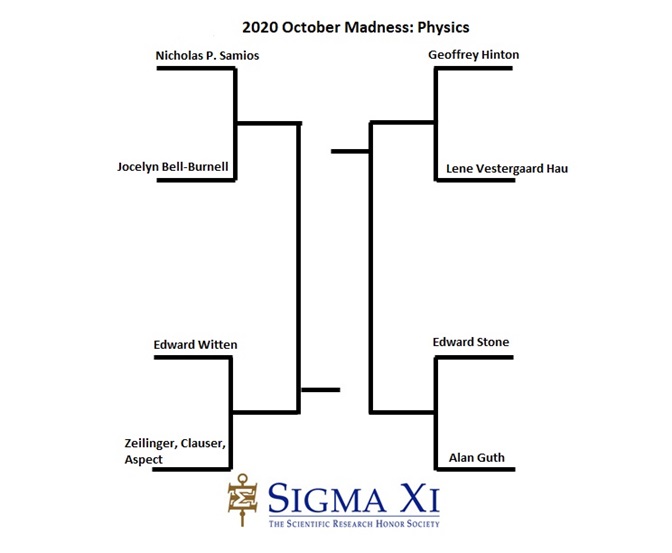
1.
Nicholas P. Samios, for the discovery of the Omega hyperon confirming the quark model
vs.
Jocelyn Bell-Burnell, for discovery of first radio pulsars
2.
Edward Witten, for his work in string theory, quantum gravity, supersymmetric quantum gravity
vs.
Anton Zeilinger, John Clauser, Alain Aspect, for taking data which was loop-hole free and demonstrated that hidden variables could not be an explanation for quantum entanglement.
3.
Geoffrey Hinton, for establishing the backpropagation algorithm to train multi-layer neural networks.
vs.
Lene Vestergaard Hau, for her work on slowing down and stopping light
4.
Edward Stone (and the Voyager team), for heading the Voyager I/II missions, which have explored all of the outer planets and are now cruising interstellar space (the first human-made objects to do so).
vs.
Alan Guth, for providing observational evidence corroborating the cosmic inflation hypothesis.
Physiology or Medicine
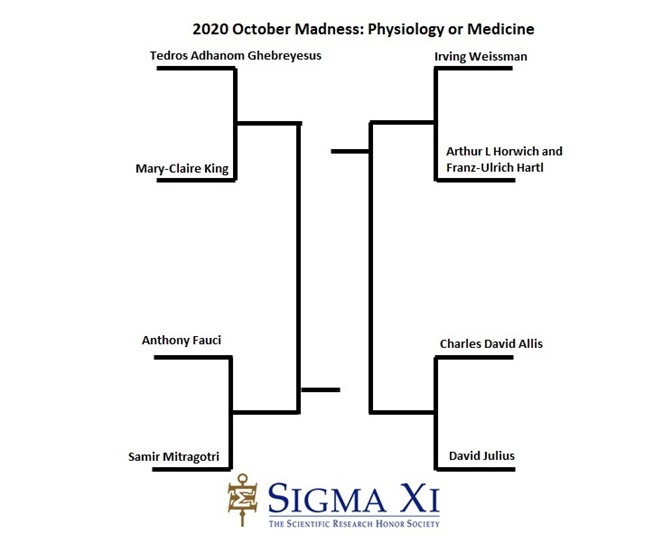
1.
Tedros Adhanom Ghebreyesus, for spearheading the response to the COVID-19 pandemic as the Director General of the WHO
vs.
Mary-Claire King, for the discovery of BRCA1 Linkage and confirmation of an inherited risk of cancer
2.
Anthony Fauci, for his work during the COVID 19 pandemic
vs.
Samir Mitragotri, for the discovery of red blood cell hitchhiking using nanoparticles for the intravenous cure of diseases
3.
Irving Weissman, for advances in immunology and stem cell biology
vs.
Arthur L Horwich and Franz-Ulrich Hartl, for discovery of the role of molecular chaperons in protein folding in health and disease
4.
Charles David Allis, for discovery of epigenetics and histone modification
vs.
David Julius, for the identification of the biophysical basis of nociception
-
by
User Not Found
| Sep 14, 2020
October Madness, Sigma Xi's Nobel Prize prediction contest is back for its sixth year!
How it Works
Sigma Xi collects nominations from the public and then runs voting to advance researchers on our sports-style brackets. We hope you join in the fun as we wait for the official Nobel Prize announcements in October. But we need your nominations to get the contest kicked off! This is another way we can promote researchers and their incredible achievements.
Tell us who you think will win a prize this year! We are calling for eight nominations each for the:
How to Nominate
Anyone can nominate and vote; Sigma Xi membership is not required to participate in October Madness. Send in your nominations by 11:59 p.m. PT on September 4 by using our nomination survey or email me at lholton@sigmaxi.org.
Please include:
-
Your nominee's name (you can submit as many nominations as you would like and you can submit a group of researchers who worked on a project together)
-
Which prize you think this person, or group, should win
-
The reason why you think the person, or group, should win (such as, "for the discovery of XYZ")
-
The institution of employment or affiliation for your nominee(s)
-
Your name and email address
How to Vote
We will announce the October Madness nominees on September 7 and open the brackets for voting on Keyed In. You can also follow along on Sigma Xi's social media accounts on Twitter, Facebook, and LinkedIn. Remember to use #OctoberMadness!
Prizes
All nominators will be submitted into a drawing to win a Sigma Xi blanket!
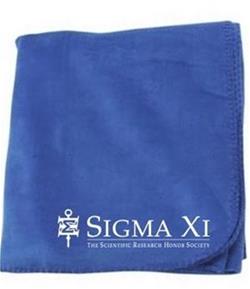
If you nominate someone who goes on to win a Nobel Prize, you will also be entered into a raffle. Raffle winners who are not Sigma Xi members, affiliates, or explorers will receive a free year in the Sigma Xi Affiliate Circle* (a $50 value), which includes a one-year subscription to American Scientist magazine. Members, affiliates, or explorers who win the raffle will have their dues paid by Sigma Xi for Fiscal Year 2021 (July 1, 2020–June 30, 2021). Those who already renewed will have their dues paid for Fiscal Year 2021. We will select one winner per prize category for a total of four winners.
Schedule
August 19–September 4: Send in your nominations
September 7: Nominees announced; Elite 8 voting begins and runs through September 17.
September 18: Elite 8 winners announced; Final 4 voting begins and runs through September 23.
September 24: Final 4 winners announced. Final voting begins and runs through September 29.
September 30: Final voting ends and prediction winners are announced.
October 5-12: Official Nobel Prize winners named.
October 13**: Winners announced from the raffle will win a year in the Sigma Xi Affiliate Circle or a free year of dues for members, affiliates, or explorers.
*Affiliate Circle status does not qualify one for full or associate membership in Sigma Xi's nomination-based honor society.
**If Sigma Xi receives less (or more) than 8 nominations per prize, then its staff will select the nominees who are put on the bracket. But we prefer to use your nominations! Please nominate anyone you feel is worthy of the prize. Potential candidates might be found here, here, here, or here. October Madness is not affiliated with the Nobel Prize.
Example of 2019's Finals Bracket for Chemistry

See other 2019 brackets.
Sigma Xi looks forward to receiving your nominations!
-
by
Jamie Vernon
| Aug 24, 2020
 A woman works in a research lab. (Photo from Canva)
A woman works in a research lab. (Photo from Canva)
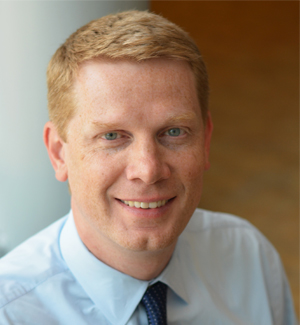 It has been 217 days since the first case of COVID-19 was detected in the United States and 166 days since the World Health Organization (WHO) characterized the disease as a global pandemic. During this brief period, the virus has had a dramatic impact on our day-to-day lives, causing 809,000 deaths globally—177,000 deaths in the United States—requiring the shutdown of businesses and schools, and resulting in 28 million unemployed Americans.
It has been 217 days since the first case of COVID-19 was detected in the United States and 166 days since the World Health Organization (WHO) characterized the disease as a global pandemic. During this brief period, the virus has had a dramatic impact on our day-to-day lives, causing 809,000 deaths globally—177,000 deaths in the United States—requiring the shutdown of businesses and schools, and resulting in 28 million unemployed Americans.
The pain and distress caused by this disease has been exacerbated in the United States by the nation’s disappointing public health response. While many of the most affected countries have been able to bring down their cases and begin to return to normal business, the United States has experienced a prolonged period of high infection rates. The reality of the situation is that we are not yet able to restore normalcy.
For the research enterprise, the effects have been widespread. Scientists from all sectors have curtailed their research programs. Many academic scientists have closed their laboratories or reduced their work hours and student researchers have put projects on hold. A recent survey tracking the effects of the pandemic on scientists’ workload published in Nature Human Behaviour (NHM), and covered by Science, shows that just one month after the WHO declared COVID-19 a pandemic, scientists overall had reduced their research hours by 16 percent. Travel for research conferences and data collection has been cancelled and funding cycles for research grants have been disrupted. It will likely take years to determine the overall effects that COVID-19 has had on scientific progress and the research community.
While efforts are underway to return to normal by reopening businesses, colleges, and universities, cluster outbreaks have set back plans to fully restore research activities. Furthermore, the failure to contain the spread of the virus has extended school closures into the fall, resulting in disproportionately negative impacts on scientists who have young children who may be attending online classes from home or whose families may not have the option or feel comfortable using daycare facilities. According to the NHM paper, scientists with children ranging from newborns to 11-year-olds reported a reduction in work hours ranging from 32 percent to 38 percent, depending on the age of their children.
“All else being equal, female scientists reported a 5 percent larger decline in research time,” the authors wrote. “But the most important variable of all appears to be having a young dependent: scientists with at least one child five years old or younger experienced a 17 percent larger decline in research time, all else being equal. Having multiple dependents is associated with a further 3 percent reduction in time spent on research.”
To ascertain the impact of the pandemic on women scientists, consider a study that compared the gender distribution of authors on medical research papers related to the pandemic with papers published in the same journals in 2019. The results, which were published in eLife, estimated that papers with a woman first author in 2020 was 19 percent less than it was in 2019. This result appears to be linked to the role women play in the home. Scientific American reported on an Understanding America Survey of 5,900 adults, that showed 33 percent of employed mothers responded that they have been primarily responsible for providing childcare during COVID-19 school closures, compared with only 7 percent of employed fathers.
These disruptions come at a time when major efforts are underway to recruit and retain women and underrepresented minorities in STEM fields. Evidence supports that a diverse workforce is both a social justice accomplishment and an overall benefit to innovation. Given the disproportionate effects of COVID-19 on women in the research workforce, the scientific community has a responsibility to consider what systemic changes will be necessary to ensure that the pandemic does not reverse promising trends related to women’s advancement in STEM fields. Without deliberate actions to counter these disruptions, we run the risk of reintroducing biases that have excluded women and other minorities from the STEM fields throughout history.
Federal agencies, universities, industry, and government laboratories may need to undertake internal reviews of their policies and processes to reconfigure professional performance evaluations, tenure considerations, promotions, and grant awards under the current circumstances. Sigma Xi is prepared to engage at any level to help address these issues or to broker discussions on these topics.
What is your institution doing to help researchers, employers, and administrators deal with these new challenges? Please let us know in the comments below if there are successful steps being taken by your institution so that we may share them with others who are exploring solutions to these challenges.
Related Reading
Coronavirus Lockdown Lessons from Single-Parent Scientists
Source: Nature
Pandemic Hits Scientist Parents Hard
Source: Science
Scientist Mothers Face Extra Challenges in the Face of COVID-19
Source: Scientific American
Impact of COVID-19 on Academic Mothers
Source: Science
Six Ways to Juggle Science and Childcare from Home
Source: Nature
Jamie Vernon is the executive director and CEO at Sigma Xi, The Scientific Research Honor Society, and publisher of American Scientist.
-
by
User Not Found
| Aug 20, 2020
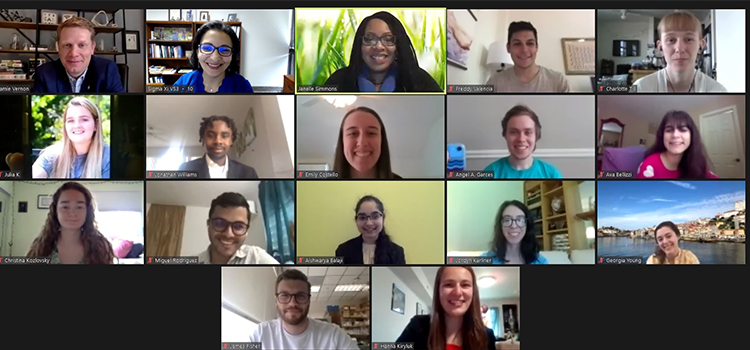
Top student presenters in the Sigma Xi Virtual Student Scholars Symposium (VS3) were announced in May.
Students who participated in the Society’s Virtual Student Scholars Symposium (VS3) in May, and Sigma Xi members who judged, are sharing their advice for students giving virtual research presentations. The next virtual student presentation opportunity will be the Society’s Annual Meeting and Student Research Conference, November 5–8, 2020. Students may follow instructions at www.sigmaxi.org/src to submit abstracts for virtual poster presentations through October 1.
Make Your Key Points Clear and Succinct
When the student finishes talking, the judge should know 1) what they did, 2) why they did it, 3) how they did it, 4) what their results were, and 5) why the results are important.
— Stephanie Tristram-Nagle, Judge, Pittsburgh, Pennsylvania
The following qualities in decreasing order would make a strong virtual poster or oral presentation; a) most important of all is being humble; b) stressing on the right technical words and being clear on what you speak (without rushing); c) having an open mind about the audience; having a few simplified general audience sentences at the beginning & in conclusion; d) slides with less words and more pictures (pictures should speak about your research).
— Sankar Narayanasamy, Judge, Berkeley, California
If I think of a presentation as a big scary separate thing, then I’ll freeze up, forget what to talk about, and get nervous. But if I remember that all I need to do is tell people about my research, then I gain confidence. I never memorize what I’m going to say, because then I would get stressed if I forgot something. Instead, I memorize the basic points I’m going to cover, and then I explain them in my own words.
— Kaija Gahm, Student, Newton, Massachusetts
Clearly define the problem you are solving, describe the state-of-the-art methods for solving the problem before your work or state that none existed if that is the case, and then present your solution by first giving a high-level view and then going into details.
— Miroslav Velev, Judge, Chicago, Illinois
Have a) confidence and knowledge of the material being presented, b) highlight salient features, this is even more crucial where there is a time limit, and c) if possible, having a graphical abstract can be helpful.
— B. Lungsi Sharma, Judge, Gif-sur-Yvette, France
It is possible that audio will not work well. Make sure that key points are written on slides.
— Brooke E. Crowley, Judge, Cincinnati, Ohio
In reviewing posters, I frequently ask students about their sample size, methods used, statistics used in results presented, and a summary of the relevance of their work to science and society. There is also less time to discuss your research with viewers as you would have in person. Therefore, it is important to craft your take-home message with a succinct summary of your project and findings.
— Christopher Badurek, Judge, Rochester, New York
Have Great Visuals, Less Text
The presentation needs to draw the attention of the attendees, with a short, clear message on the main points of your research . . . Please, avoid using much text in the presentation.
— Guadalupe Virginia Nevárez-Moorillon, Judge, Chihuahua, Mexico
You definitely want to discuss the significance of your research and where it fits in the bigger picture. Try to answer the question, “Why should I care?” . . . People can’t step closer to read your poster the way they can in person, so using big font sizes makes it a lot easier for evaluators. This means you may have to cut down on words or pick and choose certain illustrations or graphs to include.
— Hanna Kiryluk, Student, Virginia Beach, Virginia
The presenter needs to keep in mind that the audience could be viewing their presentation/poster over devices having small screens (e.g. phone) or large screens (e.g. large monitors). The figures and text being presented should be legible on all devices. Many a times, presenters make slides for a traditional poster. It is almost impossible to see the axis and values in the graphs and much of the text ... I have found the key to a good virtual presentation is less slides and good speech ... Use your cursor to guide the viewers what your script is referring to.
— Vishal Shah, Judge, West Chester, Pennsylvania
The strong virtual poster presenters had relatively simple and well-structured layouts/designs. This meant that the most important concepts of those posters were emphasized with clear (and large) graphics and text, with few side panels to distract from the main features.
— Rashika Karunasinghe, Judge, Auckland, New Zealand
Most students need to have fewer words and make all the fonts larger. The goal is to allow your audience to read the poster easily from their computer screen. Many students try to write about all aspects and every detail of their research on a single poster—usually all that detail is too much information for a poster. Students need to identify and focus on a few key themes/issues in their introduction, the critical methods (not all the methods), the major findings in the result section (not all the results), and the 2-3 take-home points/conclusions in the discussion section ... Try to point out, while speaking, where on the poster the audience can see the specific result you are stating. For example you might say, "As seen here in Figure 2, the treatment with chemical X, indicated by the red line, produced a faster response through time than the control, indicated by the green line."
— Jessica E. Rettig, Judge, Granville, Ohio
Practice and Use the Technology
Zoom into different parts of the poster to make it easier to see pictures and graphs and mark key text in bold to highlight it better and focus your audience's attention on the important parts.
— Vivian Ciaramitaro, Judge, Boston, Massachusetts
In virtual presentations, you may want to consider being familiar with the technology. It says a lot about how prepared one is to not only tackle the content of the presentation but everything else that’s involved in it. Sometimes what stays in the listener’s mind after a presentation is how not prepared the presenter is in dealing with the technology for the presentation. Showing that you are familiar with the virtual platform says a lot about you as a presenter. Which means practicing with it a few (or a hundred) times pays off in the end.
— Patrisha Bugayong, Judge, Atchison, Kansas
When it comes to oral presentations, I believe that practice is a key determinant of success.
— Ava Bellizzi, Student, San Diego, California
Several digital tools like PowerPoint and Zoom allow you to record your presentation. You can record and play back your practice presentation to experience it for yourself from the audience’s perspective . . . Make sure that you are well lit, the camera is in a good position, and there is no background noise. Also check that your background appears professional: A blank wall, simple painting or bookshelf, or Zoom background image from your school can be good choices that won’t distract the audience.
— Jennifer Patterson, Judge, Leuven, Belgium
The location of where you are sitting or standing while presenting should also be noted because the backgrounds can be distracting for those watching the presentation.
— Christina Kozlovsky. Student, Sunnyvale, California
Avoid placing important information at the bottom of the slides, because when sharing the screen, toolbars may appear and cover that portion. Use animated arrows to point out the information to be emphasized because sometimes the cursor can’t be seen when sharing the screen.
— Miguel G. Rodriguez Reyes, Student, Guayama, Puerto Rico
I would recommend practicing your presentation beforehand using the appropriate virtual platform with a friend or family member, so that you know how your audience will view your presentation and any adjustments that you might have to make.
— Ángel Garcés, Student, Houston, Texas
Students should make sure that the presentation environment is quiet enough to deliver a talk with minimal interruptions. Beside this, check your audio settings beforehand and use a compatible microphone and audio accessories (headphones). Position the camera at eye level. It is essential to dress for success because it does help the presenter to feel prepared by wearing a complete outfit (preferably business casuals). During the presentation, when you look into the camera, imagine a person who seems to be the ideal person as an audience. It will help you to deliver your presentation confidently.
— Gaurab Dutta, Judge, Rockville, Maryland
During virtual presentations, presenters receive less feedback from the audience, and audiences can be distracted more easily. To overcome the challenges, presenters can a) use a mouse pointer or stylus to guide the audience, b) tell an interesting story to improve engagement, c) limit the number of messages to be delivered, and d) speak clearly and concisely.
— Yuebing Zheng, Judge, Austin, Texas
In normal poster session, [the] audience's attention is naturally focusing on the presenter, but this is not the case in virtual poster session. I would suggest the students try to make more interactive expressions and adding small talk to draw their attention.
— Xiabing Lou, Judge, Bellevue, Washington
Use videos, visuals, animations to share the key points. Use the technology in addition to just talking in a monologue.
— Samir Iqbal, Judge, Arlington, Texas
Know how to distribute the time for each part and make sure to present the entire poster within the allotted time.
— Shuo Zhang, Judge, Houston, Texas
For oral presentations, use simple animations to make your content appear as you discuss it, so your audience isn’t overwhelmed by a ton of information on a slide at once.
— Jordyn Karliner, Student, Penn Valley, Pennsylvania
When presenting a section of their poster, students should enlarge that section on their computer screen so it is easier to view for the audience.
— Emily Costello, Student, Haddonfield, New Jersey
Encourage the Audience to Get in Touch
A presenter in a virtual presentation might consider how to be contacted by members of the audience for questions or contributions. In a virtual presentation, there is often no time for this, and engagement afterwards is typically impossible unless the virtual presenter creates an explicit opportunity.
— Rocco Detomo, Jr., Judge, Indian Harbour Beach, Florida
Be sure to list all contact information for authors and presenters!
— Marijo Kent-First, Judge, Tallahassee, Florida
Put your name, (and e-mail) on each slide somewhere as you have no way of knowing when audience members will join the session, and they may miss your introduction. This way they can still work out who you are and can contact you if they have questions, (or in my case, I was contacted about additional related research projects that one audience member wanted to share with me). You never know who is listening . . . Make sure you stick around! There is nothing worse than an audience member asking a question of a presenter only to find that presenter has gone, or simply left the session.
— Charlotte Till, Student, Tempe, Arizona (Fulbright Scholar originally from New Zealand)
What advice or questions do you have about virtual research presentations? Please share in the comments below.
Heather Thorstensen is the manager of communications at Sigma Xi, The Scientific Research Honor Society.
-
by
User Not Found
| Aug 14, 2020

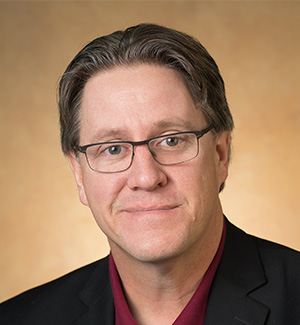
What does creating, performing, and listening to music do to your brain?
Larry S. Sherman, a professor of neuroscience at Oregon Health and Science University and the Oregon National Primate Research Center, will be a keynote speaker at the virtual Sigma Xi Annual Meeting and Student Research Conference this November. He will share what neuroscience tell us about how music changes the brain.
Heather Thorstensen: Why did you start researching what music does to the brain?
Larry S. Sherman: I have played piano for most of my life but also have had a life-long interest in neuroscience, dating back to ninth grade when I had the opportunity to work after school in a neuroscience lab at the University of California, San Diego. Several years ago I was playing piano at a social function for my division, and was asked if I would be interested in giving a talk and maybe playing a little music for a public group that was interested in neuroscience. I spent a few months reading everything I could get my hands on, and decided to incorporate music, stories, and some humor into the talk. I thought that would be the only time I would give this presentation, but was immediately asked to give it again to several local groups. I have now presented this talk hundreds of times, adding new data as it becomes available, in five different countries.
HT: What are some of topics that people can expect to hear from you during this talk?
LS: I'll discuss ideas about the origins of music, data suggesting that we have music-specific areas in our brains, how the brain processes music when we listen to it, how the brain composes and improvises, and what happens in the brain when we practice instrumental music. I will focus on how some of the changes that come with music are important for brain development and how they have the potential to overcome or limit some of the effects seen in neurodegenerative diseases.
HT: Your talk will involve live music. Why are you incorporating it as part of your talk?
LS: Having music in a talk is fun! But I also use it to illustrate a number of points about how music can influence brain function.
Pictured above: Larry S. Sherman
Learn more about Sherman's talk and the virtual Annual Meeting and Student Research Conference.
Heather Thorstensen is the manager of communications at Sigma Xi, The Scientific Research Honor Society.
-
by
User Not Found
| Aug 04, 2020

A new and free book, What Is a Virus?, tackles virus sizes, varieties, and more. (Copyright 2020 Hannah Margolis)
Sigma Xi member Hannah Margolis wrote a book, What Is a Virus?, to help children and parents learn the basics of viruses as we all face SARS-CoV-2, the virus that causes COVID-19. The book is available for free online and was illustrated by her friend and fellow recent Darmouth College graduate Emily Morin. Margolis studied biochemistry and global health at Dartmouth and currently works at the National Institutes of Health. She shared with Sigma Xi her hopes for the book, and its reception so far.
Heather Thorstensen: Why did you start working on the book?
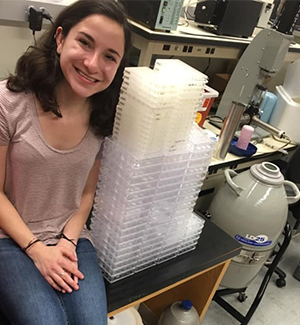
Hannah Margolis: With the shutdown of schools I became incredibly frustrated that all over the country, younger students were suddenly having to study at home and didn't completely understand why. I also know that many parents probably haven't learned about viruses since high school biology so it might be difficult for them to answer questions properly that their kids might be having about what is going on and how to stay safe. This was coupled with the fact that all of the sudden there was a huge public interest in viruses and also a lot of misunderstandings and confusion: people didn't understand how this virus could be different than those causing the flu or cold in terms of infectivity, symptoms, incubation period before you know you're sick, etc.
I personally think that a lot of science and academia has failed the public in making science accessible and it really bugs me. Now all of the sudden there were people actually coming to scientists or the scientific community asking to be informed and I think we really need to take advantage of that.
As a side note that might illustrate what I'm getting at better if this doesn't make sense, Carl Sagan is one of my absolute scientific heroes and writers. In one of his books he tells this short anecdote of a cab driver who realized he was Carl Sagan and asked if he could ask some science questions. Of course Sagan was thrilled, but the cab driver proceeded to ask about healing crystals, alien life, Atlantis, etc. Sagan noted that the guy was really informed and really curious—he was wide-read about these fake phenomena. But he notes how the scientific community and school systems had failed him—he didn't know how to sort out the truth from fiction. In Sagan's words "this man wanted to learn about science, but all of the science had been filtered out before it reached him." This was one of those opportunities to get the science through in its more pure and simple form because people were suddenly open and receptive to hearing it.
My other goal in writing the book was to make it completely honest. I didn't want to anthropomorphize viruses or use too many analogies. I wanted to explain in very simple terms the basics of what viruses are in scientific terms to remove the mystery around them (they aren't alive, they aren't trying to make you sick, becoming sick is a side effect of viral replication, etc). No one should be made to feel stupid if they have basic questions about viruses, how they make us sick, or how to stay safe. It's so easy nowadays to become misinformed or pick up only part of the true information. So I wanted to explain everything from the ground up, but also include side bars with more advanced and related information for people who were interested in going a bit beyond the basics, hearing about the quirks of other scientists, learning how we know what we know, etc.
HT: Have you had any feedback so far that made you think the book is helping people?
HM: Yes, some! I’ve mostly had success spreading the book through Dartmouth platforms and in my hometown in northeastern Nevada. The first positive feedback I got was from a Dartmouth alum who read the book to her four-year-old daughter. Apparently her daughter really enjoyed it and the mom said she learned some things, too. That was my biggest hope for the book—that it can be informative and interesting for everyone, regardless of age or background. I know that in writing many of the sidebars, I learned new things, too.
HT: Who do you see as the target audience for the book? What age group is most appropriate?
HM: I wrote the book specifically for kids and their parents, but I don’t think it has an overly narrow audience-range. I’ve had parents with four-year-olds though third or fourth graders indicate their kids enjoyed it. The purpose of including the sidebars especially was for there to be something for older kids or parents, too.
HT: What does your job entail now at the National Institutes of Health?
HM: I work as a postbac researcher in the Mizuno Lab. The lab studies the protein machinery that allows cells to adhere to surfaces, which is involved in things like wound healing, forming tissues, cell migration (for instance, immune cell movement), and cancer metastasis. We specifically use cryo-electron microscopy to see what these proteins look like on the molecular level and this technique is also used for discovering the structure of many viruses like SARS-CoV-2. Proteins are smaller than a wavelength of light, so we have to use techniques with x-rays or electrons to see them. It makes it more challenging, but also more rewarding to finally see what they look like and how they work to allow us to live and function.
Pictured above: Hannah Margolis
Heather Thorstensen is the manager of communications at Sigma Xi, The Scientific Research Honor Society.
-
by
Jamie Vernon
| Jul 21, 2020
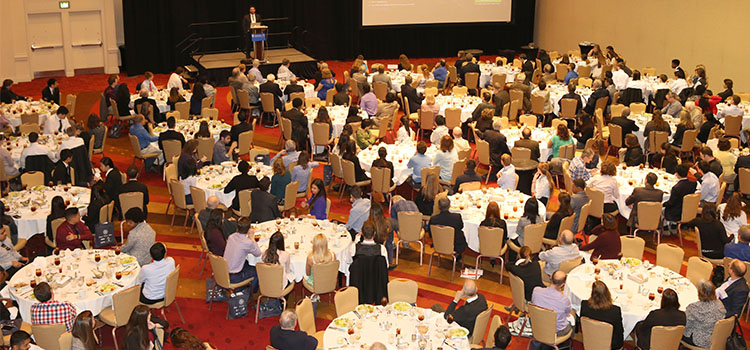
Researchers, students, teachers, and the public come together at a Sigma Xi Annual Meeting and Student Research Conference.

Students who have visas to study at higher education institutions in the United States should not face deportation if their schools choose online-only classes this fall. Public health guidance should be rooted in scientific evidence, especially during the coronavirus pandemic. Scientists and artists can help the public learn about COVID-19. And, the social media giant Facebook should do more to stop the dissemination of racial discrimination and disinformation.
Sigma Xi, The Scientific Research Honor Society made announcements, statements, and joined in court actions this month to address these issues on behalf of its members and the scientific community.
Speaking Up for International Students, Colleges, and Universities
What Happened?
On July 13, Sigma Xi and others filed an amicus brief in support of a lawsuit against the U.S. Department of Homeland Security, its Immigration and Customs Enforcement agency, and their leadership. The lawsuit challenged the advancement of a policy to revoke visas from international students who are attending higher education institutions within the United States where courses will be offered exclusively online this fall. The policy has been rescinded.
Why Did Sigma Xi Sign the Amicus Brief?
The brief demonstrates Sigma Xi’s support for its international members and students from all nations who are pursuing careers in science, technology, engineering, and math at U.S. higher education institutions. It also supports Sigma Xi’s mission to enhance the health of the research enterprise and our priority to advance STEM education, as described in the 2020–2025 Strategic Plan.
Read the full statement
Helping the Public Understand COVID-19
What Happened?
Sigma Xi joined forces with Science Talk to host a competition, #SciCommMake: COVID-19 Communications Collaboration, to award funding for projects presented by 10 teams of scientists, artists, and science communicators that will improve the public’s understanding of COVID-19.
Why Did Sigma Xi Fund the Teams?
Sigma Xi is focused on exploring the benefits of interdisciplinary collaborations, particularly those between science and art, as we approach the Annual Meeting and Student Research Conference, where the theme will be Hacking the Brain: The Intersection of Art and Neuroscience. The Society also believes this effort will reach audiences in need of information to make decisions about COVID-19.
See the announcement
Supporting Evidence-Based Public Health Guidance
What Happened?
On July 15, Sigma Xi joined other organizations in signing a letter to United States Vice President Mike Pence that voiced support for "leading with science and with the best data available" during the coronavirus pandemic. It names Dr. Anthony Fauci, director of the National Institute of Allergy and Infectious Diseases, as one expert leading with science.
Why Did Sigma Xi Sign the Letter?
Part of Sigma Xi’s mission is to promote the public’s understanding of science. We also have a responsibility to advocate for evidence-based government policies, as stated in the 2020–2025 Strategic Plan.
Read the letter in full, with signees as of July 15.
Restricting Facebook Advertising
What Happened?
Sigma Xi announced on July 21 that it stopped spending money for advertisements on Facebook. Sigma Xi’s restriction is parallel to a larger Facebook ad boycott campaign, called Stop Hate for Profit which is led by multiple groups including the National Association for the Advancement of Colored People.
Why Is Sigma Xi Restricting Facebook Ads?
The Society is urging the social media platform to demonstrate a commitment to ending its dissemination of violent rhetoric, racial discrimination, and disinformation. Sigma Xi calls for the social media giant to articulate a clear strategy for quelling the spread of misinformation and restricting the use of the platform for inciting violence and promoting discrimination before it will resume its advertising efforts. Sigma Xi has pledged to elevate the conversation about racism and discrimination within the research community, and that includes advocating for equity and inclusivity in all segments of society. Facebook has also been linked to disinformation in the U.S. elections and researchers have spoken out about how private groups on the platform have promoted harmful conspiracy theories.
Read the announcement.
Jamie Vernon is the executive director and CEO at Sigma Xi, The Scientific Research Honor Society, and publisher of American Scientist.
-
by
User Not Found
| Jun 11, 2020
After publishing a statement on racial and social justice on June 5, Sigma Xi encouraged its members and affiliates to support the Strike for Black Lives and #ShutDownAcademia, #ShutDownSTEM initiatives, which called for researchers to pause their usual daily work on June 10 and devote time to learning about systemic racism and ways to address inequalities.
Below is a sample of how the Sigma Xi community participated.
Sandra Kizior, Illinois*
I am (12 years) retired and no longer associated with a research group. I am engaging dear friends who are part of the Black community. And, because I am a religious person as well, I am praying for justice and peace.
Their plight has gone on too long. We need a major change of attitude all across our society. Communities need to engage more often to really know that we are more alike than we think. Its our world, and up to all of us to make it a better one. As many have said, we need to replace racial hatred with love.
Jonathan Krall, Virginia*
I'm glad the scientists are finally waking up. We also need to strike over climate. That climate scientists talk doom while looking and acting comfortable and secure undercuts their message.
Mary C. Hill, Kansas*
I watched "Uncomfortable Conversations with a Black Man" with Emmanuel Acho. I have read books, but actually being with people brings it to a new level.
Paula Figueiredo, North Carolina
I participated in a group discussion about racial and social justice. I learned that there is a lot of awareness that people need to do, not to engage in racism (that sometimes can even be subconscious).
Anonymous*
I learned that Black students, more than LatinX students, leave STEM at rates not explained by poverty and educational background.
*=Sigma Xi member or affiliate
To get involved in Sigma Xi's work to cultivate a diverse and inclusive research community, email executiveoffice@sigmaxi.org.
-
by
Geraldine Richmond
| May 26, 2020
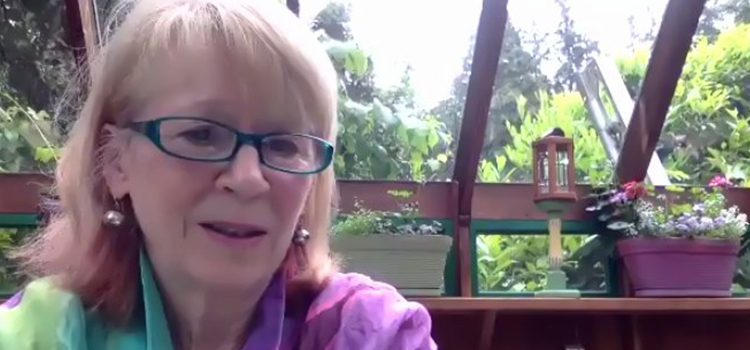
National Medal of Science Recipient and Sigma Xi President Geraldine Richmond shares five things she has learned about life and having a research career.
Richmond, the Presidential Chair in Science and a professor of chemistry at the University of Oregon, gave the following remarks on May 14, 2020, to students as part of her keynote address during the Sigma Xi Virtual Student Scholars Symposium.
As I look back on my career journey, I take great pride in our research accomplishments, but I realize that I have found my deepest fulfillment in the human interactions.
My life is rich beyond measure from the mentors who have shared their gifts with me, the colleagues who have expanded my capacities, and the students and postdocs who have taught me even as I’ve worked to guide them. In my younger years I had a very monolithic view of scientists, always serious, a bit too preoccupied with their laboratories and nearly noncommunicative with the general public. How wrong I was.
Expect the unexpected, even in scientists.
I am constantly inspired by the spirit of the students and researchers that I have met through Sigma Xi who prove time and again the power of creativity. It’s easy for us to get lost in the complexities of our work, but it’s important to remember that we can’t succeed without one another. Our human connections are crucial to making great science.
With those thoughts in mind, I leave you with a few bits of advice as you go forward in your career.
1. Take ownership of your career
What comes next is what you make of it. I challenge you to define it for yourself. To think deeply about what you value, cherish, and respect and use that to build your career and life path.
Today there are so many different paths for satisfying careers in science and engineering. Beyond the academic, government laboratory, and industry routes there are amazing opportunities in science policy and diplomacy, humanitarian efforts, law, entrepreneurship, science communication, journalism, the foreign service, and national defense. In fact, so many that I now view the academic road that I have followed as being the alternative career path.
Tragic is the person who awakens to realize that they have spent their life trying to satisfy the expectations of others, rather than following their own dreams. Living some else’s life. There is no do-over. No roundabouts to allow you to try again.
2. Be willing to take risks
Now as a mother myself, I don’t mean jumping on a Harley and racing 120 mph down the freeway.
I do however mean doing things in your career that take you out of your comfort zone, that challenge your personal paradigms, that have unpredictable outcomes.
This is not the territory for perfectionists nor is it for the person that always stays in their lane. You enter the venture with the recognition that although it may have a low probability of success, the achievement could be of high impact.
Successful ventures that take you out of your lane are an incredible way to build confidence.
3. And on that topic of confidence,
When making an important decision in your life, whether you come to a fork in the road or the option of making a significant detour, never make that decision when you are tired, angry, or over-worked.
Your brain needs to be fully functioning to make such decisions and exhaustion and anger diminishes your ability to think clearly and with full brain capacity.
And most important: never make an important life decision when your self- esteem is at a low point. Make it when you are at the top of your game. Make decisions based on your strengths and not when you brain is playing a silly game of obsessing over your weaknesses that may even be irrelevant.
4. Embrace diversity in your life and in your work.
Research shows that teams of social and intellectual diversity are more creative and effective in problem solving. Although working with someone that is different than yourself, for example, by sex, gender identity, ethnicity, politics, race or color may be a little uncomfortable at first, it is actually that discomfort that is proven to lead to more creative thinking and innovative solutions.
5. And finally, recognize that no one in this world makes it alone.
You are here today because of so many people that have helped you along the way—from the teacher that inspired you in the early years, to the friends who never gave up on you— even when you embarrassed them beyond belief, to the neighbor that always had a smile and hello. And of course your family.
The act of giving is known to stimulate the reward center in the brain—releasing endorphins and creating what is known as the “helper’s high.” And like other highs, this one is addictive.
Thank them, tell them how much you appreciate them. It’s good for them and equally good for you.
With that, I thank you all for letting me be part of this special day with you.
Congratulations on your research successes, And be sure to expect the unexpected. That’s what can make science so interesting and fun.
-
by
User Not Found
| May 21, 2020
Rachael Cusick, an associate producer at Radiolab, spent a year searching for genius. The result is RadioLab Presents: G, a documentary series on the concept of intelligence.
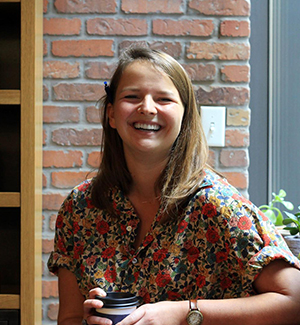
Heather Thorstensen: What was your favorite part about working on RadioLab Presents: G?
Rachael Cusick: There were so many things I loved about working on G – going to the New York Public Library to see original IQ tests, looking for stories that were distinct yet spoke to each other, seeing the beautiful illustrations our talented illustrator created for each episode. But if I had to pick just one, I’d say my favorite part of working on this series for Radiolab was the ability to spend an entire year doing a deep dive on a single topic I knew very little about. As a radio producer, it’s a gift to be able to immerse yourself in a single topic like that. And to be able to do it with the world’s best team captain and radio wiz, Pat Walters? Even better!
HT: What have been the major takeaways for listeners?
RC: The biggest insight I walked away from G with, and something I believe really stuck with our listeners as well, is just how embedded the idea of "intelligence" is in our world. When Pat and I started this series, I really believed the old-school notion of what it means to be "intelligent" was fading into the background. But it wasn’t! The more we worked on the series, the more I saw it in my daily life. Loved ones, coworkers, and television shows—both old and new—lobbed the word “genius” around like a ping pong ball. I attended lectures and parties where “intelligent” was an attribute to be used in introducing someone right after her name and profession. Schools still rely on it as a goal post and a way of monitoring students. And many of us strive, either boldly or quietly, to constantly achieve it for ourselves.
“Intelligence” is steeped in so many parts of our lives. Yet none of us could agree what it meant. The more we began to pick it apart, the squishier it felt to us. And I think that was a major takeaway for our listeners as well.
HT: What types of art and science collaborations did you explore for the series?
RC: The idea of intelligence, understandably so, does not immediately make neon-colored, wacky light bulbs go off in the creative corners of my brain. It sounds stiff and rigid and intimidating. And it is those things. But it’s also complex and powerful and visceral. Our team wanted to find the shared space between those words. And art is a great way to do that. We began episodes with Einstein and ended them with discussions of science fiction. We used original music and actors to make stuffy old IQ tests come alive so it felt like listeners were experiencing the test themselves. We worked with a great illustrator, Deborah Lee, who synthesized the complexities of each episode into artwork that welcomed listeners into each episode. We hosted a live show with science writers and comedians to stare at intelligence from different perspectives. And because of all these art and science collaborations, we were able to explore a deeply scientific idea in vivid, emotionally resonant, and artistic ways.
Hear more about Radiolab Presents: G from Cusick during her keynote address at the virtual Sigma Xi Annual Meeting and Student Research Conference, this November. The meeting will explore interdisciplinary research collaborations, particularly those between art and science.
Heather Thorstensen is the manager of communications at Sigma Xi, The Scientific Research Honor Society.
Updated 6/23/20
-
by
Jamie Vernon
| Apr 21, 2020
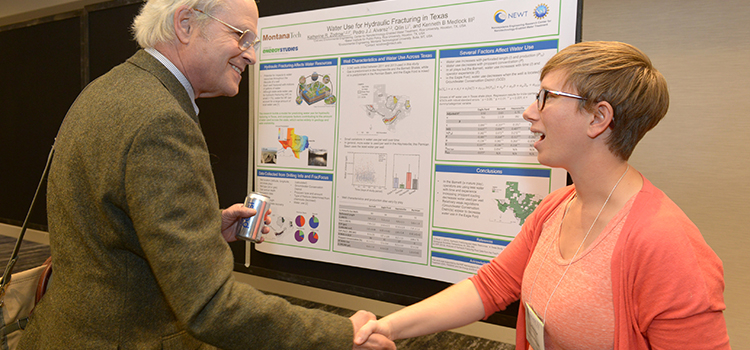
Scientists and engineers from different disciplines come together at the Sigma Xi Annual Meeting. This year, integrating arts into research will be a focus.
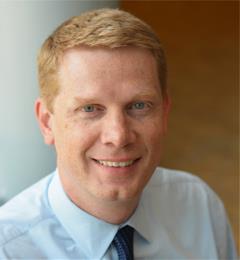
“We are in this together,” people say about our collective distancing efforts to stop the spread of the new coronavirus. The emphasis is on our togetherness because, as social human beings, that is what many are missing the most. The separation from our usual routines and support systems creates new challenges for teamwork and creative thinking.
Just as the current physical distancing disrupts our natural state of socialized work, higher education has been experiencing a longer period of distancing of its own, one of discipline distancing. The arts, humanities, science, mathematics, and engineering studies have become more specialized and disconnected. A report from the United States’ National Academies of Sciences, Engineering, and Medicine examines evidence that integrating arts and humanities with science, technology, engineering, math, and medicine (STEMM) lead to improved educational and career outcomes.
Spoiler alert: The report’s authors found that “certain approaches to the integration of the arts and humanities with STEMM are associated with positive learning outcomes, including, but not limited to, written and oral communication skills, teamwork skills, ethical decision making, critical thinking and deeper learning, content mastery, general engagement and enjoyment of learning, empathy, resilience, the ability to apply knowledge in real-world settings, and indicators of improved science literacy.”
All are solid skills for the researchers of today and tomorrow.
As we have each become more specialized, have we moved away from teaching and working in a way that provides the most opportunity for students, scientists, and engineers to advance new knowledge that will improve our world? Sigma Xi has devoted its 2020 Annual Meeting and Student Research Conference to explore this question. We are planning symposia that illustrate the benefits of interdisciplinary research collaborations and share best practices for carrying them out.
Our theme is “Hacking the Brain: The Intersection of Art and Neuroscience” for the advancement of science and engineering. We will demonstrate what art and science achieve together that neither could accomplish alone. The symposia tracks ask what neuroscience tells us about how the ways we see, hear, and move influence our ability to create and process new knowledge. We will ask how arts can be integrated into STEMM education, also known as STEAM. For example, what does neuroscience teach us about visual communication and data visualization? How can understanding the brain’s response to sound help people conduct, understand, and use science? How does cognitive science inform artificial intelligence-based engineering projects?
The meeting is planned for November 5–8 in Alexandria, Virginia, when we could be back to sharing our science in person. Our planning team is monitoring public health guidance and will follow recommendations for in-person gatherings. So far, we expect the meeting will be held as originally planned. I’m looking forward to seeing students eagerly preparing to present their posters to judges, and that lightbulb moment that spreads across their face when the judge poses an insightful question about their work. I look forward to seeing familiar faces of Sigma Xi members and friends in the halls and common areas. It will be nice to make new contacts just by the chance of who I happen to connect with during a session or meal.
For now, it’s difficult to imagine convening again for any social or professional event, but it is that togetherness, both physical and intellectual, that drives human progress. In the meantime, we are doing all that we can, while staying apart, to make it possible to reunite in the future. We are grateful for the interdisciplinary teams that are collaborating to understand SARS-CoV-2, develop a vaccine and therapies, predict future global hot spots of disease transmission, and produce medical equipment. These efforts not only benefit from their disciplinary integration, but they also serve to re-integrate society back together again, as our human nature compels us to do.
It’s because of their work, and the work of everyone on the front lines now—from social workers to scientists, engineers, doctors and nurses—that there will be a day when this outbreak subsides, and we will reconnect. When we do, Sigma Xi will be there to prepare you to reach across disciplines in new and productive ways to advance your research.
Do you have an example of how art or humanities have advanced your research? If so, please contact us so we can incorporate your work into the Annual Meeting program.
Sincerely,

Jamie Vernon
Executive Director and CEO, Sigma Xi
Publisher, American Scientist
-
by
User Not Found
| Apr 07, 2020
Students who plan to participate in the Student Research Showcase can get tips for building their websites by watching the recording, “How to Build Your Best Student Research Showcase Presentation,” which was held as a live Zoom meeting on February 17, 2020.
Moderator: Janelle Simmons, Manager of Programs for Sigma Xi
Guest Speaker: Amrita Dosanjh, Student Research Showcase Judge, Pediatrician and Pulmonologist
Below is the full recording followed by key takeaways.
What is the Student Research Showcase?
Timestamp: 1:22–1:38
“It’s an opportunity for students to create a website, which has three components: the abstract, a slideshow, and an opportunity to show yourself on camera with a video, talking about your project,” said Simmons.
The Abstract
Timestamp: 2:27-10:02
“The abstract should be no more than 250 words,” said Simmons.
- Be concise
- Don’t include information that needs a reference
- It should act as a stand-alone description of your research project
- Format it as a single paragraph
- Include two to four sentences describing the overview of your research and its significance
- Describe your research goals, methods, and outcomes
- Describe why the study is happening
- Use searchable key phrases
What motivated the study? What is being tested?” prompted Dosanjh. “What do you hope to find? What do you think will happen during the course of experimentation? And why are you studying this particular scientific question?”
The Slideshow
Timestamp: 10:03-14:20
“You want to make sure that, regardless of the background of the audience, that they’re able to understand [your slideshow],” said Simmons.
- You can pick from a variety of slideshow programs: PowerPoint, Google Slides, etc.
- Limit yourself to 27 slides or less, comprised of a title slide, 25 content slides, and an acknowledgement slide
- Discuss the research question or goals, hypothesis, methods, data, results, findings, and conclusions
- Use references at the bottom of the slides
- Consider adding analogies with photos to help explain your project
- Projects pending publication may have a password-protected slideshow, accessible only by Simmons and the judges. The rest of the website must be publicly available.
“How do you want to present the material? It should be done in a way that is interesting,” said Dosanjh.
The Video
Timestamp: 14:22-18:18
“You can use a good cell phone camera,” said Simmons. “You don’t have to go spend money or get a videographer. You can do something really simple using your phone or your webcam on your computer.”
- It should be an engaging and compelling introduction to your research project
- Keep it to three minutes long
- You must include a statement on how your research fits into the big picture of research
- Consider shooting your video in the place where you conducted the experiment to give the audience a visual viewpoint of the study
- Be clear, concise, and make sure the information has a logical flow
“You can also tell a little bit about yourself and how motivated you are to study the question, why you find your work interesting, because I think that enthusiasm for your research will be transmitted very effectively in this modality,” said Dosanjh.
Video Example from a Past Presenter
Watch the 2019 presentation video from Yangyang Luo of Louisiana Tech University.
“One thing she adds is some animation to her video,” said Simmons.
2020 Competition Timeline, Process, and Prizes
Timestamp: 20:27-25:32
Note that the timeline has been updated since the Zoom meeting. The new competition timeline is listed on the Student Research Showcase webpage.
High school, undergraduate, and graduate division winners get up to $500 each.
Of the division winners, the overall top presenter receives an additional $500.
Top presenters in each research discipline receive an honorable mention.
People’s Choice Award winner (won by public vote on the video) receives up to $250.
The Discussion Widget and Website Providers
Timestamp: 25:33-30:15
“What we’re asking is that all participants on their website have a comments page,” said Simmons.
- Discussion widgets allow judges to comment on presentations
- Most commonly used widget is Disqus but you may use others
- Presenters will receive instructions for adding Disqus to a website
- Do not require people to sign in to post comments
- Check for comments daily throughout the judging period so you can respond
- Make it easy for judges to find the discussion widget
- Picking a website provider is up to the presenter
- Popular website choices are Tumblr, Wix, Wordpress, Google Sites, and Squarespace
The Judging Process and Advice from Judge Amrita Dosanjh
Timestamp: 30:41-32:57
“It’s a real joy to view [students’] work and to try to help by making, hopefully, constructive suggestions for their future work,” said Dosanjh.
“This process is, I think, very valuable from an education standpoint. These are the formats that are typically used by scientists at meetings across the country,” she added.
“There is always a learning curve,” said Dosanjh. “You are at the start of your scientific careers and I think that, I hope that, they enjoy the process of communicating their work and dedicating themselves to scientific work.”
Advice from Program Manager Janelle Simmons
Timestamp: 33:00-33:38
“During your video, make sure to speak slowly,” said Simmons.
Advice from the 2019 Undergraduate Division Winner Natasha Shah
Advice from the 2019 Graduate Division Winner Anthony Oppong-Gyebi
A Note About Teams
Timestamp: 38:51-39:27
“You can have a team work together to present a website. So the maximum team members is four, so you can have four students on a team and it can be all high school, all undergraduate, all graduate or a combination if you’re doing research with students in other levels,” said Simmons.
Teams who win a division would split the prize money among the team members.
Questions about the Showcase?
Timestamp: 39:38-41:19
Contact Janelle Simmons, manager of programs, at jsimmons@sigmaxi.org.
Heather Thorstensen is the manager of communications for Sigma Xi, The Scientific Research Honor Society.
-
by
Brian W. Langloss
| Apr 01, 2020

Misinformation has spread online during the coronavirus outbreak.
Both government censorship and the open internet have helped the spread of the virus. For instance, China directed doctors to not share information in the early days of the outbreak in Wuhan, hindering initial response efforts. Meanwhile, misinformation has spread online that downplays the impact of the virus or offers fake cures, giving the general public a false sense of their own risks. International health authorities have developed policies and best practices for tracking and sharing information about novel diseases as they emerge; however, censorship and misinformation made it more difficult to contain the virus that causes COVID-19 early.
The current pandemic offers important lessons about the need for accurate and timely information. At the Center on Science & Technology Policy at Duke University, we looked at how the lack of official information and the prevalence of false information has impacted the response to this health emergency. In our policy brief, we offer a number of recommendations for how governmental organizations and tech companies can better respond to both this and future health emergencies.
One way governmental agencies can improve is to have better preparation to combat misinformation online. Over the last few weeks, new partnerships have formed between tech companies and governmental agencies to promote accurate information, such as Facebook offering free ad space to public health organizations. Moving forward, these partnerships should be maintained and expanded so that governments can quickly disseminate information at the onset of a health emergency rather than weeks later. As these information sharing partnerships are developed, public health agencies should also develop social media-friendly templates for sharing information, producing public service announcements, and combating misinformation.
Another area for improvement is digital epidemiology, the use of online information to identify and track diseases. Programs like HealthMap and BlueDot have demonstrated the ability to identify outbreaks in their earliest stages by analyzing publicly available information, such as social media posts and news reports. The utility of such digital epidemiology projects could be greatly increased through access to the large data sets held by tech companies; however, sharing this data comes with a number of concerns over individual privacy and data security. Governments and tech companies should work together to develop and implement a framework for sharing this data that addresses data security and privacy concerns.
We cover these and other recommendations in detail in our policy brief. Improving the policies and best practices around information sharing can help improve the response to this and future public health emergencies. As the Center on Science & Technology Policy continues to understand and explore these issues, we are happy to connect and work with others to ensure the best outcomes possible.
Brian W. Langloss is a lead policy analyst for SciPol.org, overseeing the development and publication of SciPol content related to health and data security topics.
-
by
User Not Found
| Mar 30, 2020
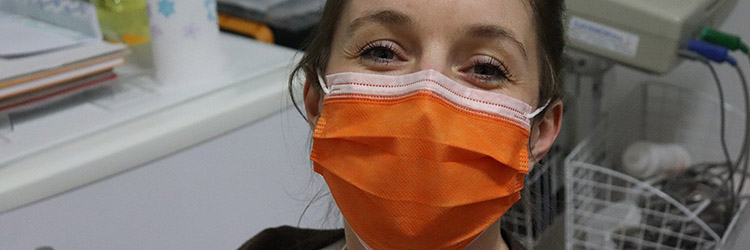
A healthcare worker wears a surgical mask, one type of personal protection equipment needed in the coronavirus outbreak. Image by Vesna Harni from Pixabay.
Some scientists and healthcare workers are on the front lines to stop the COVID-19 pandemic, but even if the specific science, technology, engineering, or math (STEM) that you work on isn’t, you can still contribute to the world’s efforts against the coronavirus outbreak.
Below are opportunities that people from all backgrounds in the STEM community can use to help fight COVID-19 and support students who have been displaced from campuses.
Run Simulations on Your Home Computer to Search for a Cure
Folding@Home is a project that invites the public to lend their computing power to run simulations that look for new therapeutic opportunities for the coronavirus that causes COVID-19.
Donate Personal Protective Equipment to Hospitals
- GetUsPPE.org
This website aims to match U.S.-based hospitals and other medical-related facilities with people who can donate or make personal protection equipment (PPE).
-
PPE Link
This website calls on research labs to donate their equipment, and Sigma Xi member Zahra Kahn is on the team leading the effort.
-
The University of Utah is one example of an academic institution coordinating efforts to donate personal protective equipment on their campus. Is your local academic institution doing something similar, or could they?
-
People around the world are donating equipment.
-
In the United Kingdom: The Institute of Conservation has coordinated PPE donations to hospitals.
-
In Canada: The nonprofit SafeCareBC launched Operation Protect, a drive for PPE donations, in partnership with Provincial Health Services and the Ministry of Health.
-
In China: The European Union Chamber of Commerce in China is asking it members and stakeholders to donate medical equipment.
-
In the United States, @ScientistLiz and @PlanetDr are examples of scientists posting on social media about their lab's donations to local hospitals.
Sign Up on the United States Scientist Volunteer Database
A volunteer database has been created of scientists based in the United States who are ready and willing to deploy their advanced skills, expertise, and access to reagents/equipment towards the fight against COVID-19 in their local communities.
Donate to Fundraisers Helping Students Who Have Been Displaced from Colleges and Universities
A couple examples:
-
George Mason University FAST Fund
Rebecca Jones, president of the George Mason University Chapter of Sigma Xi, is leading efforts to support the university’s students by securing rapid, emergency financial support from the nonprofit Believe in Students’ FAST Fund. The fund gave her $5,000, but she has received many more applications from students than that amount can support so she is seeking more donations to help more students.
“Students have lost their on-campus jobs, been displaced from residence halls, and forced to resume coursework, all online. In their applications, many students expressed difficulty paying bills such as rent and being unsure how they can buy groceries or gas in the coming weeks,” she wrote.
You can indicate on your donation that you wish that your gift goes to the George Mason University FAST Fund site.
-
Emergency Funding for University of Texas Students
Individual institutions are fundraising to support students. The University of Texas, for example, has raised more than $380,000.
Look for Ways to Support Healthcare Workers Directly
In Australia, teachers are offering childcare services and other home-based help to healthcare workers.
What resources have you found to share your STEM expertise or skills with the fight against COVID-19? Share your stories in the comments below.
Heather Thorstensen is the manager of communications for Sigma Xi, The Scientific Research Honor Society.
-
by
Jamie Vernon
| Mar 18, 2020

This illustration, created at the Centers for Disease Control and Prevention (CDC), reveals ultrastructural morphology exhibited by coronaviruses. Content Provider: CDC/Alissa Eckert, MS; Dan Higgins, MAMS
 You’ve surely been inundated by messages from your employer, your local government, your physician, and your financial advisor about how they have taken steps to mitigate the impact of the COVID-19 pandemic. Sigma Xi has also undertaken actions to protect its staff, leadership, and the Society from the wide-ranging effects of this viral outbreak. Despite the avalanche of distressing headlines and the troubling spread of misinformation, we, as members and staff of Sigma Xi, must recognize that this is a moment of truth for the Society as research moves to the forefront of the response to this crisis.
You’ve surely been inundated by messages from your employer, your local government, your physician, and your financial advisor about how they have taken steps to mitigate the impact of the COVID-19 pandemic. Sigma Xi has also undertaken actions to protect its staff, leadership, and the Society from the wide-ranging effects of this viral outbreak. Despite the avalanche of distressing headlines and the troubling spread of misinformation, we, as members and staff of Sigma Xi, must recognize that this is a moment of truth for the Society as research moves to the forefront of the response to this crisis.
Last week, in the midst of the news that a research conference was the origin of the viral outbreak in Boston, I could no longer justify putting our staff members at risk or contributing to the nationwide spread of the virus, therefore I issued an order to suspend all staff travel and to initiate an enhanced work-from-home policy. We began transitioning all in-person leadership and committee meetings to virtual gatherings. This week we are offering support to chapter leaders who wish to conduct their spring chapter events online, including virtual research symposia and chapter induction ceremonies. We do not expect the outbreak to affect the Annual Meeting and Student Research Conference in November. However, this will be a challenging time for Sigma Xi, because our university campus activities and member inductions that are run by chapters are critical to our ability to provide the resources and tools that serve our members year-round.
Just as the entire world is adapting to the social distancing culture, Sigma Xi will adjust to the circumstances and continue to meet its mission of improving the human condition through research. We are proud to know that our members are on the frontlines of the battle against COVID-19. Sigma Xi members are tracking the spread of the virus, developing vaccines and therapies to treat and prevent future infections, and communicating about how and why it’s necessary to heed the advice from public health officials. But it is science writ-large that has taken the center stage and we consider this to be a crucial opportunity to inform the public about our community’s contributions to society and demonstrate the integrity with which we do our work.
Currently, there are multiple scientific efforts underway to minimize the effects of this health crisis and prevent a repeat in the future. Scientists at the Kaiser Permanente Washington Research Institute in Seattle delivered the first rounds of a potential coronavirus vaccine to several dozen optimistic volunteers earlier this week. An immunologist at Johns Hopkins University is exploring whether antibodies from the blood plasma or serum of people who have recovered from COVID-19 infection can boost the immunity of newly infected patients and those at risk of contracting the disease. At the University of Queensland Centre for Clinical Research, scientists have found that two different medications have completely wiped out traces of the disease in early patients. Each of these promising results will need to pass clinical trials, but it’s important that we tell the world about how research is the key to finding a solution.
You have surely marveled at Dr. Anthony Fauci’s ability to deliver sober, practical guidance on the progression of the pandemic. As the National Institutes of Health's director for infectious diseases, he has become the face of science for the moment and we should applaud his performance. But while Dr. Fauci speaks to the world on behalf of the scientific community, Sigma Xi members should take this opportunity to be messengers within our own communities. There are many people in our social networks who are starving for reliable information. Because you embody the principles of Sigma Xi, which include excellence and integrity, I challenge you to be a positive force for good in your community.
Help your friends and family find accurate information about the symptoms of COVID-19 infections. [Update: See the Sigma Xi COVID-19 Preparedness Kit for resources you can share.] Explain how vaccines are made and why it takes 9-12 months to prove their safety and efficacy. Dispel myths about false cures or harmful therapies. But do it with kindness and compassion. We are the ambassadors of science and we can build immeasurable confidence and trust by serving our fellow citizens of the world. I’m confident that trust will be handsomely rewarded.
If you are already taking steps to provide accurate information about COVID-19, please share your examples with us so others can join in the effort.
Sincerely,

Jamie Vernon
Executive Director and CEO, Sigma Xi
Publisher, American Scientist
-
by
Geraldine Richmond
| Mar 17, 2020
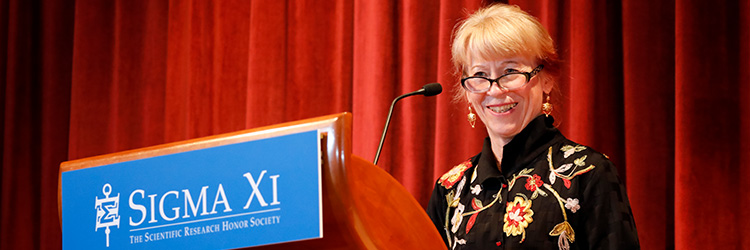
In the modern world, we are barraged with a wide range of opinions on scientific issues that include the causes of climate change, healthy food choices, and the value of different medicines, including vaccinations. This diversity of opinions, many that question the validity of compelling data, parallels the growth in accessibility of information through social and news media outlets. Separating fact from fiction has also become increasingly difficult for the general population.
On the positive side, public confidence in the scientific community has increased in recent years. As reported recently by the Pew Research Center, 35 percent of Americans say they have a great deal of confidence in scientists. This is up 14 percent from 2016, and this data is backed by a number of credible studies.
As scientists and engineers, we should all be proud of this positive perception of our efforts. But this is not the time to rest on our laurels. As with many things in our world today, this credibility can easily erode.
We all have a role to play in building and maintaining public confidence in the scientific enterprise. One does not have to look far to find recent reports of scientists and engineers accused of inappropriate professional behavior, many highly respected in their fields. Whether the charges or accusations will be validated is, of course, up to the legal process and the institutions involved. Although these cases are worrisome, they also provide an excellent opportunity for all of us to examine what constitutes appropriate professional behavior in our laboratories, our meetings, and our communities.
Many professional societies, including Sigma Xi, are taking these issues more seriously than ever in their development of codes of conduct and guidelines for dismissal of members or fellows. Discussions of the implementation of these guidelines may make some uncomfortable. But such discomfort is important as we seek the best solutions to ensuring confidence in the scientific enterprise. We look forward to your input as Sigma Xi works over the next year to further clarify the expectations and definitions of exemplary behavior of our members in our pursuit of research excellence, discovery, and innovation.
I am proud to be president of an organization that has a 134-year history of electing and honoring members who embody the core values of the Society: excellence, integrity, diversity, scholarship, leadership, and cooperation. Sigma Xi’s distinguished history of service to science and society continues today through our chapters, events, and activities.
As Sigma Xi members, we must never forget the important role we play as ambassadors for science, mentors, and leaders.
Geraldine Richmond is the Fiscal Year 2020 president of Sigma Xi.
-
by
Marijo Kent-First
| Feb 28, 2020
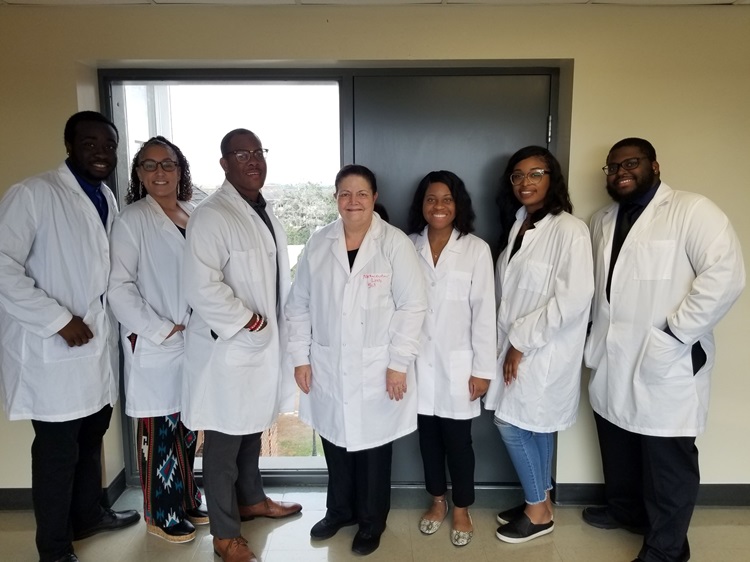
From left: Kendrick Desir, Nina Salgado, Michael Johnson, Marijo Kent-First, Maggie Bassey, Asijah Bellinger, and Tashaun Lindquest of Florida A&M University.
When I joined the Florida A&M University (FAMU) faculty in the fall of 2017, I saw an immediate opportunity for a symbiotic relationship between the university and Sigma Xi. I’ve been a Sigma Xi member since 1990 and was the president of the Mississippi State University Chapter. I knew FAMU had all the components that it takes to be a vibrant, active, and productive chapter.
FAMU is in an ideal location in the capital city of Tallahassee, nested in an area where STEM is promoted by the close proximity of Florida State University and Tallahassee Community College, undergraduate and graduate students are hungry for research experience and knowledge, and energetic faculty are ready to mentor students in their laboratories. As one of the Historically Black Colleges and Universities, FAMU’s faculty and student populations are also among the most diverse in the country.
In 2019, I accompanied two of my students, Nina Salgado and Ryan Schaffer, to Madison, Wisconsin, for the Sigma Annual Meeting and Student Research Conference. I served as a chapter delegate and delivered a lecture on my research pertaining to environmental inducers of testicular cancer. Nina presented a research poster on bladder cancer and Ryan presented a poster on the genetics of sex determination. I was also elected to be the associate director of Sigma Xi’s Comprehensive Colleges and Universities Constituency, beginning in July 2020.
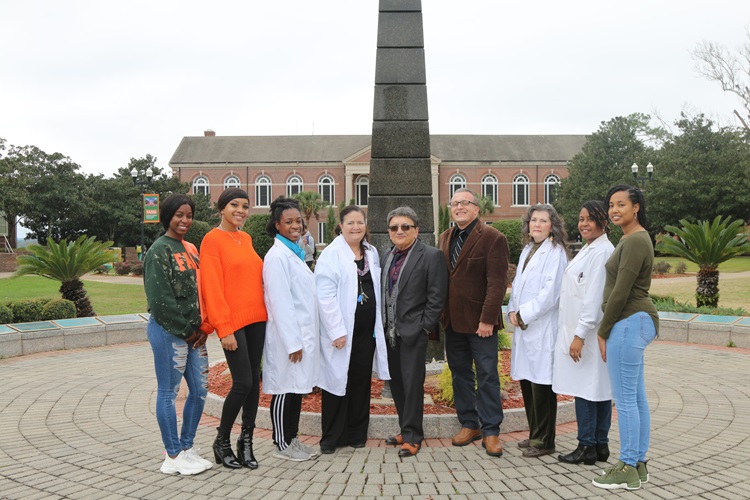
Members of the FAMU community with Marijo Kent-First, fourth from left, and Richard Alo, dean of FAMU College of Science and Technology, fifth from left.
Timely for Black History month—on February 13, 2020—my colleagues and I held the first “interest meeting” to re-launch the FAMU Chapter of Sigma Xi. I was hoping to fill a room that held 20 individuals. Before the evening was over, our growing group was forced to move to a larger room! To date, the chapter has more than 65 members including more than 15 faculty and 50 graduate and undergraduate students. Most of these students are actively involved in research activities. Approximately 80 percent of this group are students and faculty that represent minorities in science.
High on the list of events that the chapter wishes to host is a world class speaker that will bring a level of excitement in science to the “Big Bend” area of Florida, Georgia, and Alabama that is rare. Other activities include Science Cafés that take advantage of the diversity of the faculty and student membership.
Already the spirit of Sigma Xi is alive and well at FAMU. Students are forming their own executive board that will interact with the official executive board being established by the faculty. Faculty and students work together to plan meetings and Sigma Xi sponsored events. Most importantly, the “ivory towers” that professors have been known to live in have been removed and the students can feel the excitement and inner glow that comes when a group of like-minded critical thinkers come together to discuss science and to learn from each other.
Black History Month is an opportunity to recognize the rich legacy that FAMU has in education today! Students at FAMU are particularly driven to succeed. They work hard and welcome guidance from a caring mentor. In view of this, the FAMU Chapter of Sigma Xi is gearing to promote and provide just that. The faculty are dedicated to the success of FAMU students. At FAMU it is said the “FAMU is FAM-U-LY” and indeed it is. Faculty that are serving on the FAMU Chapter of Sigma Xi executive board include myself (president), Caroline Odewumi, Jillian Pope, and Virginia Gottschalk. It is common to find each of these faculty in their offices surrounded by eager students discussing topics from science in general to problems in classes and even in their lives. FAMU professors are dedicated to the success of the students at the institution and failure is not a word in their vocabulary.
Members of Sigma Xi are warm and eager to share their knowledge and excitement about science and research with others at any level. This characteristic fits well with FAMU and its mission to foster excellence in STEM-based education and research.
Marijo Kent-First is part of the biology faculty at Florida A&M University and is leading the reactivation of the Sigma Xi Chapter on campus to serve those in north Florida and southwest Georgia.
-
by
Jamie Vernon
| Feb 13, 2020
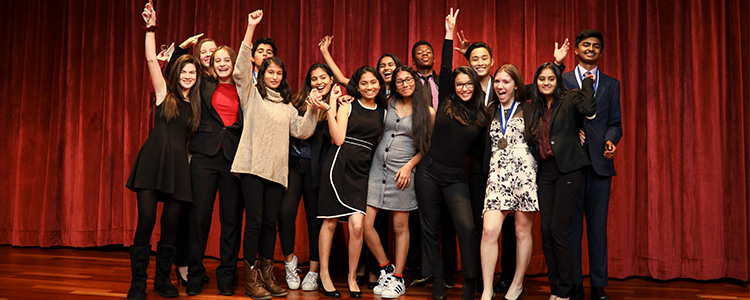
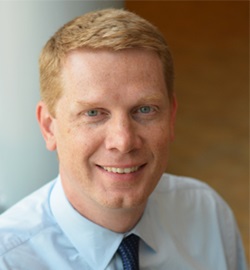 It is my honor as executive director and CEO to share what our Society has achieved in support of the research community over the last year and to lay out a road map of what we plan to accomplish in the years to come. Today, I’m pleased to announce the release of two key documents for the Society: the Fiscal Year 2019 Annual Report and the 2020–2025 Strategic Plan.
It is my honor as executive director and CEO to share what our Society has achieved in support of the research community over the last year and to lay out a road map of what we plan to accomplish in the years to come. Today, I’m pleased to announce the release of two key documents for the Society: the Fiscal Year 2019 Annual Report and the 2020–2025 Strategic Plan.
Annual Report
Fiscal Year 2019 was an exceptional year because of the work we accomplished together. The Annual Report shares stories and data about how we fulfill Sigma Xi’s mission to build a strong research community, ensure integrity in science and engineering, and help the public understand the process and results of our work.
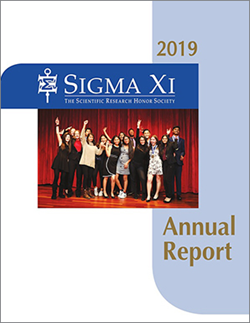 The following are key takeaways that I am most pleased to report.
The following are key takeaways that I am most pleased to report.
-
560 members volunteered to serve as chapter leaders to achieve our mission at the local level
-
50,000 people came together for research-related chapter events
-
3,200 accomplished scientists and engineers were inducted as new members
-
600 STEM students received direct support through competitions and grants
-
99,500 unique readers connected with us through American Scientist magazine
I encourage you to read the report to see the work of our chapters, the accomplishments of our members, the reach of our magazine, and the outcomes of our programs and events.
Strategic Plan
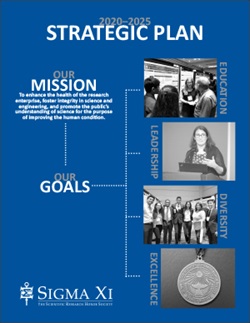 Sigma Xi is charting a new course to the future. The 2020–2025 Strategic Plan is an ambitious framework that focuses our resources and effort on four main priorities.
Sigma Xi is charting a new course to the future. The 2020–2025 Strategic Plan is an ambitious framework that focuses our resources and effort on four main priorities.
-
Advance STEM education
Sigma Xi will promote research, encourage scholarship, and participate in the betterment of education practices and training at all levels.
-
Promote scientific leadership and influence
Sigma Xi will develop and work with leaders from the research community to promote the ethical conduct and use of research, build trust in the scientific process, deliver solutions to pressing issues, and advocate for science.
-
Cultivate a diverse, robust, and inclusive community
Sigma Xi will give voice, visibility, and opportunity to diverse scientists and engineers whose contributions strengthen the research enterprise and our Society.
-
Demonstrate administrative excellence and fiscal responsiveness
Sigma Xi will execute a principled business model and reliable member services that enable the Society to serve current and future generations of scientists and engineers.
The plan describes these goals and the steps that Sigma Xi leaders and staff will take to fulfill our mission and uphold our core principles of excellence, integrity, diversity, scholarship, leadership, and cooperation.
I'd like to express my deepest gratitude for the contributions and guidance from the Board of Directors (past and present), chapter leaders, member surveys, and input from staff and other stakeholders, as they were integral to the development of this plan.
We’re counting on members like you to help us carry out this important work. Please contact executiveoffice@sigmaxi.org to learn how to get involved in your local chapter, a program, or committee.
If you have ideas about how the Society can achieve the goals described in the strategic plan, or if you would like to share a story about Sigma Xi from the past year that complements the Annual Report, please comment below.
Sincerely,

Jamie L. Vernon, PhD
Executive Director and CEO, Sigma Xi
Publisher, American Scientist
-
by
Geraldine Richmond
| Feb 11, 2020
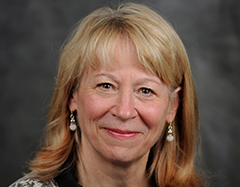 There are a multitude of reasons one aspires to become a scientist or engineer. The opportunity to use our technical expertise to improve the human condition is often what keeps us going. Often this impact is not realized until years or even decades later.
There are a multitude of reasons one aspires to become a scientist or engineer. The opportunity to use our technical expertise to improve the human condition is often what keeps us going. Often this impact is not realized until years or even decades later.
In today’s competitive workplace, we increasingly seek to measure this impact with quantifiable metrics. In some circles such as academia, the number of research papers published and citations of these papers, translated to a term called H-index, is a measure often used to assess research productivity and significance. The “impact factor” of the journal in which these papers appear is an additional metric to gauge the influence or importance of one’s work. Such metrics, however, do not capture the broader impact beyond the publishing arena.
Moreover, the research community is increasingly concerned about the detrimental effects of overusing citation metrics. Eugene Garfield, the legendary information scientist responsible for the science citation analysis, has called these metrics “rather dubious.” May Berenbaum, editor-in-chief of Proceedings of the National Academy of Sciences, recently noted that the use of such simplistic measures for determining the true impact of a piece of work is problematic. She writes that it is particularly troublesome when used as a predictor of potential career success in hiring, promotion, and funding of early career researchers. Furthermore, she believes that a heavy reliance on such numbers bypasses the important evaluative effort that involves a more time-consuming balanced analysis of the individual’s articles and importance to the field.
We at Sigma Xi, as an honorary research society, view impact as much broader than H-indices and citation numbers. As our mission statement reflects, we see our members having an impact not only in their research ventures but also by enhancing the overall health of the research enterprise. We are comprised of members who view an impactful career as one that nurtures the next generation of scientists. Many members provide science outreach activities in their communities and developing countries around the world. Those involved in science policy are affecting legislation that is technically informed and guided by fact and not guesswork. And let us not forget the impact of Sigma Xi’s volunteers who ensure the success of the Society’s programs, such as awarding students with research grants or providing distinguished lecturers.
There is no better time than now for Sigma Xi members to discuss with students, colleagues, and friends the multitude of methods of using our scientific knowledge and expertise to make a difference—including defining and embracing impact in the broadest sense. That’s who we are.
Geraldine Richmond is the Fiscal Year 2020 president of Sigma Xi.
-
by
Geraldine Richmond
| Dec 19, 2019
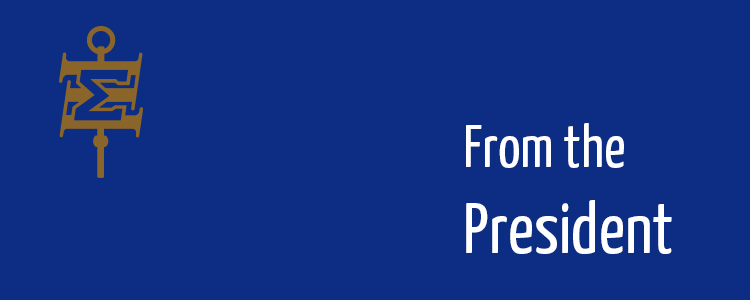
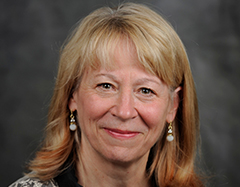 There is considerable buzz about mentorship in science, technology, engineering, and math (STEM). Departments are assigning new hires a more senior staff or faculty member, students are encouraged to find a mentor for career advice, and funding agencies increasingly require a mentorship plan for graduate students and postdocs involved in a proposed funding project. Mentoring has always been a centerpiece of Sigma Xi’s mission, and members can help carry on this tradition!
There is considerable buzz about mentorship in science, technology, engineering, and math (STEM). Departments are assigning new hires a more senior staff or faculty member, students are encouraged to find a mentor for career advice, and funding agencies increasingly require a mentorship plan for graduate students and postdocs involved in a proposed funding project. Mentoring has always been a centerpiece of Sigma Xi’s mission, and members can help carry on this tradition!
Mentorship can take several different forms. The mentor may coach the mentee for a short-term task or may be an advocate with award nominations, promotions, or new job opportunities. Both are less time intensive than the more traditionally viewed, long-term mentorship. All roles are invaluable to the mentee and can be served by one or several mentors. In all cases it is valuable to set expectations on time commitment.
But first, what factors contribute to effective mentorship? First and foremost is trust, which may take time to build, given the confidential nature of the partnership. Build trust with consistency, confidentiality, reflective listening, and respect. Open-ended questions designed to encourage meaningful responses are especially effective.
Effective mentorship is mutually beneficial to both the mentee and mentor. The benefits to the mentee are many: assistance in making career choices, adjusting to a new position, learning about the formal and informal workings of the organization, and connection to the mentor’s network. For the mentor, the benefits include learning the views of others less senior, sharing insights, improving interpersonal advisory, supporting skills in a safe environment, and passing the torch to the next generation.
Effective mentorship fosters independence and self-confidence in the mentee. A long-term mentor is a guide. The mentee should not expect to receive solutions to a career-related problem or directives on where his or her career should go. It’s also important that the mentee takes responsibility for selecting topics to be discussed, rather than relying on the mentor to develop a discussion agenda.
“Will you please be my mentor?” is not an easy ask if you don’t know the potential mentor well. A way of “testing the waters” is to reach out to someone to play the role of coach or advocate, and if that works well, the relationship could evolve into a long-term mentorship. Although there is a tendency to choose a mentor who is similar in gender identity, race, and ethnicity, there is value in finding a mentor who might provide a very different perspective. Near-peer, peer-mentoring, and mentorship networks can also be invaluable, especially with those in underrepresented STEM groups.
Geraldine L. Richmond is the Fiscal Year 2020 president of Sigma Xi.
-
by
Jamie Vernon
| Dec 17, 2019
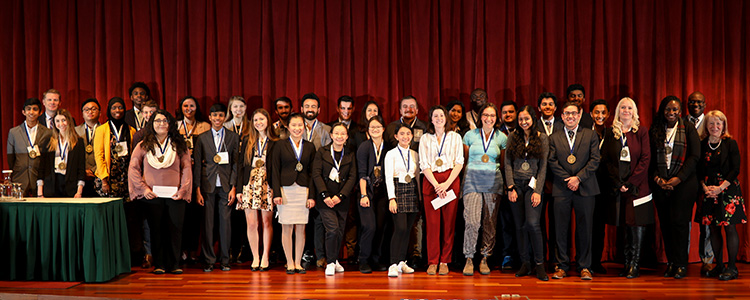
The top poster presenters in the 2019 Sigma Xi Student Research Conference. (Images by Sam Waldron for Ruthie Hauge Photography)

Sigma Xi takes pride in creating an inclusive environment for the creative pursuit of knowledge. We gather together for member and chapter events to connect and build relationships. Research is our common bond, but it’s also important to think about the quality of life that those around us have outside of our work environment.
For example, how often do we ask our colleagues, mentees, and students about their plans for the holidays? We assume that most people have a plan that is like ours. However, as science has become more diverse so, too, have holiday plans, or the lack thereof. For economically disadvantaged students, traveling home may be a little too much to bear. Likewise, immigration protocols may deter our international colleagues, mentees, and students from visiting their families in distant places. So where do these folks spend their holidays?
Many may occupy their time by spending additional hours in the laboratory, hoping to get a little more work done, or just fill time. Would they choose to do so if they had a more welcoming place to go?
During the recent Sigma Xi Annual Meeting in Madison, Wisconsin, member Ashanti Johnson, recipient of the 2019 John P. McGovern Science and Society Award and a champion of broadening participation in research, described her student experience as a woman of color. Her childhood dream to be like Jacques Cousteau was diminished by the loneliness of her early research experiences. While her classmates, who were predominantly white, completed their daily tasks and then headed out for after-hours imbibing, she and her classmate, also a person of color who wasn't interested in drinking at the local pub, returned to their campus housing without peers who shared their interests or cultures.
The problem of being left out continued into her professional career. She gave the example of colleagues who at a social activity, discussed and made decisions that were scheduled to be addressed at an upcoming faculty meeting. She wasn’t present during the discussion and didn’t have the opportunity to have a voice at the table.
The message of her story is: diversity of representation is not enough for research to thrive. We also need to be inclusive with our colleagues, mentees, and students—to ensure they have a voice in decision-making, to give them equal career-growth opportunities, and to find ways to welcome them into the research community. Sometimes, especially during the holidays, making everyone feel welcome extends beyond the laboratory.
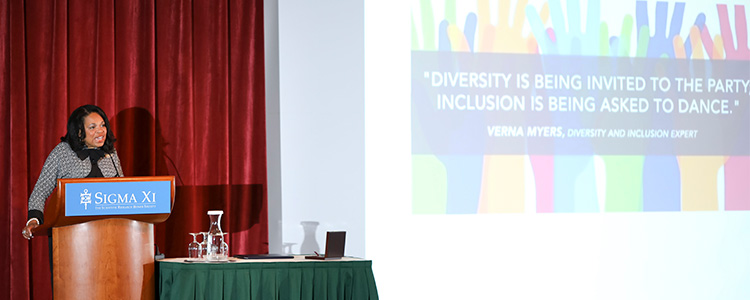
Dr. Ashanti Johnson speaks about the importance of diversity and inclusion in research as she accepts the Sigma Xi John P. McGovern Science and Society Award at the Society's 2019 Annual Meeting and Student Research Conference.
As many of us prepare to leave the lab or the office for the holiday break, it might be appreciated if we simply ask our colleagues, mentees, and students how they plan to spend their time. Other ways to be inclusive this time of year include:
-
hosting a potluck at your home,
-
organizing social time around a shared goal such as a service project,
-
starting conversations about interests outside of school or work,
-
inviting those who would otherwise not have plans this time of year to join in your activities,
-
asking about community events or traditions that they enjoy, whether those take place in December or not,
-
joining them in their preferred social environment.
You might find that your holidays are enriched by the presence of a few new faces around the dinner table.
Have you found a way to be more inclusive with your colleagues, mentees, and students, such as starting a dialogue about different cultures or traditions? What have you done? Please share in the comments below.

Jamie L. Vernon
Executive Director and CEO, Sigma Xi
Publisher, American Scientist
-
by
Jamie Vernon
| Nov 20, 2019
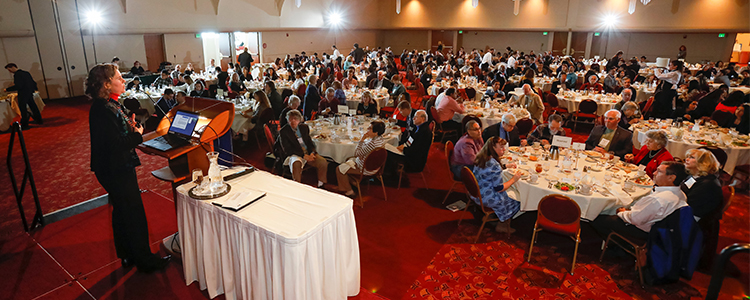
Sigma Xi 2019 Young Investigator Award recipient Ariana Sutton-Grier spoke on November 16 at the Sigma Xi Annual Meeting and Student Research Conference in Madison, Wisconsin, about natural climate solutions and the critical role researchers can play in informing policy makers. (Ruthie Hauge Photography)
 I had a front-row seat last week as Sigma Xi’s 2019 Young Investigator Award winner and member, Ariana Sutton-Grier of the University of Maryland, College Park, described a piece of the puzzle to fight climate change that is already at our feet, if only those with decision-making power decide to manage it properly.
I had a front-row seat last week as Sigma Xi’s 2019 Young Investigator Award winner and member, Ariana Sutton-Grier of the University of Maryland, College Park, described a piece of the puzzle to fight climate change that is already at our feet, if only those with decision-making power decide to manage it properly.
She investigates natural climate solutions, such as coastal wetlands that can sequester carbon. Forests, agricultural lands, and grasslands also hold opportunities. If the United States implemented all practices where nature could help reduce carbon dioxide, we could sequester approximately 21 percent of the country’s annual emissions.
Dr. Sutton-Grier spoke passionately about putting natural climate change solutions into action, and she took it one step further. As we begin to see the effects of climate change in our lifetime, she reminded us that we are not only scientists and engineers. We also have the right to let our elected leaders know what we want to see from their votes.
At the end of her talk, she urged the U.S.-based Sigma Xi members and students to become active science advocates and to contact their representatives on the issues they care about. Legislators focus on the concerns of their constituents, and they find out what we care about only when we tell them directly. For the international citizens in the room, she urged them to get involved in their governments.
As someone who has worked in Washington, DC, I know that those of us in the research community have an important role to play in providing credible scientific information to our policy makers. Most people in Congress are not scientists or engineers. We can and should provide context and guidance on complex issues to ensure their decisions are informed by evidence.
I’m happy to report that last year President Donald Trump appointed a Sigma Xi member as the director of the White House’s Office of Science and Technology Policy, Kelvin Droegemeier, and has formally re-established the President’s Council of Advisors on Science and Technology. Those are steps in the right direction, and we need more scientific voices involved in government to elevate the scientific evidence where and when it is relevant.
Think about the major issues of our time: gun safety, nuclear safeguards, microplastics, antibiotic resistance, clean drinking water, the obesity and opioid epidemics, just to name a few. Research will bring solutions. Research, and the communication of that research, is what we need.
In addition to using scientific evidence to inform policy decisions, legislators and executive branch leadership must also think about the policies that affect the way science is conducted. Funding levels, scientific integrity, and STEM education stand out as key policy areas that would benefit from greater scientific participation. These issues cannot be adequately addressed by policymakers without input from practicing scientists and engineers.
As executive director and CEO, I’d like to know your science policy priorities, what you have done or would be willing to do to advocate for science, and the kind of role you think Sigma Xi should play to make the biggest difference. What specific policy issues are you most concerned about?
Here are some recent examples from Duke University’s Initiative for Science and Society:
Please comment below or contact me at executiveoffice@sigmaxi.org.

Jamie L. Vernon
Executive Director and CEO, Sigma Xi
Publisher, American Scientist
-
by
Linda Mantel
| Nov 13, 2019
Linda Mantel is the 2019 recipient of the Evan Ferguson Award for Service to the Society. She will accept her award on November 15 at the Annual Meeting and Student Research Conference in Madison, Wisconsin.
Why are chapters important for Sigma Xi?
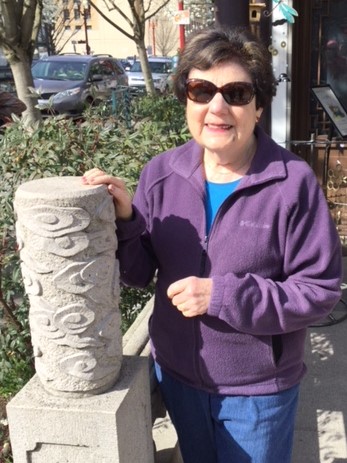
Chapters are the lifeblood of the organization and a major factor differentiating Sigma Xi from other multidisciplinary organizations. They are the connecting links among members, the organization, and the scientific community as a whole. For the past 18 years, I have been a proud member of the Sigma Xi Columbia-Willamette Chapter, a multi-institutional chapter with members from several local schools, industry, and agencies based at Portland State University. I joined the chapter board in 2002, served as secretary from 2004-2008, and then as president from 2008-2019.
How does the chapter serve the local scientific community?
Thanks to my colleagues on the Board of Directors and elsewhere, we grew our chapter events and activities to include not only professional talks, but also events for students and for the larger community. We raised our chapter profile locally and nationally by wearing our chapter buttons when participating in scientific events, and attending meetings and showing our chapter poster.
Our chapter members serve as judges for the statewide pre-college Northwest Science Expo, and the chapter awards cash prizes to winners in several categories. We also support student recipients of Sigma Xi Grants in Aid of Research by awarding them an additional $100. Our annual Student Research Symposium, open to college and university researchers in the entire area, brings from 35-75 participants to campus, provides exposure to science programs in the area, and provides the winners with both cash prizes and the opportunity for travel support to Sigma Xi Annual Meetings. Our award-winning students serve as inspiration for additional students to participate and become part of the scientific community. We also have a robust, privately-funded Outstanding Faculty Award program, where we honor both a junior and a senior faculty member in all our science areas with cash awards and certificates. These winners then come back and provide lectures for us during the year.
Our end-of-year celebration has become a favorite event for the community, bringing together our usual attendees and new friends. At this event, we honor a local teacher, a local supporter of research, and all of our student and faculty research awardees. Each person is given three minutes to introduce their science to the audience, and we are always astounded by the breadth of scientific and engineering endeavors being carried out right at home.
One of our special contributions to the community is our wine-tasting series, where thanks to Scott Burns, our local “terroirist,” we have an annual winter event with tastings of a variety of wines. This serves as a chapter fundraiser, to help support student travel to Sigma Xi conferences. We also have summer wine-tasting trips to see the terrain and terroirs first hand.
How can chapters expand their networks?
Our chapter is fortunate to have members from a diverse array of organizations. I believe the multi-institutional format provides benefits well beyond those found on a single campus. Leadership can come from many directions, connections can be forged with many colleagues, and partnerships can be found in unexpected places. For chapters uncertain of how to move beyond their normal programming, try inviting a neighboring chapter or organization to join you for a program, a dinner, or a celebratory event. For instance, we have co-sponsored science-based events with local groups such as the Union of Concerned Scientists, the League of Women Voters, and Oregon Academy of Sciences.
What have you learned from your experiences with Sigma Xi?
Having been inducted into Sigma Xi as a graduate student at the University of Illinois, I have been a member for 55 years! My service for the Columbia-Willamette Chapter was not only all encompassing, but also rewarding. Building and engaging the chapter and board membership are never-ending projects. With the support of my colleagues and the superb assistance of the headquarters staff, the chapter has won three awards in the past eight years. I know the next generation of board members and officers will continue the good work.
Perhaps my most significant contribution to Sigma Xi as a whole came when I served as director of the Northwest Region and established the relationship between the AAAS Pacific Division (AAAS PD) and the Northwest and Southwest regions of Sigma Xi. We have met together each summer since 2012, thanks to the efforts of the regional directors and the AAAS PD board and staff. I believe this linkage of Sigma Xi and AAAS PD represents value to both organizations, and in particular to students, who have the opportunity to present their work in two different Sigma Xi venues per year.
-
by
Esther Takeuchi
| Nov 11, 2019
Co-written by PhD candidate in Materials Science and Chemical Engineering Mikaela Dunkin
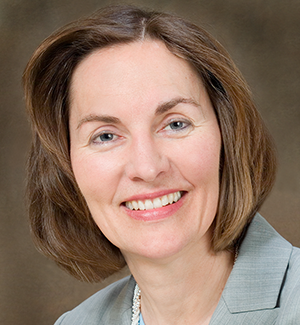 Batteries for implantable medical devices must be small, reliable, safe, and long lasting. These characteristics are desirable for other battery applications as well. Thus, the insights gained from extended lifetime medical batteries are providing inspiration to design and improve other types of batteries for multiple types of uses.
Batteries for implantable medical devices must be small, reliable, safe, and long lasting. These characteristics are desirable for other battery applications as well. Thus, the insights gained from extended lifetime medical batteries are providing inspiration to design and improve other types of batteries for multiple types of uses.
Implantable cardiac pacemakers are powered by the lithium/iodine-polyvinylpyridine (PVP) battery system, which was first patented in 1972 and continues to be used to the present day due to its high energy density, safety, and reliability. As the cell discharges, the reaction product, LiI, grows. While this change provides a safe battery and allows the battery’s status to be determined while still inside a patient, it ultimately contributes to the decline of the primary battery.
Recent research has transformed the use of the lithium iodide layer into a secondary (rechargeable) battery through the addition of lithium iodide-(3-hydroxypropionitrile)2. We have expanded upon this concept to create a fully self-forming battery where the lithium anode and iodine cathode are generated during the first charge step. This mitigates the risk of self-discharge, allowing the inactivated battery to be stored over long time periods. Further work on decreasing the overall impedance, particularly due to interfacial effects, has been inspired by the formation of a liquid electrolyte phase when PVP reacts with lithium and iodine. By studying this battery system under the rigorous conditions needed by implantable medical devices, a variety of issues important for many different applications are addressed.
Since the 1980s, implantable cardiac defibrillators (ICDs) have been implemented and powered by the lithium/silver vanadium oxide (SVO) battery, a versatile system which is capable of providing a constant low current to monitor a heart and then producing current pulses in the 2 – 3 A range to shock the heart back into a proper rhythm. The Li/SVO system has remained in use over many years due to this capability and its overall reliability. Battery life can be limited by trace amounts of vanadium species dissolution into the electrolyte and subsequent deposition onto the lithium anode, thereby forming a passivation layer, increasing internal resistance and decreasing pulse power. Similar dissolution issues are seen in lithium/sulfur and aqueous battery systems. Understanding the underlying processes by which cathodic dissolution occurs, allows us to address the issue by intelligently mitigating, overcoming, or utilizing the materials differently. Li/SVO, and analogues such as silver vanadium phosphorous oxide (SVOP), have been examined in dissolution studies utilizing inductively coupled plasma—optical emission spectroscopy (ICP-OES) to better understand the kinetics at work. Quantifying the role of cathode dissolution, has provided insight into multiple systems in a variety of ways.
Other passivating reactions that are common within secondary batteries are the formation of a solid electrolyte interphase (SEI) layer that often forms at electrode surfaces due to the decomposition of electrolytes. This often occurs because liquid electrolytes are thermodynamically unstable at the working potential of the battery’s active materials. While the SEI can serve to protect the electrodes from further dissolution, it can also remove active materials from the battery and increase cell resistance. These mechanisms are difficult to study under a battery’s operating conditions in a sealed cell and the vital importance of unaltered reaction conditions, which are critical in specially designed cells. Isothermal microcalorimetry (IMC) can be utilized as an operando tool to probe the reactivity within a working battery by detecting the evolved heat from parasitic or decomposition reactions and correlating them with specific reactions within a cell. Indeed, it is often the parasitic reactions taking place inside a battery that limit its lifetime rather than consumption of the active materials.
Esther Takeuchi, pictured above, is the 2019 Sigma Xi Walston Chubb Award for Innovation recipient and will be a plenary speaker at the 2019 Annual Meeting and Student Research Conference on November 15 in Madison, Wisconsin. She is a SUNY Distinguished Professor and holds the William and Jane Knapp Chair in Energy and the Environment in the Departments of Materials Science and Chemical Engineering and Chemistry at Stony Brook University. She holds a joint appointment at Brookhaven National Laboratory as chief scientist in the Energy and Photon Sciences Directorate.
-
by
Ben Santer
| Nov 11, 2019
I love mystery stories. I grew up on a steady diet of Sherlock Holmes and Ellery Queen. Mysteries and puzzles are part of the reason I was drawn to the field of climate science. One of the ultimate mysteries is figuring out why Earth’s climate changed over the past century. Climate change is like Agatha Christie’s Murder on the Orient Express—many different suspects are implicated. Human-caused changes in levels of heat-trapping greenhouse gases. Deforestation. Natural fluctuations in the Sun’s energy output. Volcanic activity. Internal cycles in the climate system. The real scientific challenge is to reliably quantify the degree of culpability of each suspect.
In evaluating how well a mystery novel has been crafted, it’s important to look at the consistency of the plot. A discerning reader might ask whether the internal logic rings true and the individual story lines are neatly woven together.
We can ask a similar question about the climate system. Is it telling us an internally consistent story about the causes of recent climate changes? The answer is a resounding “yes.” Over the last century, the Earth’s oceans and land surface warmed. Most glaciers retreated. The Greenland Ice Sheet lost some of its mass. Global-mean sea level rose. The atmosphere moistened. Rainfall and atmospheric circulation patterns shifted. Snow and sea-ice extent decreased in the Northern Hemisphere. Heat waves became more intense, longer lasting, and more frequent. Records for extreme heat were set more often than records for extreme cold. Even climatic metronomes like the daily and seasonal temperature cycles began to beat a little differently.
Our best scientific understanding is that all of these changes are consistent with the expected effects of fossil fuel burning. They cannot be explained by natural causes alone.
How do we know this? Let’s go back to the mystery story analogy. Fingerprints are unique markers that can link a suspect to the scene of a crime. Studies of the causes of climate change also rely on unique markers. The basic idea is that different influences on climate have different characteristic signatures in climate records. Human-caused increases in greenhouse gases, for example, don’t have the same climatic loops, whorls, and arches as purely natural changes in the Sun’s energy output. Patterns encode rich streams of information.
Until the 1980s, climate scientists tried to separate human and natural influences on climate by examining a single piece of evidence—the average temperature of Earth’s land and ocean surface. Then-available estimates of global-mean surface temperature suggested that Earth had warmed over the 20th century. This warming was judged to be unusually large relative to estimates of natural climatic variability. But global-mean temperature was a relatively blunt diagnostic; it did not provide definitive proof that human activities were responsible for most of the observed warming.
The real breakthrough happened in the late 1980s. That was when scientists started to look at more than the average temperature of the planet’s surface. These early pioneers harnessed the power of pattern recognition techniques to disentangle human and natural influences on the climate system.
They sliced and diced complex four-dimensional climate data sets horizontally, vertically, and in time. They interrogated latitude-longitude maps and sections through the full vertical extent of the atmosphere and oceans. They compared climate changes in winter and in summer. They used a mathematical tool called Fourier analysis to decompose climate data into wave forms, unlocking information about the characteristic time stamps of the sunspot cycle, and of natural oscillatory phenomena like El Niños and La Niñas.
These pattern studies were enabled by several key developments. One development was the capability of observing Earth’s climate from space. With the launch of the TIROS-1 weather satellite in 1960, the view of our planet’s atmosphere and oceans shifted from the local and regional to the global. In video game terms, humanity “leveled up.” We reached a new stage of awareness of our changing climate.
From space, scientists made measurements across most of the electromagnetic spectrum, utilizing a variety of wavelengths to probe temperature, rainfall, ocean color, fluxes of energy at the top of the atmosphere, sea-ice extent, wind speed, the water content of clouds, and dozens of other climate variables. They monitored changing atmospheric levels of carbon dioxide, ozone, particulate pollution, and volcanic aerosols. They tracked hurricanes and typhoons, observed massive phytoplankton blooms, watched wind-borne dust from the Sahara reach the Caribbean, and followed the global dispersion of volcanic aerosol from the 1991 eruption of Mt. Pinatubo. They witnessed the break-up of the Larsen-B ice shelf, the growth of a garbage patch in the North Pacific Gyre, deforestation of the Amazon and Indonesia, and oil fires in Kuwait. The exquisite beauty of Earth’s climatic life-support system was made visible, along with its fragility.
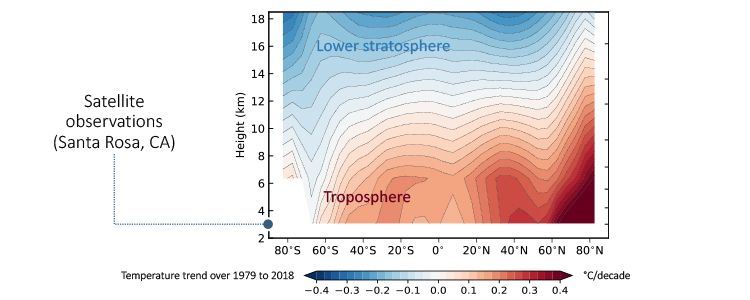
Figure 1: Satellite measurements of atmospheric temperature change from the Remote Sensing Systems research group based in Santa Rosa, California (http://www.remss.com/). Results are linear trends in temperature, in degrees Celsius per decade, over the 40-year satellite record (1979 to 2018). Trends are a function of latitude and the height in kilometers above the Earth's surface. Trends are averages at all available locations along each band of latitude, and are plotted for three layers of the atmosphere (the lower troposphere, the mid- to upper troposphere, and the lower stratosphere). The figure shows pronounced warming of the troposphere and cooling of the lower stratosphere. This "fingerprint" of atmospheric temperature change is consistent with human effects on climate, but is inconsistent with claims that all climate change since in 1979 is due to purely natural causes. Source: updated from Santer, B.D., J. Painter, C. Bonfils, C. Mears, S. Solomon, T.M.L. Wigley, P.J. Gleckler, G.A. Schmidt, C. Doutriaux, N.P. Gillett, K.E. Taylor, P.W. Thorne, and F.J. Wentz, 2013: Human and natural influences on the changing thermal structure of the atmosphere. Proceedings of the National Academy of Sciences, 110, 17235-17240, doi:10.1073/pnas.1305332110
The second major development in unraveling the mysteries of climate change was the rise of computer modeling of the climate system. In the real world, multiple human and natural influences on the climate system are varying simultaneously. We don’t have the luxury of being able to hold the Sun’s energy output constant for decades or centuries. But in the virtual lab of a climate model, scientists can change one influence at a time. They can isolate the unique climatic fingerprints of the Sun, volcanic activity, stratospheric ozone, and greenhouse gases. They can estimate these fingerprints with simple and complex models. They can determine if the fingerprints are robust and interpretable in terms of well-understood physical mechanisms. And finally, they can search for the model-predicted fingerprint patterns in hard data.
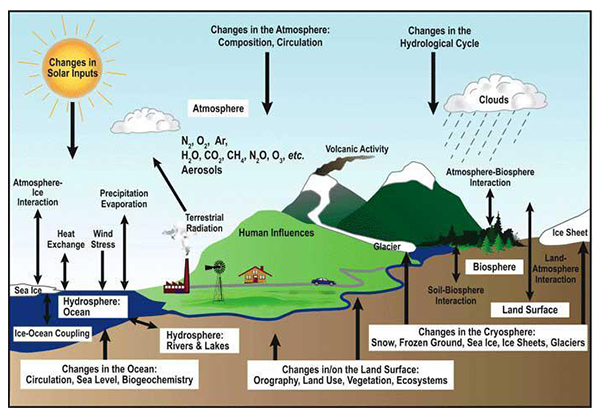
Figure 2: Some of the components and processes in a typical computer model of the climate system. Image rights: Le Treut, H., R. Somerville, U. Cubasch, Y. Ding, C. Mauritzen, A. Mokssit, T. Peterson and M. Prather, 2007: Historical Overview of Climate Change. In: Climate Change 2007: The Physical Science Basis. Contribution of Working Group I to the Fourth Assessment Report of the Intergovernmental Panel on Climate Change [Solomon, S., D. Qin, M. Manning, Z. Chen, M. Marquis, K.B. Averyt, M. Tignor and H.L. Miller (eds.)]. Cambridge University Press, Cambridge, United Kingdom and New York, NY, USA.
By exploiting these model simulations, satellite measurements, and many other observational data sources, scientists found that human fingerprints on climate are ubiquitous. Let me give you one example. In 1967, Suki Manabe and Richard Wetherald—both scientists at the Geophysical Fluid Dynamics Lab in Princeton —used an early computer model of the atmosphere to increase atmospheric CO2 levels from 150 to 300 to 600 parts per million (1). They showed that human-caused increases in greenhouse gases should produce sustained warming of the lower atmosphere and cooling of the upper atmosphere. Decades later, in our own research at Lawrence Livermore National Laboratory, we detected this curious pattern of large-scale atmospheric warming and cooling, first in weather balloon temperature measurements, and later in satellite temperatures inferred from the microwave emissions of oxygen molecules. No known natural phenomena can produce this fingerprint pattern.
Such fingerprint evidence contributed to an historic 1996 conclusion of the Intergovernmental Panel on Climate Change: “the balance of evidence suggests a discernible human influence on global climate” (2). Critics of the 1996 finding argued that the evidence was too preliminary, and could be overturned by the availability of better observations, better models, and better pattern recognition methods.
Instead of being overturned, the evidence for a “discernible human influence on global climate” strengthened since 1996. We now have better and longer observational records for hundreds of different climate variables. Models improved dramatically in terms of the fidelity with which they represent today’s average climate, the seasonal cycles of temperature and rainfall, the patterns and timescales of natural variability, and key physical processes involving clouds and the ocean. Statisticians introduced more rigorous fingerprint methods. As a result of these and many other advances, the most recent report of the Intergovernmental Panel on Climate Change, published in 2013, reached a far more definitive finding than the cautious 1996 “discernible human influence” statement. The 2013 report used information from many different sources to estimate the size of the human effect on climate, concluding that: “It is extremely likely that human influence has been the dominant cause of the observed warming since the mid-20th century” (3).
Despite this evolution in scientific understanding, there will always be uncertainties in climate models, in observations, and in our physical understanding of the climate system. The difficult problem that confronts us – as a nation, and as citizens of this planet—is how to act in the face of both remaining scientific uncertainties and the overwhelming scientific evidence that our actions are altering global climate. We should be very clear about one point. The decisions we reach today will influence the climate that future generations inherit.
In addition to being a mystery buff, I’m also a rock climber. I can recall at least one occasion on which I had to stand on a friend’s shoulders to reach elusive handholds that I couldn’t quite grasp on my own. Science is like that, too. There are pieces of the climate puzzle that you cannot hope to reach without standing on the metaphorical shoulders of the body of work others have assembled. The fingerprint
work that I’ve been involved with would not have been possible without important contributions from colleagues at Livermore and around the world. It’s been a real privilege to share this scientific journey with them.
Ben Santer is an atmospheric scientist with the Program for Climate Model Diagnosis and Intercomparison at Lawrence Livermore National Laboratory. He is the 2019 recipient of the Sigma Xi William Procter Prize for Scientific Achievement and will be a plenary speaker at the Society's 2019 Annual Meeting and Student Research Conference on November 16 in Madison, Wisconsin.
(1) Current levels of atmospheric CO2 are at roughly 415 parts per million (ppm). Before the start of large-scale fossil fuel burning, levels of atmospheric CO2 were at approximately 260 to 270 pm.
(2) Santer, B.D., T.M.L. Wigley, T.P. Barnett, and E. Anyamba, 1996: Detection of Climate Change, and Attribution of Causes, in Climate Change 1995: The Science of Climate Change. Contribution of Working Group I to the Second Assessment Report of the Intergovernmental Panel on Climate Change. Edited by J.T. Houghton, L.G. Meira Filho, B.A. Callander, N. Harris, A. Kattenberg and K. Maskell, Cambridge University Press, Cambridge, 407-443.
(3) Bindoff, N.L., K.M. AchutaRao, M.R. Allen, N. Gillett, D. Gutzler, K. Hansingo, G. Hegerl, Y. Hu, S. Jain, I.I. Mokhov, J. Overland, J. Perlwitz, R. Sebbari, and X. Zhan, 2013: Detection and Attribution of Climate Change: from Global to Regional, in Climate Change 2013: The Physical Science Basis. Contribution of Working Group I to the Fifth Assessment Report of the Intergovernmental Panel on Climate Change. Edited by T.F. Stocker, D. Qin, G.-K. Plattner, M. Tignor, S.K. Allen, J. Boschung, A. Nauels, Y. Xia, V. Bex, and P.M. Midgley, Cambridge University Press, Cambridge, 867-952.
-
by
A. E. Sutton-Grier
| Nov 08, 2019
Climate change has been in the news a great deal recently. The Intergovernmental Panel on Climate Change (IPCC) has released two very important reports just recently in 2019 looking at the role of terrestrial lands and oceans in climate change. And in late 2018 the IPCC released a special report about warming that suggested among other things that this is not a problem of the future but that climate change is already occurring and we are feeling its impacts (I find the Summary for Policy Makers especially useful). The report also concluded that humanity must make major strides in reducing greenhouse gas emissions by 2030 and must reach zero emissions by 2050 in order to limit warming to 1.5 ˚C and to avoid the worst impacts of climate change.
This is serious. As Greta Thunberg states in this very compelling YouTube video, “This is not a drill.” I agree 100%. So, did you know there is already a powerful technology available for removing carbon dioxide (CO2) from the atmosphere? This technology is called photosynthesis and is the process plants have been using for millions of years to remove CO2 and make sugars on which we all depend for our food. To be clear, plants cannot solve the climate change problem for us on their own. We MUST reduce emissions and stop burning fossil fuels. We must increase the production of renewable energy and increase our energy efficiency so that we need less energy and are only using clean energy and we need to do this over the next two to three decades.
But plants offer a tremendous opportunity to help reduce atmospheric CO2 at a time when we do not have any other technology that can scale to global scales in a cost-effective manner that will remove CO2 and mitigate climate change. This is why I have devoted the last 9-plus years of my career to promoting the role of coastal wetlands in carbon sequestration and storage. Carbon stored in coastal wetlands is called “blue carbon” and I will be presenting the science and policy of blue carbon at the upcoming annual Sigma Xi Annual Meeting in Wisconsin, Madison. See Figure 1.

Figure 1: Mangroves and salt marshes are two of the coastal “blue carbon” wetlands that sequester a great deal of carbon in their wood (mangroves) and soils (both). Note the dark soil shown in the salt marsh photo. This dark color comes from the organic matter in the soil which is from the stored carbon.
Coastal wetlands are not the only ecosystems taking up and storing carbon, however. I was part of a study for the whole U.S. examining how much of our emissions we could reduce by better managing, protecting, and/or restoring natural ecosystems. Forests, grasslands, urban trees, agricultural lands, and other wetlands are also taking and storing carbon, some of it in the biomass of the plants (such as the carbon stored in wood) but also carbon is stored in soils, particularly those that are rich in organic matter. This means that practices such as reforestation, better forest management, and avoided forest conversion would help our forests sequester more carbon. And practices such as planting cover crops, better nutrient management practices, and grassland restoration or avoided conversion are practices which would allow our working farm lands and grasslands to sequester more carbon. For wetlands in the U.S. the biggest opportunities are to restore tidal wetlands and peatlands, and to avoid the loss of or restore seagrasses. See Figure 2 for more details.
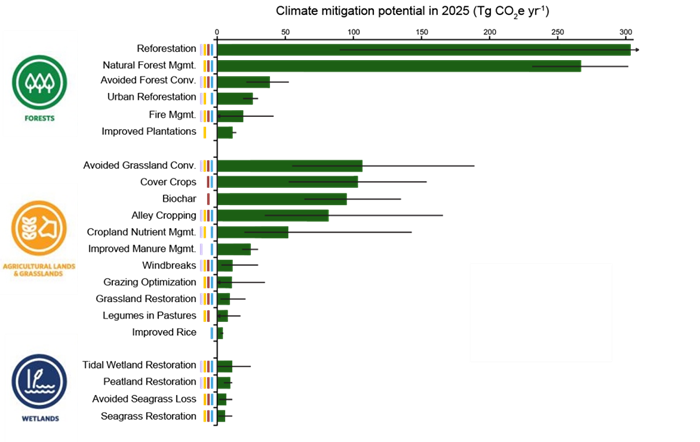
Figure 2: Natural climate solutions for the U.S. If the U.S. implemented all of these practices where nature could help reduce CO2, we could sequester ~21% of the U.S. annual emissions. Figure from: Fargione et al. 2018. Natural Climate Solutions for the United States. Science Advances.
The message here is hopeful but urgent. Humanity has only a couple of decades to avoid the worst climate change impacts; we must move swiftly to reduce emissions. And natural solutions can be a key component of climate change mitigation. Nature can play an important role if we halt habitat loss around the globe and seriously commit to restoring and better managing ecosystems so that they can sequester carbon and reduce greenhouse gases in the atmosphere. We have options but we MUST implement them now. I hope you can come to my talk to learn more about coastal blue carbon in Madison!
Ariana Sutton-Grier is the 2019 Sigma Xi Young Investigator Award recipient. She is a Sigma Xi member and a visiting associate research professor at the University of Maryland, College Park. She is an ecosystem ecologist with expertise in wetland ecology and restoration, biodiversity, biogeochemistry, climate change, and ecosystem services.
Related Reading:
The Ocean Is Key to Achieving Climate and Societal Goals, from Science
-
by
Geraldine Richmond
| Oct 28, 2019
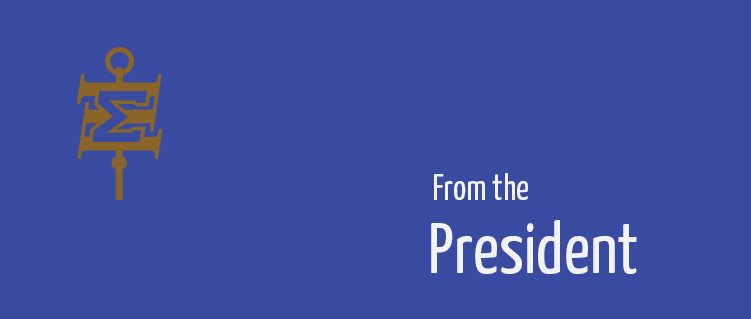
Why is diversity so important in science and technology?
 This question, whether asked or implied, is one we need to counter at all levels. Our growing diversity in science and engineering is our strength. And given the global challenges we face today, we need all the mental muscle power we can get.
This question, whether asked or implied, is one we need to counter at all levels. Our growing diversity in science and engineering is our strength. And given the global challenges we face today, we need all the mental muscle power we can get.
Ultimately, our goal must be cognitive diversity—the grand assembly of different perspectives and skills in laboratories and classrooms. This aspiration can be reached only through a diversity of race, gender, sexual orientation, age, experience, and geography. Examples abound that show how a diverse team can identify and address issues that a like-minded and a look-alike team might miss. For instance, countless lives of women and children have been saved after airbag engineers realized the mistake of basing the force of deployment on the size of the average adult male. Lives are being improved and saved as medical and pharmaceutical researchers take into full account the differences in racial, gender, and ethnic physiology.
For those who thrive on data, substantial research shows the economic benefit of an inclusive environment. Companies with ethnically and culturally diverse executives, boards of directors, and rank-and-file workers are 35 percent more likely to show profitability above their industry medians, according to the Diversity Matters report by McKinsey & Company, which compiled data from 366 public companies across a range of industries in the United States, Canada, Latin America, and the United Kingdom.
A large and expanding gap exists between how older generations and younger Millennials define diversity and inclusion. Baby boomers and Gen Xers tend to consider workplace diversity in legal and moral terms, regardless of whether it benefits the bottom line. It’s simply a matter of fairness.
Millennials, however, take a much broader view, according to Unleashing the Power of Inclusion, a study by Deloitte and the Billie Jean King Leadership Initiative. Millennials consider diversity to be a necessary building block for innovation. They believe an inclusive culture—built on teamwork—is also essential to competitiveness and financial growth. According to this study, the disconnect between the generations is already causing hardships as upper management resists attempts by Millennials to express themselves freely.
The generations that follow will likely amplify these views. Diversity is a requirement for the future. If scientists and engineers are to continue their claim of always being at the forefront of innovation, they also must fully embrace the growing understanding of the power of diversity.
Geraldine L. Richmond is the Fiscal Year 2020 president of Sigma Xi.
-
by
Surojit Gupta
| Oct 25, 2019
Ellen MacArthur became the fastest solo sailor to circumnavigate the globe in 2005. She described part of her experience as, “Sailing around the world against the clock in 2004, I had with me the absolute minimum of resources in order to be as light, hence as fast, as possible.” This experience was instrumental in laying the foundation of circular economy (refer to the Ellen MacArthur Foundation's website for a detailed timeline.)
The Ellen MacArthur Foundation has outlined three key principles for Circular Economy, “(a) design out waste and pollution, (b) keep products and materials in use, and (c) regenerate natural systems." In other words, a Circular Economy model is based on the 3R principles of reducing, reusing, and recycling to build economic, natural, and social capital. Unlike a traditional linear model, this model is healing and sustainable as it strives towards the use of renewables, eliminating the link between consumption and economy, and phasing out waste.
Based on these principles, the First Global Commitment report was released in June 2019 for finding solutions to the global plastic waste and pollution problem. This report was compiled by the Ellen MacArthur Foundation with input from the United Nations Environment Programme, and consultation with different government signatories. The underlying paradigm of this global initiative is focused on, (a) eliminating the usage of irrelevant and dubious plastic items, (b) innovating newer technologies which will focus on reusable, recycle, or compostable composites, and (c) circulating plastic items. (More on the report)
My research group is focused on innovative novel additive manufacturing and sustainable technologies which can be re-used and/or re-purposed (related papers are listed below). We have created novel innovative technologies for re-utilizing waste materials like polyester and that use lignin for developing novel materials by incorporating a student-centric research program. A critical challenge of any educational program is to integrate research with teaching pedagogy. In order to develop a holistic teaching program for training students in sustainability and Circular Economy, I am using a combination of research, entrepreneurship, team-oriented, and project based educational pedagogy. For example, National Academy of Engineering (NAE) has also created the Grand Challenge Scholar’s Program (GCSP). The vision of the program is, “continuation of life on the planet, making our world more sustainable, secure, healthy, and joyful.” As a part of this program, we are challenging undergraduate researchers to design sustainable solutions which can be incorporated into a Circular Economy model.
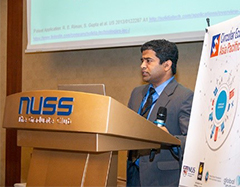 For further nurturing and creating ideas on Circular Economy, sustainability, pedagogy, and research, it is important to develop a platform for exchanging ideas. Recently, I was invited to give a lecture titled, “Design Paradigm for Manufacturing Multifunctional Materials by Using Benign Biobased Precursors” in a National Science Foundation (NSF)- sponsored conference on “Nano-Micromaterials for Circular Economy and Sustainability” at the National University of Singapore (NUSS), from August 29 to September 1, 2019. This conference was jointly organized by University of Central Florida and NUSS. An important highlight of the conference was the panel discussion titled, “Circular Economy Opportunities & Gaps." Diverse topics included redesigning materials and products, waste to resources, education and training, R&D grand challenges, international standards development, sustainable finance, new businesses, health impact, and environmental management. The lecture series was also carefully planned by organizers, professors Sudipta Seal and Seeram Ramakrishna.
For further nurturing and creating ideas on Circular Economy, sustainability, pedagogy, and research, it is important to develop a platform for exchanging ideas. Recently, I was invited to give a lecture titled, “Design Paradigm for Manufacturing Multifunctional Materials by Using Benign Biobased Precursors” in a National Science Foundation (NSF)- sponsored conference on “Nano-Micromaterials for Circular Economy and Sustainability” at the National University of Singapore (NUSS), from August 29 to September 1, 2019. This conference was jointly organized by University of Central Florida and NUSS. An important highlight of the conference was the panel discussion titled, “Circular Economy Opportunities & Gaps." Diverse topics included redesigning materials and products, waste to resources, education and training, R&D grand challenges, international standards development, sustainable finance, new businesses, health impact, and environmental management. The lecture series was also carefully planned by organizers, professors Sudipta Seal and Seeram Ramakrishna.
The discussion and lecture series were informative, frank, and helped me to understand critical challenges and best practices in this area. Some of the challenges are how to (a) involve masses in Circular Economy, (b) educate the young generation, more particularly, how to inculcate sustainability and green design in engineering curricula, and (c) accelerate the passage of innovative green manufacturing technologies in the commercial landscape. In addition, some of the best practices are: (a) promote healthy debate and discussions among all the stakeholders at various levels (students of different age groups, scientists, politicians, business interests etc.), (b) adopt a sustainable and healthy lifestyle, and (c) be adaptive and open about innovative technologies which can help us in achieving a “zero carbon society.”
It is also exciting to learn that this year’s Sigma Xi’s Annual Meeting and Student Research conference is centered on environmental changes, and its impact on societal, economic and political arenas. A workshop at the conference will focus on Circular Economy.
Photo Caption
Member Surojit Gupta presents a lecture at a National Science Foundation-sponsored Circular Economy conference.
Related Reading
- Beneficial usage of recycled polymer particulates for designing novel 3D printed composites” R. Dunnigan, J. Clemens, M. N. Cavalli, N. Kaabouch, S. Gupta, Progress in Additive Manufacturing Issue , 1-2/2018
- “Synthesis and characterization of novel polymer matrix composites reinforced with MAX phases (Ti3SiC2, Ti3AlC2, and Cr2AlC) or MoAlB by fused deposition modeling Kathryn Hall, Maharshi Dey, Caleb Matzke, Surojit Gupta, Int J Ceramic Eng Sci, 00:1–11 (2019)
- “Method of fabricating lignin based polymeric system”, US-2019-0255817-A1, Publication date 08/22/2019
-
“Synthesis and characterization of novel foams by pyrolysis of lignin”, S. Gupta, M. Dey, C. Matzke, G. Ellis, S. Javaid, K. Hall, Y. Ji, and S. Payne, TAPPI Journal January 2019.
Surojit Gupta is an associate professor of mechanical engineering at the University of North Dakota.
-
by
User Not Found
| Oct 15, 2019
Thank you for making the fifth year of Sigma Xi's Nobel Prize prediction contest, October Madness, a great success! While our top predictions for the prizes in chemistry, physics, and physiology or medicine did not go on to win Nobel Prizes, this was the fourth year that a nominee on our brackets won! That honor goes to Sigma Xi member John B. Goodenough, who won the 2019 Nobel Prize in Chemistry for aiding in the development of the lithium-ion battery.
Learn more about the significance of the development of the lithium battery in this video, and more about John Goodenough in this article.
Drawing Winner
The public sent in their nominations for our October Madness brackets before the Nobel Prizes were announced. Those who nominated someone who went on to win a 2019 Nobel Prize were entered into a drawing. Sigma Xi members had the chance to win a free year of membership dues while non-members could win a year of dues for the Sigma Xi Affiliate Circle.
The winner of this year's drawing is Sigma Xi member Konrad Bussman, who was among those who nominated John B. Goodenough for our brackets. Congratulations on winning a year of membership dues, Konrad! Watch for an email from me with more details.
What's Next
Check back here on Keyed In next summer for the 2020 edition of October Madness! You can also follow along on Sigma Xi's social media with #OctoberMadness.
A Look Back at the 2019 Edition of October Madness
Announcement of Champions
Finals
Final 4
Elite 8
Call for Nominations
Past October Madness Champions
2018
2017
2016
2015
-
by
Jamie Vernon
| Oct 15, 2019
 (Shutterstock)
(Shutterstock)
 State and local legislators across the United States are threatening science education and alarming teachers by pursuing legislation that challenges fundamental scientific concepts, such as evolution and climate science. So-called “academic freedom” bills would urge teachers to treat these topics as controversial. The seemingly innocuous proposal to teach both sides of the controversy is a familiar strategy to inject unscientific arguments in textbooks and classrooms.
State and local legislators across the United States are threatening science education and alarming teachers by pursuing legislation that challenges fundamental scientific concepts, such as evolution and climate science. So-called “academic freedom” bills would urge teachers to treat these topics as controversial. The seemingly innocuous proposal to teach both sides of the controversy is a familiar strategy to inject unscientific arguments in textbooks and classrooms.
“In 2019, a handful of legislators scattered across the country introduced more than a dozen bills that threaten the integrity of science education,” reports Glenn Branch, deputy director of the National Center for Science Education (NCSE), in Scientific American.
The NCSE website tracks bills that threaten science education. It shows that in 2019 alone, bills were introduced in Montana, Arizona, North Dakota, South Dakota, Oklahoma, Iowa, Indiana, Maine, Virginia, South Carolina, and Florida to influence how scientific topics are taught in schools.
For example:
-
In Montana: House Bill 418 sought to clarify the state’s position on climate change to include the statement “human emissions do not change atmospheric carbon dioxide emissions enough to cause climate change,” and that educational materials on climate change should state as much. It would have required the superintendent of public instruction to report on climate change curriculum in Montana’s public schools.
Status: Expired in committee
-
In North Dakota: House Bill 1538 would allow teachers to “teach strengths and weaknesses of scientific theories and controversies.” This allows a teacher to present information for and against scientific evidence, when most of the scientific community agrees there is no controversy.
Status: Withdrawn from consideration by the bill’s chief sponsor
-
In Iowa: Two bills, House File 61 and House File 428, sought to influence the state’s science standards, known as the Next Generation Science Standards, or NGSS, which Iowa adopted in 2015 to set learning expectations in grades K–12. The standards are aligned with the content and structure of the National Research Council’s Framework for K–12 Science Education. The NGSS include teaching lessons related to climate change and evolution. House File 61 would require the state’s board of education to “not adopt, approve, or require implementation of the Next Generation Science Standards,” while House File 428 would revert the standards to pre-NGSS standards.
Status: Both bills expired in committee
These types of bills are not new and none of them became law in 2019. But we have seen some become law before, such as the Louisiana Science Education Act of 2008. These bills are viewed as attacks on the integrity of the science education. Proponents for sound science standards argue that these proposals and laws must be challenged. Sigma Xi is a non-partisan organization that does not advocate for specific legislation or specific candidates. It is within our mission to advocate for the public understanding of science, and these types of bills—regardless of who introduces them—are a threat to that cause.
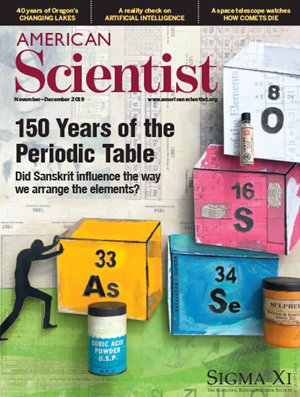 You can help teachers and students continue to have access to credible scientific information. On Giving Tuesday—December 3, 2019—Sigma Xi will hold a fundraiser to give one-year subscriptions of its award-winning magazine American Scientist to high schools in states where bills threatening science education have been introduced. The schools receive the magazines at no cost.
You can help teachers and students continue to have access to credible scientific information. On Giving Tuesday—December 3, 2019—Sigma Xi will hold a fundraiser to give one-year subscriptions of its award-winning magazine American Scientist to high schools in states where bills threatening science education have been introduced. The schools receive the magazines at no cost.
Last year, our goal was to raise $5,000 to send magazines to schools in 10 states, and support swelled to more than $15,000. That paid for subscriptions at 650 high schools in 22 states. The schools were selected by public nominations. This year, our goal is to raise $30,000 to keep the subscriptions going for all 650 high schools and to double the number of schools receiving the magazine. American Scientist is written by researchers who are working in science, technology, engineering, and math and has been a trusted STEM resource for more than 100 years.
You can give now to help start the momentum for this year’s Giving Tuesday campaign, or watch www.sigmaxi.org to give on December 3.
It is critical that our young people have enough accurate information and confidence in science to pursue research careers or to become citizens who understand and value the scientific process. They will struggle to do this without access to reliable scientific information. On December 3, we need your help to continue supporting teachers, students, and science education.
Jamie L. Vernon, PhD
Executive Director and CEO, Sigma Xi
Publisher, American Scientist
-
by
User Not Found
| Oct 03, 2019
After collecting public nominations and three rounds of voting, we're ready to announce your top predictions for the 2019 Nobel Prizes in chemistry, physics, and physiology or medicine!
Your prediction for the Nobel Prize in Chemistry is...
Jennifer Doudna, for her co-discovery of CRISPR-Cas9 genetic engineering technology.
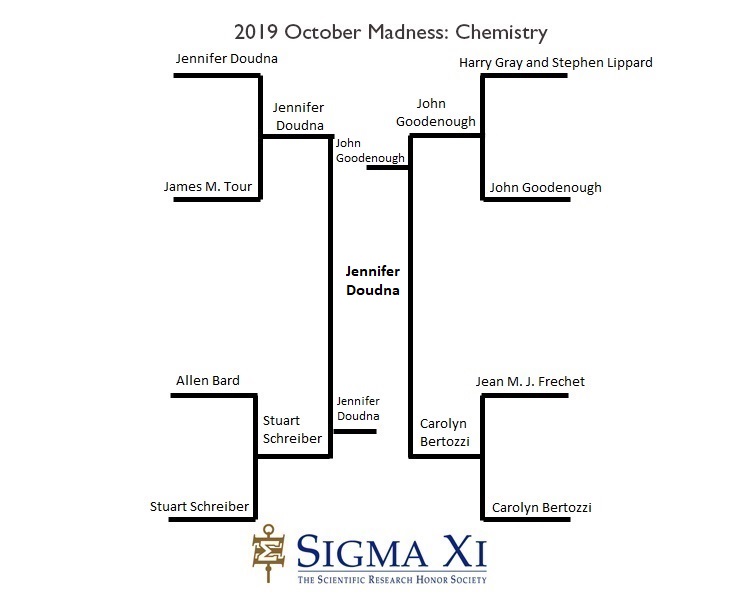
Your prediction for the Nobel Prize in Physics is...
Jocelyn Bell-Burnell, for discovery of first radio pulsars.
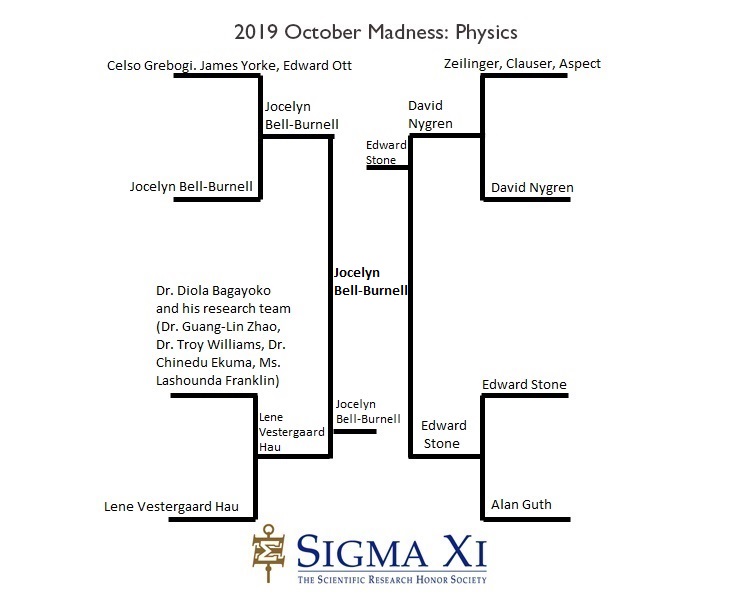
Your prediction for the Nobel Prize in Physiology or Medicine is...
Mary-Claire King, for the discovery of the “breast cancer gene.”
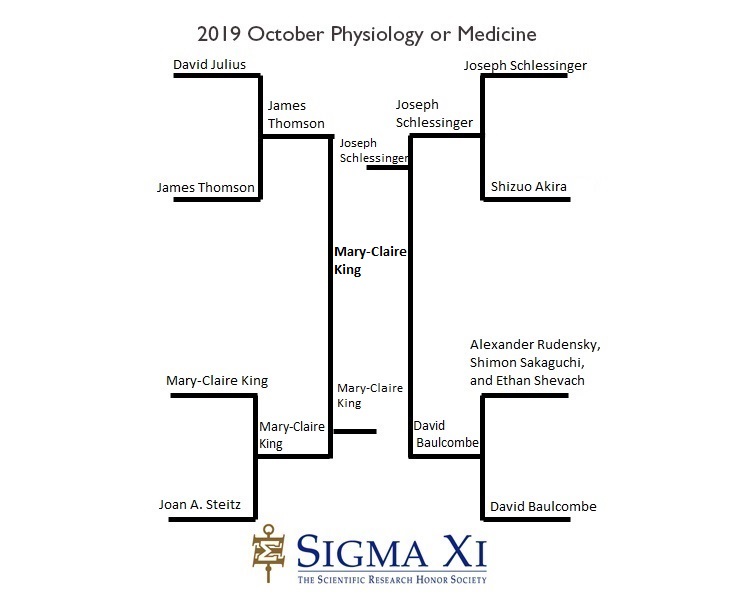
Congratulations to these researchers!
Raffle Winner
Dr. Paul Christian is the 2019 raffle winner for voting in the finals round. He wins a Sigma Xi pad-folio, Sigma Xi button, and the latest American Scientist special issue on The Future of Water.
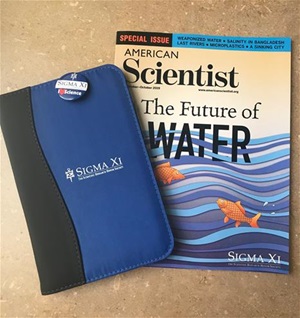
Thanks to everyone for voting!
What Happens Next
- Watch for the official Nobel Prize announcements.
The Nobel Prize in Physiology or Medicine - Monday, October 7, 11:30 a.m. at the earliest
The Nobel Prize in Physics - Tuesday, October 8, 11:45 a.m. at the earliest
The Nobel Prize in Chemistry - Wednesday, October 9, 11:45 a.m. at the earliest
The Nobel Peace Prize - Friday, October 11, 11:00 a.m.
The Sveriges Riksbank Prize in Economic Sciences in Memory of Alfred Nobel - Monday, October 14, 11:45 a.m. at the earliest
The Nobel Prize in Literature - Thursday, October 10, 1:00 p.m. at the earliest
The Swedish Academy will announce the Nobel Prize in Literature for both 2018 and 2019.
Times listed are local time in Sweden.
- See what others are predicting for this year's Nobel Prizes.
The 2019 Clarivate Analytics Citation Laureates
"Who Will Win the #ChemNobel? Predicting the 2019 Nobel Laureates in Chemistry" an American Chemical Society webinar.
- Check back here on Keyed In on October 15 to see if anyone won the prize of one year of dues for Sigma Xi membership (for current members only) or for the Sigma Xi Affiliate Circle. Those whose October Madness nominees win a Nobel Prize are eligible for the raffle.
- Take a look back on October Madness through the years:
2018 Predictions
2017 Predictions
2016 Predictions
2015 Predictions
-
by
User Not Found
| Oct 01, 2019
We're down to the finals of Sigma Xi's Nobel Prize prediction contest, October Madness! Your votes this week are more important than ever because you can help your top picks become October Madness champions! And, your votes make you eligible for a raffle to win a prize.
The prize is a Sigma Xi pad-folio, Sigma Xi button, and a copy of American Scientist's special September–October issue, "The Future of Water." If you wish to participate in the raffle, enter your name and email address on the voting forms. You may enter up to three times, once per vote in each of the three categories: Chemistry, Physics, and Physiology or Medicine.
The Prize
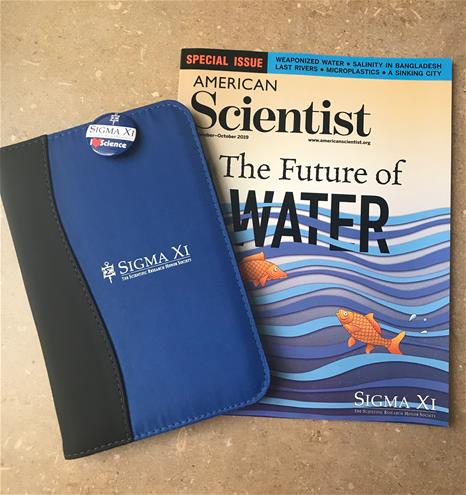
Voting Deadline
Voting is open until October 3, 2019, at 11:59 a.m. Pacific Time.
Chemistry
Who Could Win the 2019 Nobel Prize in Chemistry? Vote Now!

The final chemistry match-up is:
Jennifer Doudna, for her co-discovery of CRISPR-Cas9 genetic engineering technology
Vs.
John Goodenough, for the discovery of the Li-Co-O battery material
Physics
Who Could Win the 2019 Nobel Prize in Physics? Vote Now!
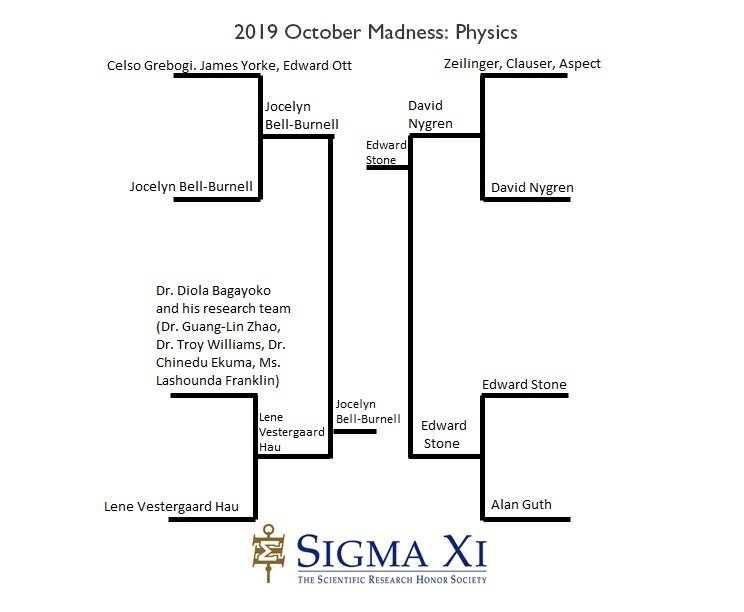
The final physics match-up is:
Edward Stone (and the Voyager team), for heading the Voyager I/II missions, which have explored all of the outer planets and are now cruising interstellar space (the first human-made objects to do so).*
Vs.
Jocelyn Bell-Burnell, for discovery of first radio pulsars
*There was a tie between Edward Stone and David Nyguen. Edward Stone advanced from having more votes than David Nyguen in the previous round.
Physiology or Medicine
Who Could Win the 2019 Nobel Prize in Physiology or Medicine? Vote Now!
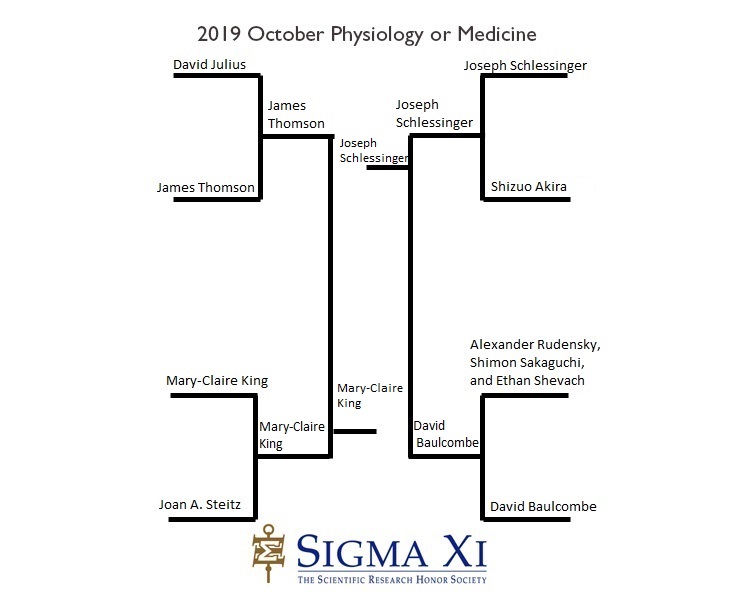
The final physiology or medicine match-up is:
Joseph Schlessinger, for working out pathways of signaling from receptor tyrosine kinases
Vs.
Mary-Claire King, for the discovery of the “breast cancer gene”
What Happens Next?
Results for the brackets and the raffle prize winner will be announced here on Keyed In and Sigma Xi's social media on October 3. Good luck!
October Madness is not affiliated with the Nobel Prize.
-
by
Jamie Vernon
| Sep 25, 2019
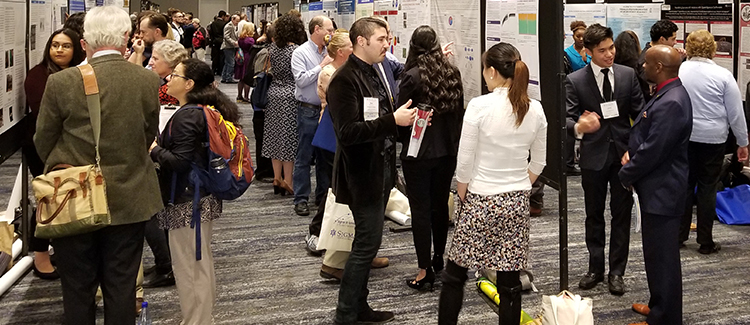
The 2018 Student Research Conference poster session featured posters from more than 10 disciplines.
I’ve just returned from a trip to south Florida for the installation of a new Sigma Xi chapter at Nova Southeastern University. Students spearheaded the effort to establish a chapter on their campus and the enthusiasm for Sigma Xi was palpable. The ceremony was well-attended by faculty and students representing multiple departments from across the university. It occurred to me that few organizations can convene individuals from such a wide range of disciplines to share in the singular mission of improving the human condition.
Recent emphasis on interdisciplinary research by funders, editors, and policymakers has ignited discussions about the challenges and opportunities of interdisciplinarity. Some have argued that interdisciplinary research suffers from structural issues related to funding and publishing as well as the narrow success metrics used by university appointment and promotion committees. All recognize that interdisciplinarity promotes integrative knowledge and innovation. This presents an opportunity for Sigma Xi's multidisciplinary membership to inspire and support interdisciplinary collaborations.
Researchers and policymakers know that interdisciplinary science can address problems that cannot be adequately resolved through a single discipline. The 2014 Research Excellence Framework (REF), which measures university research strengths in the United Kingdom, asked academics to submit research studies that had significant impact outside of academia; 80 percent of the submissions were interdisciplinary. In 2016, the U.S. National Science Foundation unveiled a set of 10 Big Ideas, which determine areas of future investment. These ideas include Growing Convergence Research (GCR) to address vexing research problems that meet societal needs. Convergence research is distinct from other forms of multidisciplinary research by intentionally bringing together intellectually diverse researchers and stakeholders from the inception to frame the research questions, develop effective ways of communicating across disciplines and sectors, and adopt common frameworks for their solution from the inception. Sigma Xi is a fitting venue to promote this type of research.
Sigma Xi has begun to mobilize our broad member representation in recent years by redesigning annual meetings to facilitate interdisciplinary discussions on the leading issues of our time: big data, STEM education, research ethics, and science communication. This year, our theme is about environmental change. We can leverage the collective expertise of the Sigma Xi community by sharing emerging research from many disciplines, encouraging collaborations, and pursuing potential solutions. You can advance this idea by coming to the Annual Meeting and Student Research Conference on November 14–17 in Madison, Wisconsin. Through September 30, you can use promo code climate10 to save 10 percent on registration.
Beyond the Annual Meeting, interdisciplinary researchers need a more welcoming place to develop their ideas, connect with collaborators, and build their careers. Sigma Xi chapters are your local melting pot for meeting fellow researchers and testing ideas. Make sure to participate and contribute to your local chapter events (find your closest chapter).
How else would you use the Sigma Xi network to address complex challenges facing humankind today? What do you think Sigma Xi should do to promote interdisciplinary research? And, on which interdisciplinary topics do you think Sigma Xi should take the lead? Please share your comments below.
Jamie L. Vernon, PhD
Executive Director and CEO, Sigma Xi
Publisher, American Scientist
-
by
User Not Found
| Sep 25, 2019
We're down to the Final 4 of Sigma Xi's Nobel Prize prediction contest, October Madness! Vote to make sure your top picks make it to the finals. Each person is eligible to cast one vote per category, for a total of three votes.
Voting is open until 11:59 p.m. Pacific Time on September 30, 2019, for the Final 4 round.
Final 4 Voting
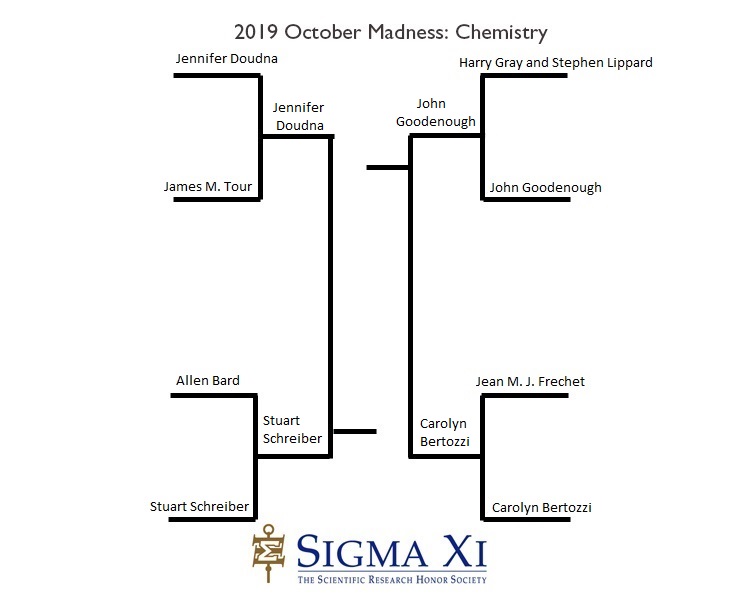
The Final 4 chemistry match-ups are:
1.
Jennifer Doudna, for her co-discovery of CRISPR-Cas9 genetic engineering technology
vs.
Stuart Schrieiber, for pioneering chemical insights into the logic of signal transduction and gene regulation that led to new therapeutics and for applications of small-molecule probes
2.
John Goodenough, for the discovery of the Li-Co-O battery material
vs.
Carolyn Bertozzi, for her work on bio orthogonal chemistry
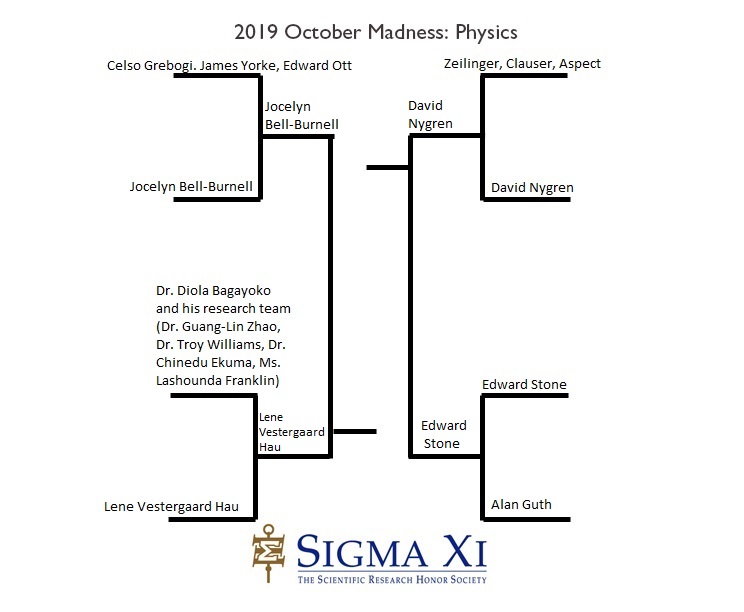
The Final 4 physics match-ups are:
1.
Jocelyn Bell-Burnell, for discovery of first radio pulsars
vs.
Lene Vestergaard Hau, for her work on slowing down and stopping light
2.
David Nguyen, for creating the Time Projection Chamber, an electronic bubble chamber, which has enabled discoveries in various fields
vs.
Edward Stone (and the Voyager team), for heading the Voyager I/II missions, which have explored all of the outer planets and are now cruising interstellar space (the first human-made objects to do so).
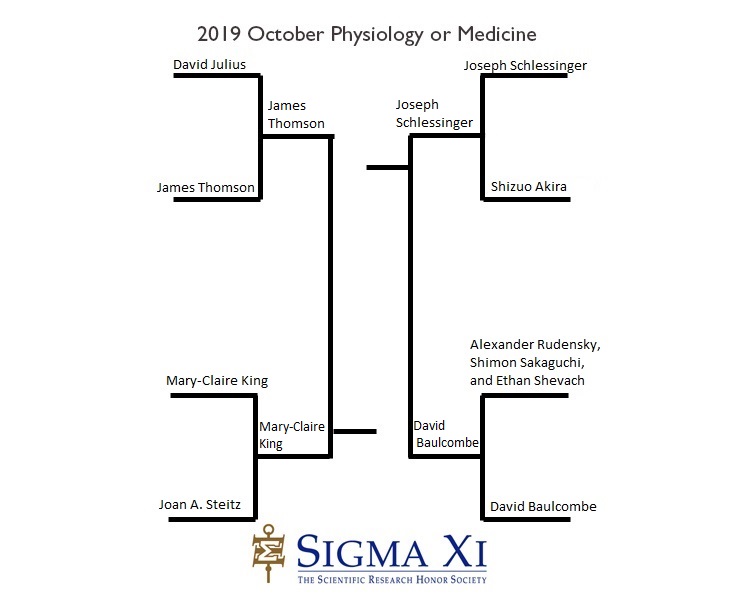
The Final 4 physiology or medicine match-ups are:
1.
James Thomson, for pioneer work in human embryonic stem cell research (1998) and induced pluripotent stem cell research
vs.
Mary-Claire King, for the discovery of the “breast cancer gene”
2.
Joseph Schlessinger, for working out pathways of signaling from receptor tyrosine kinases
vs.
David Baulcombe, for his work on small interfering RNA
-
by
User Not Found
| Sep 20, 2019
Thanks to everyone who submitted nominations for the 2019 October Madness, Sigma Xi's Nobel Prize prediction contest!
Voting is open until September 24, 2019, at 11:59 p.m. Pacific Time for the Elite 8 round.
Make sure to vote to keep your favorites in the running!
Elite 8 Voting
Chemistry
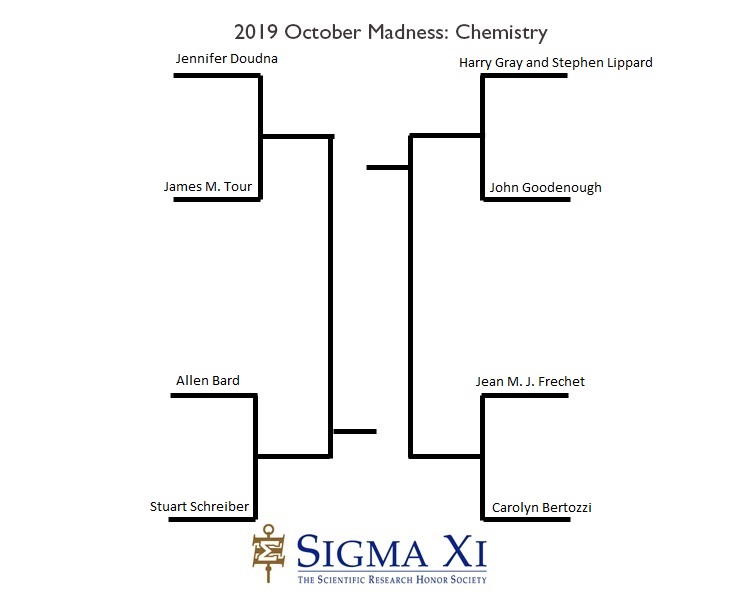
1.
Jennifer Doudna, for her co-discovery of CRISPR-Cas9 genetic engineering technology
vs.
James M. Tour, for work on molecular electronics and switching molecules
2.
Harry Gray and Stephen Lippard, for pioneering work in the field of bioinorganic chemistry
vs.
John Goodenough, for the discovery of the Li-Co-O battery material
3.
Allen Bard, for inventing the scanning electrochemical microscope
vs.
Stuart Schrieiber, for pioneering chemical insights into the logic of signal transduction and gene regulation that led to new therapeutics and for applications of small-molecule probes
4.
Jean M. J. Frechet, for pioneering simulations of the molecular dynamics of bio molecules
vs.
Carolyn Bertozzi, for her work on bio orthogonal chemistry
Physics
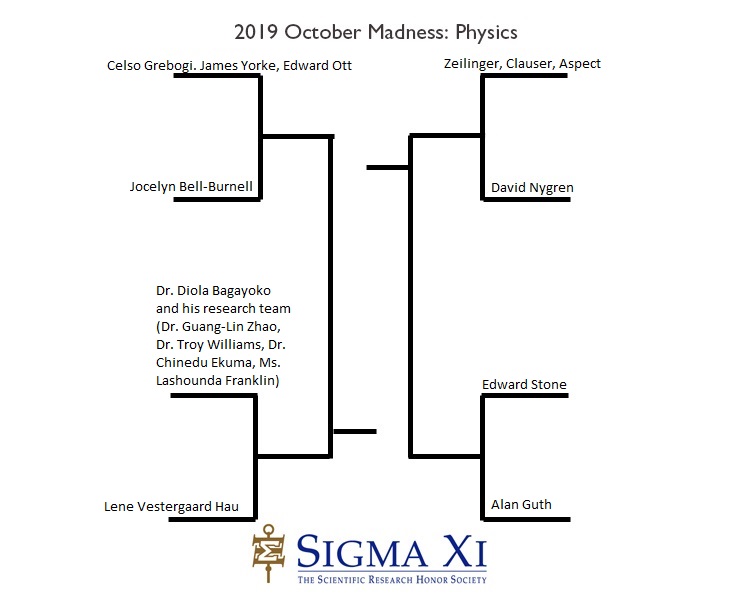
1.
Celso Grebogi. James Yorke, Edward Ott, for pioneering work on chaos and the control of chaos
vs.
Jocelyn Bell-Burnell, for discovery of first radio pulsars
2.
David Nguyen, for creating the Time Projection Chamber, an electronic bubble chamber, which has enabled discoveries in various fields
vs.
Zeilinger, Clauser, Aspect, for taking data which was loop-hole free and demonstrated that hidden variables could not be an explanation for quantum entanglement.
3.
Dr. Diola Bagayoko and his research team, for solving a more than 50-year misunderstanding and misapplication of density functional theory (DFT).
vs.
Lene Vestergaard Hau, for her work on slowing down and stopping light
4.
Edward Stone (and the Voyager team), for heading the Voyager I/II missions, which have explored all of the outer planets and are now cruising interstellar space (the first human-made objects to do so).
vs.
Alan Guth, for providing observational evidence corroborating the cosmic inflation hypothesis.
Physiology or Medicine
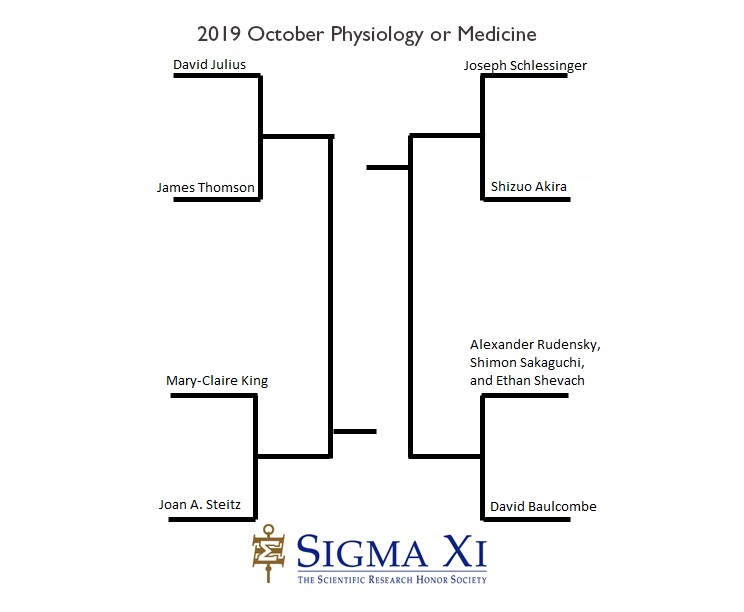
1.
David Julius, for the identification of the biophysical basis of nociception.
vs.
James Thomson, for pioneer work in human embryonic stem cell research (1998) and induced pluripotent stem cell research
2.
Joseph Schlessinger, for working out pathways of signaling from receptor tyrosine kinases
vs.
Shizuo Akira, for discoveries in the field of immunology, most significantly in the area of innate host defense mechanisms.
3.
Mary-Claire King, for the discovery of the “breast cancer gene”
vs.
Joan A. Steitz, Ffor her work on the role of snRNPs (small nuclear ribonucleoproteins) in genen splicing
4.
Alexander Rudensky, Shimon Sakaguchi, and Ethan Shevach, for their work on regulatory T cells and the function of Foxp3, a master regulator of these immune cells.
vs.
David Baulcombe, for his work on small interfering RNA
-
by
User Not Found
| Sep 11, 2019
October Madness, Sigma Xi's Nobel Prize prediction contest is back for its fifth year!
How it Works
Sigma Xi collects nominations from the public and then runs voting to advance researchers on our sports-style brackets. We hope you join in the fun as we wait for the official Nobel Prize announcements in October. But we need your nominations to get the contest kicked off! This is another way we can promote researchers and their incredible achievements.
Tell us who you think will win a prize this year! We are calling for eight nominations each for the:
How to Nominate
Anyone can nominate and vote; Sigma Xi membership is not required to participate in October Madness. Send in your nominations by 11:59 p.m. PT on September 18 by using our nomination survey or email me at lholton@sigmaxi.org.*
Please include:
-
Your nominee's name (you can submit as many nominations as you would like and you can submit a group of researchers who worked on a project together)
-
Which prize you think this person, or group, should win
-
The reason why you think the person, or group, should win (such as, "for the discovery of XYZ")
-
The institution of employment or affiliation for your nominee(s)
-
Your name and email address
How to Vote
We will announce the October Madness nominees on September 19 and open the brackets for voting on Keyed In. You can also follow along on Sigma Xi's social media accounts on Twitter, Facebook, and LinkedIn. Remember to use #OctoberMadness!
Prizes
If you nominate someone who goes on to win a Nobel Prize, you will be entered into a raffle. Raffle winners who are not Sigma Xi members, affiliates, or explorers will receive a free year in the Sigma Xi Affiliate Circle* (a $50 value), which includes a one-year subscription to American Scientist magazine. Members, affiliates, or explorers who win the raffle will have their dues paid by Sigma Xi for Fiscal Year 2020 (July 1, 2019–June 30, 2020). Those who already renewed will have their dues paid for Fiscal Year 2021. We will select one winner per prize category for a total of four winners.
Schedule
September 11–September 18: Send in your nominations
September 20: Nominees announced; Elite 8 voting begins and runs through September 24.
September 25: Elite 8 winners announced; Final 4 voting begins and runs through September 27.
September 30: Final 4 winners announced; Finals voting begins and runs through October 3.
October 3: Announcement of 2019 October Madness winners.
October 7-14: Official Nobel Prize winners named.
October 15**: Winners announced from the raffle who win a year in the Sigma Xi Affiliate Circle or a free year of dues for members, affiliates, or explorers.
*Affiliate Circle status does not qualify one for full or associate membership in Sigma Xi's nomination-based honor society.
**If Sigma Xi receives less (or more) than 8 nominations per prize, then its staff will select the nominees who are put on the bracket. But we prefer to use your nominations! Please nominate anyone you feel is worthy of the prize. Potential candidates might be found here, here, here, or here. October Madness is not affiliated with the Nobel Prize.
Example of 2018's final bracket for Physics
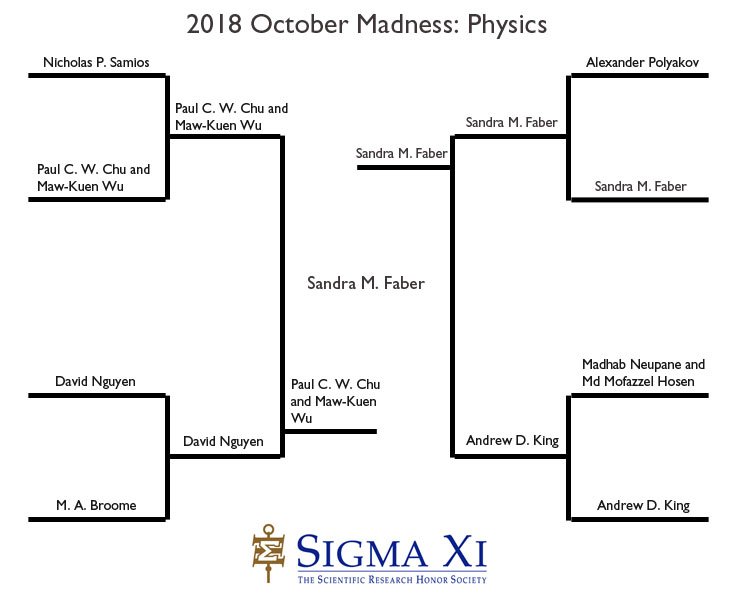
See other 2018 brackets.
Sigma Xi looks forward to receiving your nominations!
October Madness is brought to you by the following Sigma Xi staff: Lindsay Holton, member engagement coordinator; Eman Ghanem, director of membership, chapters, and programs; and Heather Thorstensen, manager of communications.
-
by
Jamie Vernon
| Aug 28, 2019
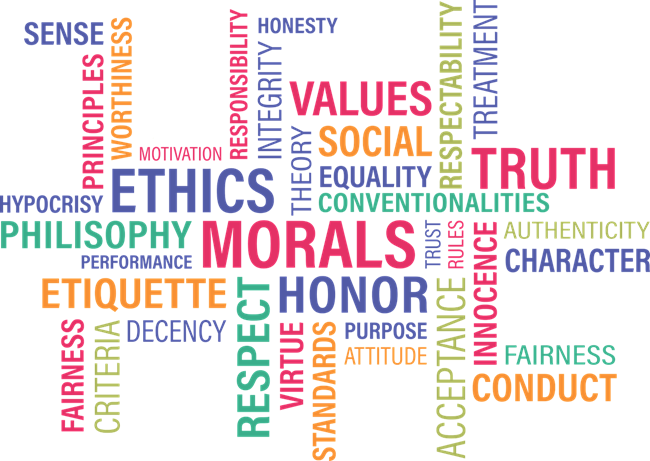
Image by Mary Pahlke from Pixabay.
This spring, Jilly Moss of southwest London was in a position that no parent ever wants to be in: at the hospital as her daughter, Alba, fought a fever with her eyes swollen shut. Alba had measles and was only 11 months old, too young to get vaccinated. In an attempt to educate other families about the importance of vaccines, Moss posted pictures on Facebook of her daughter in the hospital, covered with the disease’s signature skin rash.
“The truth is this all could have been prevented if the protection layer of older kids above Alba had been vaccinated,” Moss wrote.
Here in the United States, the American Academy of Pediatrics reports that there were 1,215 measles cases in 30 states from January 1 to August 22, 2019, the most cases in the last 27 years and since measles was eliminated in 2000. That puts the “eliminated” status of the disease at risk. Approximately 90% of this year’s cases are people who were unvaccinated.
How did we get here, when there are numerous studies showing that the measles, mumps, and rubella (MMR) vaccine is safe and effective? We’re here because a segment of the population has adopted a skeptical response to advice coming from the scientific community regarding childhood vaccination. Public challenges to scientific evidence on this and other issues, such as the causes of climate change and the safety of genetically modified crops, have led some to believe there is a general loss of trust in science. The problem is not so simple, though.
A recent study by the Pew Research Center shows that trust in scientists is rising. The poll found that the percentage of respondents who say they trust scientists at least “a fair amount” increased to 86% in 2019, up from 76% in 2016. Medical scientists are trusted to act in the best interest of the public by 87% of respondents, according to the survey. These results prompt questions about an apparent disconnection between growing public trust in science and its use in personal decision-making.
The poll reveals that politics is a factor in determining one’s confidence in scientists to inform certain decisions. Whereas 60% of respondents say scientists should take an active role in policy debates, Democrats, at 54%, are more inclined than Republicans, at 34%, to value the opinions of scientific experts on policy matters. On this issue, Sigma Xi, a non-partisan organization, has little influence.
However, there are aspects of the Pew survey that directly fall within the purview of the Society. The poll found that African Americans and Hispanics, for example, expressed more concern than whites about professional or research misconduct by medical researchers. It is believed that these results may be related to historical cases of misconduct involving lack of consent, such as the Tuskegee syphilis study and the case of Henrietta Lacks. Blacks and Hispanics are also more likely than whites to describe the misconduct of nutrition and environmental research scientists to be a big problem, indicating a higher tendency to question researchers. There is an opportunity to bridge this divide by building trusted relationships in these communities.
The survey indicates that public perception of scientific integrity is linked to transparency and accountability, regardless of racial background. Only 19% of all respondents felt that researchers across six fields were transparent about potential conflicts of interest, and less than 20% of respondents say that scientists admit wrongdoing most or all of the time. On the positive side, people who are more familiar with scientists and their work express more trusting views of the scientific community. The data suggest that by increasing transparency, accountability, and familiarity scientists could further improve public trust in science and, perhaps, increase its use in decision-making.
Now more than ever, organizations like Sigma Xi have a role to play in building public confidence in science. In addition to pledging to “maintain honor, integrity and honesty in all scientific activities,” Sigma Xi members have a unique platform to demonstrate attributes that can strengthen public trust and to cultivate similar qualities within our junior colleagues and students. Sigma Xi chapters are leading the way by organizing professional ethics discussions at their institutions, whether they are based on a college campus, at a government lab, or in an industry setting. Individual members are advancing these principles at their places of employment by posing questions when others appear to be overlooking ethical matters, encouraging ethics conversations with their colleagues and supervisors, and publicly speaking about what they are doing to ensure that the public’s concerns are being considered.
Similarly, the Sigma Xi Board of Directors has approved the establishment of the Committee on Scientific Conduct and Professional Ethics. This committee will help determine the most effective way to promote ethical research practices among our members and within the broader research enterprise. We are actively seeking volunteers to be a part of this important work. Sigma Xi members may contact executiveoffice@sigmaxi.org to learn more about volunteering on the committee.
Do you have ideas about how researchers can build trust with the public? Please comment below.
Jamie L. Vernon, PhD
Executive Director and CEO, Sigma Xi
Publisher, American Scientist
Links
1. Americans say open access to data and independent review inspire more trust in research findings. From the Pew Research Center
2. America's relationship with scientists? It's complicated. From The Washington Post.
3. Americans trust scientists, until politics get in the way. From Wired.
-
by
User Not Found
| Aug 12, 2019
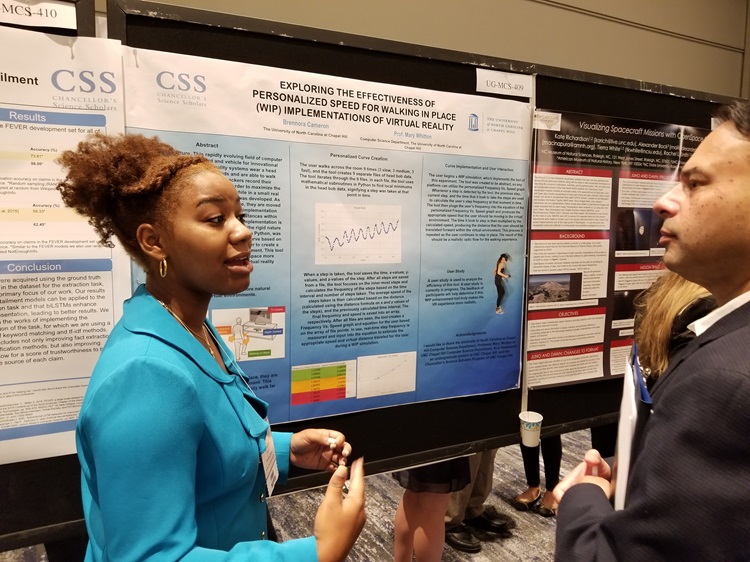
A student presents her poster during the 2018 Sigma Xi Annual Meeting and Student Research Conference.
Sigma Xi members in The Lab online community recently shared the following advice for students giving their first research poster presentation.
"If you’re asked a question and don’t know the answer, slowly take a breath and think about the question. You can always say, 'Well I am not sure but I think…' This response has stimulated a lot of positive conversations and debates where I learned a lot."
—Jennifer Carr, Wenham, Massachusetts
"The American Astronomical Society (AAS), of which I am a full member, has recently given the option for its members to present digital iPosters* instead of traditional posters at their conferences. You create a web-based template for an electronic poster that is displayed on large interactive touchscreens at the meetings. Visitors can enlarge images on screen and play accompanying videos. The iPosters can be downloaded by anyone who is interested."
—Robert Elowitz, Beaver Creek, Ohio
"My advice to students giving presentations: Know your material and practice in front of friends and other students."
—Robert Buntrock, Orono, Maine
"The most important function of conferences is to provide informal contact among the participants. The most important sessions are the coffee breaks, meals, and other social events. Next are the poster sessions, when you can have serious discussions with the few participants who are really interested in your work. Be present at your poster throughout the poster session. Be proactive: Buttonhole each passerby, and give them a two-minute 'elevator talk' highlighting your most important result and its significance. If the participant is really interested, continue with a more detailed conversation. If your lab can afford it, print the poster on cloth rather than poster board. This allows the poster to be folded without degradation and carried in your backpack."
—Raymond Boxman, Tel-Aviv, Israel
"I have judged student poster competitions in my discipline society. It is not always made clear that a poster is not a consolation prize (to not giving a talk) and certainly not a regurgitation of a journal article, but rather it’s a chance to graphically and succinctly express a story of your research. Type should be large enough to read comfortably from a meter or two away and text should be minimized to emphasize/underline points. White space is valuable to the esthetic and approachability. For viewers who want to be reminded of what you said, provide a link to a PDF or a page-sized printout of the poster along with your card or contact information so someone passing by can contact you for more details if you are not there at the time."
—Gail Kampmeier, Savoy, Illinois
* Editor’s note: Electronic posters will be an option for poster presenters at the 2019 Sigma Xi Annual Meeting and Student Research Conference, November 14–17, 2019, in Madison, Wisconsin.
Active Sigma Xi members can access The Lab for more conversations at community.sigmaxi.org.
What's Your Advice?
Do you have advice to add about poster presentations? Please comment below.
-
by
User Not Found
| Jul 29, 2019
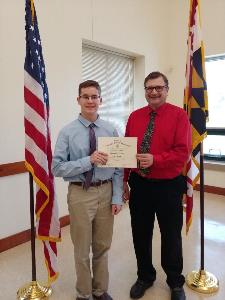
When Jayce Turner receives his high school diploma next year, he will wear the Sigma Xi blue and white graduation cords around his neck, a sign of support from the world’s largest scientific and engineering research honor society.
Sigma Xi’s Chesapeake Chapter recognized Turner this year for his outstanding performance as a science student at the Highlands School in Bel Air, Maryland, which educates children with dyslexia, attention- deficit/hyperactivity disorder (ADHD), and other language-based learning differences. The chapter has a tradition of inviting all high schools in Harford County to pick a science student for recognition during their junior year, which provides time for the students to list the honor on their college applications. Fifteen schools participated this year. Each school receives a plaque to display with the names of their honored students, and the students receive a certificate of recognition and Sigma Xi graduation cords.
“The chapter hopes the honor encourages the students to continue their STEM (science, technology, engineering, and mathematics) education and become active members in the greater STEM community once they have graduated from college,” said Michael DeZearn, chapter secretary.
Turner’s learning differences include ADHD, anxiety, and a writing challenge called dysgraphia. As a young child, he loved nature and could name almost any butterfly species, said his mom, Cheryn Turner. He plans to study environmental science in college and then pursue a career in that field.
“Getting the recognition definitely means a lot to me,” Turner said, “as it shows that a lot of the hard work I did in school paid off. I have always enjoyed science, so I am honored to be recognized by Sigma Xi.”
What programs do you know of that support students in science, engineering, technology, and math (STEM)? Please share in the comments below.
Photo caption: Jayce Turner receives a certificate of recognition as an outstanding science student from Sigma Xi Chesapeake Chapter President Michael Simini.
-
by
Jamie Vernon
| Jul 16, 2019

 As scientists and engineers, we tend to already be a group of quick learners, creative thinkers, and persistent problem solvers, but there is something else that can make each of us a more valuable and effective researcher: leadership skills. Researchers with strong leadership skills can understand the technical aspects of their job and motivate team members, strategize, advance projects, and stick to a budget. In today’s competitive job market, acquiring leadership skills can also facilitate promotions, salary increases, and new career options.
As scientists and engineers, we tend to already be a group of quick learners, creative thinkers, and persistent problem solvers, but there is something else that can make each of us a more valuable and effective researcher: leadership skills. Researchers with strong leadership skills can understand the technical aspects of their job and motivate team members, strategize, advance projects, and stick to a budget. In today’s competitive job market, acquiring leadership skills can also facilitate promotions, salary increases, and new career options.
Leadership skills are important no matter how long you’ve been in research.
-
High school and undergraduate students: You are a leader of your own time, and need to take responsibility for completing the steps necessary to finish projects.
-
Graduate students: You are managing research projects, working in teams, sharing your results, and seeking research mentors. Some of you will teach and lead lesson plans for students.
-
Postdocs: You must take ownership of projects, establish collaborations, seek funding opportunities, and lead teams.
-
Professors and More Professional Career Paths: You are leading projects, teams, and labs; motivating and educating your team members; and communicating your research findings.
Picking one or two of the following leadership skills to develop will be a solid start in making you a more competitive and productive researcher.
-
Communication: One of the most important things I’ve learned about leadership is that communication is key. Leaders must be able to clearly articulate their goals and expectations to their teams and stakeholders, be open to feedback, recognize the team for successes, and reassure them in failure.
-
Building relationships: Relationships are about building trust with others so that you have a network that you can use to give and receive support and knowledge. Strong relationships help you work better in teams and find opportunities such as jobs, funding, and mentorship. The biggest challenge for me in developing leadership skills was not having a mentor who had followed a similar career path to mine—exiting academia, taking a fellowship in government, and ultimately joining the nonprofit sector. Try to find a mentor who can help you.
-
Strategic thinking: I don’t recall anyone offering training in strategic thinking when I was working in academia, but having a plan in place that defines goals; approaches that you will take to reach those goals; time-bound, measurable objectives that define the desired outcomes; and the tools that you will use to do it all ensures that your team knows your expectations and the plan to get where you need to go.
-
Project management: I was inspired to read articles about how to be a more effective project manager when I took a fellowship position in the federal government as a policy analyst. I realized how inefficiently I had managed my research projects the day that I learned about Gantt charts. I’ve also learned that delegation is a necessary part of good project management. To not delegate elicits frustration and self-doubt in team members with specialized skills. Thankfully, new tools abound for keeping our projects on track. I’m currently testing a digital platform called Basecamp. Other platforms are specifically designed for research projects. I recommend that all researchers acquire some formal project management training and I am planning to offer leadership training opportunities to Sigma Xi members.
-
Time management: In academia, I had very little formal training on time management but it’s a critical skill to being efficient and effective in any workplace.
-
Financial discipline: Knowing where to find funding, how to stay within restrictive budgets, and what is required for reporting will help you get the next budget approved.
What helped you develop your leadership skills? Please share your resources, struggles, and successes in the comments below.
Sincerely,
Jamie L. Vernon, PhD
Executive Director and CEO, Sigma Xi
Publisher, American Scientist
-
by
Jamie Vernon
| Jun 18, 2019
Sigma Xi Speaks, June 2019

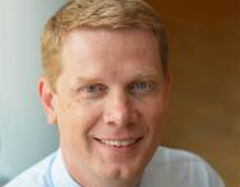 I wish each person reading this could be in Ashland, Oregon, with me today. I’m here for the AAAS–Pacific Division Annual Meeting, where Sigma Xi’s Director of Membership, Chapters, and Programs Eman Ghanem will give a talk about what scientific societies can do for researchers. I’m posting the key talking points on Sigma Xi's blog because the honor of your nomination to Sigma Xi membership is just the beginning of what Sigma Xi can do for you.
I wish each person reading this could be in Ashland, Oregon, with me today. I’m here for the AAAS–Pacific Division Annual Meeting, where Sigma Xi’s Director of Membership, Chapters, and Programs Eman Ghanem will give a talk about what scientific societies can do for researchers. I’m posting the key talking points on Sigma Xi's blog because the honor of your nomination to Sigma Xi membership is just the beginning of what Sigma Xi can do for you.
Keep in mind these three things.
1. Acceleration
Sigma Xi accelerates your career progression by giving you the tools to keep moving forward. The Society gives you access to a STEM-focused job board, career fairs, and a network of scientists and engineers to learn from, representing a range of disciplines and different stages of their careers. This network is held together primarily by Sigma Xi chapters, the online member communities, and the online member directory. You can find a mentor (or sign up to become one), meet new people in your area, get advice, and gain new ideas.
Research funding is another career acceleration tool. In Fiscal Year 2019, the Grants in Aid of Research program awarded $225,000 to 240 undergraduate and graduate students for their research.
We also offer you the chance to gain leadership experience for your CV and professional growth. You can become one of our 580 chapter officers, join a chapter committee, or run for a Society-wide elected position.
2. Amplification
Sigma Xi amplifies your scientific message. You’re already doing great research; we help you get your message where you want it to go. You can submit your work to be shaped by our skilled editors for publication in American Scientist (no magazine writing experience required). Likewise, high school students who are associate members can submit their research for publication in Chronicle of The New Researcher. We recognize members with awards, Distinguished Lecturer positions, and invitations to present posters or lead sessions at the Sigma Xi Annual Meeting. And, we invite you to tell staff about your research accomplishments so we can share them on social media.
3. Association
Through Sigma Xi, you become associated with a community of people who share your professional goals, whether your main focus is conducting science or engineering with integrity, supporting students, or helping the public connect with research. Our events bring researchers together for barbecues, banquets, March for Science, solar eclipses, science holidays, lab tours, conferences, judging at science fairs, and reviewing grant applications. Sigma Xi also gives members a chance to do outreach with the public, from helping Girl Scouts earn STEM badges and starting Sigma Xi clubs for K–12 students to hosting public science talks.
If you have questions about what Sigma Xi can do for you, please reach out to memberinfo@sigmaxi.org.
Sincerely,
Jamie L. Vernon, PhD
Executive Director and CEO, Sigma Xi
Publisher, American Scientist
-
by
Jamie Vernon
| May 21, 2019
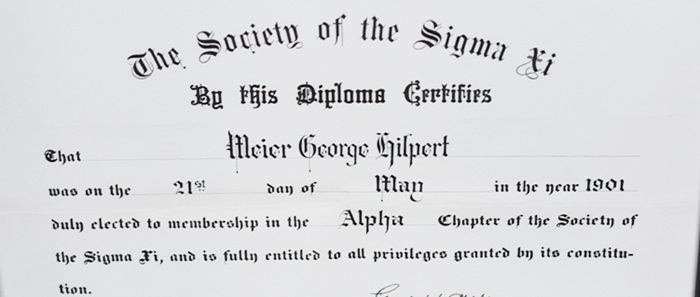
Shown above is the Sigma Xi membership certificate of Meier Hilpert from 1901. Sigma Xi has recognized excellence in research for 133 years.
 As an honor society, Sigma Xi welcomes scientists and engineers as new members to recognize their excellence, or their potential to conduct excellent research. But, how should we define research excellence? And, what’s the point?
As an honor society, Sigma Xi welcomes scientists and engineers as new members to recognize their excellence, or their potential to conduct excellent research. But, how should we define research excellence? And, what’s the point?
I can tell you that Sigma Xi does not exist so that researchers can puff out their chests and claim their superiority over others—far from it. In fact, for the last 133 years the Society has had one goal: to improve the human condition through research and innovation. We do this by: 1) supporting the health of the research enterprise, 2) promoting integrity in science and engineering, and 3) fostering the public understanding of science. Being a Sigma Xi member means that you work toward a better world for the good of all people, that you conduct research in an ethical way, and that you help your neighbors learn how research helps them.
Generation after generation has had to respond to what’s going on around them to carry the torch. Now it’s our turn, and the flame will not burn out on our watch. The current state of affairs, however, involves a seemingly growing number of people who question scientific objectivity and challenge scientific conclusions. One cannot underestimate the harm caused by the persistent perception that researchers operate within an “ivory tower,” rarely mingling with the non-scientific community, and are only concerned about their next scientific publication or grant. Overcoming this stereotype is critical to reconnecting with the primary beneficiaries of scientific and engineering research, that being the general public.
What we are facing, fundamentally, is a challenge of trust. Without the public’s trust, the work we do is discounted, marginalized, ignored, or underfunded. We must avoid a scenario in which science becomes inconsequential. We must actively put a face on research to which people can relate.
I have concluded that our definition of an “excellent” scientist or engineer must expand. Excellence may no longer be narrowly defined by breakthroughs in the laboratory; it is important to consider efforts to deliver the broader impacts of research.
Today, excellence in research communications is integral, not ancillary, to what it means to be an excellent researcher. The privilege to conduct scientific research is due in large part to investments made by the public. We owe it to them to share the promise and reality of our research endeavors. I believe Sigma Xi can and should provide leadership to vastly increase the opportunities for researchers to be strong research communicators.
Sigma Xi can be a leader in preserving public trust in research. Our history of promoting ethical research uniquely positions us to lead the way in helping the research community apply the same ethics and integrity to the way we communicate research.
A year ago, my colleague Fenella Saunders, editor-in-chief of American Scientist, and I were part of the organizing committee for the Kavli Foundation’s Symposium on Science Communication. This symposium focused on how scientists who engage with the public directly—often through blogs or social media—can employ journalistic values that build trust with the public, in order to more successfully communicate with non-scientists. You can read the report.
Each Sigma Xi member has a part to play in building public trust through ethical and effective communication. If you’re already a member of Sigma Xi, I encourage you to write op-eds, speak at a local event, or volunteer in a capacity that allows you to tell the public about research. If you’re not sure how to start, contact me at executiveoffice@sigmaxi.org. While we seek to establish online training opportunities, you will find communications workshops and educational sessions at the Sigma Xi Annual Meeting and Student Research Conference. If you want to join our cause as a member, affiliate, or as a grade K–12 explorer, contact membership@sigmaxi.org and find out how you can help.
Excellence isn’t limited to winning a Nobel Prize or getting a large grant. It’s about what you do for your community to build public trust in research in order to help change the world.
Sincerely,

Jamie L. Vernon, PhD
Executive Director and CEO, Sigma Xi
Publisher, American Scientist
-
by
Sigma Xi Staff
| May 15, 2019
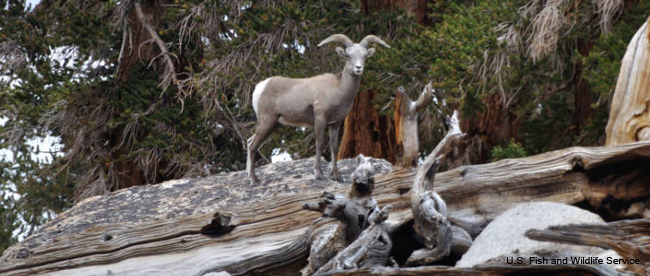
Sierra Nevada bighorn sheep have been listed as endangered under the U.S. Endangered Species Act since 2000. (U.S. Fish and Wildlife Service)
Last week, a report from the United Nations gave precise detail about how nature and its critical contributions to people are deteriorating worldwide, that human action has caused more species than ever before to be threatened with extinction, and that we need to make big changes now to reverse the trends.
“The Global Assessment Report is an alarm bell that we need to do more to conserve the planet,” said Jamie Vernon, executive director and CEO of Sigma Xi, The Scientific Research Honor Society. “We won’t be able to pass a healthy ecosystem on to future generations at the current rate. Sigma Xi stands behind scientific evidence, such as this report, being used to inform policy-makers for the public good.”
The report comes from the Intergovernmental Science-Policy Platform on Biodiversity and Ecosystems Services (IPBES). The IPBES is an independent, intergovernmental body comprised of more than 130 UN-member governments. The role of IPBES is to provide policymakers with objective scientific assessments. A summary of their new Global Assessment Report on Biodiversity and Ecosystem Services had an optimistic tone that the future for biodiversity on the planet could improve, but it also painted a bleak picture of the present, and stated system-wide reorganization is needed, both locally and globally.
10 Key Findings from the Report
- Approximately 1 million animal and plant species are threatened with extinction, more than ever before in human history. Many species could be gone within decades.
- The five direct drivers of changes in nature with the largest relative global impacts are, in descending order:
- Changes in land and sea use
- Direct exploitation of organisms
- Climate change
- Pollution
- Invasive alien species
- Three-quarters of the land-based environment and approximately 66% of the marine environment have been significantly changed by humans.
- More than one-third of the world’s land and nearly 75% of freshwater are devoted to growing crops and producing livestock.
- Plastic pollution has increased tenfold since 1980. Three-hundred to 400 million tons of heavy metals, solvents, toxic sludge, and other wastes from industrial facilities are dumped annually into the world’s waters.
- Negative trends in nature will continue to 2050 and beyond in all of the policy scenarios explored in the report that don’t include transformative change.
- Most of the Aichi Biodiversity Targets for 2020 are likely to be missed, which are goals related to protecting biodiversity and increasing public awareness of why biodiversity matters.
- On average, global sea levels have risen more than 3 millimeters per year over the past 20 years.
- Greenhouse gas emissions have increased by 100% since 1980.
- Forty percent of the global population lacks access to clean and safe drinking water.
IPBES has released the report's Summary for Policymakers. The full report will be published later this year.
Source: The United Nations Sustainable Development Goals blog
Sigma Xi has devoted its 2019 Annual Meeting and Student Research Conference to the theme of Our Changing Global Environment: Scientists and Engineers Designing Solutions for the Future. Symposia on November 15–16, 2019, in Madison, Wisconsin, will explore issues related to energy, life and health, and water. Learn more at www.sigmaxi.org/amsrc19.
-
by
User Not Found
| Mar 11, 2019
In response to the partial United States government shutdown earlier this year, Sigma Xi called for members to send in stories about how the shutdown was affecting them and others in the research community.
A Sigma Xi member serving as an application reviewer for the National Science Foundation’s (NSF) Graduate Research Fellowship Program raised concerns that the program’s review process won’t be carried out as intended, the announcement of who will receive a fellowship may be delayed, and reviewers won’t be compensated for their time as usual.
The program recruits high-potential, early-career scientists and engineers and provides three years of financial support within a five-year fellowship period— a $34,000 annual stipend to the Fellow and a $12,000 cost-of-education allowance to the graduate institution. That support is for graduate study that leads to a research-based master’s or doctoral degree in a STEM field. NSF especially encourages women, members of underrepresented minority groups, persons with disabilities, veterans, and undergraduate seniors to apply.
The member writes:
The recent federal shutdown has severely impacted the NSF Graduate Research Fellowship Program (GRFP). I know because I am a reviewer this year. Here is how the reviewer program is supposed to work.
-
We receive applications in December.
-
We review the applications by ourselves and submit the reviews online.
-
Afterward, submitting our initial reviews, we meet in two four-hour video conferences, compare reviews when a candidate is judged differently by different reviewers, and then normalize our standards so that that judging is as uniform as possible. This is a very important step to keep the quality of the program. This requires reviewers to schedule their calendar and not accept assignments on those days.
This year I realized that there could be a shutdown so I downloaded all of my assigned applications. I then judged all of my assignments. It took me maybe 30 hours to complete my assignment. As soon as the shutdown was finished, I uploaded all of my reviews, hoping for the conference call.
Unfortunately, NSF decided to cancel Step 3. Step 3 is vital for the program. It helps set a uniform standard for judging. It maintains the quality of the program. Sometimes, a reviewer misses an important characteristic of a candidate. The online meeting enables us to make sure that the best candidates are awarded fellowships.
The results of NSF’s actions are three-fold.
-
This year judging will be very random. It is not clear that candidates will get even three qualified reviewers to assure their application will be treated fairly or that qualified personnel will evaluate the candidates.
-
The review submission deadline has been extended to March 17. Announcements of the fellowships are too late. The advantages of getting a fellowship for entrance into graduate school are delayed and may be even too late for admission.
-
Reviewers are not getting any compensation. Even though the burden of time of reviewers is reading the applications, they will not be paid. The reason is that NSF only pays for the video meetings and will not pay for the really hard work of reading the applications.
Read more member stories about the government shutdown in Sigma Xi's letter to Congress and President Donald Trump.
Update from 4/11/2019: The 2019 Graduate Research Fellowship Program selections for Fellow candidates and Honorable mentions have been announced.
-
by
Jamie Vernon
| Feb 05, 2019
Sigma Xi Speaks, February 2019
 Our nation has just emerged from the longest federal government shutdown in its history. Regardless of the political circumstances that led to the appropriations gap, shutdowns have negative impacts on science in the following ways.
Our nation has just emerged from the longest federal government shutdown in its history. Regardless of the political circumstances that led to the appropriations gap, shutdowns have negative impacts on science in the following ways.
-
Shutdowns often imperil research that is linked to seasonal cycles by preventing scientists who work for government research agencies or who rely on government funding to collect data during the closure.
-
Nongovernmental research institutions and contractors that rely on services from federal agencies find themselves unable to operate effectively or at all.
-
Government instability drives good scientists and engineers away from the federally supported research enterprise, where basic and applied sciences contribute to global economic competitiveness for all nations.
We know that many Sigma Xi members were impacted by the recent shutdown. At least five percent of Sigma Xi members work directly in government agencies and the vast majority of Sigma Xi members rely on government funding and services to conduct their research.
During the shutdown, many of you shared your experiences with us. One of these stories exemplified the challenges facing many of our scientific colleagues. The daughter of a Sigma Xi member, who surely followed in her father’s scientific footsteps, applied for a position on a research project funded by the National Science Foundation. An avian ecologist, she needed to relocate far from her family to conduct her research. Her work requires her to gather data on migratory birds and is highly sensitive to seasonal time points. Due to the shutdown, not only was she not being paid, but she was unable to collect the data for her study. She resorted to driving for Uber and babysitting to pay her rent instead of doing science. Like many scientists, she has made sacrifices to position herself for a research career. Sadly, her research is now in jeopardy and her future remains uncertain.
Science is not a job that can be turned on and off like a switch. Disrupting science creates both short- and long-term problems. We need our elected officials to know this. Therefore, Sigma Xi is sending a letter to Congress and the White House to encourage them to do what is necessary to avoid another shutdown.
Please feel free to share your stories with us. We will include them in an effort to protect federally supported research and the scientists who do this work from similar interruptions in the future.
Sincerely,

Jamie L. Vernon, PhD
Executive Director and CEO, Sigma Xi
Publisher, American Scientist
-
by
Jamie Vernon
| Dec 20, 2018
Sigma Xi Speaks, December 2018
 Now that the naughty and nice lists have been finalized, it’s time to take stock of our year in science and engineering. Although some are on the naughty list for imperiling scientific integrity and challenging ethical boundaries, we can be grateful that the nice list has grown exponentially faster.
Now that the naughty and nice lists have been finalized, it’s time to take stock of our year in science and engineering. Although some are on the naughty list for imperiling scientific integrity and challenging ethical boundaries, we can be grateful that the nice list has grown exponentially faster.
This year, scientists and engineers worldwide continued to advance human knowledge and strengthen our society.
-
As part of the IceCube collaboration, researchers successfully identified a distant blazar as the likely source of a neutrino that was detected by sensors placed beneath the South Pole, launching a new era for multi-messenger astronomy.
-
Viviane Slon, a postdoc at the Max Planck Institute in Leipzig, and colleagues determined through genetic analysis that Neanderthals and Denisovans lived together and produced healthy offspring. This revelation will qualitatively transform our understanding of the relationships among our ancient relatives.
-
A team of scientists from the University of California, Los Angeles, and the California Institute of Technology developed a method for rapid, unambiguous structure determination of organic compounds, potentially accelerating the speed of drug discovery.
These scientific triumphs are just a sample of the 2018 achievements that we can all celebrate.
Sigma Xi members also celebrated prominent achievements this year. For example:
-
The Royal Swedish Academy of Sciences awarded half of the 2018 Nobel Prize in Physics to Sigma Xi member Arthur Ashkin and gave the Sveriges Riksbank Prize in Economic Sciences to member William D. Nordhaus.
-
May Berenbaum was appointed editor-in-chief of the Proceedings of the National Academy of Sciences.
-
Seven members represented half of the new cohort of professors at the Howard Hughes Medical Institute: Julia Clarke, Robert Full, Paul Barber, Elizabeth Hadly, Margaret McFall-Ngai, Robert Wayne, and Keivan Stassun.
-
And many more!
As the New Year arrives, we can expect additional science and engineering breakthroughs, many of which will be led by Sigma Xi members and covered in American Scientist magazine. Thanks to the generosity of Sigma Xi members and friends, like you, we’re thrilled to announce that we are sending free subscriptions of American Scientist to 650 high schools across the United States. This gift of science will enrich future scientists and engineers and ensure that the nice list will be filled with the next generation of researchers for many years to come.
Happy Holidays!
Sincerely,
Jamie L. Vernon, PhD
Executive Director and CEO
Sigma Xi, The Scientific Research Honor Society
Publisher of American Scientist
-
by
Jamie Vernon
| Nov 28, 2018

I’d like to take a moment to reflect on an observation I made at this year’s Annual Meeting and Student Research Conference. The meeting, which occurred in San Francisco, was the best attended conference in nearly a decade. The presentations were fascinating, the enthusiasm for Sigma Xi was high and the momentum from the meeting continues to propel us toward another successful year.
During the conference, I spoke with Dr. Virginia Trimble, a gifted astronomer and longtime member of the Society, about a necklace she wore that was adorned by a golden Sigma Xi key that once belonged to her father, an accomplished chemist and member of the Society. It was apparent that it was deeply meaningful to her and it symbolized the pride we all share through our association with Sigma Xi.
During the early days of the Society (late 1800s to early 1900s), induction into Sigma Xi was often accompanied by the presentation of a gold key. Etched on the back of the key was the name of the inductee, the year, and the chapter to which they belonged. The key was often attached like a charm to a chain that held a pocket watch or a brooch, which was the style of the day. Accessorizing with a Sigma Xi key and many additional charms was a way of touting one’s social or scientific status.
Today, the presentation of a physical key upon induction is less common. However, the honor associated with holding the proverbial Sigma Xi key endures. Bestowing the key upon a deserving student or colleague can be personally rewarding because it is your way of recognizing their contributions or potential to contribute to the research enterprise.
Acceptance of the key comes with a responsibility to uphold the values of the Society and connects the inductee to a scientific legacy that includes some of the most influential scientists of our time: Albert Einstein, Gerty Cori, Linus Pauling, Julian Lewis, Rita Levi-Montalcini, Sally Ride, and countless more.
In recognition of this distinguished legacy, I invite members to extend the honor of membership and the key of Sigma Xi to all who embody the qualities we seek in our fellow companions, including dedication to research excellence and integrity.
Jamie L. Vernon is the executive director and CEO of Sigma Xi, The Scientific Research Honor Society, founded at Cornell University in 1886 and currently based in Research Triangle Park, North Carolina, USA. He is also publisher of American Scientist.
-
by
User Not Found
| Oct 05, 2018
Thank you for following along with the fourth year of Sigma Xi's Nobel Prize prediction contest, October Madness! This is the third year that a nominee on our brackets won a prize. It was James P. Allison who, along with Tasuku Honjo, won the 2018 Nobel Prize in Physiology or Medicine. Both Allison and Honjo were on the October Madness bracket in 2017 and Allison was on this year's bracket. Allison and Honjo were selected for the prize for their discovery of cancer therapy by inhibition of negative immune regulation.
And, while he wasn't on our brackets, we were happy to see that Sigma Xi member Arthur Ashkin was selected to receive the 2018 Nobel Prize in Physics, along with Gerard Mourou and Donna Strickland for their groundbreaking inventions in the field of laser physics. Congratulations to all of the 2018 Nobel Prize laureates.
Drawing Winner
Nominations for the October Madness brackets were submitted before the Nobel Prizes were announced. Those who nominated someone who went on to win a 2018 Nobel Prize were entered into a drawing. Sigma Xi members had the chance to win a free year of membership dues while non-members could win a year of dues for the Sigma Xi Affiliate Circle.
The winner of this year's drawing is Sigma Xi member Jianxuan Zou, who nominated James P. Allison for our brackets. Congratulations on winning a year of membership dues, Jianxuan! Watch for an email from me with more details.
What's Next
Check back here on Keyed In next summer for the 2019 edition of October Madness! You can also follow along on Sigma Xi's social media with #OctoberMadness.
A Look Back at the 2018 Edition of October Madness
Announcement of Champions
Finals Round
Final 4 Round
Elite 8 Round
Call for Nominations
Heather Thorstensen is the manager of communications for Sigma Xi, The Scientific Research Honor Society.
-
by
User Not Found
| Sep 25, 2018
After collecting public nominations and three rounds of voting, we're ready to announce your top predictions for the 2018 Nobel Prizes in chemistry, physics, and physiology or medicine!
Your prediction for the Nobel Prize in Chemistry is...
Stuart L. Schreiber for pioneering chemical insights into the logic of signal transduction and gene regulation that led to new therapeutics and for applications of small-molecule probes.
Schreiber is the Morris Loeb Professor of Chemistry and Chemical Biology at Harvard University, a Howard Hughes Medical Institute investigator, and a founding core member of the Broad Institute.
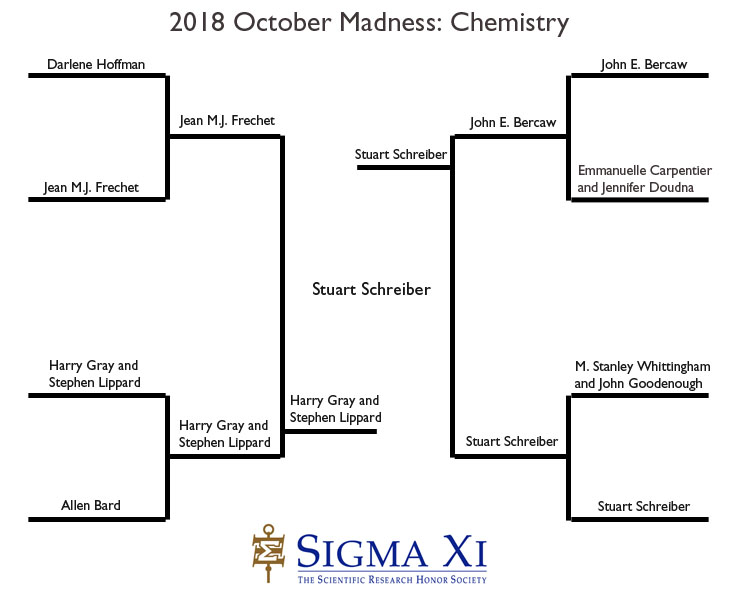
Your prediction for the Nobel Prize in Physics is...
Sandra M. Faber for leadership in numerous path-breaking studies of extra-galactic astronomy and galaxy formation.
Faber is a Sigma Xi member and professor emerita of astronomy and astrophysics at University of California, Santa Cruz.

Your prediction for the Nobel Prize in Physiology or Medicine is...
Joseph Vacanti, Robert Langer, and Anthony Atala for the discovery of regenerative medicine (tissue engineering,) and perfecting of related inventions.
Vacanti is a surgeon–scientist in the field of pediatric surgery and transplantation surgery for Massachusetts General Hospital and Harvard Medical School.
Langer is a Sigma Xi member and an Institute Professor in Massachusetts Institute of Technology's Department of Chemical Engineering.
Atala is the director of the Wake Forest Institute for Regenerative Medicine, and the W.H. Boyce Professor and Chair of the Department of Urology at Wake Forest University.
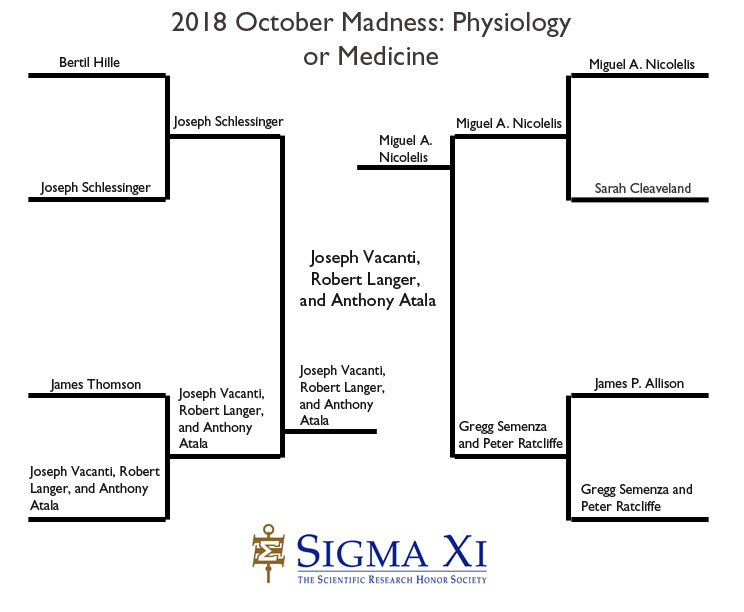
Congratulations to these researchers!
Raffle Winner
Winifred Creamer is the 2018 raffle winner for voting in the finals round. She wins an American Scientist candy-filled mug, Sigma Xi button, and the latest American Scientist issue.
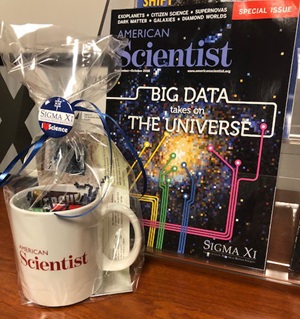
Thanks to everyone for voting!
What Happens Next
- Watch for the official Nobel Prize announcements.
The Nobel Prize in Physiology or Medicine - Monday, October 1, 11:30 a.m. at the earliest
The Nobel Prize in Physics - Tuesday, October 2, 11:45 a.m. at the earliest
The Nobel Prize in Chemistry - Wednesday, October 3, 11:45 a.m. at the earliest
The Nobel Peace Prize - Friday, October 5, 11:00 a.m.
The Sveriges Riksbank Prize in Economic Sciences in Memory of Alfred Nobel - Monday, October 8, 11:45 a.m. at the earliest
The Nobel Prize in Literature - The Swedish Academy has decided to postpone the 2018 Nobel Prize in Literature, with the intention of awarding it in 2019.
Times listed are local time in Sweden.
- See what others are predicting for this year's Nobel Prizes.
The 2018 Clarivate Analytics Citation Laureates
"2018 Nobel Prize Predictions," via Everyday Scientist
"Who Will Win the #ChemNobel? Predicting the 2018 Nobel Laureate(s) in Chemistry," an American Chemical Society webinar on September 27.
- Check back here on Keyed In on October 5 to see if anyone won the prize of one year of dues for Sigma Xi membership (for current members only) or for the Sigma Xi Affiliate Circle. Those whose October Madness nominees win a Nobel Prize are eligible for the raffle.
- Take a look back on October Madness through the years:
2017 Predictions
2016 Predictions
2015 Predictions
-
by
User Not Found
| Sep 18, 2018

We're down to the finals of Sigma Xi's Nobel Prize prediction contest, October Madness! Your votes this week are more important than ever because you can help your top picks become October Madness champions! And, your votes make you eligible for a raffle to win a prize.
The prize is a candy-filled American Scientist mug, Sigma Xi button, and a copy of American Scientist's special September–October issue, "Big Data Takes on the Universe." If you wish to participate in the raffle, enter your name and email address on the voting forms. You may enter up to three times, once per vote in each of the three categories: Chemistry, Physics, and Physiology or Medicine.
The Prize
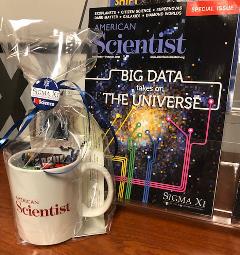
Voting Deadline
Voting is open until September 23, 2018, at 11:59 p.m. Pacific Time.
Chemistry
Who Could Win the 2018 Nobel Prize in Chemistry? Vote Now!
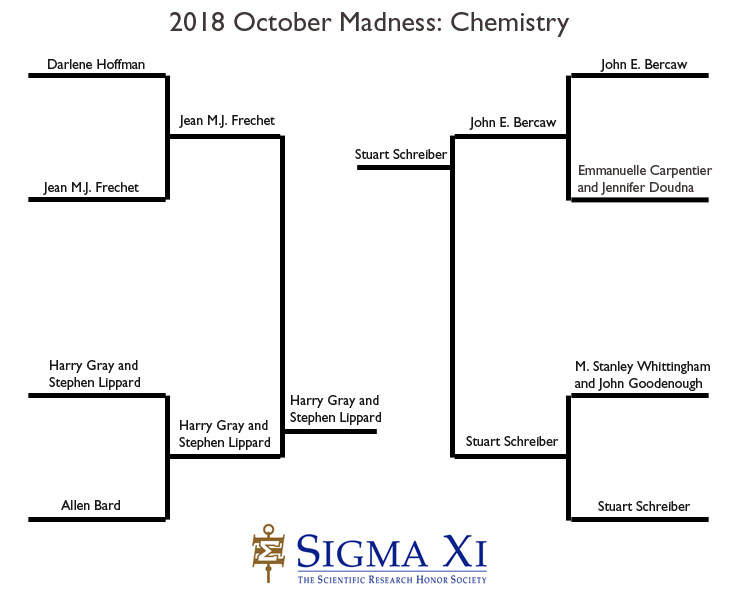
The final chemistry match-up is:
Harry Gray and Stephen Lippard for pioneering work in the field of bioinorganic chemistry
Vs.
Stuart Schreiber for pioneering chemical insights into the logic of signal transduction and gene regulation that led to new therapeutics and for applications of small-molecule probes
Physics
Who Could Win the 2018 Nobel Prize in Physics? Vote Now!
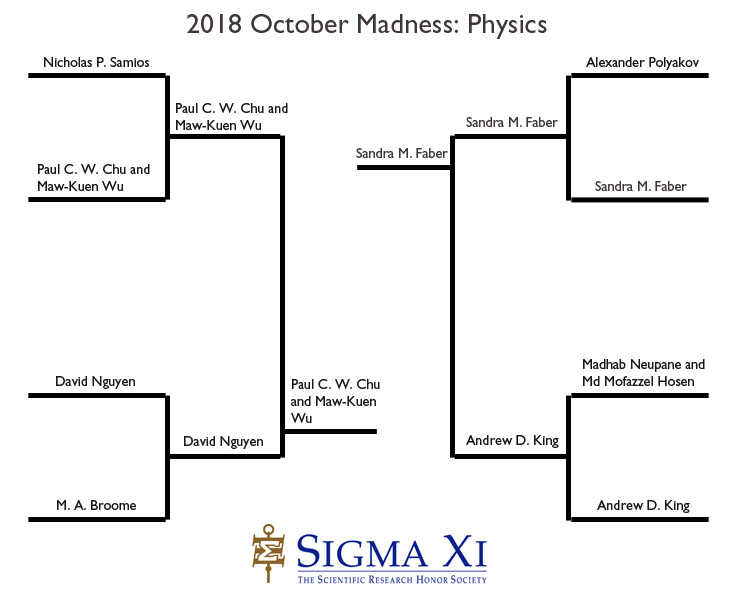
The final physics match-up is:
Paul C.W. Chu and Maw-Kuen Wu, for discovery of superconductivity in yttrium barium copper oxide and similar compounds above the boiling point of nitrogen
Vs.
Sandra M. Faber, for leadership innumerous path-breaking studies of extra-galactic astronomy and galaxy formation
Physiology or Medicine
Who Could Win the 2018 Nobel Prize in Physiology or Medicine? Vote Now!
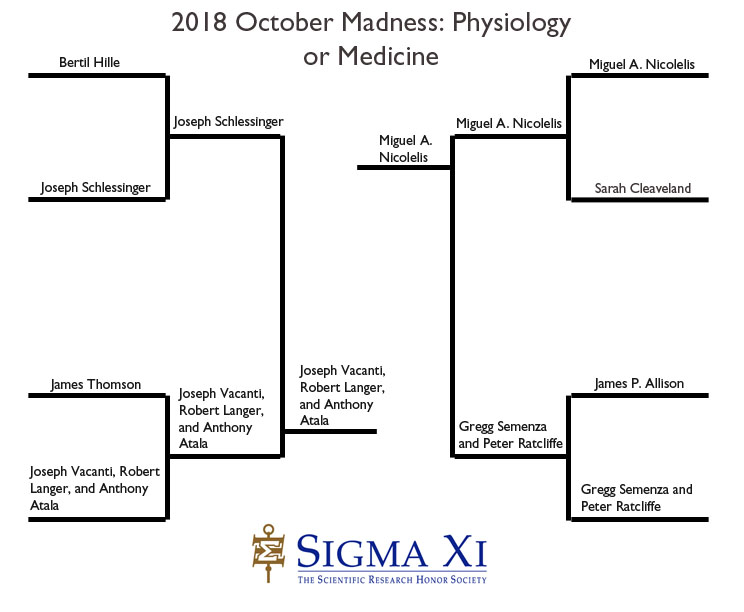
The final physiology or medicine match-up is:
Joseph Vacanti, Robert Langer, and Anthony Atala for the discovery of regenerative medicine (tissue engineering,) and perfecting of related inventions
Vs.
Miguel A. Nicolelis for pioneering work in the interpretation of neuron signals leading to the development of brain–machine interface technology
What Happens Next?
Results for the brackets and the raffle prize winner will be announced here on Keyed In and Sigma Xi's social media on September 25. Good luck!
October Madness is not affiliated with the Nobel Prize.
Heather Thorstensen is manager of communications for Sigma Xi, The Scientific Research Honor Society.
-
by
User Not Found
| Sep 11, 2018
We're down to the Final 4 of Sigma Xi's Nobel Prize prediction contest, October Madness! Vote to make sure your top picks make it to the finals. Each person is eligible to cast one vote per category, for a total of three votes.
Voting is open until 11:59 p.m. Pacific Time on September 16, 2018, for the Final 4 round.
Final 4 Voting
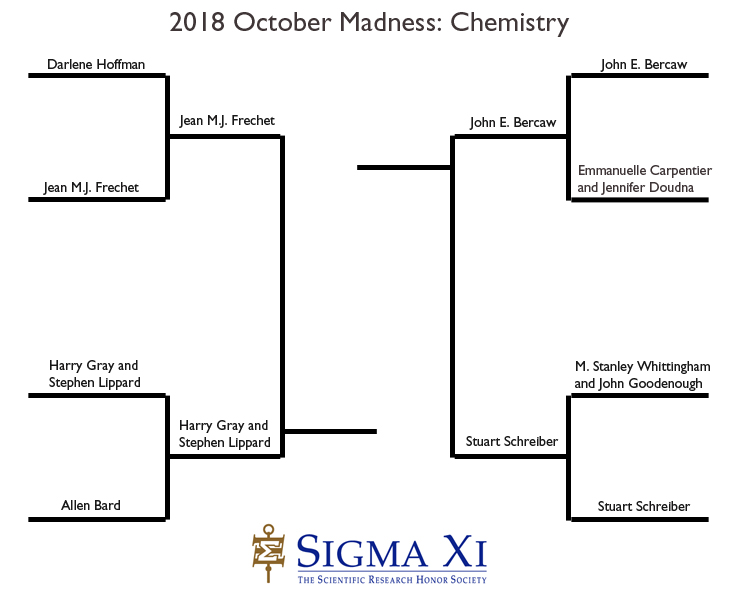
The Final 4 chemistry match-ups are:
1.
Jean M. J. Frechet, for pioneering simulations of the molecular dynamics of biomolecules
vs.
Harry Gray and Stephen Lippard, for pioneering work in the field of bioinorganic chemistry
2.
John E. Bercaw, for contributions in pioneering C-H functionalization
vs.
Stuart Schreiber, for pioneering chemical insights into the logic of signal transduction and gene regulation that led to new therapeutics and for applications of small-molecule probes
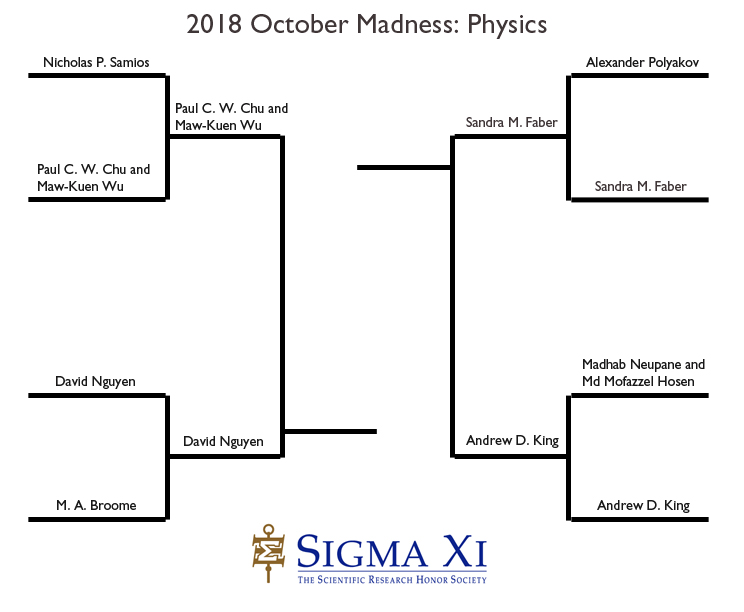
The Final 4 physics match-ups are:
1.
Paul C. W. Chu and Maw-Kuen Wu, for discovery of superconductivity in yttrium barium copper oxide and similar compounds above the boiling point of nitrogen
vs.
David Nguyen, for creating the Time Projection Chamber, an electronic bubble chamber, which has enabled discoveries in various fields
2.
Sandra M. Faber, for leadership in numerous path-breaking studies of extra-galactic astronomy and galaxy formation
vs.
Andrew D. King, for the discovery of quantum simulator enabling research into newly discovered exotic phases of matter
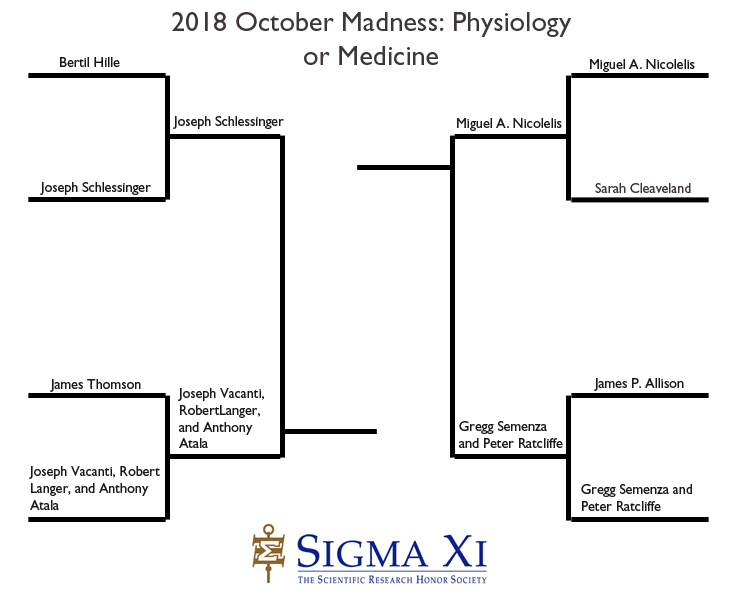
The Final 4 physiology or medicine match-ups are:
1.
Joseph Schlessinger, for working out pathways of signaling from receptor tyrosine kinases
vs.
Joseph Vacanti, Robert Langer, and Anthony Atala, for the discovery of regenerative medicine (tissue engineering,) and perfecting of related inventions
2.
Miguel A. Nicolelis, for pioneering work in the interpretation of neuron signals leading to the development of brain–machine interface technology
vs.
Gregg Semenza and Peter Ratcliffe, for the discovery of the oxygen homeostasis system (the HIFS and the PHDs)
*A tie in the Elite 8 round's physics match-up of Madhab Neupane and Md Mofazzel Hosen vs. Andrew D. King was broken by coin toss, resulting in Andrew D. King advancing to the Final 4.
-
by
User Not Found
| Sep 06, 2018
Thanks to everyone who submitted nominations for the 2018 October Madness, Sigma Xi's Nobel Prize prediction contest!
Voting is open until September 9, 2018, at 11:59 p.m. Pacific Time for the Elite 8 round. UPDATE: To collect more input on the physics bracket, voting for the physics category has been extended to 9 a.m. Pacific Time/Noon Eastern on September 11, 2018.
Make sure to vote to keep your favorites in the running!
Elite 8 Voting
Chemistry
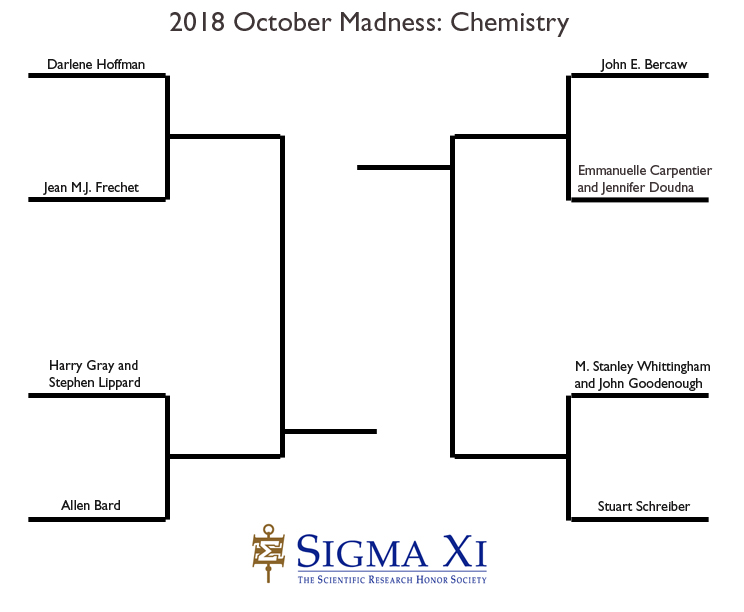
Physics
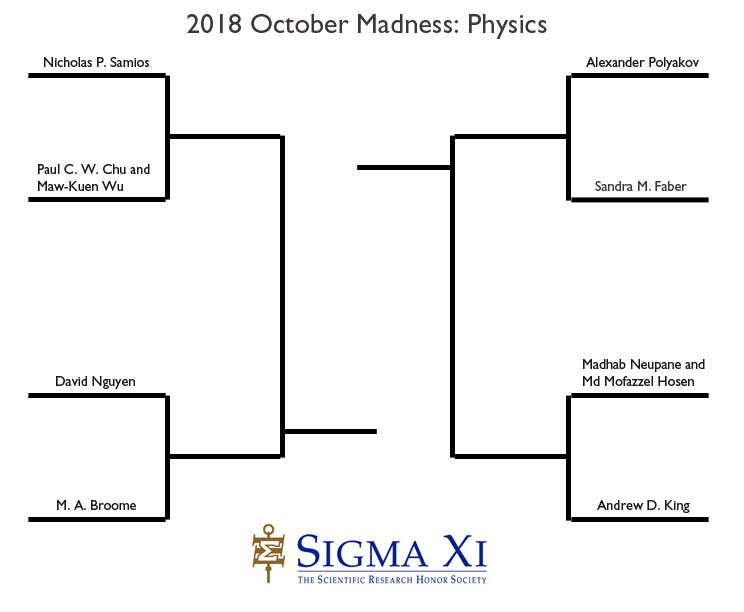
Physiology or Medicine
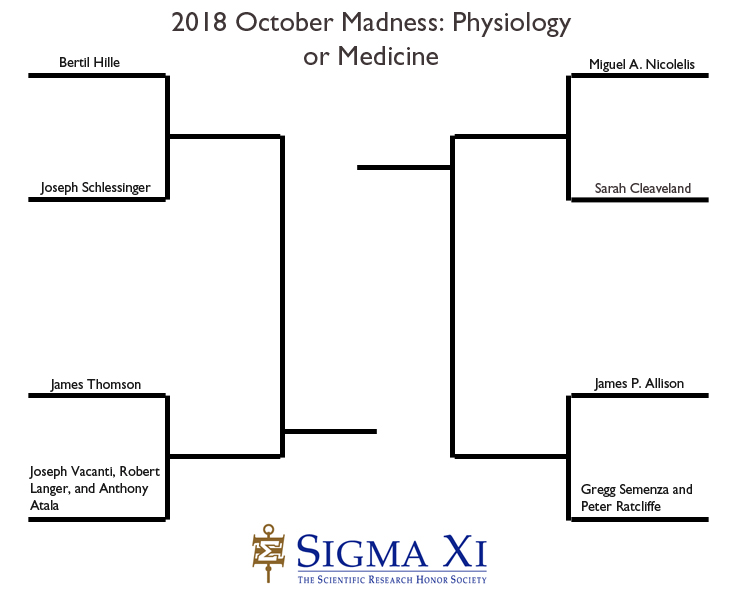
-
by
Jamie Vernon
| Sep 04, 2018

Sigma Xi members, affiliates, and explorers worldwide have a singular opportunity each year to come together as companions in scientific and engineering research. This year, thanks to the vision of the program committee, the Annual Meeting agenda has expanded from primarily Society business to include more dynamic programming designed to be both personally enriching and professionally beneficial.
A convention of Sigma Xi members is a uniquely noteworthy event. Where else would you have an opportunity to share your work face-to-face with such a high-caliber group of scientists and engineers except under the auspices of a Sigma Xi meeting? We are also boosting registration of non-members who wish to connect with Sigma Xi and participate in the remarkable program. What new insights will be gleaned from conversing with our colleagues from diverse research backgrounds?
Sigma Xi is making these changes for you, and we need your feedback to determine whether we’re getting it right. Our goal is to produce an Annual Meeting and Student Research Conference that prepares you for the changing research environment. We’ll make it happen by addressing issues that affect you. After all, this is your meeting, as a distinguished researcher, student, or science supporter, irrespective of your field. It’s a time to make useful connections, discover new ideas, and encounter different perspectives
The 2018 meeting will be held October 25–28 at the Hyatt Regency San Francisco Airport hotel in California. This year’s theme has implications for all research disciplines: Big Data and the Future of Research. Speakers will discuss research that uses large data sets, known as big data. We will demonstrate how big data is changing science and engineering, and how researchers are responding to these changes.
The agenda includes:
-
Plenary speakers, such as Jeff Dean, Google’s head of artificial intelligence
-
Big data symposia on physics, astronomy, biology, medicine, energy, climate, and the environment
-
Professional development sessions
-
Science communication and policy sessions
-
Ethical conduct of research sessions
We will also host science entertainment:
Please review the agenda and let us know:
-
Do you like what you see on tap for the Annual Meeting?
-
If so, register to attend
-
If not, what would you like to see next year?
-
Is this a conference model that you find valuable?
-
Would you like to help organize the 2019 meeting?
Send your feedback to executiveoffice@sigmaxi.org.
Please plan to join us in Silicon Valley this October to enjoy this meeting and provide feedback for future meetings.

Jamie L. Vernon, PhD
Executive Director and CEO
Sigma Xi, The Scientific Research Honor Society
Publisher of American Scientist
-
by
User Not Found
| Aug 24, 2018
October Madness, Sigma Xi's Nobel Prize prediction contest is back for its fourth year!
How it Works
Sigma Xi collects nominations from participants and then runs weekly voting to advance researchers on our sports-style brackets. We hope you join in the fun as we wait for the official Nobel Prize announcements in October. But we need your nominations to get the contest kicked off! This is another way we can promote researchers and their incredible achievements.
We are calling for 8 nominations each for the:
How to Nominate
Anyone can nominate and vote; Sigma Xi membership is not required to participate in October Madness. Send in your nominations by 11:59 p.m. PDT on September 4 by using our nomination survey or email me at hthorstensen@sigmaxi.org.*
Please include:
-
Your nominee's name (you can submit as many nominations as you would like and you can submit a group of researchers who worked on a project together)
-
Which prize you think this person, or group, should win
-
The reason why you think the person, or group, should win (such as, "for the discovery of XYZ")
-
The institution of employment or affiliation for your nominee(s)
-
Your name and email address
How to Vote
We will announce the October Madness nominees on September 6 and open the brackets for voting on Keyed In. You can also follow along on Sigma Xi's social media accounts on Twitter, Facebook, and LinkedIn. Remember to use #OctoberMadness!
Prizes
If you nominate someone who goes on to win a Nobel Prize, you will be entered into a raffle. Raffle winners who are not Sigma Xi members, affiliates, or explorers will receive a free year in the Sigma Xi Affiliate Circle* (a $50 value), which includes a one-year subscription to American Scientist magazine. Members, affiliates, or explorers who win the raffle will have their dues paid by Sigma Xi for 2018–19. Those who already renewed will have their dues paid for 2019–20. We will select one winner per prize category for a total of four winners.
Schedule
August 25–September 4: Send in your nominations
September 6: Nominees announced; Elite 8 voting begins and runs through September 9.
September 11: Elite 8 winners announced; Final 4 voting begins and runs through September 16.
September 18: Final 4 winners announced; Finals voting begins and runs through September 23.
September 25: Announcement of 2018 October Madness Winners.
October 1–8: Official Nobel Prize winners named.
October 5**: Winners announced from the raffle who win a year in the Sigma Xi Affiliate Circle or a free year of dues for members, affiliates, or explorers.
*Affiliate Circle status does not qualify one for full or associate membership in Sigma Xi's nomination-based honor society.
**If Sigma Xi receives less (or more) than 8 nominations per prize, then its staff will select the nominees who are put on the bracket. But we prefer to use your nominations! Please nominate anyone you feel is worthy of the prize. Potential candidates might be found here, here, here, or here. October Madness is not affiliated with the Nobel Prize.
Example of last year's final bracket for Chemistry
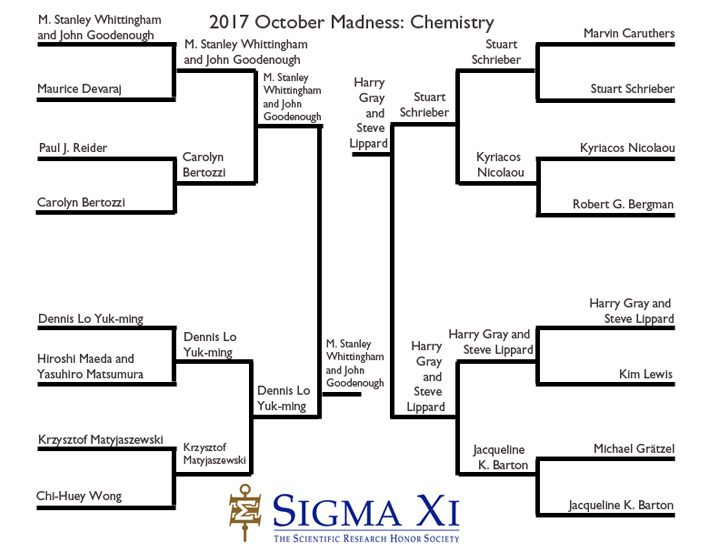
See other 2017 brackets.
Sigma Xi looks forward to receiving your nominations!
October Madness is brought to you by the following Sigma Xi staff: Rachel Livingston, member engagement coordinator; Eman Ghanem, director of membership, chapters, and programs; and Heather Thorstensen, manager of communications.
-
by
Jamie Vernon
| May 15, 2018
Sigma Xi Speaks, May 2018
Sigma Xi members, affiliates, and explorers discuss critical issues in science as part of the Society’s Quarterly Conversations initiative.

It’s not an accident that artificial intelligence is experiencing a surge in its ability to solve global problems. Just five years ago, analysts estimated that the world generated approximately 4.4 zettabytes of data. Today they’re predicting that by 2020 we’ll be producing as much as 44 zettabytes annually. That’s 44 trillion gigabytes. As this information has become available, data scientists have developed tools to extract insights from it. These tools are rapidly replacing the people who once served as the gatekeepers to new discoveries.
How will the new data frontier ultimately affect scientists? Some claim that science may soon be dominated not by people but instead by computers. Even the revered practice of observation and prediction—core elements in the scientific process and once the domain of the lone genius—is being challenged. With the right software and ever-cheaper hardware, even a non-expert in the field can identify cause and effect relationships within large data sets. We’re beginning to see the impact of these efforts in every area of research.
The Google Brain Team, part of Google’s Artificial Intelligence Division, is using machines to tackle a major public health issue: cardiovascular diseases. They developed an algorithm that can predict a person’s risk of a heart attack or stroke with similar accuracy as other risk-determining calculators. However, rather than requiring a blood draw to measure cholesterol, as other risk-determining calculators do, the Brain Team’s procedure uses computer vision to process pictures of patients’ retinas, a noninvasive technique.
Similarly, big data will soon change the face of astronomy. In an effort to accelerate astronomical discoveries, engineers have built the mother of all telescopes, called the Large Synoptic Survey Telescope, or LSST. The LSST will be equipped with a massive, three-ton digital camera that will be able to cover the entire southern sky in just three days. It will generate petabytes of data that will be immediately distributed around the world for instant analysis.
In the past, astronomers were lucky to reserve a few nights worth of observations on one of the few high-powered telescopes in the world. This process, if well planned and efficiently executed, could allow the astronomer to observe a few dozen or a few hundred objects. In contrast, the LSST is expected to identify 20 billion galaxies and 17 billion stars in its first decade of operation. Artificial intelligence will play a major role in identifying these objects, thereby changing the relationship between the scientists and their data.
Although we understand how big data is already changing how research is being done, there are many questions to be answered about how we can respond to these changes. There is a need for in-depth conversations about the ethics of data collection, analysis, usage, how we will communicate discoveries when the process is largely computer-driven, and how the current scientific infrastructure system will need to adapt to accommodate big data-based research initiatives.
This October, Sigma Xi will host its Annual Meeting and Student Research Conference in Burlingame, California. The theme of the meeting is Big Data and the Future of Research. Attendees will discuss the opportunities and challenges facing scientists as we advance toward a big data-driven scientific enterprise. We hope you’ll register to join us and bring your colleagues and students. They'll also need to know how the future of science is changing.
We’re expecting that our featured speakers, including Jeff Dean, senior fellow and head of Artificial Intelligence at Google, and Steve Ritz, subsystem scientist for the LSST camera, will stimulate lively conversations that all scientists will want to be a part of.
There’s no reason to wait, though. You can dive right into this conversation, as it will be the topic of our fourth quarterly conversation in Sigma Xi’s online member community, The Lab. You can also discuss big data in your Sigma Xi chapter, or send your thoughts to executiveoffice@sigmaxi.org.
Sincerely,

Jamie L. Vernon, PhD
Executive Director and CEO
Sigma Xi, The Scientific Research Honor Society
Publisher of American Scientist
-
by
Jamie Vernon
| Mar 20, 2018
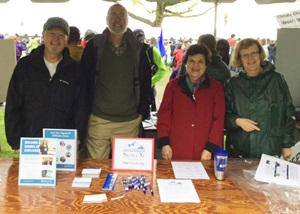 In 25 days, thousands of people will don science-y t-shirts and create clever signs to take to the streets and show their support for a topic we all deeply care about: science. For a second consecutive year, the March for Science is scheduled to take place in townships and villages around the world, mostly on April 14. The nonpartisan message once again will be to promote “robustly funded and publicly communicated science as a pillar of human freedom and prosperity.” We’re already hearing that Sigma Xi members and chapters worldwide are joining the cause.
In 25 days, thousands of people will don science-y t-shirts and create clever signs to take to the streets and show their support for a topic we all deeply care about: science. For a second consecutive year, the March for Science is scheduled to take place in townships and villages around the world, mostly on April 14. The nonpartisan message once again will be to promote “robustly funded and publicly communicated science as a pillar of human freedom and prosperity.” We’re already hearing that Sigma Xi members and chapters worldwide are joining the cause.
The March for Science represents a rare opportunity for scientists and non-scientists to come together to celebrate the benefits of scientific research. For organizations like Sigma Xi, there is no comparable demonstration of public support for our mission than this event. Sigma Xi members are committed to improving the human condition through science and engineering. By participating in the march, we can break down the barriers between science and society, connect with the people who rely on our work, and demonstrate our shared values.
An amazing feature of this event is that most participants in the march will not be scientists. The vast majority will be everyday citizens who recognize the ways science has improved their lives. There will be parents whose children’s lives have been saved through medical breakthroughs, workers whose jobs have been made safer through hazard prevention studies, farmers whose crop yields have been improved through the use of planting and harvesting data, and fishermen whose livelihoods have been preserved through fisheries management. These attendees and thousands more will be calling for policymakers to support investments in, and the use of, scientific research to solve global problems.
At a time when the tension between science and government is high, when scientists are being marginalized, and when scientific evidence is being treated as an inconvenience by many policymakers, it has become a necessity for those who support science to speak up. In the United States, where science helped win the Cold War, resolved the human genome, and created unrivaled economic prosperity, it is bewildering to witness the effects of politicization on the modern research enterprise. What is Sigma Xi’s role in this environment?
When gun violence has become a mainstay in the daily news, the federal government has restricted the Centers for Disease Control and Prevention from investigating ways to reduce gun deaths. While carbon dioxide levels along with temperatures continue to rise, the words “climate change” are being erased from federal websites and agency reports. As opioid addiction devastates large swaths of the population, research funding for next generation pain relievers is threatened by partisan gridlock and budget fights. We can no longer be bystanders.
Sigma Xi is a leader in recognizing talent in all areas of research. However, awards and accolades ring hollow when the fruits of our labor are left to languish on the vine. Our efforts to recruit young people into STEM fields have little meaning if we do not advocate for their work to be valued on its merits and, when appropriate, used to address our greatest challenges.
For these reasons, Sigma Xi will once again partner with the March for Science. We encourage all of our members, affiliates, and explorers to join with their local organizers to participate in rallies and marches. Find a march near you by using the event locator.
As we did last year, we are offering fiscal sponsorship to satellite marches organized with Sigma Xi members that need support collecting and distributing tax deductible donations to run their events. We also support Sigma Xi members, affiliates, and explorers who volunteer to speak, to organize teach-in tents, to create signs, and to promote Sigma Xi at their local rallies. As always, we ask that you do these things while maintaining and demonstrating the values of Sigma Xi, which include objectivity, integrity, inclusivity, accessibility, and importantly zealous companionship.
Contact us at executiveoffice@sigmaxi.org for ideas about how to get involved.
Have a great march!

Jamie L. Vernon, PhD
Executive Director and CEO
Sigma Xi, The Scientific Research Honor Society
Publisher of American Scientist
Photo caption: Members of the Columbia-Willamette Sigma Xi Chapter in Portland, Oregon, participated in a community science expo in conjunction with the 2017 March for Science.
-
by
Jeff Wehr
| Feb 13, 2018
Sigma Xi member Jeff Wehr wrote this piece in response to Sigma Xi’s conversation about the pros and cons of using an open access publishing system to disseminate scientific research.
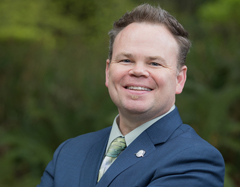 Scientific discovery is a universal journey for anyone with a passion for following his or her curiosity. It discriminates neither against the newest of amateurs nor against the seasoned professionals. Scientific research finds itself in rural areas of the world and the largest of urban institutions. However, for those in rural areas, accessing adequate literature to support scientific research can be harder than conducting the research in the first place.
Scientific discovery is a universal journey for anyone with a passion for following his or her curiosity. It discriminates neither against the newest of amateurs nor against the seasoned professionals. Scientific research finds itself in rural areas of the world and the largest of urban institutions. However, for those in rural areas, accessing adequate literature to support scientific research can be harder than conducting the research in the first place.
I have the great pleasure of being the principal mentor of the Advanced STEM Research Laboratory in the beautiful rural community of Odessa, Washington, a town of approximately 900 people. As the high school science department, I teach integrated science, biology, chemistry, physics, and computer programming to typically 70 students, ending each day by mentoring between 7 and 15 students who have a passion for science or engineering research.
We are remote. We are rural. But we are scientists and engineers who have published work and travel the globe sharing our research. We have support from major research facilities across the planet yet one barrier always stands in our way: access to scientific literature. Rural communities do not have large institutions with libraries. We do not have libraries with budgets to afford subscriptions to scientific research journals. We travel more than 50 miles to the nearest university with the hope that they can continue to afford the journals that we need to review for our research. As the federal government continues cutting public education funds, our rural communities certainly cannot afford the high price of even an individual online journal. Consequently, more and more universities are cutting the quantity of journals to which they subscribe for the same financial reasons. This forces my students and me to turn to online resources with heavy price tags per article. In a time of instantaneous information at our fingertips, why must rural or remote communities be denied cutting-edge research methodologies, crucial and timely data, or newfound scientific evidence?
Open access scientific journal publishing, which makes published research free for readers by shifting the publishing fees to authors or subsidies, would revolutionize our rural research laboratory. Public dollars fund much of the scientific research occurring across the United States, so why should we not be able to access these findings? Why should my 16-year-old student pay $75 to a company that published the results of the research that, if she read it today, could further advance the scientific community through her own research?
Cost benefit analyses for the United Kingdom and the Netherlands estimated the savings associated with open access publishing models. After comparing traditional publishing models with open access models, John Houghton from Victoria University's Institute of Strategic Economic Studies in Melbourne, Australia, projected that the UK higher education sector circa 2007 could have saved £80 million/year by changing from a proprietary-based platform to open access publishing. Using similar cost-benefit comparisons John Houghton joined Jos de Jonge and Marcia van Oploo of EIM Group/Research voor Beleid (Research for Policy) in the Netherlands and estimated a €133 million/year savings for the Dutch in a worldwide open access publishing system that uses an author-pays model. Open access may allow the author to retain ownership, undergoes continuous peer review, and since 2008 the global sharing of open access journal papers has been gradually increasing.
There may be obstacles to open access publishing such as varying processing fees for the researchers or their institutions, or the number and quality of open access journals across the scientific disciplines; however, models implementing open access in Brazil and India address these obstacles. In these countries, most open access journals do not charge processing fees to authors and the numbers of open access issues and journals are steadily growing. A 2015 study conducted by Stuart Lawson of the University of London revealed 68.8 percent of open access publishers offered fee waivers for authors who did not have enough funding to publish in those journals. These types of incentives advocate for and support open access in low- and middle-income countries, but also in rural educational facilities like the ASR Laboratory at Odessa High School.
Open access publishing needs to be available for rural areas and low-income neighborhoods in the United States, developing countries, secondary educators, and secondary students worldwide—who are our future scientists and engineers. Open access publishing provides everyone the same opportunity to share in the universal journey to follow his or her curiosity.
-
by
Jamie Vernon
| Jan 23, 2018
Sigma Xi members, affiliates, and explorers discuss critical issues in science as part of the Society’s Quarterly Conversations initiative. In light of the recent government shutdown, this quarter’s discussion will explore how Sigma Xi should represent the research enterprise in the political system.
Ending the Government Shutdown Does Not End the Problems for U.S. Science
 Scientists may breathe a sigh of relief now that the United States government shutdown has come to an end, but there’s little reason to relax. Researchers around the world experience a ripple effect when the U.S. government fails to operate even for a short period. In addition to domestic challenges, such as reduced food safety surveillance, national lab closures, and the postponement of grant reviews and distributions, international collaborations involving federal employees are put on hold, U.S.-based digital resources including agency websites and data portals are not updated, and international travel procedures for federal employees going to conferences or meetings are disrupted. This uncertainty in the U.S. political system undermines the nation’s ability to serve as a reliable scientific partner. However, the nation’s research problems are not limited to the threat of future shutdowns.
Scientists may breathe a sigh of relief now that the United States government shutdown has come to an end, but there’s little reason to relax. Researchers around the world experience a ripple effect when the U.S. government fails to operate even for a short period. In addition to domestic challenges, such as reduced food safety surveillance, national lab closures, and the postponement of grant reviews and distributions, international collaborations involving federal employees are put on hold, U.S.-based digital resources including agency websites and data portals are not updated, and international travel procedures for federal employees going to conferences or meetings are disrupted. This uncertainty in the U.S. political system undermines the nation’s ability to serve as a reliable scientific partner. However, the nation’s research problems are not limited to the threat of future shutdowns.
The current political atmosphere in Washington, DC, has put the U.S. research enterprise on the defensive on many fronts—from the censorship of scientifically relevant words used in agency reports to indifference toward scientific evidence in the policy process. Federal funding for U.S. research continues to be at an historic low relative to GDP. EPA Administrator Scott Pruitt is systematically overturning regulations built on decades of environmental research. And despite opposition from the majority of climate scientists worldwide, the U.S. has withdrawn from the Paris climate accord. These actions jeopardize the nation’s scientific standing on the international stage.
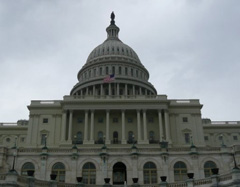 U.S. investments in research have historically advanced global scientific progress while ensuring the benefits drive economic growth domestically. Current trends create doubt about the future of the U.S. research enterprise. In just the last week it has been reported that the U.S. dropped out of the top 10 in the Bloomberg Innovation Index for the first time since the gauge was launched six years ago and, according to statistics compiled by the U.S. National Science Foundation, China has overtaken the U.S. as the world’s largest producer of scientific articles. American research leadership appears to be eroding. This new reality raises a number of issues for Sigma Xi.
U.S. investments in research have historically advanced global scientific progress while ensuring the benefits drive economic growth domestically. Current trends create doubt about the future of the U.S. research enterprise. In just the last week it has been reported that the U.S. dropped out of the top 10 in the Bloomberg Innovation Index for the first time since the gauge was launched six years ago and, according to statistics compiled by the U.S. National Science Foundation, China has overtaken the U.S. as the world’s largest producer of scientific articles. American research leadership appears to be eroding. This new reality raises a number of issues for Sigma Xi.
Sigma Xi has a distinguished record as an advocate in Washington, DC, on behalf of its members and the research enterprise. Most recently we co-signed a letter drafted by our partner, Research!America, calling for the 115th Congress to raise the sequestration budget caps imposed under the 2011 Budget Control Act to allow more funding for research and development. In November, we joined with AAAS and many other scientific societies to encourage Senate Majority Leader Mitch McConnell and Senate Minority Leader Chuck Schumer to protect critical graduate student tax benefit provisions. We plan to continue to take action on these types of issues, but we’d like to hear from you.
The Questions
This quarter, I’d like to invite Sigma Xi members, affiliates, and explorers to discuss the organization’s role as an advocate for the research enterprise. Some of the questions that would benefit from input include:
-
What role should Sigma Xi play in advocating for the use of science and engineering in the policy process?
-
Should Sigma Xi help members, affiliates, and explorers visit their representatives in Washington, DC, or in their local districts? If so, how?
-
Should Sigma Xi be more vocal when federal budgets fail to prioritize investments in research? If so, how?
-
What role should Sigma Xi play on the international stage regarding research?
-
How can Sigma Xi members, affiliates, explorers, and chapters contribute to these efforts?
I encourage you to have conversations with members of your chapters locally, to comment on our conversation in the online community The Lab, to submit a post for publication on Sigma Xi’s blog, KeyedIn, or just send me your thoughts by email at jvernon@sigmaxi.org.
Jamie L. Vernon, PhD, is executive director and CEO of Sigma Xi, The Scientific Research Honor Society and publisher of American Scientist.
Photos
Top photo: Jamie L. Vernon
Bottom photo: The U.S. Capitol Building is the home of Congress. Photo courtesy of Wikimedia Commons.
-
by
Aaron Huertas
| Jan 22, 2018
When scientists talk about public policy, they usually focus on the most visible parts of the political process—think presidential speeches and Congressional debates over major legislation. But a great deal of policymaking is done quietly by professional staff at public agencies. While laws provide the broad outlines of how things are supposed to be done, it’s often up to scientific and policy staff at agencies to lay out the specifics, including whether or not a drug is brought to market, the level of ozone pollution allowed in a region, or exactly how much future sea-level rise to anticipate for new infrastructure projects.
Policy experts say well-placed scientific advice can have an outsize impact in these venues.
Becoming a trusted advisor
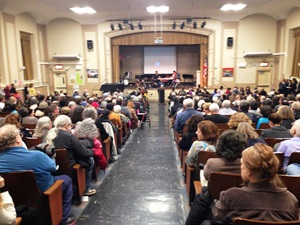
Normally, when state and federal agencies work to implement a law, they first introduce drafts of new rules for external review. Scientists, regulated industries, and public interest groups can weigh in with public comments—essentially letters to regulators—as well as by attending public hearings, where anyone can offer feedback about a rule. Agency staff members are then tasked with responding to every unique point brought up in public comments. Particularly controversial rules can attract thousands of comments.
Wendy Wagner, a University of Texas at Austin law professor who has studied regulatory agencies, says there’s naturally more going on behind the scenes. “There's this happy idea of comments and deliberations,” she says, “but it's probably missing how the game is being played now.”
Generally, regulated industries are able to bring considerable resources—time, expertise, and legal advice—to the table, according to Wagner’s research, while public interest groups tend to be outnumbered. Amidst their arguments about how to shape the rules, public agencies need to make sure they get their science right. Using the wrong information or failing to cite relevant science can open up the possibility of lawsuits down the road, Wagner says.
Wagner recommends that independent scientists consider “getting in at the ground level” and become a resource to agency staff who are dealing with rules on which they have relevant expertise. For instance, a scientist with some insights into wetland restoration could seek out public land managers, coastal commission staff, and other government employees who can use an independent source of information and scientific advice. Finding the right staff to reach out to is usually just a matter of looking up the office that’s dealing with a particular rule on an agency website and seeing who’s been writing reports and doing analysis on behalf of the agency.
“Agencies are scared of facts that contradict them,” Wagner says, and they’re eager to get the science right. In some cases, when agencies are under political pressure to ignore or downplay evidence, scientists can support agency staff by making it clear what can and can’t be said about the scientific realities in their field.
“Even in this world of expertise being maybe frowned upon by the general public, that's not the case in Congress and agencies,” she says.
Serving on panels and advisory bodies
Gretchen Goldman, the research director for the Center for Science and Democracy at the Union of Concerned Scientists, says volunteering on advisory committees can also be a constructive way to put one’s expertise to work.
In many cases, agencies specifically seek out subject matter experts to serve on advisory bodies. But scientists can also do more to step up and serve. For instance, the Food and Drug Administration often needs independent experts to serve on drug approval panels. But most scientists who work on prescription drugs have done business with drug companies, so it can be hard for the agency to find a group of scientists who don’t have too many possible conflicts of interest. That’s why Goldman and her colleagues asked scientists with relevant expertise in medicine and biology to serve on those panels, too, even though drug approval processes weren’t something they’d followed closely before.
Scientists are quick studies and scientific training can prepare someone well for thinking about public policy, Goldman says. She often tells scientists, “You’re more of an expert than you think you are. You don’t need to know every small detail to have something constructive to say about it.”
Goldman, an environmental engineer by training, also chairs a local public advisory committee for air and climate in the Washington, DC, region. Through the committee, she and her neighbors have helped shape how agencies account for local global warming emissions, developed a partnership with local groups to issue air quality alerts for the region, and utilized an environmental justice toolkit for evaluating new projects and policies.
Goldman urges scientists to plug into the work advocates and journalists are doing to track rules and regulations. That can mean joining a group’s email list, following policy experts on Twitter, and contacting nonprofit groups to get some guidance on how to make the best use of one’s time.
“Often there’s a lot happening right around you, you’re just not in the circles to know about it,” she says.
Aaron Huertas is an independent science communicator who lives and works in Washington, DC. He runs ScienceCommunicationMedia.com and serves as co-boss for Nerd Nite DC. He worked at the Union of Concerned Scientists for several years.
Photo:
One way scientists can weigh in on policy is to attend public hearings, such as the one pictured above from a 2016 public hearing concerning the possible loss of a supermarket in Hudson Heights, Manhattan. (Photo courtesy of Wikimedia Commons)
-
by
Tee Guidotti
| Jan 10, 2018
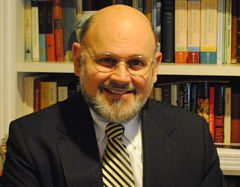 Recently, a conversation thread in Sigma Xi’s online member community, The Lab, asked the decidedly not rhetorical question, “How does Sigma Xi define research?”
Recently, a conversation thread in Sigma Xi’s online member community, The Lab, asked the decidedly not rhetorical question, “How does Sigma Xi define research?”
Your Society officers have talked a lot about this over the last 132 years. The informal consensus is that Sigma Xi honors scientific research and that the essential feature of scientific research is not numbers, test tubes, or p values but the scientific method, in particular falsification. The key element is whether a defined hypothesis is being tested in a critical manner and the process is self-correcting (e.g. not based on untestable theory or simply accumulation of facts). The short answer is: it's not about the discipline. It's about the approach to the problem. The long answer is more complicated and interesting.
There is science in disciplines not counted among the sciences. Historical interpretation? If based on an untestable theory, such as Marxism, no. But the rigorous approach of the Annales school of historiography? Très scientifique. Literary analysis? Reading Jane Austen, I don’t think so. Analyzing word frequency in comparative texts for clues to changing attitudes and to understand the text, however, maybe. Philosophical inquiry? All science derives from materialist philosophy and the philosophical field of science studies uses the methods of science. Much rigorous thinking in philosophy apart from these examples does involve falsification, in the sense that like a mathematical proof, it hinges on seeking contradiction. (In fact, Wittgenstein’s Tractus Logico-Philosophicus is structured as a proof.) Theological studies? Not so much! Drug-assisted bliss studies? Empirical but not generalizable!
This existential question reached a crisis moment in 1927, when a member was admitted for scholarship in “public speaking.” This caused an uproar and forced reconsideration of what disciplines were considered true sciences. Back then, the solution was to make up what turned out to be an elaborate taxonomy of the sciences, written on sheets of paper that resembled Linnaeus’ taxonomy of life forms. In more recent years, your Sigma Xi leadership has looked at the problem differently, accepting that application of the scientific method defined eligibility for Sigma Xi membership and recognition, not the field in which it is applied.
It has become clear that recognizing valid research in science by classifying disciplines is a fruitless project. Fields split. Sciences that began as purely descriptive become predictive and quasi-experimental, like astronomy and astrophysics. Studies rooted in the humanities may become true sciences, such as how philology morphed into linguistics which morphed into a cognitive science, now connected with artificial intelligence. It has become less clear that applied technology is fundamentally different from discovery research, for example with respect to computer science and big data, which we’ll be addressing at our annual conference in October 2018.
In fact, it seems that trying to assess scientific validity by classifying fields of inquiry is just a modern-day revival of the ancient (Pythagorean) idea that “academically-worthy” is defined by a rigorous and traditionally-defined “quadrivium” (arithmetic, geometry, music, astronomy) supported by mastery of the less respected “trivium” (grammar, logic, and rhetoric), from which comes the word “trivial.” (“Public speaking” may have been an important skill in the trivium but it didn’t make it into the quadrivium.)
Sigma Xi leaders were ultimately wise to appreciate that science takes many forms, that the model of lab research is not the only or always the purest form of scientific research, that qualitative and observational studies have their place and are not second-class science, that some scientific approaches do not involve experimentation but are still grounded on testable hypotheses, and that some fields that bridge science and its application to policy (such as risk science, where definition of uncertainty is key) can make basic and general contributions to understanding and knowledge. We are also seeing the fusion of the natural sciences and social sciences, in the form of analysis and proposed solutions of so-called “sociotechnical” or “wicked” problems. Outside the laboratory, this synthesis is one of the biggest growth areas in research today.
So, let us be a little less concerned with the fields in which our colleagues work and more interested in how they work and the culture of science. Sigma Xi can be inclusive—it cannot be indiscriminate.
One of the intellectual giants of the sixteenth century was Paolo Sarpi, the Venetian cleric who conducted credible, original research in mathematics (especially geometry), physics (especially density and optics), and medicine (papillary dilation and the valves of the veins). However, he is remembered mostly for his minutely analyzed historical research, which is credited with saving the Republic of Venice by documenting facts on a bitter dispute in theology that had political implications. I’d like to think that Paolo would be welcome as a member of Sigma Xi!
Tee Guidotti is a past president of Sigma Xi and an international consultant on health, safety, and environment management and sustainability.
-
by
Jamie Vernon
| Oct 20, 2017
Sigma Xi Speaks, October 2017

Data is the currency of research. Scientists and engineers rely on the flow of data to advance their investigations. The public uses data to address health concerns, build businesses, and make policy decisions. This information is usually shared through scientific publications, which are accessible at research institution libraries and publisher websites.
But what happens when a university fails to renew a journal subscription that is used by its faculty or publishers charge exorbitant fees to download articles? Too often people are cut off from important sources of scientific information.
Researchers can ask their library to acquire a copy of an article or they can use institutional resources to purchase the article online.
The public, which helps fund much of the research published in these journals, has even fewer options for accessing the information, particularly in non-urban regions of the United States. They are left to rely on the media to translate the research for them, which presents its own set of challenges including misinterpretation, biased reporting, and disinformation campaigns. All of these options disrupt the free flow of information necessary for efficient scientific exploration and use.
Open access, a system that makes research articles available to all interested parties at no cost, could be a solution to disseminating research results to students, the scientific community, and the public. Open access makes information readily accessible while shifting the financial responsibility away from the consumers and onto the publishers and authors. This publishing model is not without controversy. Researchers question whether a pay-to-publish model undermines the credibility of scientists. Publishers argue that a closed system provides better quality and reliability.
I believe this is an issue that Sigma Xi should be thinking about. Because our members are greatly affected by the scientific publishing system, it would be in our interest to participate in the ongoing conversation about the pros and cons of open access publishing.
The Questions
We recently started a conversation in Sigma Xi's online community by asking the following questions:
• Should Sigma Xi promote open access, and to what extent?
• What can Sigma Xi do to help improve access to scientific results for the public and students?
• How should scientific publishers be compensated for their work in an open access system?
What Members Have Said So Far
Some members already responded with informative feedback such as:
• The open access online scientific journals are opening up inexpensive open access publication opportunities for scientists in underdeveloped countries and also for scientists in developed countries who do not have access to the types of funds that traditional subscription journals usually demand and are also making those articles freely available to all scientists, not just those scientists fortunate enough to be associated with a wealthy institution or organization.
• The fundamental problem is that no one has found a [open access] business model that really works on a broad scale.
• The arXiv physics repository has been increasingly successful for the physics community over the last 25 years to the extent that today formal publishing in journals managed by for-profit publishers is merely a formality at the end of the process of divulging physics research results and receiving peer-review commentary.
Over the next three months, we will share additional information about this important issue.
Join the Conversation
We invite you to send us your opinions about the opportunities and challenges of open access publishing. You can participate in our online community or by email at executiveoffice@sigmaxi.org.
Here are some links to help inform the discussion:
• Are Open Access Journals Immune from Piracy?
Source: The Scholarly Kitchen
• Open Science Revolution—New Ways of Publishing Research in the Digital Age
Source: Scicasts
• German Researchers Resign from Elsevier Journals in Push for Nationwide Open Access
Source: Science
• List of Open Access Journals
Source: Wikipedia
Sincerely,

Jamie L. Vernon, PhD
Executive Director and CEO
Sigma Xi, The Scientific Research Honor Society
Publisher of American Scientist
-
by
User Not Found
| Oct 05, 2017
 Thank you for making the third year of Sigma Xi's Nobel Prize prediction contest, October Madness, a great success! While our top predictions for the prizes in chemistry, physics, and physiology or medicine did not go on to win Nobel Prizes, this was the second year that a nominee on our brackets won! That honor goes to Rainer Weiss and Sigma Xi member Kip S. Thorne who, with Barry C. Barish, won the 2017 Nobel Prize in Physics for contributions to the LIGO detector and the observation of gravitational waves.
Thank you for making the third year of Sigma Xi's Nobel Prize prediction contest, October Madness, a great success! While our top predictions for the prizes in chemistry, physics, and physiology or medicine did not go on to win Nobel Prizes, this was the second year that a nominee on our brackets won! That honor goes to Rainer Weiss and Sigma Xi member Kip S. Thorne who, with Barry C. Barish, won the 2017 Nobel Prize in Physics for contributions to the LIGO detector and the observation of gravitational waves.
LIGO team leaders explains what gravitational waves are and how they detected them in this video.
Drawing Winner
The public sent in their nominations for our October Madness brackets before the Nobel Prizes were announced. Those who nominated someone who went on to win a 2017 Nobel Prize were entered into a drawing. Sigma Xi members had the chance to win a free year of membership dues while non-members could win a year of dues for the Sigma Xi Affiliate Circle.
The winner of this year's drawing is Sigma Xi member Ian Redmount, who was among those who nominated Kip Thorne for our brackets. Congratulations on winning a year of membership dues, Ian! Watch for an email from me with more details.
What's Next
Check back here on Keyed In next summer for the 2018 edition of October Madness! You can also follow along on Sigma Xi's social media with #OctoberMadness.
A Look Back at the 2017 Edition of October Madness
Announcement of Champions
Finals
Final 4
Elite 8
Sweet 16
Call for Nominations
Heather Thorstensen is the manager of communications for Sigma Xi, The Scientific Research Honor Society.
-
by
User Not Found
| Sep 26, 2017
The people have spoken about who they think should win the 2017 Nobel Prizes! After crowdsourcing nominations and four weeks of public voting, we can announce your October Madness champions, who are your top Nobel picks for chemistry, physics, and physiology or medicine the year.
Your prediction for the Nobel Prize in Chemistry is...
M. Stanley Whittingham and John Goodenough for research leading to the development of the lithium ion battery.
Your prediction for the Nobel Prize in Physics is...
Alexander Polyakov for work in quantum field and string theory.
Your prediction for the Nobel Prize in Physiology or Medicine is...
Emanuelle Charpentier, Jennifer Doudna, and Feng Zhang for CRISPR-Cas9 genome editing.
Congratulations to these researchers!
Raffle Winner
A one-year subscription to American Scientist goes to Katrina for voting in the finals round! Look for an email this week confirming your prize.
Thanks to everyone for voting!
What Happens Next
- Watch for the official Nobel Prize announcements.
The Nobel Prize in Physiology or Medicine - Monday 2 October, 11:30 a.m. at the earliest
The Nobel Prize in Physics - Tuesday 3 October, 11:45 a.m. at the earliest
The Nobel Prize in Chemistry - Wednesday 4 October, 11:45 a.m. at the earliest
The Nobel Peace Prize - Friday 6 October, 11:00 a.m.
The Sveriges Riksbank Prize in Economic Sciences in Memory of Alfred Nobel - Monday 9 October, 11:45 a.m. at the earliest
The Nobel Prize in Literature - The date will be set later.
Times listed are local time in Sweden.
- Read what others are predicting for this year's Nobel Prizes.
"Predictions for the 2017 Chemistry Nobel Prize," via Scientific American and Chemistry World
"With the Nobel Prizes Around the Corner, It's Crystal Ball Time," via STAT
The 2017 Clarivate Citation Laureates
"2017 Nobel Prize Predictions," via Everyday Scientist
"2017 Nobel Prize Picks," via The Curious Wavefunction
- Have a look back at our 2017 chemistry, physics, and physiology or medicine brackets:
Finals
Final 4
Elite 8
Sweet 16
- Check back here on Keyed In on October 5 to see if anyone won the prize of one year of dues for Sigma Xi membership (for members only) or for the Sigma Xi Affiliate Circle. This prize is available to those whose nominees win a Nobel Prize.
Heather Thorstensen is manager of communications for Sigma Xi, The Scientific Research Honor Society.
-
by
Jamie Vernon
| Sep 21, 2017
 In light of recent headlines, you might be wondering whether there have been more weather-related disasters lately. According to the International Disaster Database, the number of extreme events worldwide has quadrupled since 1970. Hydrologic events have increased six-fold over the last 37 years. Climate scientists tell us that the increasing frequency and intensity of these events can be attributed to global warming, which is driven by human activities.
In light of recent headlines, you might be wondering whether there have been more weather-related disasters lately. According to the International Disaster Database, the number of extreme events worldwide has quadrupled since 1970. Hydrologic events have increased six-fold over the last 37 years. Climate scientists tell us that the increasing frequency and intensity of these events can be attributed to global warming, which is driven by human activities.
The science that explains the causes of climate change does not dictate the solution. It is up to policymakers to find the best way to slow or stop the buildup of greenhouse gases in our atmosphere. Despite decades of debate, robust mitigation proposals have proven to be politically unworkable within the United States. Because America is one of the top producers of greenhouse gases, our inability to lead on this issue has brought the entire world to an impasse. Without adequate reductions of carbon emissions, we are left to ponder what the implications of global warming will be.
Responding to threats posed by climate change is a multidisciplinary problem. Research ranging from materials science to epidemiology will be critical to our ability to slow the process of climate change and to countering the ultimate effects of our warming planet. As a member of the scientific community, you may be seeking opportunities to contribute to the debate around climate policy. Sigma Xi members, representing every research discipline, can assist by building connections with the public and by participating in the policy making process.
Participate in Climate Change Discussions
.tmb-medium.jpg?sfvrsn=c899b858_1) On Friday, November 10, Sigma Xi is convening a symposium in Raleigh, North Carolina, where climate researchers will discuss the intersections between climate change, environmental health, and human health. Attendees will gain insights into the state of climate change and possible solutions, both technologically and policy-driven. The lectures will be followed by a climate town hall where citizens from the surrounding area will be able to raise their questions and concerns to a panel of experts. This event will allow you to directly engage with the public on this critical issue. In addition, those who choose to attend the Student Research Conference on Saturday, November 11, will have an opportunity to learn to communicate their research findings to policymakers and the public through a professional workshop conducted by communications consultant, Aaron Huertas.
On Friday, November 10, Sigma Xi is convening a symposium in Raleigh, North Carolina, where climate researchers will discuss the intersections between climate change, environmental health, and human health. Attendees will gain insights into the state of climate change and possible solutions, both technologically and policy-driven. The lectures will be followed by a climate town hall where citizens from the surrounding area will be able to raise their questions and concerns to a panel of experts. This event will allow you to directly engage with the public on this critical issue. In addition, those who choose to attend the Student Research Conference on Saturday, November 11, will have an opportunity to learn to communicate their research findings to policymakers and the public through a professional workshop conducted by communications consultant, Aaron Huertas.
I would like to personally encourage you to join us for this exciting event. The lessons you learn and apply in your own community could make the difference in our ability to respond to climate change.
Learn about Climate Change
As we prepare for the symposium, you can learn more about climate change from the following American Scientist articles.
Sincerely,

Jamie L. Vernon, PhD
Executive Director and CEO
Sigma Xi, The Scientific Research Honor Society
Publisher of American Scientist
-
by
User Not Found
| Sep 19, 2017

We're down to the finals of Sigma Xi's Nobel Prize prediction contest, October Madness! Your vote this week is more important than ever because you can help your favorites become October Madness champions!
We added a prize to celebrate this last round of voting. Everyone who votes in the finals will be entered into a raffle for a one-year subscription to American Scientist, Sigma Xi's magazine about science, engineering, and technology. You can keep it for yourself or give it to a friend!
Voting Deadline
Voting is open until September 24, 2017. Results will be announced here on Keyed In and Sigma Xi's social media on September 26. Good luck!
Chemistry

The final chemistry match-up is:
M. Stanley Whittingham and John Goodenough for research leading to the development of the lithium ion battery
vs.
Harry Gray and Steve Lippard for pioneering work in the field of bioinorganic chemistry
Physics
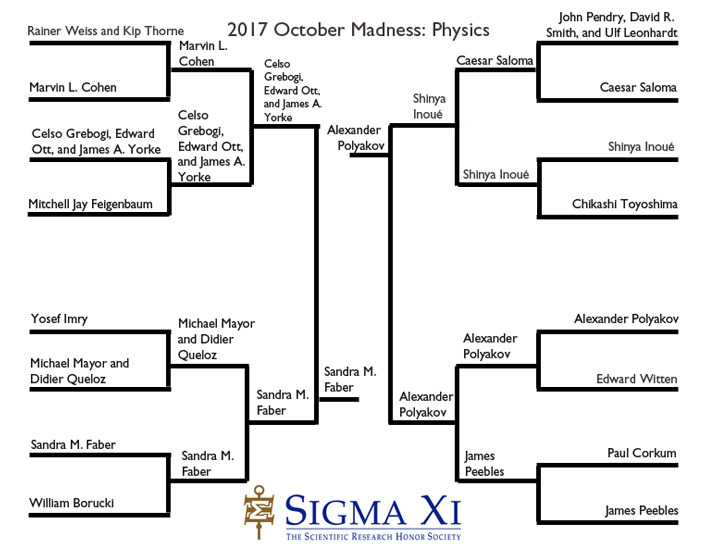
The final physics match-up is:
Sandra M. Faber for leadership in numerous path-breaking studies of extra-galactic astronomy and galaxy formation
vs.
Alexander Polyakov for work in quantum field and string theory
Physiology or Medicine
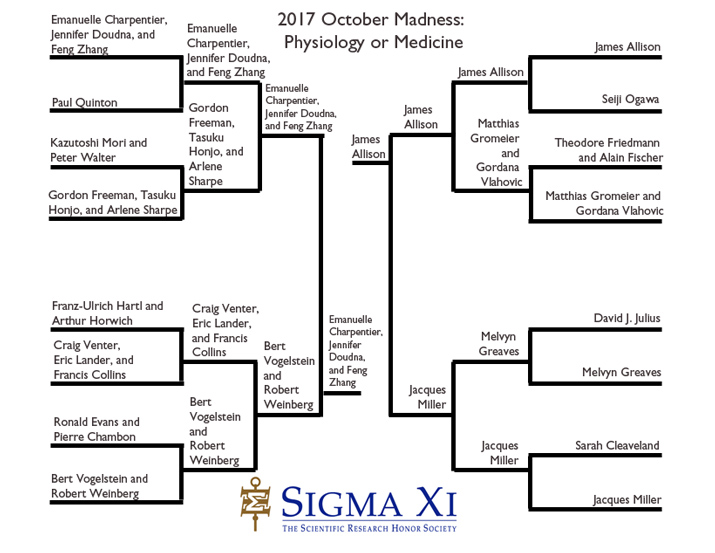
The final physiology or medicine match-up is:
Emanuelle Charpentier, Jennifer Doudna, and Feng Zhang for CRISPR-Cas9 genome editing
vs.
James Allison for work on immune checkpoint bloackade treatment
Cast your vote for all three categories!
Final 4 Voting Results*
Chemistry
Physics
Physiology or Medicine
*Ties were broken by the number of votes each nominee received in the Elite 8 round.
Heather Thorstensen is manager of communications for Sigma Xi, The Scientific Research Honor Society.
-
by
User Not Found
| Sep 12, 2017

We're down to the Final 4 of Sigma Xi's Nobel Prize prediction contest, October Madness! Vote to make sure your top picks make it to the finals!
Voting is open until September 17, 2017, for the Final 4 round.
Final 4 Voting
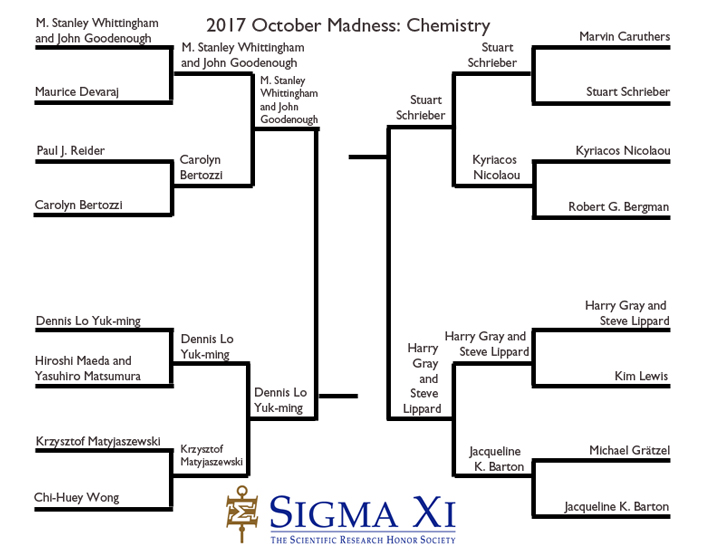
The Final 4 chemistry match-ups are:
1.
M. Stanley Whittingham and John Goodenough for research leading to the development of the lithium ion battery
vs.
Dennis Lo Yuk-ming for detecting fetal DNA in maternal plasma, a revolution in noninvasive prenatal testing
2.
Stuart Schrieber for pioneering chemical insights into the logic of signal transduction and gene regulation that led to new therapeutics and for applications of small-molecule probes
vs.
Harry Gray and Steve Lippard for pioneering work in the field of bioinorganic chemistry
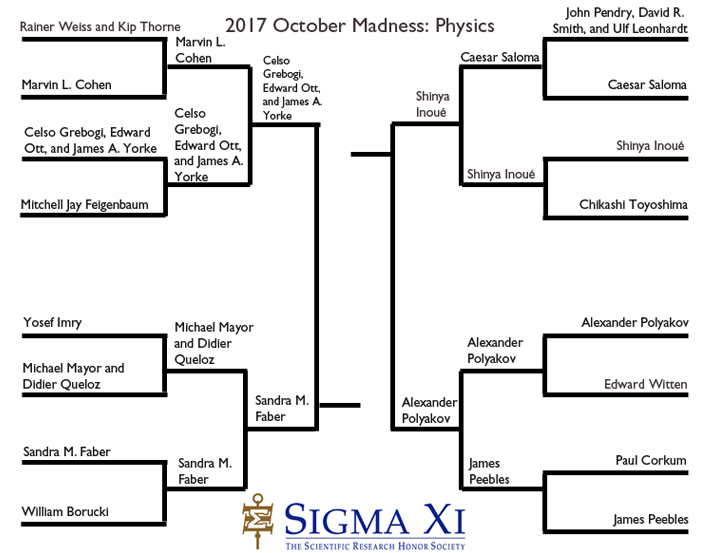
The Final 4 physics match-ups are:
1.
Celso Grebogi, Edward Ott, and James A. Yorke for describing a control theory of chaotic systems
vs.
Sandra M. Faber for leadership in numerous path-breaking studies of extra-galactic astronomy and galaxy formation
2.
Shinya Inoué for contributions to visualization of processes within living cells using light microscopy
vs.
Alexander Polyakov for work in quantum field and string theory
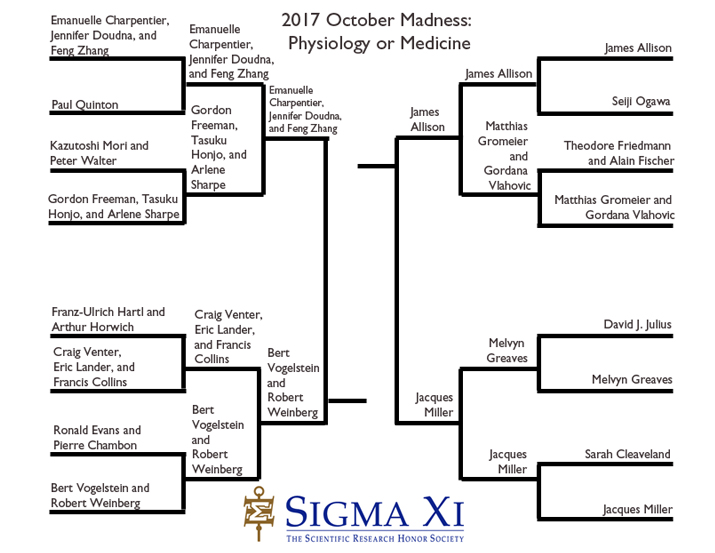
The Final 4 physiology or medicine match-ups are:
1.
Emanuelle Charpentier, Jennifer Doudna, and Feng Zhang for CRISPR-Cas9 genome editing
vs.
Bert Vogelstein and Robert Weinberg for advancements in identifying rogue cancer genes and their roles in health and disease
2.
James Allison for work on immune checkpoint bloackade treatment
vs.
Jacques Miller for revealing the key role of the thymus in controlling the body's immune system
Elite 8 Voting Results*
Chemistry
Physics
Physiology or Medicine
*Ties were broken by the number of votes each nominee received in the Sweet 16 round, with the exception of the physics match-up of Marvin L. Cohen vs. Celso Grebogi, Edward Ott, and James A. Yorke. These nominees received the same amount of votes in the Sweet 16 round, so their Elite 8 round tie was broken by coin toss, resulting in Grebogi, Ott, and Yorke advancing to the Final 4.
Heather Thorstensen is manager of communications for Sigma Xi, The Scientific Research Honor Society.
-
by
User Not Found
| Sep 06, 2017

Thanks to everyone who voted in our Sweet 16 round of October Madness, Sigma Xi's Nobel Prize prediction contest!
Voting is open until September 10, 2017, for the Elite 8 round.
Make sure to vote to keep your favorites in the running!
Elite 8 Voting
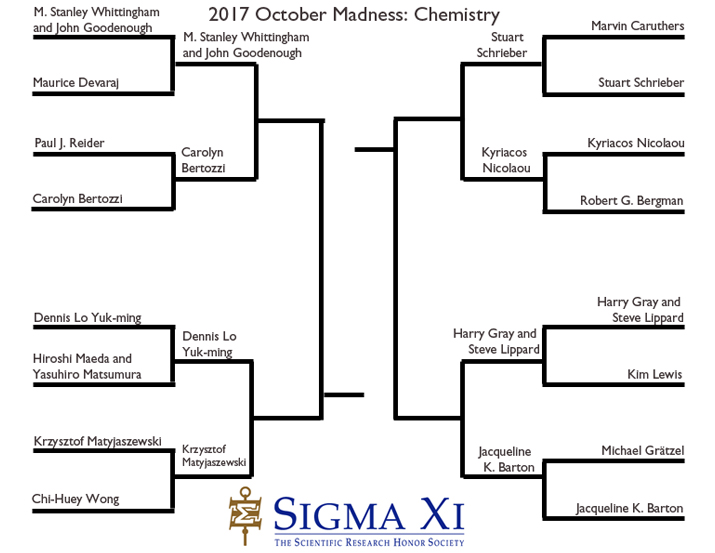
The Elite 8 chemistry match-ups are:
1.
M. Stanley Whittingham and John Goodenough for research leading to the development of the lithium ion battery
vs.
Carolyn Bertozzi for her contributions to chemical reactions in live cells in organisms that lead to the development of new diagnostic and therapeutic approaches
2.
Dennis Lo Yuk-ming for detecting fetal DNA in maternal plasma, a revolution in noninvasive prenatal testing
vs.
Krzysztof Matyjaszewski for his contributions to atom transfer radical polymerization
3.
Stuart Schrieber for pioneering chemical insights into the logic of signal transduction and gene regulation that led to new therapeutics and for applications of small-molecule probes
vs.
Kyriacos Nicolaou for advancing the field of chemical synthesis
4.
Harry Gray and Steve Lippard for pioneering work in the field of bioinorganic chemistry
vs.
Jacqueline K. Barton for pioneering the application of transition metal complexes to probe recognition and reactions of double helical DNA

The Elite 8 physics match-ups are:
1.
Marvin L. Cohen for theoretical studies of solid materials and prediction of their properties
vs.
Celso Grebogi, Edward Ott, and James A. Yorke for describing a control theory of chaotic systems
2.
Michael Mayor and Didier Queloz for the first discovery of an exoplanet orbiting a solar-type star
vs.
Sandra M. Faber for leadership in numerous path-breaking studies of extra-galactic astronomy and galaxy formation
3.
Caesar Saloma for contributions to photonics and signal processing
vs.
Shinya Inoué for contributions to visualization of processes within living cells using light microscopy
4.
Alexander Polyakov for work in quantum field and string theory
vs.
James Peebles for work on cosmic microwave background radiation and physical basis for hot big bang theory
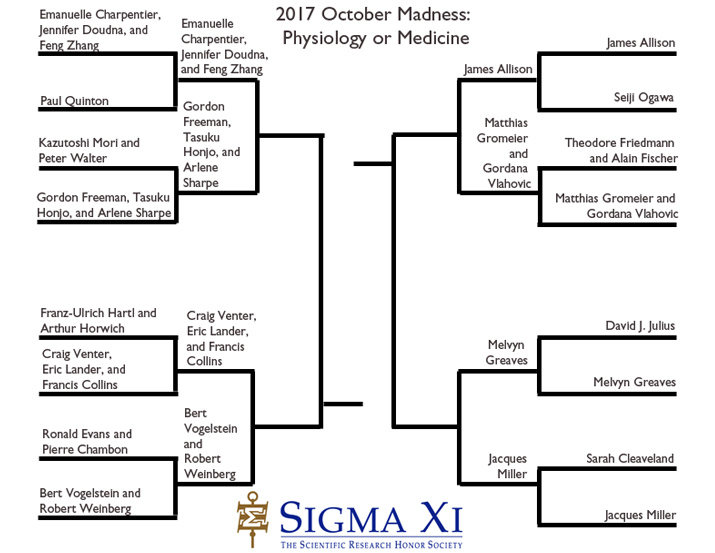
The Elite 8 physiology or medicine match-ups are:
1.
Emanuelle Charpentier, Jennifer Doudna, and Feng Zhang for CRISPR-Cas9 genome editing
vs.
Gordon Freeman, Tasuku Honjo, and Arlene Sharpe for elucidating programmed cell death-1 and its pathway, which has advanced cancer immunotherapy
2.
Craig Venter, Eric Lander, and Fancis Collins for genomics and sequencing
vs.
Bert Vogelstein and Robert Weinberg for advancements in identifying rogue cancer genes and their roles in health and disease
3.
James Allison for work on immune checkpoint bloackade treatment
vs.
Matthias Gromeier and Gordana Vlahovic for using a genetically engineered polio virus (PVS-RIPO) to attack gliobastoma, a brain cancer, and discovering that it seeks out and attaches to receptors that are highly common across tumor types, while leaving normal cells alone
4.
Melvyn Greaves for pioneering methods that distinguish different forms of leukemia, allowing doctors to tailor treatment to each child
vs.
Jacques Miller for revealing the key role of the thymus in controlling the body's immune system
Sweet 16 Voting Results*
Chemistry
Physics
Physiology or Medicine
*Ties were broken in this round by coin toss.
Heather Thorstensen is manager of communications for Sigma Xi, The Scientific Research Honor Society.
-
by
User Not Found
| Sep 06, 2017
You watched the total solar eclipse with wonder on August 21, 2017. Relive the memories with this collection of stories submitted by Sigma Xi members about how they watched this special event.
1. It Looks Like Game Day...for Science!
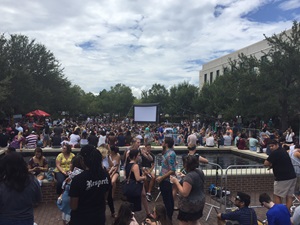 The College of Charleston in Charleston, South Carolina, threw an eclipse party for 1,500 students, faculty, and staff members, and the party served as the staging area for NASA TV's national total solar eclipse coverage.
The College of Charleston in Charleston, South Carolina, threw an eclipse party for 1,500 students, faculty, and staff members, and the party served as the staging area for NASA TV's national total solar eclipse coverage.
Astronomy faculty and students also took the event off campus to 16 locations including parks and retirement homes, and members of the South Carolina NASA Space Grant Consortium launched weather balloons to photograph both the Sun and the eclipse shadow.
The on-campus event venue had games, snacks, and educational outreach activities, and interest in the eclipse was very high. This excitement led College of Charleston Executive Vice President of Student Affairs Alicia Caudill to remark, "It looks like Game Day...for Science!!!"
Jon Hakkila,
Associate Dean of the Graduate School and Professor of Physics and Astronomy
College of Charleston
Charleston, South Carolina
2. The Eclipse in New York

Image courtesy of John Anthony Allocca, medical research scientist, Allocca Biotechnology, LLC, in Huntington, New York.
3. A Wow Moment
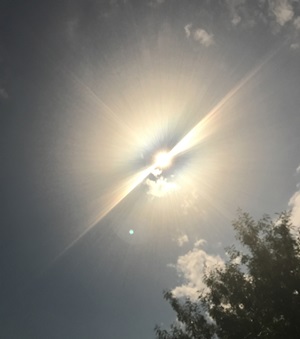 Eclipse viewing along the path of totality was a WoW moment. All the sideshows were there: pinhole crescent projections through the foliage during partial eclipse, shadow bands racing across the landscape (parking lot for us) immediately before and after totality, and the spectacular appearance of the corona during totality.
Eclipse viewing along the path of totality was a WoW moment. All the sideshows were there: pinhole crescent projections through the foliage during partial eclipse, shadow bands racing across the landscape (parking lot for us) immediately before and after totality, and the spectacular appearance of the corona during totality.
The photo was taken with my iPhone 7 a few seconds after totality, just as sunlight was appearing in the upper right quadrant with the moon sliding downward and to the left in an easterly direction. I was very lucky on timing.
The blue dot in the lower left quadrant is apparent in three live-mode burst photos and has three possible explanations:
(1) It is the planet Mercury with an enlarged image because of saturation of the photo detectors in the camera. Interestingly, the position is in good qualitative agreement with star/planetary charts for the same time. Venus, seen with the naked eye during totality, was outside of the upper right quadrant west of the sun, where it should have been.
(2) It is the heretofore unseen planet Vulcan, one of those fake news interpretations which seem to be popular these days .
(3) It is a camera lens artifact.
Arthur F. Hebard
Distinguished Professor of Physics
University of Florida
4. We Drove 700 Miles
My wife, Marlene Bloom, and I drove to Madisonville, Tennessee, to watch the eclipse. We located a high school there and settled down on a piece of unobstructed grass on the school grounds and watched as the Moon slowly completely covered the Sun. We were essentially alone, as another couple did the same thing 100 yards away from our chosen site.
It was truly "unearthly." At the moment of totality, the lighting was spectacularly surreal; the vision of a black sun surrounded by a bright, irregular halo of fire hovering motionless above us was so foreign to anything I had ever experienced that I am still processing the information of those two minutes. We had traveled some 700 miles, from Fort Lee, New Jersey, to Madisonville to see it. We now want to do the same thing again in 2024!
Dickson Despommier
Emeritus Professor of Public and Environmental Health
Columbia University
5. I First Saw Crescent Sun Pictures During the 1970 Eclipse. I Wanted to See Them Again.
Alistair Fraser, who is retired from the meteorology department at Pennsylvania State University and now lives in British Columbia, Canada, was on the hunt for the special way the Sun projected through trees during the eclipse. He writes on his blog, Exploring Kootenay Lake:
“The first hint I had that the Sun could paint pictures on the ground came from a book I read as a student. M. Minnaert’s book, Light and Colour in the Open Air, told of the way the gaps between tree leaves behave as pinhole cameras and projected images of the Sun on the ground. Normally when projected on a horizontal surface, these images would be elliptical. However, during a partial solar eclipse, they match the appearance of the Sun and become crescents.
I first saw these crescent Sun pictures during the solar eclipse of 1970. I wanted to see them again.”
See his pictures on his blog.
6. My First Solar Eclipse
Larry E. Erickson, professor of chemical engineering and director of the Center for Hazardous Substance Research at Kansas State University, wrote:
"My wife and I traveled to Pleasanton, Nebraska, to view the solar eclipse with several others who came to the same public park in Pleasanton. We had a good view of the Sun from the time when the Moon began to cover the Sun until the total eclipse could be seen. It was a great experience, and my first time to view a total solar eclipse."
7. I Was an Unexpected “Radio Star”
As a PhD physicist who has been writing children's science books full-time since 1996, I sometimes get unique opportunities.
When I saw that Nashville was in the path, I contacted Janet Ivey (the Janet of the syndicated PBS show Janet's Planet) and asked if she could find me a "gig." She arranged for me to have a booth on the weekend immediately before the eclipse at the Music City Eclipse Festival and helped me arrange to be the emcee at the community event in White House, Tennessee, right on the center line of totality.
It turned out (to my surprise) that I was given a platform on a local radio station (WQKR, Portland, Tennessee) from noon, about a minute after first contact, to 2:00 p.m., with totality just before 1:30 p.m.
Besides explaining the basics, I shared eclipse lore, including the 1919 eclipse that made Einstein famous and the opening of Mark Twain's A Connecticut Yankee in King Arthur's Court, in which the protagonist escapes execution by knowing that a total solar eclipse was about to happen.
About 15 minutes before totality, I discussed famous stellar occultations, including the discovery of Uranus' rings and last month's three occultations by 2014 MU69, the Kuiper Belt object that is the next target for the New Horizons spacecraft.
The key to being an unexpected "radio star" was to describe the experience, noting my personal experience with full excitement showing.
Some of the highlights, besides the obvious events at and near totality, were the unusually sharp shadows cast by a thin crescent sun, the crescent images on the ground through tree leaves and a colander, the odd colors as dusk fell in all directions at once, and the sound of a few thousand people cheering and gasping as the corona appeared and as the first beam of light signaled the end of totality.
The community of White House also invited me to present a similar talk to parents and kids at one of their elementary schools. What a pleasure that turned out to be, and I even sold a few more books than I had anticipated.
Alfred B. (“Dr. Fred) Bortz
8. I Built a Computer Interfaced Sensor Module
Dev Gualtieri, the president of Tikalon LLC in Ledgewood, New Jersey, was not near totality but he did make some scientific measurements, as outlined in his blog post.
He writes,
“Instead of photography, I decided to make photometric and temperature observations at my cloudy location.”
9. Sharing Eclipse Cookies on the Way to Charleston, South Carolina
Sigma Xi members and members of the public rode a bus from Sigma Xi headquarters in Research Triangle Park, North Carolina, to Charleston, South Carolina, to watch the total solar eclipse.
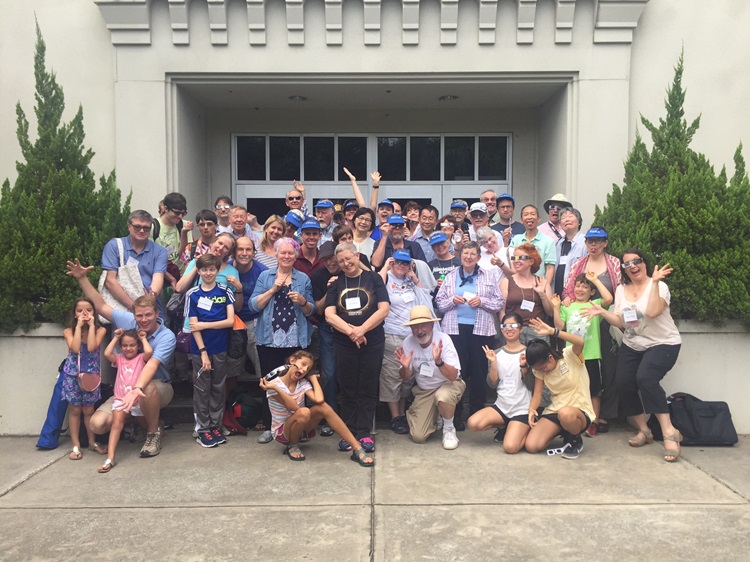
A young bus rider shares eclipse cookies.

Bus rider Alisa Leung captured the solar eclipse on her camera.
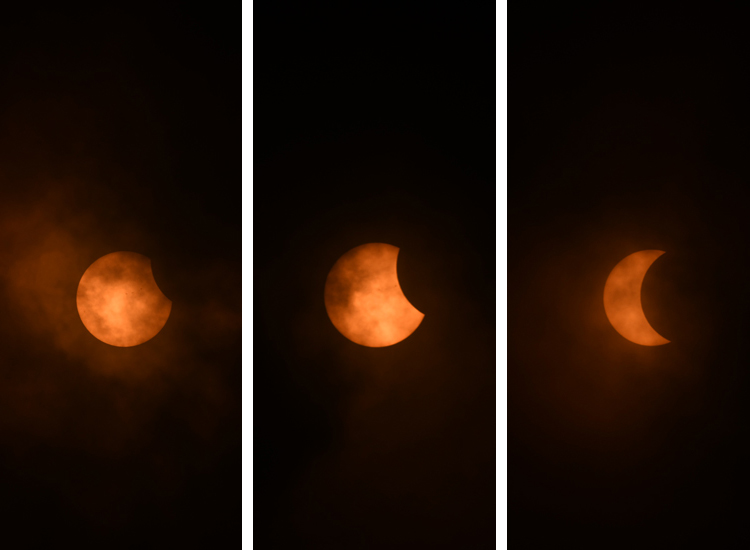
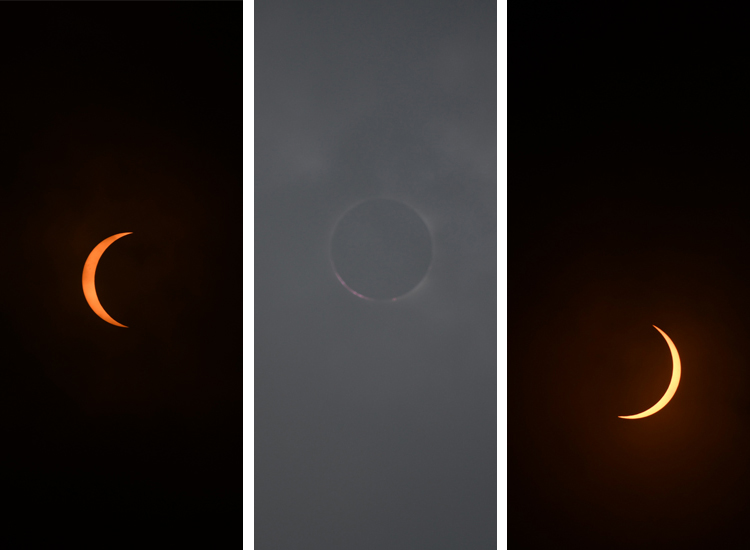
Watch the video as darkness falls during totality in Charleston.
10. Totality in Oregon: The Corona Looked Like an Artist Drybrushed it Across the Moon
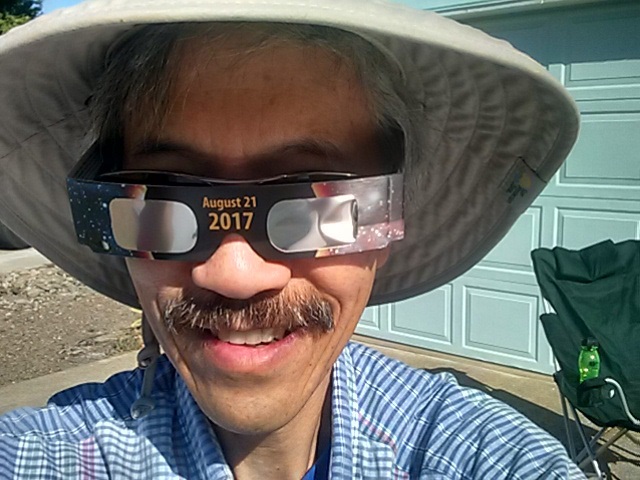
Corvallis, Oregon, had the good fortune of being in the path of totality for the 2017 solar eclipse. Because the eye adapts, the dimming wasn't obvious until about 3/4ths of the sun was covered. At that point, the dimming appeared more like a flattening of contrast, similar to when I'm running a fever.
The last bit of coverage into totality occurs fairly rapidly. Dim shimmering waves of light ran across the top of my old car in the driveway right before totality. These waves were harder to see on the ground but were remarkable on the car roof.
The general color spectrum moved from typical sunlight yellow to a deep dark blue running from black overhead to twilight on the horizon during the totality. It was darker and cooler. The streetlights came on but did not detract from viewing the eclipse. I saw no other stars or planet unlike night time when the summer sky can be filled with them.
The white corona flared out from the circumference of the moon. It was larger than I expected and not of uniform size. The shape was more like an artist had drybrushed it across the moon. There were a couple reddish orange spots beaming from the circumference.

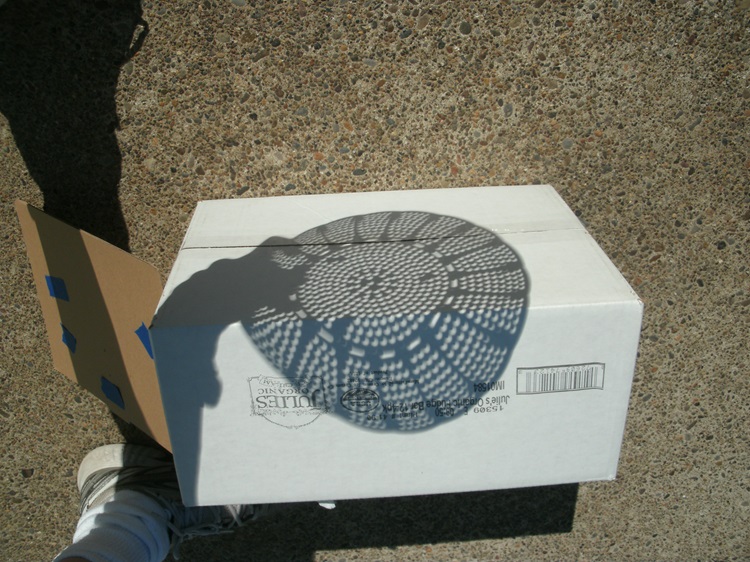
When the totality first occurred, the neighbors on my street and the next street over gave collective exclamations. Birds were quiet including my across-the-street-neighbor's chickens which aren't often heard anyway.
One minute and forty seconds of totality goes by incredibly quickly. Its end is abruptly announced by a brilliant, very white light that shines out from above, as if someone turned on a powerful LED lamp. Brightening is rapid and the streetlights turn off. Color spectrum returns to normal as if one is waking up, although contrast still looks somewhat flat.
Within a couple more minutes, the warmth of the sun is back on.
I'm looking forward to the annular solar eclipse around Eugene, Oregon, in October 2023!
I set my Moto X smartphone on the roof of the car in my driveway and let it record nearly 6 minutes of my street entering, during, and exiting the totality. Right before totality, there are waves of light sweeping across the car roof, which I've never seen in a partial eclipse.
The orange blob that appears on the roof is the reflection of the streetlight turning on. It is later replaced by a bright white blob which is the emergence of the sun. While the sky still is dark at the end of the video, the bright white light emanating from the small arc of sun is very intense as seen on the driveway and my shirt in the last few seconds.
My unedited .mp4 video is currently available.
Brian C. Lee
Corvallis, Oregon
11. The Eclipse in Washington, DC
Amy Dawson, principal at d'nitiatives and a development consultant for Sigma Xi, was driving to a meeting during the peak of the solar eclipse, and snapped some pictures with her NASA Pinhole Projector in the shape of Washington, DC.
"It was amazing to also see the front steps and other outdoor gathering places in DC crowded with people standing outside with their glasses on: the U.S. Captiol, the National Archives, the various federal buildings (and law firms...), plus neighborhood corners. A wonderful moment of awe, inspiration, and community," she wrote.


12. Amazon Recalled My Eclipse Glasses
My eclipse adventure started on the Friday morning preceding with a phone call from an elementary school librarian in adjacent Limestone County. She asked me if I could answer eclipse questions posed by first, second, and third grade students. Those questions were offered up in a series of teleconferences—one per grade—with students assembled in her library. The questions were quite good, better than those I got from local adults, at least modally.
The next bit of adventure was a recall notice from Amazon for my eclipse glasses. I soon discovered there were none to be bought locally, so I spent the weekend re-planning my Monday activities. I have seen several eclipses starting with my days as a graduate student, so I had no great expectation of novelty and asked myself what I had not seen. After some reflection, I realized that in all of those eclipses my attention had been devoted to watching the eclipse proper.
In my early career, I did quite a bit of work on atmospheric optics and I realized that I had never watched the sky light during an eclipse. So, on Monday, I sat and watched the sky light during the eclipse. My location was at about 96% totality so the sky never completely "blackened," and I could watch the sky colors throughout. And the process of comprehending all the scattering flux will continue the adventure for some time.
Bruce W. Fowler
Arab, Alabama
Posts have been edited for length and style.
-
by
User Not Found
| Aug 29, 2017
Sigma Xi's 2017 Nobel Prize prediction contest, October Madness, starts today! After collecting public nominations, we have our lists of possible winners for this year's Nobel Prizes in chemistry, physics, and physiology or medicine.
Click on the links below and cast your Sweet 16 round votes through September 4 to keep your top nominees in the running. Then, check back here on Keyed In on September 6 to see who made it through to the Elite 8 round.
Vote Here
Vote for your Chemistry Nobel Prize predictions
Vote for your Physics Nobel Prize predictions
Vote for your Physiology or Medicine Nobel Prize predictions
New to October Madness?
This is a just-for-fun contest that is not affiliated with the official Nobel Prize. Learn how this contest works in our 2017 announcement.
-
by
John Fennick
| Aug 21, 2017
Dear officers, staff and members,
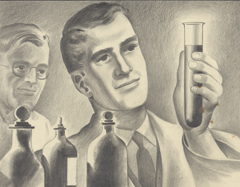 I would like to contribute to the current quarterly conversation about fixing the reproducible science crisis. I suggest this "crisis" should not be considered in the singular. Rather, it is but one aspect of a greater problem to be examined in toto. This is referenced in your introduction to this conversation as a "growing perception that science is not a worthwhile investment" and "...misunderstanding of the scientific process..." It is often called simply, "The War on Science." Fixing "reproducibility" or even a few of the numerous contributors to the problem is placing Band-Aids on a gaping wound.
I would like to contribute to the current quarterly conversation about fixing the reproducible science crisis. I suggest this "crisis" should not be considered in the singular. Rather, it is but one aspect of a greater problem to be examined in toto. This is referenced in your introduction to this conversation as a "growing perception that science is not a worthwhile investment" and "...misunderstanding of the scientific process..." It is often called simply, "The War on Science." Fixing "reproducibility" or even a few of the numerous contributors to the problem is placing Band-Aids on a gaping wound.
I argue the problem lies in communication from a particular branch of science to the public. This includes all aspects, from the initial report, to publications, and to press releases to columnists and science reporters. The information path is broken and pieces are strewn most evenly across the entire channel.
I have given a great deal of thought to this tragedy as I watched it evolve over the past many decades. I have made presentations to science reporters trying to assist them in their impossible task of culling the truths from the deluge of press releases and journal articles but have been unsuccessful in attempts to publish comments. This conversation promises a more receptive ear.
Ideas to Solve the Problem So Far
A brief background to frame my argument:
-
By way of solutions to the problem, Danny Kingsley suggests open research and praises registered reports.
-
Jim Grange says murmurings of low reproducibility began in 2011, and blames pressures, Publish or Perish, etc. and also lauds registered reports.
-
Ottoline Leyser gets closer to the root causes of the problem by summing it up as a publication crises and cites some real reasons for it. She suggests a reward system that might shift research publication emphasis to quality of results as opposed to quantity of "positive" results. She has an excellent synopsis of problems in her article in The Conversation, "The dark side of research – when chasing prestige becomes the prize."
-
There has been discussion of these and similar topics in various blogs but little written material. A noteworthy exception is Shawn Otto's recent 500 page treatise, The War on Science. He blames the demise of respect for science on special interests, operative in various forms since Galileo's time, with but a few passing comments related to any problems internal to science and its practitioners. As corrective measures, he suggests 15 "battle plans," all but one directed outward, away from science itself. Though he does push for a Scientific Code of Ethics, he appears to point his hoses at the smoke rather than the fire. Mr. Otto has done a lot of homework and his writing is compelling but to my mind he misses the point, as do all the blogs and journal articles I have read. Even those that come close focus on but one or two pieces of the broken channel.
Most of these suggestions or recommended changes in procedures are not new. Several authors in many journals have expressed concern about incomplete reporting, publication bias, routes to tenure, catchy headlines, poor reporting, etc. Note, I do not include fraud or cheating here; they are relatively minor, separate issues.
Though blatant fraud and cheating make dramatic headlines from time to time, the real damage comes from the public’s mindset—not from arguments over global warming or whether the "moon landings" were staged in Arizona but rather "when you toy with my health and wellbeing, I pay attention." At least most of the public once did and some still do.
A History of the War on Science
Now, to get a better understanding of what has happened, consider the public view of science during two periods of fairly recent history: roughly mid-19th to mid-20th century and the mid-20th through current times.
That first period might be called a Golden Age of Science as viewed by the public eye. Such a view was indeed justified by the maturing machine age, life improving inventions and, to a great extent, the life-extending medical miracles (life expectancy nearly doubled) wrought in large part by epidemiologists of the era. Health talks and scientific expositions drew large crowds. The Snake Oil Liniment era was crumbling under new scientific methods and recommendations which the public saw to be working. For the better part of 100 years, science was lauded and trusted. That spirit opened funding for several major undertakings such as the Framingham Study in 1948 and the uncountable number that followed and continue today. Recommendations for foods, supplements, and physical activities poured forth.
Perhaps due in large part to the problems cited by Leyser, the public was, and still is, bombarded with poorly based, conflicting, usually erroneous, and simply bad medical advice. Most of it is speculative (reproducible?) and much of it is simply wrong. Nonetheless, it is widely published and (diminishingly) read simply because it DOES affect "MY health and wellbeing."
The flood of increasingly bad reports began shortly after the Surgeon General's report on smoking. Researchers were eager to jump on the bandwagon; it meant funding and tenure. By 1995 the deluge had become so disgusting, E. Ross vented his anger in a Forbes magazine article: "Lies, Damned Lies and Medical Statistics."
A few other examples:
-
L.K Altman. Promises of Miracles: News Releases Go Where Journals Fear to Tread. The New York Times. 1995.
-
M. Angell. Overdosing on Health Risks. New York Times Magazine. 1997
-
M. Angell. Drug Companies & Doctors: A Story of Corruption. The New York Review of Books. 2009.
Yet even today, syndicated medical columnists, posing as experts who should know better, continue to cite single studies, be they good, bad, or indifferent, to support their arguments. So what if they are contradicted next year? Isn't that part of the scientific process?
Given this torrent of ever-changing information about "MY" health and lifestyle, presented as fact, seen as some as "damned lies" but believed, tried, and failed by many, what can you expect by way of public support?
What Scientists and Publishers Can Do
Implementation of the recommendations cited earlier is certainly highly desirable. However, researchers dealing in any aspect of health related subjects, epidemiologists in particular, have a moral responsibility greatly exceeding that of all others. Their papers are the few that are widely circulated, consumed by anxious readers who are inevitably disappointed and ultimately disgusted with all of science.
This group of researchers must stop writing up partial results, avoiding disclaimers, omitting caveats, and commonly exaggerating only positive results.
Peer reviewers must actually do their job, question dubious methods, and demand realistic and honest reporting.
And, yes, journal editors share a lot of the blame. One gets the impression they are competing with check-out counter tabloids. If they claim their journal to be "peer reviewed" all articles should be, and by responsible reviewers, not simply published by editor consensus in order to be first to go to press. Publication bias must stop. Negative results are as important to science as positive ones.
I experienced a striking example of public impression stemming from poor publication practices: In 1990, during casual conversation, I mentioned The New England Journal of Medicine. A colleague instantly spoke up with “Oh, you mean the National Enquirer of the medical world." Sure, one person, one comment, but it was spontaneous and reflected a deep-seated feeling. Perhaps unfortunate that he chose the NEJM, he could have cited any number of others.
No, the cure is anything but easy. A lot of bullet-biting is required but if scientists are really concerned about "evidence ... being discounted and dismissed among ... our population," the very unscientific activities of the past 55-plus years will have to cease. The entire communications channel needs an overhaul. Then, even if this were accomplished, reviving a good public image could take a generation or two. The current disgust was over 50 years in the making.
What Sigma Xi Can Do
If Sigma Xi is sincere in its professed objectives, it must undertake greater proactive measures.
How about:
-
A "Certified Reviewers" group (with stringent entrance requirements, reviewed annually). As opposed to reviewing submissions for publication, such a group would write critiques of published papers, good and bad, acting as a watchdog for the profession. These critiques should be written in concise layman language and might become syndicated, or at least appear in major newspapers as letters, op-eds, or similar.
-
A Best Papers Club wherein membership requires "Excellence in Scientific Writing." It would be important to include journal editors and science writers as well as medical columnists in the pool of candidates. Broad publication of membership would help, perhaps as press releases.
-
Recognizing that Sigma Xi membership and its sphere of influence is limited, it could strongly encourage federal agencies (NIH, etc.) to increase their current efforts on improving reports or initiate them where they have not been started.
-
Recent collaboration efforts by Sigma Xi are a good start at expanding its influence and building muscle. These should continue.
The argument that "honor societies" do not do such things may now be passé as indicated by this "new initiative to promote and cultivate quarterly conversations about issues relevant to our members’ needs and interests."
Sincerely,
John Fennick
Sigma Xi Member Since 1960
Photo credit: Scientists investigating the plague. Wellcome Library, London. https://creativecommons.org/licenses/by/4.0/. Cropped image.
-
by
Jamie Vernon
| Aug 16, 2017
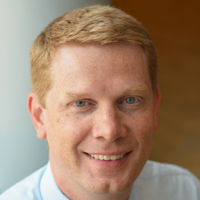
Every so often, a science event comes along that captures the fascination of the public, giving us an opportunity to talk with people about research and why it matters to them.
The next occasion is August 21: the Great American Eclipse. It’s not too late to plan a watch party with your friends, family, or Sigma Xi chapter, or to offer to help with a local event that is already being planned. If you’re not in the path of the total solar eclipse, that’s OK. You might not have to travel because many areas of the country, as well as parts of Central and South America, will see a partial eclipse.
Partial or not, the following ideas will help make your eclipse party a total success.
Eclipse Party Planner
- Use this tool to find out what the eclipse will look like in your area.
- Keep everyone’s eyes safe by ordering certified eclipse glasses, use NASA’s printable pinhole projectors, or see if your library is giving away free eclipse glasses.
- Share copies of Sigma Xi’s Eclipse Viewing Guide.
- Brush up on your solar eclipse knowledge.
- Get involved with NASA’s citizen science project.
- Discuss the partial lunar eclipse that was visible in Asia, Europe, Australia, East Africa, and Antarctica last week.
- Prepare eclipse cookies, fruit rockets, or moon pies.
- Once you see one, you will want to see more so make a list of future solar eclipses in North America.
- Take pictures and tweet them to @SigmaXiSociety or email them to executiveoffice@sigmaxi.org so we can share them.
May your eclipse experience be awe-inspiring.
Sincerely,

Jamie L. Vernon, PhD
Executive Director and CEO
Sigma Xi, The Scientific Research Honor Society
Publisher of American Scientist
-
by
User Not Found
| Jul 26, 2017
 October Madness, Sigma Xi's Nobel Prize prediction contest is back for its third year!
October Madness, Sigma Xi's Nobel Prize prediction contest is back for its third year!
How it Works
Sigma Xi collects nominations from the public and then runs weekly voting to advance researchers on our sports-style brackets. We hope you join in the fun as we wait for the official Nobel Prize announcements in October. But we need your nominations to get the contest kicked off! This is another way we can promote researchers and their incredible achievements.
We are calling for 16 nominations each for the:
How to Nominate
Anyone can nominate and vote; Sigma Xi membership is not required to participate in October Madness. Send in your nominations by 11:59 p.m. PDT on August 24 by using our nomination form or email me at hthorstensen@sigmaxi.org.*
Please include:
-
Your nominee's name (you can submit as many nominations as you would like and you can submit a group of researchers who worked on a project together)
-
Which Nobel Prize you think this person, or group, should win
-
The reason why you think the person, or group, should win (such as, "for the discovery of XYZ")
-
The institution of employment or affiliation for your nominee(s)
-
Your name and email address
How to Vote
We will announce the October Madness nominees on August 29 and open the brackets for voting on Keyed In. You can also follow along on Sigma Xi's social media accounts on Twitter, Facebook, and LinkedIn. Remember to use #OctoberMadness! Vote each week on Tuesdays, except for Labor Day week when voting will be held on September 6.
Prizes
If you nominate someone who goes on to win a Nobel Prize, you will be entered into a raffle. Raffle winners who are not Sigma Xi members will receive a free year in the Sigma Xi Affiliate Circle** (a $70 value), which includes a one-year subscription to American Scientist magazine. Members, affiliates, or explorers who win the raffle will have their dues paid by Sigma Xi for 2017–18. Those who already renewed will have their dues paid for 2018–19. We will select one winner per Nobel Prize category for a total of three winners.
Schedule
July 26–August 24: Send in your nominations
August 29: Nominees announced; Sweet 16 voting begins and runs through September 4.
September 6: Sweet 16 winners announced; Elite 8 voting begins and runs through September 10.
September 12: Elite 8 winners announced; Final 4 (Semifinals) voting begins and runs through September 17.
September 19: Final 4 winners announced; Finals voting begins and runs through September 24.
September 26: Announcement of 2017 October Madness Winners.
October 2–9: Official Nobel Prize winners named.
October 5*: Winners announced from the raffle for a year in the Sigma Xi Affiliate Circle or a free year of dues for members, affiliates, or explorers.
*If Sigma Xi receives less (or more) than 16 nominations per prize, then its staff will select the nominees who are put on the bracket. But we prefer to use your nominations! Please nominate anyone you feel is worthy of the prize. Potential candidates might be found here, here, here, or here. October Madness is not affiliated with the Nobel Prize.
**Affiliate Circle status does not qualify one for full or associate membership in Sigma Xi's nomination-based honor society.
Example of last year's final bracket for Chemistry
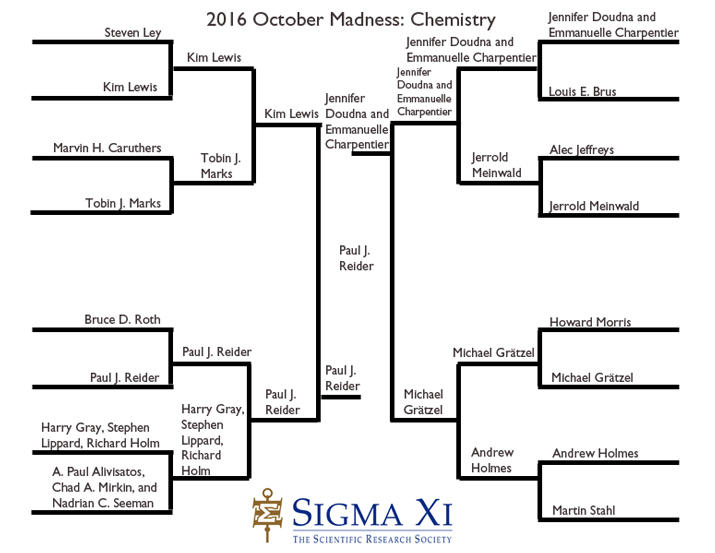
See other 2016 brackets.
Sigma Xi looks forward to receiving your nominations!
Heather Thorstensen is manager of communications for Sigma Xi, The Scientific Research Honor Society.
*The winner of the drawing/raffle was originally scheduled to be announced on October 10, but was rescheduled to October 5.
-
by
Aaron Huertas
| Jul 25, 2017
Randy Olson is a scientist-turned-filmmaker who left a tenured position as a marine biologist in the 1990s to go to film school and pursue a career in Hollywood. Since then, he’s made several films, including Flock of Dodos: The Evolution-Intelligent Design Circus, which aired on Showtime for more than two years. He’s also the author of Don’t be Such a Scientist: Talking Substance in an Age of Style, the second edition of which will be published in early 2018.
His more recent book, Houston, We Have a Narrative: Why Science Needs Story, is the basis of Olson’s Story Circles training, which he’s deployed at the National Park Service (NPS), the U.S. Department of Agriculture, Genentech and other scientific institutions. A recent NPS report on preserving cultural sites used Olson’s “and, but therefore” (ABT) narrative template to tell stories about what’s happening to protected sites around the country as the climate changes.
I reached Olson over the phone at his home in Los Angeles, California. Our conversation has been edited for length and clarity. And in full disclosure, I’ve worked on one of Olson’s trainings and he compensated me for my time and travel costs.
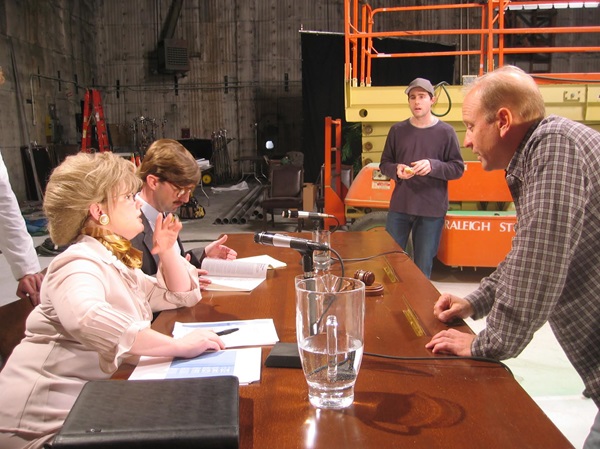
Olson, far right, directing “Senate Hearing on Coral Reef Decline,” a short satirical film starring Melissa McCarthy and Jim Rash.
You bridge these two very disparate worlds. What does Hollywood understand about communication that science doesn't?
Hollywood has been the incubator of the practical side of narrative in our society for a century. People have lived entire lives here based on one thing: their ability to use narrative. As a result, they have boiled narrative down to its ruthless, shortest, most concise, most powerful, most punchy, most effective elements.
In communication, there's the structure and the content. Hollywood has got the strength in the structure, it's lacking content. Academics are infatuated with their content, but lack appreciation for structure.
So what does moving from content-based to structure-based communication look like?
Right now, I'm working with the American Association for the Advancement of Science’s (AAAS) Invention Ambassadors. These are people who are used to talking to other people in the science world about their inventions. Now they're talking to the educated general public, including other professionals in DC. The challenge is to take these presentations they've been giving for years to an audience that wants to know about the specifics of their invention and instead talk about being an inventor in today's world. That means prioritizing not the content, but the structural story elements and looking for human stories people can connect with.
How did you start to develop this idea of an “and, but, therefore” narrative template? I think when people hear me describe the “ABT” they often think it can’t really be that simple. But it’s really a powerful concept.
I managed to at age 38 basically do a brain transplant experiment. I pulled my brain out of academia and into the narrative world of Hollywood. And I’m a whole lot better at narrative today than I was then. But that said, I can’t tell stories the way the great Hollywood screen writers can. It's been a journey for me to grasp what they tried to tell us the first day of film school, which is that the most important thing you’re going to learn here is story.
When I made Flock of Dodos, we shot it, we glued it together, and for six weeks, the movie had virtually no narrative structure to it. It was just a bunch of information. It was, “and, and, and.” Finally, I came up with a very simple story to structure it around, which was the journey of a guy trying to figure out what’s behind this controversy. Everything transformed overnight. That was the definitive proof for me of how it works, but I still didn’t have any ability to articulate what I’d gone through in that transformation.
In 2011, I saw a documentary about the making of South Park and the creators, Trey Parker and Matt Stone, talked about this very simple technique they use. They call it the rule of replacing. They go back into their script and every time they encounter the word “and” ask themselves if they can replace it with a “but” or a “therefore.” Every time they can, the storytelling gets more interesting.
I never heard storytelling put that simply or more precisely. And when I dug deeper I found my way to legendary screenwriting instructor Frank Daniel whose course I had at USC the year before he died. He is the first one I can find to call attention to the power of these words for narrative structure.
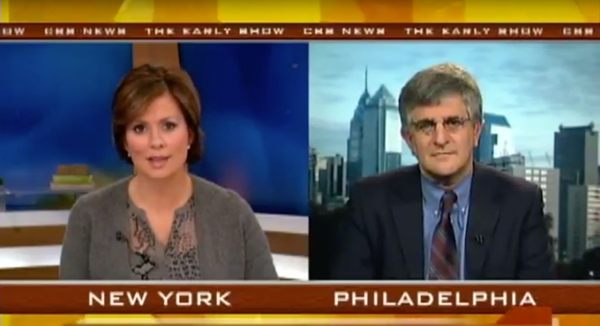
When I first reviewed your book, I showed you a Paul Offit interview I often use in workshops and you summarized one of his “ABTs” very neatly: My wife was giving a child a vaccine AND right before she gave him the shot, the child had a seizure BUT if the shot had come first, the parents obviously would have thought the shot caused the seizure THEREFORE we can’t trust anecdotes, we have to trust data and science when it comes to vaccine safety. Later I learned that this is a story Offit uses constantly. How do you work to train people on communication and help them identify concrete stories like that?
The Groundlings say improv is like a muscle; you can’t get good at in one day. With improv you’ve got be doing it over and over again, conditioning yourself. Increasingly, I’m of the opinion that one-day workshops send the message that you can get really good at it with some tips and tools. Not gonna happen. So we do ten one-hour sessions. It’s intuitive, not intellectual. It begins with a one-day workshop we call a demo day and we pull in up to 50 people. At the end of the demo day, they sign up for Story Circles, if they’re serious about doing this training. And each Story Circle consists of five to six people who work on storytelling together with my coaching each week.
You’ve also pointed to a 1999 speech that Michael Crichton, the author of Jurassic Park and all these other mega-hits, gave to AAAS. And it’s such a shame that Crichton would go on to become very critical of climate science, because he did have a lot of valuable things to say about how we do communication in science. What stood out to you about his speech?
He really was the smartest brain for the science world when it came to mass communications and they didn’t listen to a thing he said. It was a blueprint before the anti-science movement had really taken off about how to deal with it. He said the science world should figure out key spokespeople for different disciplines. He also said the information era will be dominated by those who manipulate the media. And academics say they don’t want to get involved in manipulating the media. But look deeper. Media is narrative. That’s what drives media. You don’t get on TV if you don’t have a strong narrative quotient or narrative index to what you’re doing. If you want to go on and on about your issue, you’ll wind up on PBS where they’ll let you drone on and on and nobody watches you, but if you want to be on the other networks, you have to understand concision and structure to boil your message down under those constraints.
These aren’t options. These are obligatory aspects of communications. Why the science world thinks it gets special dispensation and can somehow communicate differently is just mind-boggling.
So who would you point to working today in science communication that’s doing it well?
“Science communication” is almost a contradiction in terms. In a lot of ways, there’s no such thing as “science” communication. There’s just communication. These principals are universal. If you don't have deep intuition for narrative, you're never going to communicate effectively.
I can’t point to anything in the science communication world, but I can point to HBO Real Sports with Bryant Gumbel. Month after month they tell amazing stories that have nothing to do with sports, but have to do with human beings. These stories can be told just as well in the science world, but it’s never been the instinct. Science folks love science and so they focus on the science. They appeal to the gee-whiz crowd, but don’t broaden anything beyond the science world.
But here’s the catch. Narrative has been around for at least 4,000 years. These are core, inviolable principles. It is the landscape for communication. Yet science is smart. Which means scientists should be teaching the world how to communicate, rather than still trying to figure it out for themselves.
Aaron Huertas will be a speaker at the Student Research Conference on November 11 in Raleigh, North Carolina. He is the founder and principal of Science Communication Media, a consulting firm in Washington, DC.
-
by
Jamie Vernon
| Jul 19, 2017
Sigma Xi Speaks, July 2017
Sigma Xi is starting a new initiative to promote and cultivate quarterly conversations about issues relevant to our members’ needs and interests.
Q1 Topic: Can Sigma Xi Fix the Reproducible Science Crisis?
 When people ask me what’s great about Sigma Xi, one aspect I often refer to is the membership pledge. It encourages our members “to maintain honor, integrity, and honesty in all scientific activities.” Every member makes this pledge. It distinguishes Sigma Xi from other scientific organizations.
When people ask me what’s great about Sigma Xi, one aspect I often refer to is the membership pledge. It encourages our members “to maintain honor, integrity, and honesty in all scientific activities.” Every member makes this pledge. It distinguishes Sigma Xi from other scientific organizations.
The pledge is especially important now because science has a perception problem. Scientific evidence is being discounted and dismissed among certain segments of our population. Yet, the scientific process is our best way of gaining an understanding of the world around us. It is crucial for those who conduct research to practice it in a way that preserves the public’s confidence. After all, most basic research is financed by public funds collected through federal taxation. Those who are footing the bill should be certain that they’re getting a good return on their investment.
Unfortunately, there is a growing perception that science is not a worthwhile investment. I say “perception” because we know that science and technology continue to be the primary drivers of innovation and economic growth in the United States. Yet, budget debates in Washington, DC, have increased the scrutiny of investments in science and have forced the scientific community to defend the merits of federally funded research.
Recent revelations about the irreproducibility of numerous published scientific studies have compounded the problem. Some would argue that the reproducible science problem constitutes a crisis. Others suggest that the concern is based on a misunderstanding of the scientific process or unfair expectations for science.
This is where I believe Sigma Xi holds a unique opportunity. Not only should Sigma Xi members be calling on all of their qualified students and colleagues to take the Sigma Xi pledge, but also we can take meaningful steps toward addressing the problem of reproducibility.
Quarterly Conversations
During the first quarter of this fiscal year (July 1 – September 30), Sigma Xi will publish content and share resources related to the topic of reproducible science. Members, affiliates, and explorers are encouraged to come together for discussions about this critical issue and are invited to share the results of your conversations—by sending an email to executiveoffice@sigmaxi.org. Members can also use the discussion titled, “Can Sigma Xi Fix the Reproducible Science Crisis?” in the online member community, The Lab, to address this topic.
Sigma Xi’s history as a leader on issues in science and technology will serve as a template for advancing this global conversation. Given the vast creativity, experience, and wisdom of our membership, we believe there is an opportunity to develop some useful recommendations on how to address this issue.
To get you started, we've prepared the following questions about the topic:
-
Is this a real problem or is it a misunderstanding of the scientific process?
-
What is the role of publishers in disseminating irreproducible science?
-
How does the current tenure system contribute to this issue? Are tenured and tenure track professors under too much pressure?
-
Would greater data transparency and more collaboration improve the reproducibility of research results?
-
Can students be trained to avoid/overcome the pitfalls and problems related to reproducibility?
We will collect your thoughts and experiences to inform other members. In addition, we will spotlight successful events in a variety of ways, by inviting you to summarize the discussion in blog posts for Sigma Xi’s blog, by including them in Sigma Xi Today, by organizing discussion sessions at the 2018 annual meeting, and other useful ways.
Below are some resources you can use to inform your discussions with your fellow members, colleagues, affiliates, and explorers. Tune in for more information as this conversation progresses.
Published Papers:
• Estimating the Reproducibility of Psychological Science
• Paving the Way to More Reliable Research
• Reproducibility Project: Cancer Biology
Videos:
• Is There a Reproducibility Crisis in Science?
• Video from Sigma Xi Honorary Member Derek Muller: Is Most Published Research Wrong?
In future quarters, you can expect other important topics to be discussed. I hope you'll use these occasions to build companionship with your students and colleagues.
Sincerely,
Jamie L. Vernon, PhD
Executive Director and CEO
Sigma Xi, The Scientific Research Honor Society
Publisher of American Scientist
-
by
Aaron Huertas
| Jun 27, 2017
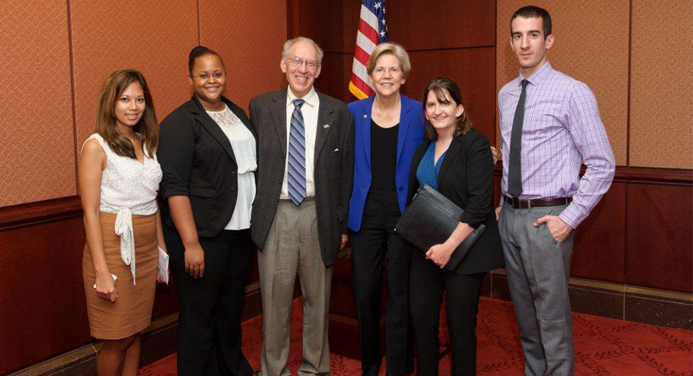
Brandeis University scientists visit Sen. Elizabeth Warren (D-Mass.) to talk about the value of funding life sciences.
There’s significant demand for scientific expertise among state and federal legislative offices. Researchers looking to inform policymakers about their work should consider supplying it, especially in areas where legislators lack their own in-house expertise. Doing so not only helps politicians make more informed decisions, but it can also help researchers think differently about how their work can serve the public.
Developing an effective relationship with a legislative office requires good preparation, trusted guides, and a willingness to follow up, even when policymakers disagree with the scientists they work with.
-
by
User Not Found
| Jun 20, 2017
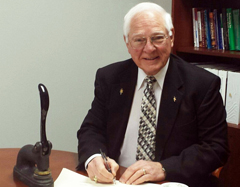
In October 2015, I wrote that becoming interim executive director and CEO of Sigma Xi for six months was a singular honor. Now, some 21 months later, I was correct. It has been the single greatest honor of my long and varied career. It is no secret that the Society has had some very tough spots in recent years. My tenure has been a series of challenges and opportunities. The path I’ve traveled has been lighted by the vision, mission, and culture of our great institution. I strove to rebuild and grow where possible and to set out a series of plans and notions that your new leadership team can pursue, refine, and retool to accomplish the heights of promoting the highest ethical standard of behavior and the best attainable quality of research achievement.
In May, I reported to the Board of Directors that “the basic organizational structure and function, as well as the operational paths forward for governance, membership, communications & publications, and philanthropy are in place to achieve a bright future for Sigma Xi.” Now, I ask you to please engage with Dr. Jamie Vernon, your new leader as executive director and CEO, starting July 1. He has a fantastic grasp of who we are, where we should go, and how we can get there, but Sigma Xi is a membership- and chapter-based organization; you too must take hold and go with him. I know I will.
Finally, a great wave of scientific awareness has arisen. Primed by the March for Science, more of us recognize that this country’s research investment traditions are at peril, and people everywhere are feeling the urge to revive interest and participation in all things science. Sigma Xi is a beacon of clarity for the research enterprise…the underpinning for the human need to produce innovation and improve the common lot.
Thank you for having entrusted me with our Society.
Kids Science Reading Corner
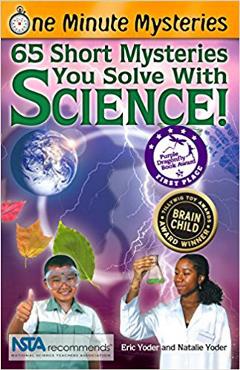 I have a few final book recommendations for the young scientists in your life. What could be more intriguing than a mystery? Or better yet, a science mystery!
I have a few final book recommendations for the young scientists in your life. What could be more intriguing than a mystery? Or better yet, a science mystery!
• I Wonder, by Annaka Harris, illustrated by John Rowe (ages 1 and up): A young girl poses questions about a range of natural phenomena and learns about the science behind them. Yet she also learns that mysteries—and exciting discoveries—remain.
• One Minute Mysteries: 65 Short Mysteries You Solve with Science, by Eric Yoder and Natalie Yoder (ages 8–12): Readers can solve the short mysteries in this book using scientific details within the stories themselves. (The other titles in this terrific series are One Minute Mysteries: 65 More Short Mysteries You Solve with Science and One Minute Mysteries: 65 Short Mysteries You Solve with Math.)
• The Complete Sherlock Holmes, by Arthur Conan Doyle (teens and up): These classic tales hold up brilliantly, and their forays into Victorian-era science only make them more fascinating. Young adult fans of Mr. Holmes with an especially keen interest in science might want to check out The Scientific Sherlock Holmes and Mastermind—more here.
Sincerely,

John C. Nemeth, PhD
Executive Director and CEO
Sigma Xi, The Scientific Research Honor Society
Publisher of American Scientist
Sigma Xi Speaks is a monthly series of information that we hope you share with others.
-
by
User Not Found
| May 17, 2017

Saturday, April 22, 2017, is a day I won’t forget. And I’d venture that, for nearly anyone who joined the March for Science that day—whether they were in Washington, DC, or any of the other 600 cities that held marches—the event was unlike anything they’d seen. City streets overflowed with a combined one million scientists and advocates of science, all there to celebrate the incalculable value and pervasive impact of scientific research. Amazing!
As I’ve reflected on the March for Science with Sigma Xi colleagues, we’ve come to realize that for us—even as the event galvanized energy worldwide around science outreach—it also served as a potent reminder that our organization must remain steadfast in achieving its mission.
It’s imperative that we sustain the momentum of the movement propelled by the March for Science. Political winds change over time and ideologies may come and go, but we know that science literacy and research are foundational to a peaceful and thriving U.S. and world economy.
Moving forward, as we aim to both nurture and protect the health of the research enterprise, Sigma Xi seeks opportunities to expand its public presence as science guardians—on multiple levels and in diverse environments—while continuing to stand firm in the commitment to preserve and attain the highest standards of quality and ethics in scientific research.
Sigma Xi is committed to advancing science and advancing the benefits of scientific research, and we are a stalwart champion of evidence-based policymaking that supports the common good. We will persevere in our efforts to encourage leaders in Washington and all levels of government to prioritize scientific research funding, science education, and science-based policy. Now, and into the future, your continued support is vital in conserving a functioning science enterprise. As always, we encourage feedback, ideas, and participation. To share your thoughts, contact us at executiveoffice@sigmaxi.org or drop me a line at jnemeth@sigmaxi.org.
Kids Science Reading Corner
As we consider new ways of reaching out as scientists, thinkers, and communicators, it’s a great time to think about how kids can experience the sciences creatively, too. Here are some books that may help:
(cropped).jpg?sfvrsn=fbf0b958_2&MaxWidth=&MaxHeight=155&ScaleUp=false&Quality=High&Method=ResizeFitToAreaArguments&Signature=534F06F699752B194DF5C2A19404A3C8) Hello Nature: Draw, Color, Make, and Grow, by Nina Chakrabarti (ages 7–11): Despite its targeted age range, kids much younger than seven are sure to enjoy this book, too. Its charming illustrations and straightforward nature activities (identifying trees by their leaves, for example, and sketching discoveries from nature walks) encourage thinking, creating, and getting outside to observe the natural world. Younger readers may need help with some of the projects, such as making leaf prints, but that in itself can be part of the fun.
Hello Nature: Draw, Color, Make, and Grow, by Nina Chakrabarti (ages 7–11): Despite its targeted age range, kids much younger than seven are sure to enjoy this book, too. Its charming illustrations and straightforward nature activities (identifying trees by their leaves, for example, and sketching discoveries from nature walks) encourage thinking, creating, and getting outside to observe the natural world. Younger readers may need help with some of the projects, such as making leaf prints, but that in itself can be part of the fun.
Professor Astro Cat’s Intergalactic Activity Book, by Zelda Turner, illustrated by Ben Newman (ages 7–11): This colorful and innovative activity book—which was inspired by the first title in the Astro Cat series, Professor Astro Cat’s Frontiers of Space—will have kids drawing their own constellations, sketching robots they’d like to invent, and ever so much more.
I Love Science: A Journal for Self-Discovery and Big Ideas, by Rachel Ignotofsky (preteens and up): I Love Science easily stands on its own, but it’s worth mentioning that it can also be seen as an extension of Ignotovsky’s 2016 title, Women in Science. Quotes from groundbreaking women in STEM appear throughout the journal, and writing prompts (such as “What natural phenomena would you like to witness and why?”) encourage young writers to think introspectively while also imagining how they might engage with the world.
Sincerely,

John C. Nemeth, PhD
Executive Director and CEO
Sigma Xi, The Scientific Research Honor Society
Publisher of American Scientist
Sigma Xi Speaks is a monthly series of information that we hope you share with others.
-
by
User Not Found
| Apr 19, 2017
 Sigma Xi staff is wrapping up final details as we ready ourselves to board our charter bus bound for the April 22 Washington, DC March for Science. We welcome you to
join us—a few available seats
remain—but we also welcome active participation in the satellite marches in and around your hometowns.
Sigma Xi staff is wrapping up final details as we ready ourselves to board our charter bus bound for the April 22 Washington, DC March for Science. We welcome you to
join us—a few available seats
remain—but we also welcome active participation in the satellite marches in and around your hometowns.
As the first science organization to partner with the worldwide event and serve as a fiscal sponsor for several of the satellite marches, Sigma Xi is proud to stand as a mentor organization that will demonstrate ongoing commitment to the cause.
The March is not a one-off. We believe it’s imperative that this apolitical and nonpartisan movement fosters the highest ethical standards and promotes the highest possible quality in all research endeavors,
nurturing the basis for continued investment and trust in the scientific research enterprise.
Sigma Xi’s deep involvement in the March for Science therefore resonates with
Citizen Science Day 2017, a monthlong series of regional events
celebrating and highlighting ways everyone, young and old, can engage in science to make a difference. I encourage you to participate in the numerous
volunteer opportunities across the country to help the planet.
Our very mission and vision require us to reach out with a sound and robust voice to everyone. Accordingly, growing and diversifying citizen science is one of Sigma Xi’s areas of emphasis. We do this through our
Affiliate Circle program for the public and young researchers, such as undergrads, and through our
Sigma Xi Explorer
program for K–12 students. We are also in the early stages of forming a pilot between our Sigma Xi Explorer program and the GlobalXplorer project, so stay tuned for more details.
Citizen science projects are among the best ways I know to get kids involved in science and spur their enthusiasm. These books introduce youngsters to the concept of citizen science and may help them find projects that capture their interest.
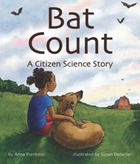 Bat Count: A Citizen Science Story, by Anna Forrester, illustrated by Susan Detwiler (ages 4–9): Readers follow Jojo and her
family as they perform an annual bat count on their farm, helping res
earchers learn about the impact of white-nose disease.
Bat Count: A Citizen Science Story, by Anna Forrester, illustrated by Susan Detwiler (ages 4–9): Readers follow Jojo and her
family as they perform an annual bat count on their farm, helping res
earchers learn about the impact of white-nose disease.
Citizen Scientists: Be a Part of Scientific Discovery from Your Own Backyard, by Loree Griffin Burns, illustrated by Ellen Harasimowicz (ages 8–12): Focusing on projects involving frogs, ladybugs,
butterflies, and birds, this inspiring book describes the work of citizen scientists of all ages and how their data can aid research.
Citizen Scientist:
Searching for Heroes and Hope in an Age of Extinction, by Mary Ellen Hannibal (teens and up):
A compelling memoir by a terrific storyteller. Hannibal describes how her work as a citizen scientist helped her cope with grief and live her life more fully.
Those interested in getting the whole family involved as citizen scientists—an approach
I heartily recommend—may want to check out Citizen Science Guide for Families: Taking Part in Real Science, by Greg Landgraf.
Getting outside and making scientific observations together can be great family fun, while also helping kids see how their contributions can make a
difference. “Citizen Science Saturdays” has a nice ring to it, don’t you think?
Thank you for being a science advocate. Help us celebrate science by contributing in ways large and small, because it makes a difference in the world.
Sincerely,

John C. Nemeth, PhD
Executive Director and CEO
Sigma Xi, The Scientific Research Honor Society
Publisher of American Scientist
Sigma Xi Speaks is a monthly series of information that we hope you share with others.
-
by
Jamie Vernon
| Apr 17, 2017
This is a guest post written by Aaron Huertas.
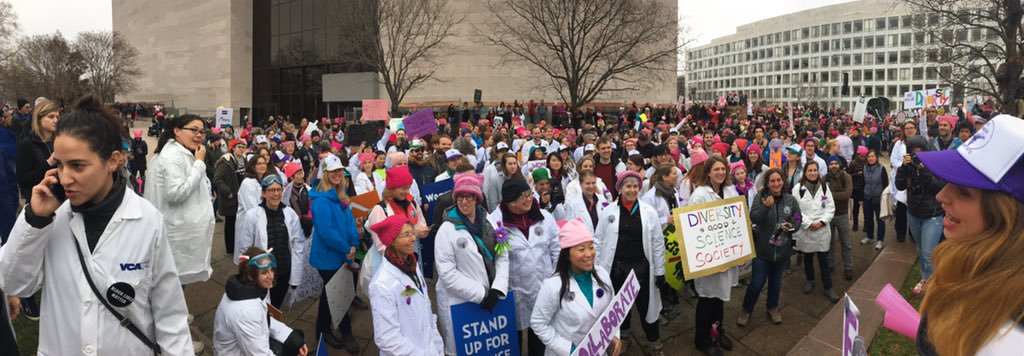
Thousands of researchers are getting ready to march for science in more than 400 cities around the world. But even as the scientific community galvanizes in the face of censorship and deep budget cuts, researchers are grappling with how they should engage in the political process. As the march approaches, it’s important for scientists and engineers to think objectively about what advocacy means to them and to find their personal comfort zone when it comes to fitting activism, advocacy and political engagement into their careers.
Uncharted territory
It’s easy for scientists to talk past one another when they talk about advocacy.
John Kotcher, a postdoctoral research fellow at the Center for Climate Change Communication at George Mason University, is one of a few researchers who has put received wisdom about advocacy to the test. “Surprisingly very little research has looked into the topic of advocacy by scientist directly,” he says.
He notes that scientists lack common language and definitions around advocacy. When he and his colleagues tested whether or not making advocacy statements would impact a scientist's perceived credibility, they relied on a rubric from Simon Donner, a climate researcher at the University of British Columbia. Donner argues that science communication tends to fall on a spectrum of advocacy, from needing to find support for one’s own work, to publicly sharing relevant science, to warning about risks, to helping policymakers weigh decisions, to explicitly endorsing specific policy outcomes, to backing specific tactics to achieve those outcomes.
Using mock Facebook posts from a climate researcher, Kotcher and his colleagues found that study participants perceived a scientist as just as credible if they stuck to the facts, warned readers about climate risks, or endorsed emissions reductions from power plants. When the scientists’ Facebook post advocated for relying on nuclear power, they took a slight credibility hit, but Kotcher says it’s not clear why that was the case.
Their research challenges the conventional wisdom that advocacy always comes at the cost of perceived objectivity. But attitudes toward advocacy also vary by field, Kotcher says. Health professionals, for instance, may have different expectations around advocacy given their dedication to improving people’s well-being.
Indeed, when Dr. Mona Hanna-Attisha - an honorary March for Science co-chair - blew the whistle on lead poisoning in Flint, Michigan’s water, doing so came with political risks. She took on a state government that had falsified data and she prevailed despite public employees’ attempts to dismiss her research. In such cases, the ethical imperative to warn the public about danger is clear. Dr. Hanna-Attisha, herself a first-generation Iraqi immigrant, has also spoken out against the co-called “Muslim ban,” pointing out that more than 10,000 U.S.-licensed physicians graduated from schools in the seven countries targeted by the Trump administration. More than 150 scientific societies have spoken out against the ban, too, noting how it harms not just scientists, but also the communities in which they work.
Tell Your Own Story, Or Someone Else Will Tell it for You
Gavin Schmidt, a NASA climate researcher, argues that advocacy is largely unavoidable. Even the idea that science should play a greater role in a policy 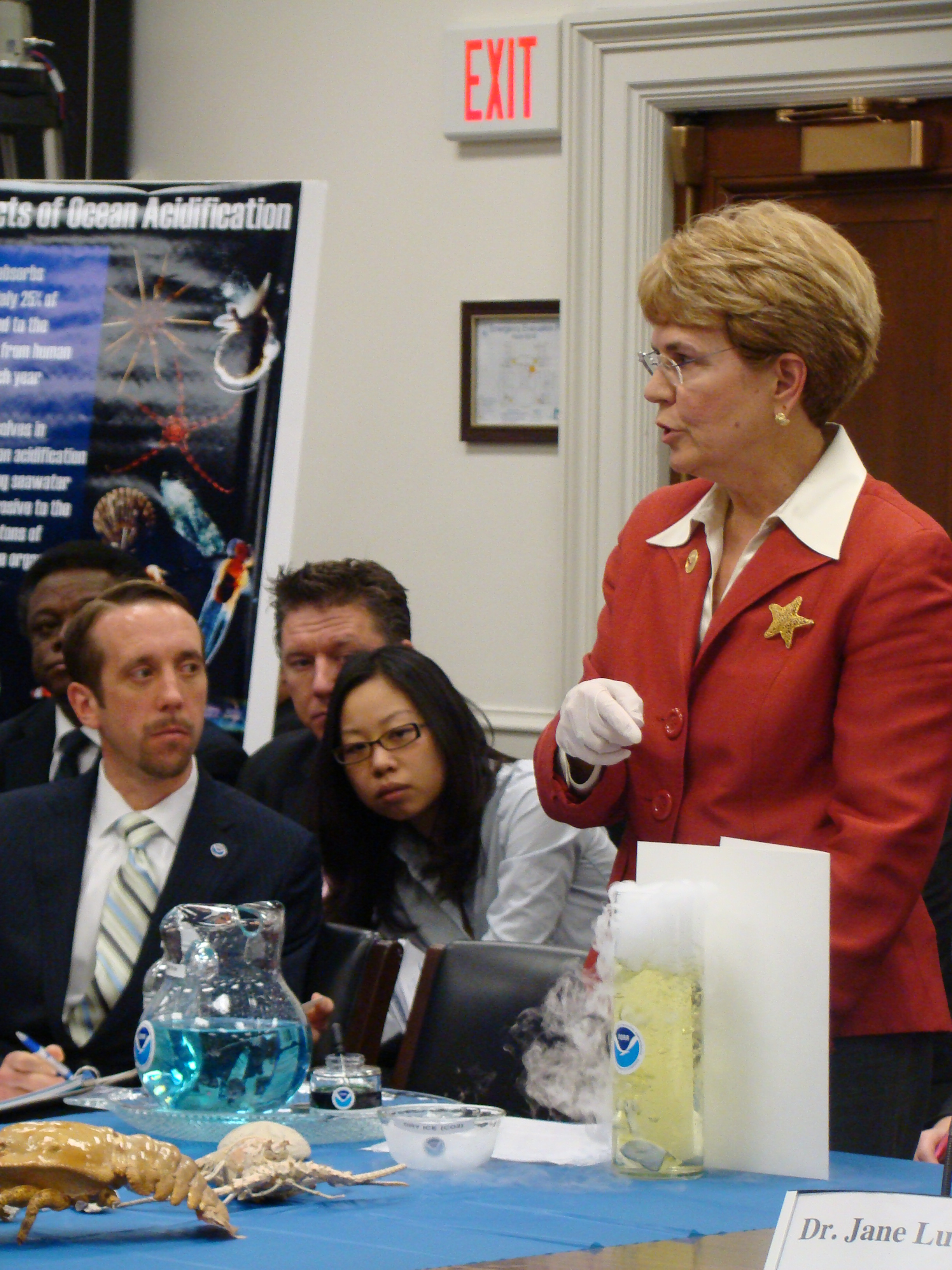 debate can rest on a set of judgments that audiences outside the scientific community might not share. Schmidt urges his fellow researchers to be transparent about their beliefs, their values and their opinions and to draw distinctions between their scientific research results and their personal views. When scientists fail to tell their side of the story, he cautions, audiences can fill in the blanks with inaccurate ones, such as the idea that scientists are personally enriched by public grants.
debate can rest on a set of judgments that audiences outside the scientific community might not share. Schmidt urges his fellow researchers to be transparent about their beliefs, their values and their opinions and to draw distinctions between their scientific research results and their personal views. When scientists fail to tell their side of the story, he cautions, audiences can fill in the blanks with inaccurate ones, such as the idea that scientists are personally enriched by public grants.
For Josh Shiode, a senior government relations officer at the American Association for the Advancement of Science (AAAS), such accurate storytelling is critical for effective communication, regardless of where scientists sit on the advocacy spectrum.
“Advocacy is engaging with people who are not part of your field and talking about why what you do is important,” he says, whether that’s talking to a Rotary Club or meeting with a Congressional staffer.
Shiode often points to National Institutes of Health-funded research, which found that gently massaging rat pups with small brushes improves their health. It’s the kind of research some policymakers might deride as wasteful. But it eventually led to effective medical treatments for premature babies, cutting hospital stays for them by an average of six days.
To develop a better story sense, Shiode urges researchers to follow science writers like Ed Yong and organizations like Story Collider. AAAS also works with Randy Olson, a scientist-turned filmmaker, who has written extensively about the power of accurate storytelling.
Approaching Advocacy with Humility
Peter Loge, a former Obama-era Food and Drug Administration appointee and a veteran of several Capitol Hill offices, says scientists who engage in the policy process should recognize that science is part of a bigger picture.
Scientists, he says, commit the same “sins” many other interest groups do, insisting that policymakers should simply adopt their values. Scientists usually want to solve “cool, interesting problems,” he says, but the benefits of funding scientific research, while evident to scientists, can often seem far-off to elected leaders, their staff, and voters.
It’s therefore a mistake, he says, for scientists to assume policymakers are being stupid or venal when they fail to prioritize a scientific view of the world. “Scientists have to be willing to believe the people with whom they’re working and they are advising are good people with the best interest of the country at heart,” he says. Policymakers “are weighing things that scientists may not fully appreciate and with which scientists may or may not agree.”
Loge urges scientists to focus on the immediate benefits communities receive from their work - think jobs, investments, and clean water - as well as the long-term gains we all enjoy from publicly funded science and evidence-based policy.
Indeed, the most important voices in the March for Science may not be the scientists themselves. It may be the people outside the scientific community who are joining them: farmers who work with agricultural extension offices, coastal business owners who rely on the National Oceanic and Atmospheric Administration, grandparents who remember life before the polio vaccine.
And the people of Flint, who are still waiting for clean water.
Because when scientists identify how their research benefits society, they can become not just advocates for their own work, but advocates for the communities they serve, too.
Aaron Huertas is an independent science communicator who lives and works in Washington, DC. He runs ScienceCommunicationMedia.com, serves as co-boss for Nerd Nite DC and volunteers with the March for Science.
Update: John Kotcher was originally listed as a graduate student and research assistant at the Center for Climate Change Communication at George Mason University. His title has been revised.
Image one: 500 Women Scientists rallying during the Women's March outside the National Air and Space Museum (Source: Christy Till, via Twitter)
Image two: Former NOAA administrator Jane Lubchenco demonstrates the effects of carbon dioxide on ocean acidification during a Congressional hearing. (Source: Office of Sen. Ed Markey.)
-
by
User Not Found
| Mar 22, 2017
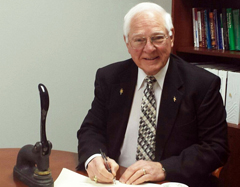
March is Women's History Month, and I’d be hard-pressed to think of a year since the designation began in 1987 when the history of women in science was more visible. The Oscar-nominated movie Hidden Figures has contributed to this welcome development. The film has drawn belated but well-deserved attention to the American women in science and technology—notably, mathematicians Katherine Johnson and Dorothy Vaughan and engineer Mary Jackson—who gave their nation a competitive edge during the space race. If you enjoyed the movie (or the terrific book it’s based on by Margot Lee Shetterly), I’d invite you to learn more about Mary Sherman Morgan as well, the chemist who in 1957 formulated a liquid fuel called Hydyne for the Jupiter-C rocket used to launch America’s first satellite, Explorer 1. Her son George D. Morgan wrote a captivating book about Morgan and her research, which he discusses with the BBC here.
Sigma Xi is proudly participating in Women’s History Month by celebrating women's contributions to science, technology, engineering, and math. Our Women in STEM feature shows a diverse range of women who strive daily to solve problems and promote achievement in classrooms, labs, and industry, in countless locales across the world.
Our online profiles highlight the accomplishments of a small sampling of women, from a population rich in education and experience. No matter their research specialties, the hallmark of these fearless pioneers is science advocacy—they share what they know and guide others toward a path of success. In turn, the individuals they advise generously champion future generations. Such kinship among bright minds makes the world a better place for everyone.
Sigma Xi recognizes and encourages this cooperative spirit among scientists, among men and women, and across all disciplines. Chapters provide an array of ways for members to engage with and further this spirit—by advancing educational opportunities through scholarship and collaborations, by nurturing curiosity and passion, and by exploring new ideas and places within the science community.
Kids Science Reading Corner
What better time than Women’s History Month to share books about pioneering women in science? Hailing from a range of disciplines, the women featured in these books all made important contributions to science.
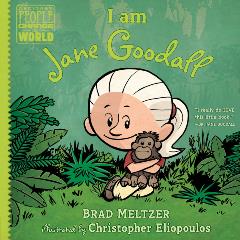 I Am Jane Goodall, by Brad Meltzer (ages 5–8): This volume of Melzer’s Ordinary People Change the World series shows how Goodall did just that. She remains an influential figure, and her pathbreaking primatology fieldwork, beginning in 1960, came at a vital time.
I Am Jane Goodall, by Brad Meltzer (ages 5–8): This volume of Melzer’s Ordinary People Change the World series shows how Goodall did just that. She remains an influential figure, and her pathbreaking primatology fieldwork, beginning in 1960, came at a vital time.
Sally Ride: Life on a Mission, by Sue Macy (ages 8–12): The story of Sally Ride—a physicist and the first female astronaut—may be unfamiliar to youngsters. Macy’s thoughtful biography aims to inspire a new generation.
Finding Wonders: Three Women Who Changed Science, by Jeanine Atkins (ages 10 and up): In this three-part book in verse, Atkins recounts the fascinating lives of naturalist Maria Sibylla Merian, paleontologist Mary Anning, and astronomer Maria Mitchell.
Incidentally, high schoolers may also be interested in Hidden Figures and Rocket Girl, mentioned above.
Young readers could hardly find better role models than the women found in these books: Each is determined to follow her own path, courageous in the face of opposition, and passionate about her work. In fact, I’d say they’re pretty good role models for everyone!
Sincerely,

John C. Nemeth, PhD
Executive Director and CEO
Sigma Xi, The Scientific Research Honor Society
Publisher of American Scientist
Sigma Xi Speaks is a monthly series of information that we hope you share with others. Find past articles on this blog.
-
by
User Not Found
| Mar 01, 2017
This is a guest post written by Barry Mitsch.
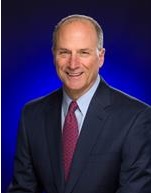 It is becoming clear that the scientific community is going to be challenged by the new administration in Washington. Appointees to agencies funding scientific research have expressed disdain for findings that do not fit their political agenda. It is the responsibility of everyone who values scientific research to show the value science plays in future advancements that contribute to economic growth and improved quality of life.
It is becoming clear that the scientific community is going to be challenged by the new administration in Washington. Appointees to agencies funding scientific research have expressed disdain for findings that do not fit their political agenda. It is the responsibility of everyone who values scientific research to show the value science plays in future advancements that contribute to economic growth and improved quality of life.
There are many ways to project a message in today's digital world. It is easy to send a text or a tweet, author a blog, or submit a paper. But the real power of communicating an idea still resides in personal contact and sharing passion with both large and small groups who can then amplify the message through multiple mediums. Regardless of their field of expertise, now is the time for scientists to be speaking to schools, civic clubs, public meetings, and forums of all sizes.
A powerful scientific message must be concise and relatable to a general audience. Forget all the complicated data. Drill down to what is practical and makes sense to the person on the street. A good example of a simple scientific presentation is the TED talk delivered by Al Gore in February of 2016 on the status of climate change remediation efforts.
There are three techniques that Gore uses that any scientist can incorporate into a speech to a general audience.
1) Set an agenda
First, notice how he sets a very clear agenda that makes it easy to follow his content. He states that his talk will address three questions: Must we change? Can we change? And will we change? This gives the audience a roadmap and a clear identification of the topic categories in his speech. As he transitions into the segments of the presentation, he reminds the audience of which question he is addressing.
This pattern of "threes" is simple and can form the framework of any scientific talk. For example, you could first introduce the challenge your research is addressing with emphasis on how this has an impact on day-to-day life, then segue into what you are discovering and what these discoveries may mean, and finally talk about the long range impacts of the research on the general public.
2) Use metaphors
The second technique that Al Gore employs is the frequent use of metaphors to simplify his concepts and make them more relatable to a broad audience. For example, when he talks about the amount of energy released through burning carbon fuels, he equates it to 400,000 Hiroshima bombs going off each day. As gruesome as that sounds, people vividly know what the Hiroshima explosion looks like. When he talks about the potential for rapid adoption of new alternative energy technologies, he relates it to the speedy advancement of cell phone use. And when he talks about "grid parity" and the openness of markets to alternative energy, he uses the relationship of ice and water to emphasize the small difference in a frozen market and one with liquid capital.
Scientist need to find metaphors that make their concepts relevant to a lay audience. How can you relate technical topics to something familiar and understandable?
3) Weave in personal stories
Finally, Gore uses personal stories. He finishes his speech recalling his experience as a 13-year-old listening to John F. Kennedy challenge the country to land a man on the moon. Personal stories can be exceptionally powerful for scientists reaching out to non-technical audiences. Stories promote empathy and can create an intimate connection that makes their presentation more memorable.
So the challenge is for scientists to use public speaking to launch a massive public relations campaign. It can be simple. Compartmentalize your research into three parts that tell a story. Look for metaphors and examples that make it easy for anyone to understand the importance of your work. And don't be afraid to bring your personal experiences into the presentation.
Barry Mitsch, of the Pyramid Resource Group, has been conducting presentation skills workshops for more than 25 years and specializes in working with scientists and engineers. He has worked with individuals and groups using video-based programs, classroom workshops, and virtual coaching. He holds a Master's of Science in Public Health and his research was in the field of radiation physics. He provides communication coaching to Sigma Xi members. If you have a question or comment about this post, you may post it below or email Lisa Mumma, interim manager of communications, at lmumma@sigmaxi.org.
-
by
User Not Found
| Feb 21, 2017

Where will you be on April 22? For many in the research community, the day is marked on the calendar for the March for Science in Washington, DC, or at one of the sister marches planned for cities around the country and around the world.
Momentum for the marches is picking up steam, and Sigma Xi has joined in as a partner. The Society recognizes that this opportunity to promote research in an apolitical and nonpartisan manner is critical. We support the organizers’ goals of encouraging the use of science in policy decisions and encouraging scientists to speak out in their communities about the research they do and why it’s important.
I encourage you to find a March for Science near you, and see how you can get involved. Perhaps your Sigma Xi chapter can work with local organizers to nominate public speakers, help with logistics, or provide scientific expertise. If you’re not in a chapter, spread the word about the march in your area.
If you participate, tell the people you meet about Sigma Xi and encourage them to join our team, either as a member, an affiliate, or an explorer. We want to share the value of research. The more voices we have, the better. Remember, this is about being FOR SCIENCE, not against anything or anyone.
Kids Science Reading Corner
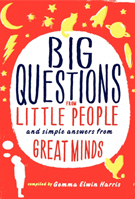 How many unanswered questions might we have today if generations of scientists hadn’t had the freedom to conduct research and share their results? These books help convey the breadth of questions scientists strive to answer—and they can also serve as a catalyst for discussion.
How many unanswered questions might we have today if generations of scientists hadn’t had the freedom to conduct research and share their results? These books help convey the breadth of questions scientists strive to answer—and they can also serve as a catalyst for discussion.
• First Encyclopedia of Science (ages 5–10): This book aims to satisfy young kids’ curiosity, unraveling such mysteries as why objects fall as well as why some things float and others sink.
• Big Questions from Little People, by Gemma Elwin Harris (ages 8 and up): Scientists and science communicators, among others, answer kids’ questions, helping them understand the world as we know it, as well as the broader universe.
• The Handy Science Answer Book (ages 9 and up): A comprehensive science reference book, set up in a question-and-answer format.
With luck, these books might lead kids to ask even more questions—ones they might research themselves someday.
Sincerely,

John C. Nemeth, PhD
Executive Director and CEO
Sigma Xi, The Scientific Research Honor Society
Publisher of American Scientist
Sigma Xi Speaks is a monthly series of information that we hope you share with others. Find past articles on this blog.
-
by
User Not Found
| Jan 17, 2017
 Infectious tropical diseases are spreading to new areas, partly thanks to climate change and to the ease with which we travel nowadays. It’s important that we are aware of the threats in our areas and that, as scientists, we can share sound, research-based information with those around us.
Infectious tropical diseases are spreading to new areas, partly thanks to climate change and to the ease with which we travel nowadays. It’s important that we are aware of the threats in our areas and that, as scientists, we can share sound, research-based information with those around us.
Sigma Xi member Peter Hotez is a leader on research involving diseases that disproportionately afflict the world’s poorest people. As coeditor-in-chief of PLOS Neglected Tropical Diseases, founding dean for the National School of Tropical Medicine at Baylor College of Medicine, U.S. Science Envoy for the U.S. Department of State, and president of the Sabin Vaccine Institute, he predicted that the Zika virus would come to the United States in 2016. Now he has published a list of global infectious disease threats to the United States for 2017.
Dr. Hotez, whose daughter has autism, also speaks out against the anti-vaccination movement. Due to the number of students who are not being vaccinated, he predicts that Texas will start seeing measles outbreaks as early as the winter or spring of 2018.
I hope you read his materials on diseases and share them with people around you. Without due vigilance, we may all be increasingly vulnerable.
Kids Science Reading Corner
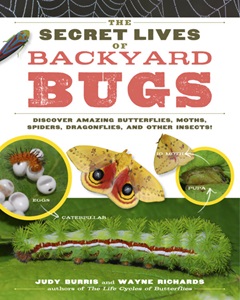 It’s also important to share information about insect-borne illnesses with the kids in our lives, especially if they live in (or will be traveling to) affected areas. Those in Florida, Texas, and other Gulf-area states may want to check out this flyer from the U.S. Centers for Disease Control and Prevention about how to talk to kids about Zika, as well as the CDC’s activity book “Mosquito Bites Are Bad,” designed to teach kids how to protect themselves from mosquito-borne illness.
It’s also important to share information about insect-borne illnesses with the kids in our lives, especially if they live in (or will be traveling to) affected areas. Those in Florida, Texas, and other Gulf-area states may want to check out this flyer from the U.S. Centers for Disease Control and Prevention about how to talk to kids about Zika, as well as the CDC’s activity book “Mosquito Bites Are Bad,” designed to teach kids how to protect themselves from mosquito-borne illness.
Although hearing about viruses such as Zika and West Nile can be worrying for kids, learning more about insects in general may help them react to these creatures with curiosity instead of dread. Here are a couple useful titles:
For ages 4–8: Bugs Are Insects by Anne Rockwell and Steve Jenkins
For ages 9 and up: The Secret Lives of Backyard Bugs by Judy Burris and Wayne Richards
Armed with great books, kids can appreciate that there’s so much more to a bug than its bite!
Sincerely,

John C. Nemeth, PhD
Executive Director and CEO
Sigma Xi, The Scientific Research Honor Society
Publisher of American Scientist
Sigma Xi Speaks is a monthly series of information that we hope you share with others. Find past articles on Sigma Xi's blog, Keyed In.
-
by
User Not Found
| Dec 21, 2016
This is a guest post written by Barry Mitsch.
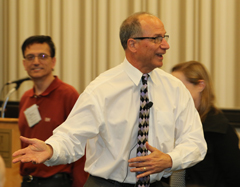 Nowadays when technical professionals are asked to give a presentation, they typically begin their preparation by creating some slides using a popular software program that will be projected when speaking to an audience. But is this technology improving presentations or creating a barrier between the speaker and the audience?
Nowadays when technical professionals are asked to give a presentation, they typically begin their preparation by creating some slides using a popular software program that will be projected when speaking to an audience. But is this technology improving presentations or creating a barrier between the speaker and the audience?
While technology has created exciting tools for speakers, the fundamental elements of a presentation have not changed since the days of Aristotle. Any successful presentation must be well organized, delivered by a credible speaker, and customized to a specific audience.
Customizing your presentation requires information gathering. Speak to the meeting planner to learn about who is expected to attend, and talk with colleagues who have presented to this group in the past. Ask questions related to audience expectations and the technical background of the typical attendee. It's also a good idea to know who is speaking before or after you as you may want to look for tie-ins with your subject matter.
So what about the technology? Technology is simply a tool. YOU are the presentation, not the technology. Great technology will not overcome poor content. A great presentation can be delivered without a single slide. Abraham Lincoln, Winston Churchill, Martin Luther King Jr., John F. Kennedy … they all crafted memorable speeches without a laptop computer. The key is using the technology correctly to enhance your spoken words.
A common mistake made by many speakers is to begin planning a presentation by first creating visual aids. Scientists often have data that are important to their talk and these data often drive the development of a presentation. The data for a given presentation should be selected only if it helps the speaker achieve the objective for a specific audience. Once the content of a presentation has been thoroughly developed, it is time to ask the question, “What data and supporting visual aids will enhance the audience's understanding of what I am saying?”
Any visual aid needs to meet four criteria in order to be successful. First, it has to be necessary. In other words, you have reached the conclusion that a visual aid will be helpful in delivering your message.

Slide 1
|
|
Slide 1 is an example of an unnecessary slide. It contains statements that could be made during the introduction to a presentation.
|
Next, decide on the most appropriate format that will meet the criterion of clarity—the best way to show an idea. There are infinite ways to create effective visual aids, not all of which require technology. Demonstrations, displays, and photographs are all low-tech approaches. Be selective and continually ask if this is the best way to support your spoken words. The third criterion is simplicity—the best visual aids are simple.

Slide 2
|
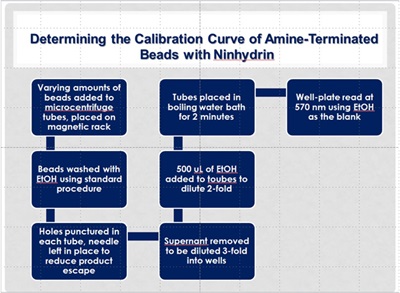
Slide 3
|
| Slide 2 is an example of a slide that doesn't achieve clarity. It is describing a process, and the ideal way to demonstrate the concept would be to use pictures. Alternatively, slide 3 shows the content from slide 2 and improves its clarity by simplifying the words as much as possible and creating a diagram that indicates a process. Building each block of the diagram will also make it easier for listeners to follow the explanation of the process. |
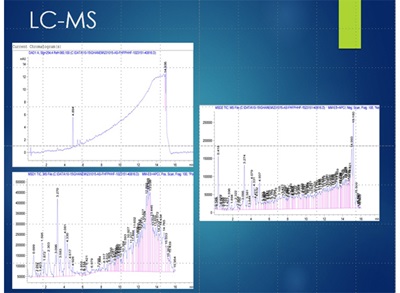
Slide 4
|
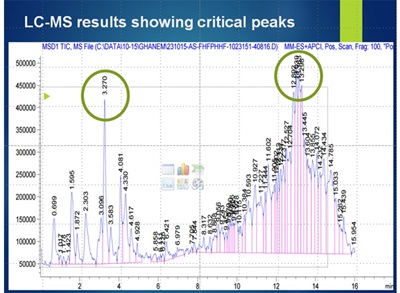
Slide 5
|
| Slide 4 can be improved by showing the graphs on separate slides to improve its simplicity. Slide 5 shows only one of the graphs, adds a more descriptive title, and adds circles to direct attention to places on the slide having the most importance. |
And the fourth criterion is visibility— they must be clearly seen. Obviously a visual aid must be visible to be effective but how many times have you seen a presenter display a computer-generated slide and say, “I know you can’t read this, but let me tell you what it says.”
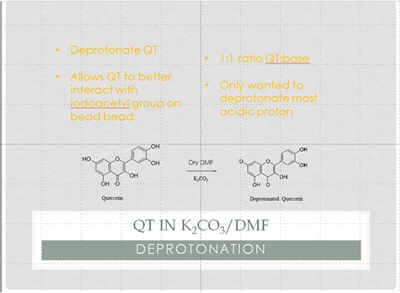
Slide 6
|
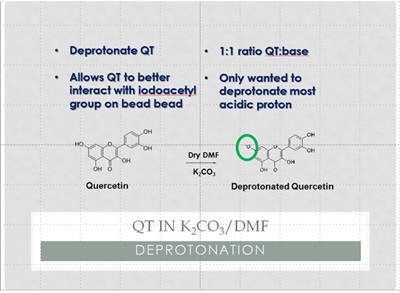
Slide 7
|
| Simple changes can improve Slide 6. Improvements are shown in slide 7. Changing the color and adding bold font and shadow to the main text makes it easier to read, as does changing the font size and boldness in the minor text. In addition, a simple circle denotes the location on the deprotonated quercetin molecule where the chemical composition has changed. |
Here are some tips to help you meet the criteria of simplicity and visibility while using computer-generated visual aids:
-
Each slide should convey ONE main concept. Complicated slides lead to audience confusion.
-
Try to avoid text slides but if you must use them, limit the number of words per line to 5 and the number of lines per slide to 5.
-
If possible, limit the numbers of bars and lines in graphs, preferably no more than 5. Of course if your data require more than five, use only what is necessary to support your message.
-
Use only sans serif type styles such as Arial, Helvetica, and Tahoma—they project more clearly than serif styles.
-
Use the largest type sizes possible and try to avoid text that is less than 24 point.
-
For computer projection, stick to dark backgrounds with light text to increase visibility.
-
Limit the use of color—use color to direct attention to areas of a slide that are important.
-
Use computer "builds" (sequentially revealing information) to maintain focus on points as you present, but be selective in using this tool. Builds can also be used for charts, graphs, pictures, and complicated scientific slides.
-
Be consistent in using slide transition animations; varying the transitions from slide to slide can be distracting.
Computers are the most valuable presentation tool yet to be invented, but speakers need to realize that they are just a tool. There is no substitute for solid content delivered with confidence and conviction. By applying the ideas presented in this article, you will maximize the use of technology in achieving success with all of your presentations.
Barry Mitsch, of the Pyramid Resource Group, has been conducting presentation skills workshops for more than 25 years and specializes in working with scientists and engineers. He has worked with individuals and groups using video-based programs, classroom workshops, and virtual coaching. He holds a Master's of Science in Public Health and his research was in the field of radiation physics. He provides communication coaching to Sigma Xi members. If you have a question or comment about this post, you may post it below or email Heather Thorstensen, manager of communications, at hthorstensen@sigmaxi.org.
-
by
User Not Found
| Dec 20, 2016

Sigma Xi is taking its first steps to help ensure that research in America will continue to attain the highest standards in the coming Trump administration. I call on you now for your participation.
The Society and 28 other research associations signed a letter to President-elect Trump to request a meeting with his transition team. A top priority for the meeting would be to suggest candidates to populate a full array of science and technology posts, such as the positions listed here. See a full list of more than 8,000 positions involved in the transition in the Plum Book.
I would like you to send recommendations of who could fill the research-related posts to transitionnames@sigmaxi.org. Please try to consider the following.
-
Name submissions should include succinct biographical information, qualifications, and if possible a business photograph.
-
Realistically speaking, names should also, if possible, carry the active endorsement of the more influential Republican senators (or other high-ranking members of Congress).
An election does not change science. Climate change, for example, is having serious impacts around the world. Sigma Xi will continue to provide the best possible scientific research guidance to our government. One way to ensure the kind of research enterprise that we and the world have come to expect is to make certain that the highest quality people are performing federal research.
Thank you for your dedication to Sigma Xi and to research. We look forward to your nominees.
Kids Science Reading Corner
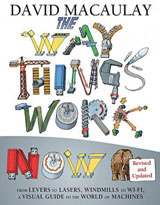
As we look ahead to 2017, I hope you will continue encouraging the youngsters in your life to read about the wonders of science. We have a wealth of reading suggestions for both younger kids and older kids—everything from Babies Love Quarks to Mind-Boggling Numbers.
If you wish to choose only one, The Way Things Work Now is among the most comprehensive and satisfying science titles for kids in recent memory. A revised and updated classic, it appeals to a wide range of ages with its clear, smart approach to scientific principles and illuminating, whimsical illustrations.
Sincerely,

John C. Nemeth, PhD
Executive Director and CEO
Sigma Xi, The Scientific Research Honor Society
Publisher of American Scientist
Sigma Xi Speaks is a monthly series of information that we hope you share with others.
-
by
User Not Found
| Dec 14, 2016
By Paul R. Sanberg
Editor's Note: The following remarks were written by Paul R. Sanberg for his John P. McGovern Science and Society Award lecture, which he presented at the Sigma Xi 2016 Annual Meeting in Atlanta, Georgia. Sanberg is the senior vice president for Research, Innovation, & Economic Development and a distinguished university professor at the University of South Florida. He is also the executive director of USF’s Center of Excellence for Aging and Brain Repair and the president of the National Academy of Inventors. A main message of his lecture was that researchers have a meaningful role to play in society by sharing the benefits of their discoveries with other people.
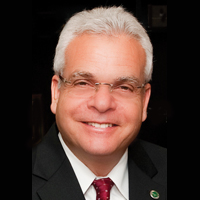 Good evening everyone! Thank you very much for that warm welcome and thank you for this tremendous honor.
Good evening everyone! Thank you very much for that warm welcome and thank you for this tremendous honor.
It is with deep gratitude and humility that I accept the John P. McGovern Award, and I thank the members of the awards committee, the board of Sigma XI and all its members for this very special recognition.
There is no more gratifying moment in a career than when your colleagues and peers single out your work, and even more so when the award bears the name of a transformative figure in American medical research and healthcare philanthropy.
The son of a surgeon who graduated from Duke University School of Medicine, John P. McGovern taught at George Washington University Medical School and Tulane Medical School. He established the McGovern Allergy Clinic in Houston and created the Texas Allergy Research Foundation. He held 17 professorships, received 29 honorary doctorates, and authored over 250 professional publications and books.
His expertise in asthma and immunology was groundbreaking, and his exemplary leadership record included serving 15 professional medical societies.
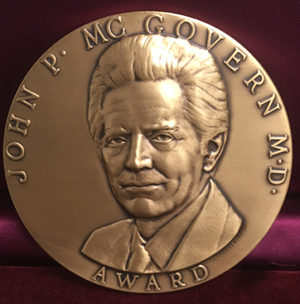 He was known far and wide as a “medical humanist.” Despite his many years immersed in medicine, he later would recount that the most important influence on his life had not been his father the surgeon or the many other great physicians he trained and worked for, but his grandmother who would feed the poor during the Great Depression.
He was known far and wide as a “medical humanist.” Despite his many years immersed in medicine, he later would recount that the most important influence on his life had not been his father the surgeon or the many other great physicians he trained and worked for, but his grandmother who would feed the poor during the Great Depression.
He once told the Houston Chronicle: "I learned from watching my grandmother that giving and receiving is the same thing. I could see in her eyes that it made her feel good. … I think everybody's got an empty spot inside, and I call it the God-sized hole that we have to fill. And you can't do that with Caesar's world stuff — money, property, prestige. That doesn't fill that hole. Love does ... Love, in the sense of deep caring."
After his death in 2007 at the age of 85, his friends would say that Dr. McGovern’s motivation to make new discoveries in medical science, was never about prestige or wealth, but to honor and improve the human condition.
I can think of no better thing to be said about someone who pursues a path in the sciences. This award takes on very special meaning for me because it reminds us all of the larger calling to serve humankind that is embedded in scientific discovery, invention and innovation.
The urge to explore and discover is not always about the unknown.
Sometimes it is about discovering what is inside of us. … Often, it is about embracing our own truths, and fully realizing that what means most is not the awards or recognition we achieve for ourselves, but in how our talents and abilities can serve others.
***
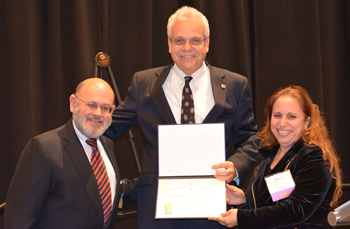 Scientists are born curious—at least I think I was, and I bet each of you has similar memories of being a child and exploring some of the same basic ideas that now are central to your research portfolio.
Scientists are born curious—at least I think I was, and I bet each of you has similar memories of being a child and exploring some of the same basic ideas that now are central to your research portfolio.
You know that commercial with the “Most Interesting Man in the World,” whose tag line is: “Stay Thirsty, my friends”.
I think a better line for people in the scientific professions is “Stay Curious, my friends”
because it’s that curiosity that will lead to exploration, discovery, and innovation.
You and I are fortunate to be alive in a time of such remarkable technological change, where global interconnectivity has transformed not only how we communicate and can collaborate, but allows discoveries to spread at the speed it takes to hit the “send” button.
But sometimes, what produces the most meaningful science is what happens closest to home. And today I am going to talk a little bit about the journey: where it starts, where it can lead, and why, in the most desperate moments, you’ll find your path forward.
This is my personal story, but I have found the experience is universal.
This is my colleague at the University of South Florida, Merry Lynn Morris. Some of you might have seen her work in inventing a dance chair featured on Katie Couric’s show and in Reader’s Digest. Merry Lynn has revolutionized mobility for those with disabilities by working with engineering students to produce a wheelchair that moves more fluidly through redesigned engineering and wireless technology.
Merry Lynn is actually a dance professor at USF, but she was motivated to develop this technology because, as a little girl, her father had been paralyzed in a car accident.
She just wanted to be able to dance with him, and his bulky wheel chair wouldn’t allow it. Decades later, she would create the dance chair by working with our engineering students and incorporating it into a mixed-abilities dance group she leads.
And this is my friend and colleague David Vesely at the USF Morsani College of Medicine. David has spent his career conducting breakthrough research on how cardiac hormones might control cancer. He was drawn to this work after his wife, Clo, died of breast cancer, leaving him with five children.
David’s research had already shown these hormones prevented heart cells from growing too big, and in the aftermath of his wife’s death, he wondered what they could do to prevent tumor growth.
In his lab, David has killed the deadliest forms of cancer with these hormones, including pancreatic, breast, lung, colon, prostate, and kidney cancers. In one experiment, his fourth son was working with him in the lab and witnessed the cancer cell destruction with his very own eyes. Can you imagine a more personal—yet scientifically triumphant—moment?
Through this family’s tragedy, clinical trials and, hopefully, new drugs will emerge. Exploring. Discovering. Moving forward. Sometimes that’s all you know how to do.
***
My story begins in Hialeah, Florida, and looking back on my earliest memories of being in school, I can appreciate those moments that steered me to a career as a research scientist, inventor, and entrepreneur.
One of my early memories is being six or seven years old—right in the middle of the Space Race—and being asked to come on to a local Miami television show where they would give certain children math questions to solve. Looking back at that experience, it was incredibly encouraging.
My family later moved to California. My mother and father worked hard to achieve the American dream for our large family, and I was the first in our family to earn a bachelor’s degree.
I was a very typical teenager of the times: I was into music, loved sports and was interested in flying. But science had a constant tug on my attention.
In high school I had a wonderful biology teacher, Mrs. Haddick, who introduced me to a subject that fascinated me and was the start of what I’ve worked on my entire life. Years later, when I was a professor at the University of Cincinnati, to my surprise, Mrs. Haddick came to hear me speak at a conference for biology teachers. Afterwards, she let me know that she was proud to see the accomplishments of one of her students. Her belief and encouragement made an impact on me as a teenager, and meant a lot to me as an adult.
At York University, where I did my undergraduate degree, one of the jobs I took to pay my tuition was working in a physiological psychology lab where the researcher was running lab tests on rats. I was enthralled.
By my third year, I was conducting my own research projects and publishing my work in very well-known journals. I greatly admired the professor whose lab I worked in, but I was surprised how that innate curiosity of a young man elicited the opposite reaction I’d expected.
My new ideas were met with skepticism and derision. My discoveries were questioned, and it rocked my confidence.
But you know what’s more powerful than criticism? Curiosity.
I learned at an early age—and the hard way—that scientific research requires patience and perseverance.
Looking back now, I realize how much those years shaped my outlook in wanting to build a supportive and encouraging community for innovators and inventors—to make those who challenge conventional thinking be appreciated for their talents and their drive to discover and invent.
And then my world was rocked by an experience so personal, yet so universal, it put my whole career into new perspective.
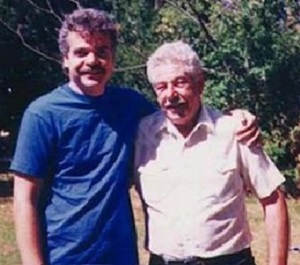 My father, Bernard Sanberg, suffered a severe stroke. At the time, I was already deep in neurological research, looking at Parkinson’s disease and how to treat the effects of this devastating condition.
My father, Bernard Sanberg, suffered a severe stroke. At the time, I was already deep in neurological research, looking at Parkinson’s disease and how to treat the effects of this devastating condition.
But even with all that expertise, I cannot tell you how powerless I felt in those seemingly endless hours and days by my dad’s bedside when the answer to every question was: “There’s not much we can do.”
That was 1994, and my father was living in Houston when he suffered the stroke. The University of Texas Health Sciences Center, where he was treated, is an excellent hospital. But the treatment that was provided for him was pretty rudimentary—it was what the doctors had learned in medical school, and it hadn’t evolved much since they learned it. Every day I’d ask them: “Why don’t we try something new?”
But there wasn’t anything new to try. How could that be? There are about 750 thousand people a year who suffer strokes in the United States, and it’s the leading cause of disability nationwide.
There were millions of people standing by … with not much more than a clot-busting drug and hope that rehabilitation will work.
I couldn’t help my Dad much sitting by his bedside, but I thought that if I could get back into my lab, I could find a better way.
That’s when I refocused my work and began researching novel stem cells as a promising treatment for stroke.
I took two approaches: One looking at the direct injection of stem cells into the brain and, also, at intravenous treatments. Incredibly, when the human brain has dying cells, it produces a protein that signals the body to send new stem cells—which can become brain cells—through the blood–brain barrier.
Your body is actually doing it all the time. But in a stroke patient, the blood–brain barrier opens, but then it can close over time. We have a limited window after an acute stroke to take advantage of the opportunity to repair the brain.
We looked at stem cells from bone marrow and then, later, umbilical cord blood, as well as adult stem cell sources, like mesenchymal stem cells, epidermal stem cells, and cells from other organs.
By 1998, we were able to even use a tumor-derived cell for direct injections into the brain. The results were very encouraging. By 2000, we were testing cultured neural stem cells in stroke patients, and we were seeing good results.
But there is an overwhelming challenge on getting these cells to the damaged area of the brain. Direct injections require expensive neurosurgery and, there are so many stroke patients who could use this therapy, that there simply wouldn’t be enough practicing neurosurgeons to perform the procedure, if it were available to all sufferers.
Add in all of those with Parkinson’s, Alzheimer’s, or other neurodegenerative diseases who also might benefit from this therapy, and you’d see that the only way to make this treatment impactful on a global scale is to find an easier, less expensive, and equally effective method. That would be intravenous injection.
Fifteen years after my father suffered his stroke, the first stroke patient was enrolled in a clinical trial to see if using his own bone marrow stem cells through an IV injection could help his recovery.
Bud Heinrich was treated by my colleague and friend Sean Savitz—coincidentally at the very same hospital in Houston where my dad had been hospitalized.
And if you think that is a notable coincidence, let me add one more twist that seems particularly special today: That hospital is the teaching hospital for the McGovern Medical School at the University of Texas—named after the same John McGovern we celebrate today.
At the time of that clinical trial, the journey for this research was just beginning—but, in a way, it had come full circle.
The stem cells were harvested from the bone marrow in the iliac crest of Bud’s leg, and then separated and returned by IV to his body after several hours.
When he arrived at the hospital, Bud could not speak and had significant weakness on his right side. When he was released, after nearly two weeks of hospitalization and rehabilitation, he was able to walk … and climb stairs unassisted … and said his first words.
Unfortunately, my Dad had passed away a decade before that clinical trial started. I’ll never know if all this work could have helped him. But I know he would have been glad, and proud, that it helped others.
***
Scientific discovery is just one part of the equation. If you want to have an impact on the world, getting your science to the people it can help the most is imperative.
Knowing that these discoveries needed to get out to clinics and to patients, I looked to the entrepreneurial side of research: patenting new cell technologies and helping to start companies that could take new therapies to market.
I was lucky to be at the University of South Florida—a young university that gave faculty latitude to pursue commercialization of their work, and later would become one of the leading universities nationwide in encouraging technology transfer.
I founded a company in 1999 as an incubator company at USF. A year later, our current president, Judy Genshaft, arrived and set a tone in leadership to support and encourage faculty-led startups and entrepreneurial efforts.
Today, USF is a Top 25 public research university and is in the top 6 percent nationally in license and option agreements and has been among the top 10 public universities in the U.S. for patents for the past six years.
Leadership matters in creating an entrepreneurial culture. Everybody loves it when an academic researcher invents a great new technology that pushes the world forward and produces huge amounts of licensing revenue—but very few institutions have created an environment that truly supports the process that leads to those big breakthroughs.
I thought it was important to change that.
In early 2009, I wondered how many of my colleagues were inventors, so I sent out an invitation to the USF faculty, inviting those who were patent holders to come and have lunch. I thought a dozen people might show up, but more than 100 did.
Think about that! I’d been at this university for more than 15 years at this point and didn’t even know how many academic inventors were in my own community. That’s how little we talked about our work, and shared our experiences.
Soon after, the USF Academy of Inventors was established to recognize inventors on campus for their accomplishments in patents, licensing, commercialization, and startups.
As I shared this concept with my counterparts at leading research universities around the country and the U.S. Patent and Trade Office, it quickly became apparent there was a national need to change the culture within academia, at a time when our society was struggling in the midst of the Great Recession, and needed to leverage the innovative power of its research universities.
The National Academy of Inventors (NAI) just didn’t give us a “club” to call our own, it focused attention on the huge benefit of academic invention and the value it brings, not only to academic institutions, but to society at large.
That was just six short years ago, and today, the NAI has more than 3,000 individual inventor members and more than 500 Fellows spanning more than 200 institutions, and growing rapidly.
The NAI is home to some of the nation’s most prolific and impactful innovators, including Norm Augustine, the retired chairman and CEO of Lockheed Martin, who is giving tonight’s Gold Key Award Lecture.
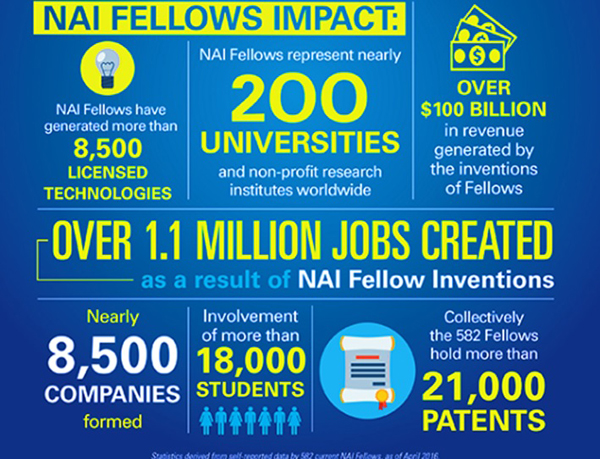
Then USF did something truly radical almost five years ago: We worked on changing our tenure and promotion policy to give credit to faculty who have patented and commercialized new inventions.
And we began a national conversation on changing the academic culture to recognize faculty patents and commercialization activity toward merit and promotion. At one NAI conference, we posed the question: “Would Thomas Edison Receive Tenure?
Well, a 2012 survey found that only 25 of the top 200 national research universities considered patents and commercialization activities in tenure and promotion decisions. The answer to that question would be a “yes” only if Edison were lucky enough to work at a select group of American universities.
The paper resulting from that panel discussion was published in the Proceedings of the National Academy of Sciences and, today, this important initiative continues to gain national attention.
Several organizations and university leaders are recommending and reporting on best practices for university intellectual property management, including such groups as the Association for Public and Land-grant Universities and the Association of American Universities.
This movement is changing the culture, and every time I travel the country to talk about academic invention and innovation, I sense a rising tide of excitement about what the future holds.
***
One of the first scientific organizations I joined, when I was a young man, was Sigma Xi. Standing here today, it’s a special memory of those years when I decided I wanted a career in scientific research and could join one of the oldest and largest scientific organizations in the world.
It’s wonderful to see so many colleagues at this conference … including students who are taking that great leap into a career that isn’t always easy and doesn’t always get the recognition it deserves … but has never been more important in the service to humankind.
I sense a hunger for breakthroughs that will give the world better options than it has now. We need better medicines to fight diseases … we need better technologies to harness the power of cyberspace … we need to apply all the tools we’ve created … not to widen the gap between people … but to create more sustainable, and more equitable, communities.
We need to be—as Dr. McGovern so notably identified—humanists.
The biggest lessons I’ve learned in this career aren’t the discoveries in the lab or the new technologies I’ve patented. It’s that my experience as a person—those desperate hours, the frustration of not having better options, and the pain of feeling helpless as a loved one struggles—is really everybody’s life story.
I was the fortunate one, I could go into my lab and look for answers, solve problems and discover better ways of doing things. And I could be a voice for other scientists, innovators and inventors, and bring them together to support and empower each other.
Together, we could leverage both individual influence and institutional strength for the greater good.
Some of you might think these are dark days for science and innovation—research funding is struggling and we live in a political climate where, at times, people prefer to construct their own facts.
But we can’t retreat into our labs until it is safe to come out. We have to push forward. We have to support each other and advocate for each other.
The discovery of new scientific facts, or the invention of new technology, or the application of existing research in new and exciting ways, is the external mission. But to have a truly successful career in the sciences, you must also have that internal journey—one to discover who you are, and why your life has meaning.
Every scientist has a story. I hope, as you pursue your passion to discover, innovate and invent, that your journey is one that, not only brings you external rewards, but fulfills who you are inside … and the meaningful role you can play in our larger society.
Thank you—for this wonderful honor, and for being truly great colleagues!
Photo captions
1st photo: Paul R. Sanberg.
2nd photo: The Sigma Xi John P. McGovern Science and Society Award's medal.
3rd photo: Sigma Xi President Tee Guidotti, on left, and Annual Meeting Planning Committee Member Hayat Caidi present Paul Sanberg with his John P. McGovern Science and Society Award certificate.
4th photo: Sanberg with his father, Bernard Sanberg, who suffered a stroke.
5th photo: An infographic on the impact of National Academy of Inventors Fellows, based on self-reported data by 582 current NAI Fellows, as of April 2016.
-
by
User Not Found
| Dec 13, 2016
This is a guest post written by Sigma Xi President Tee L. Guidotti.
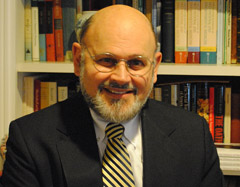 Welcome to Sigma Xi, The Scientific Research Honor Society.
Welcome to Sigma Xi, The Scientific Research Honor Society.
“Well thank you very much,” you may reply, “but you know my name. I’m already a member (or affiliate) of the organization.” That may be true but what is different is our name.
Sigma Xi is changing its name from Sigma Xi, The Scientific Research Society to Sigma Xi, The Scientific Research Honor Society, in order to emphasize that it is an honor society for scientific research. In fact, it’s the largest multidisciplinary honor society in the world. This may seem to be a simple insertion of the word “honor” but as always with Sigma Xi there is a long and distinguished history behind the new name.
Sigma Xi, of course, is our basic name and has been since the organization was founded in 1886 as the scientific and engineering counterpart to Phi Beta Kappa. Like all “Greek letter” societies, whether professional or social, it is an acronym for the motto of the organization, Σπουδων Ξυνωνες (Spoudon Xynones), which translates as "companions in Zealous Research." For many years, we were referred to as “Society of the Sigma Xi.”
 In the early twentieth century, some in the leadership wanted “Sigma Xi” to be dropped altogether in favor of some formulation such as “Scientific Research Society of America.” In a strange quirk of history, both names survived because the organization split in the 1940s into an academic honor society (Sigma Xi) and an honor society for applied research and engineering (the Scientific Research Society of America, called RESA). RESA was a separate entity, wholly owned by Sigma Xi, and represented engineers and scientists at non-academic institutions, such as government and industrial research laboratories.
In the early twentieth century, some in the leadership wanted “Sigma Xi” to be dropped altogether in favor of some formulation such as “Scientific Research Society of America.” In a strange quirk of history, both names survived because the organization split in the 1940s into an academic honor society (Sigma Xi) and an honor society for applied research and engineering (the Scientific Research Society of America, called RESA). RESA was a separate entity, wholly owned by Sigma Xi, and represented engineers and scientists at non-academic institutions, such as government and industrial research laboratories.
In an even stranger development, Sigma Xi and RESA merged back together in 1974 and eventually began calling itself Sigma Xi, The Scientific Research Society. A bit of Sigma Xi trivia is that although the second part of the name has functioned as a description of the first, it actually pays homage to RESA.
As a practical matter, the name Sigma Xi is a “brand” (in the good sense of an identity associated with tradition and respect) and carries great weight within the scientific community. It is too valuable and venerable to change, even though some people on first encountering the name think that we are a college fraternity. Actually, in a very real sense we are a “fraternity” (in the sense of fraternité) but one as it was understood in 1886, when professionalism, social competence, networking, maturity, and “character” were seen as virtues cultivated in young men and women by a community of young scholars (a brotherhood or sisterhood). As a side note, Sigma Xi inducted its first female members in 1888, at a time when almost all graduate programs in science and engineering excluded women.
Now we add “Honor” to our name to emphasize that we are an honor society, keeping in mind that honor is just the beginning of what it means to be part of Sigma Xi. Once elected, our members “pay back” the support they received in their career by mentoring up-and-coming researchers. In turn, the younger generation can pay this support forward by supporting their local chapter’s efforts to bring the research community together and to promote the public understanding of science.
Although it was a change, adding “Honor” to a name with this tradition was an easy decision for your Assembly of Delegates to make at the recent Annual Meeting. It is new but it is not a break in tradition at all. The new name clarifies our mission and honors both the main line of Sigma Xi and nearly three decades of RESA. Our name carries our history.
-
by
User Not Found
| Nov 29, 2016
 In honor of Human Rights Day on December 10, I’d like to share an article by Jeffrey H. Toney, who for years has done a great job of representing Sigma Xi on the American Association for the Advancement of Science’s Science and Human Rights Coalition. In “President-Elect Trump and the Human Right to Water,” Toney discusses the coalition’s January meeting that will focus on the human right to water, how Sigma Xi members can get involved, and what is known about Donald Trump’s plans to support access to clean water.
In honor of Human Rights Day on December 10, I’d like to share an article by Jeffrey H. Toney, who for years has done a great job of representing Sigma Xi on the American Association for the Advancement of Science’s Science and Human Rights Coalition. In “President-Elect Trump and the Human Right to Water,” Toney discusses the coalition’s January meeting that will focus on the human right to water, how Sigma Xi members can get involved, and what is known about Donald Trump’s plans to support access to clean water.
Kids Science Reading Corner
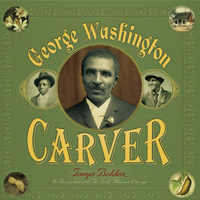 The United Nations lists the right to education among the basic human rights. A pair of new books, and a recently reissued gem, tell inspiring stories of youngsters from an earlier era who gained their education against the odds. Younger readers will find spirited accounts of a mathematician widely regarded as the first computer programmer in Ada Lovelace, Poet of Science, written by Diane Stanley and illustrated by Jessie Hartland (ages 4–8), and Ada’s Ideas, by Fiona Robinson (ages 6–9). Lovelace, born in 1815, flourished as an advanced mathematics student, an unconventional subject for young women then.
The United Nations lists the right to education among the basic human rights. A pair of new books, and a recently reissued gem, tell inspiring stories of youngsters from an earlier era who gained their education against the odds. Younger readers will find spirited accounts of a mathematician widely regarded as the first computer programmer in Ada Lovelace, Poet of Science, written by Diane Stanley and illustrated by Jessie Hartland (ages 4–8), and Ada’s Ideas, by Fiona Robinson (ages 6–9). Lovelace, born in 1815, flourished as an advanced mathematics student, an unconventional subject for young women then.
George Washington Carver, by Tonya Bolden (ages 10+), brings the brilliant, multifaceted botanist to life. He found ways to obtain an education and had an outstanding research career at a time when such opportunities for African Americans were extremely rare. You can read a review of the book here.
I hope you consider sharing these resources with the young readers in your life.
Sincerely,

John C. Nemeth, PhD
Executive Director and CEO
Sigma Xi, The Scientific Research Honor Society
Publisher of American Scientist
Sigma Xi Speaks is a monthly series of information that we hope you share with others.
-
by
User Not Found
| Nov 16, 2016
This is a guest post written by Sigma Xi President Tee Guidotti.
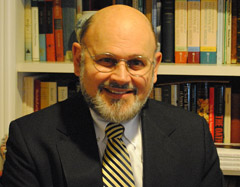
Sigma Xi conferences are always wondrous affairs, bringing together speakers on outstanding science, extraordinarily talented students, their dedicated advisors, science policy wonks, and people who just plain care. The meeting that just ended featured these key themes:
Opportunity: Procter Prize awardee Jan Achenbach spoke on waves and the development of nondestructive testing. He advised students seeking research projects to be like surfers: ride a sturdy board (of preparation and mastery) as far out as possible and catch the wave of a scientific problem and ride it back to the beach!
Groundedness (in the good sense, not the aviation sense!): Norman Augustine, the first recipient of the new Sigma Xi Gold Key Award, revealed that through a long career as an aeronautical engineer, CEO of Lockheed Martin, and years of public service in science, he thought of Sigma Xi as, to paraphrase his words, a scientific “home.”
Entrepreneurship: McGovern awardee Paul Sanberg told how his career of developing and applying effective stem cell treatments was shaped by his father’s stroke. He encouraged us to embrace entrepreneurship as the most direct means of getting science used for the good.
Interdisciplinary: Young Investigator awardee Tiago Falk epitomized interdisciplinary research by fusing multimedia technology with medical applications with striking results, allowing both individualization of care management and socialization of profoundly disabled persons.
Perspicacity (as the capacity to see deeply into things): Chubb awardee Akhlesh Lakhtakia described foundational techniques of nanoengineering based on filamentous structures with unique and useful properties. Much of his work rests on understanding chirality, because the same thing, taken in a new orientation, yields different insights and possibilities.
Diversity and Inclusiveness: The creation of Sigma Xi's new Diversity Task Force, established during the meeting, stimulated much thoughtful discussion on reducing barriers as a matter of justice and on promoting inclusiveness to unlock the creativity and insight brought to science by diversity in life experience, perspective, and individual talent.
Mentorship: High school, undergraduate, and graduate students brought enthusiasm and energy to the conference as they competed for poster presentation awards and attended career development sessions. The students were challenged with finding mentors at the conference, and the successful new STEM Mixer provided dedicated and valuable time for networking between student and professional researchers.
The conference was also a cornucopia of ideas on science communication, science policy (both “policy for science” and “science for policy”), entrepreneurship, and career development. Effective science communication was vividly demonstrated by the special viewing of a stunning new film by Ross Spears: The Truth About Trees.
Sigma Xi also celebrated its own leaders, honoring Cristina (Tina) Gouin-Paul with the 2016 Evan Ferguson Award. Dr. Ferguson’s life was dedicated to the Society and Tina’s contributions to the organization are in keeping with his memory. Tina played a key role behind a series of motions passed at the meeting to improve Sigma Xi’s management and efficiency, yet another step in putting the Society’s recent fiscal and management obstacles behind it.
The meeting ended with a promise and a glimpse of the future. There will be no annual meeting in calendar year 2017, because Sigma Xi is aligning its meeting years with its elections and fiscal years meeting schedule. When we reconvene in 2018, the quality and excitement of the 2016 meeting will be remembered as a model and inspiration.
Running through the entire meeting was a growing sense of career-long preparation in Sigma Xi’s passions: a responsibility of paying forward, paying now, and paying back.
-
by
User Not Found
| Oct 18, 2016
 From the time our ancestors peered out from the cave until now, our fondest wish while watching birds has been achieving flight. Sadly, humans require significant evolutionary change before we achieve that without some mechanical help. Think of the hovering Red-tailed Hawk or Osprey…what they see. Watching drone video provides a freedom of view unlike any form of observation so far developed and implemented.
From the time our ancestors peered out from the cave until now, our fondest wish while watching birds has been achieving flight. Sadly, humans require significant evolutionary change before we achieve that without some mechanical help. Think of the hovering Red-tailed Hawk or Osprey…what they see. Watching drone video provides a freedom of view unlike any form of observation so far developed and implemented.
In my career as an environmental scientist, much of it toiling in the field, I see that the research applications for drones, formally known as unmanned aerial vehicles (UAVs), are legion. This capability is not just about easing workload. From monitoring remote regions to watching miraculous nature, it offers an unprecedented ability to observe and remarkably enhance our ability to develop solutions or ease minds.
If you are using small UAVs for your research, make sure you know the new rules from the Federal Aviation Administration.
Also, just for fun, watch University of Pennsylvania’s drones perform the James Bond theme song.
Kids Science Reading Corner
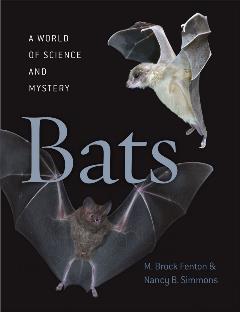 Around Halloween, kids are enthusiastic about all sorts of creatures that go bump in the night—and some creatures that don’t, thanks to echolocation. Yes, bats! There are plenty of great books to help satisfy a young reader’s curiosity about these flying mammals. Kids in kindergarten through second grade may enjoy Gail Gibbons’s classic, Bats, which describes how they live, what they eat, and why they’re vital to the ecosystem. Its striking watercolors include diagrams with anatomical labels. Bats: Shadows in the Night, for readers age 9 and up, is filled with terrific photos of the night flyers and was written by renowned author and essayist Diane Ackerman. Finally, those in their teens and above have Bats: A World of Science and Mystery, by biologist M. Brock Fenton and American Museum of Natural History mammalogy curator Nancy B. Simmons. Its trove of photographs is matched by its wealth of information: how bats evolved, their diet and habits, the mechanics of their flight, and much more. Happy Halloween!
Around Halloween, kids are enthusiastic about all sorts of creatures that go bump in the night—and some creatures that don’t, thanks to echolocation. Yes, bats! There are plenty of great books to help satisfy a young reader’s curiosity about these flying mammals. Kids in kindergarten through second grade may enjoy Gail Gibbons’s classic, Bats, which describes how they live, what they eat, and why they’re vital to the ecosystem. Its striking watercolors include diagrams with anatomical labels. Bats: Shadows in the Night, for readers age 9 and up, is filled with terrific photos of the night flyers and was written by renowned author and essayist Diane Ackerman. Finally, those in their teens and above have Bats: A World of Science and Mystery, by biologist M. Brock Fenton and American Museum of Natural History mammalogy curator Nancy B. Simmons. Its trove of photographs is matched by its wealth of information: how bats evolved, their diet and habits, the mechanics of their flight, and much more. Happy Halloween!
Sincerely,

John C. Nemeth, PhD
Executive Director and CEO of Sigma Xi, The Scientific Research Society
Publisher of American Scientist
Sigma Xi Speaks is a monthly series of information that we hope you share with others.
-
by
User Not Found
| Oct 11, 2016
 Thanks for following along with the second year of Sigma Xi, The Scientific Research Society’s Nobel Prize prediction contest, October Madness. After collecting public nominations and holding four weeks of voting, we made our collective best guess of who would win this year’s research-related Nobel Prizes.
Thanks for following along with the second year of Sigma Xi, The Scientific Research Society’s Nobel Prize prediction contest, October Madness. After collecting public nominations and holding four weeks of voting, we made our collective best guess of who would win this year’s research-related Nobel Prizes.
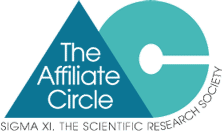 While the October Madness picks for the Nobel Prize in Physics matched the Thomson Reuters predictions, the 2016 Nobel Prize winners in chemistry, physics, or physiology or medicine did not match our predictions this year. The same thing goes for the Sveriges Riksbank Prize in Economic Sciences. Unfortunately, that means none of this year’s October Madness nominators win the prizes of a free year of Sigma Xi membership dues (for existing members) or a free year in the Sigma Xi Affiliate Circle.
While the October Madness picks for the Nobel Prize in Physics matched the Thomson Reuters predictions, the 2016 Nobel Prize winners in chemistry, physics, or physiology or medicine did not match our predictions this year. The same thing goes for the Sveriges Riksbank Prize in Economic Sciences. Unfortunately, that means none of this year’s October Madness nominators win the prizes of a free year of Sigma Xi membership dues (for existing members) or a free year in the Sigma Xi Affiliate Circle.
Even so, we hope you had as much fun as we did. Look for October Madness again next year here on Sigma Xi’s blog, Keyed In, and on Sigma Xi's social media with #OctoberMadness!
A Look Back at October Madness
Announcement of Champions
The Finals
Final 4
Elite 8
Sweet 16
Call for Nominations
Heather Thorstensen is the manager of communications for Sigma Xi, The Scientific Research Society.
-
by
User Not Found
| Sep 27, 2016
 After collecting public nominations and holding four weeks of voting, we can now announce the champions of October Madness, Sigma Xi's Nobel Prize prediction contest.
After collecting public nominations and holding four weeks of voting, we can now announce the champions of October Madness, Sigma Xi's Nobel Prize prediction contest.
The October Madness champions are your most popular choices for who might win a Nobel Prize in Chemistry, Physics, and Physiology or Medicine in 2016. We also named a champion for your top choice for this year's Sveriges Riksbank Prize in Economic Sciences.
The champions are listed below, along with voting results from the finals round. Congratulations to Sigma Xi member Kip Thorne for being named one of the champions in physics!
Chemistry
Your prediction for this year's winner of the Nobel Prize in Chemistry is Paul J. Reider for the discovery and development of approved drugs, including those for treating asthma and for treating AIDS.
Chemistry Bracket
Chemistry Voting Results, the Finals
Economic Sciences
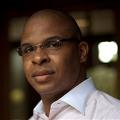 |
| Roland Fryer |
Your prediction for this year's winner of the Sveriges Riksbank Prize in Economic Sciences is Roland Fryer for ground breaking quantitative analysis techniques that reveal causes and effects of economic and educational gaps based on racial discrimination and other inequities.
Economic Sciences Bracket
Economic Sciences Voting Results, the Finals
Physics
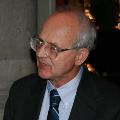 |
 |
| Rainer Weiss and Kip Thorne are the physics champions, along with Ronald Drever. |
Your prediction for this year's winners of the Nobel Prize in Physics is Rainer Weiss, Kip Thorne, and Ronald Drever for the direct detection of gravitational waves.
The physics category ended in a tie at the conclusion of voting. The tie between Vera Rubin and Kent Ford vs. Rainer Weiss, Kip Thorne, and Ronald Drever was broken by looking at which group had the most votes in the previous voting round.
Physics Bracket
Physics Voting Results, The Finals
Physiology or Medicine
Your prediction for this year's winner of the Nobel Prize in Physiology or Medicine is Paul Quinton for significant contributions to the understanding of the mechanisms behind cystic fibrosis, particularly the discovery that the fundamental defect in cystic fibrosis is chloride impermeability.
Physiology or Medicine Bracket
Physiology or Medicine Voting Results, the Finals
Can't get enough Noble Prize predictions?
See who Thomson Reuters predicted for this year's winners.
What's Next?
The official Nobel Prize announcements will be made on the following days:
Physiology or Medicine: October 3, 11:30 a.m. at the earliest
Physics: October 4, 11:45 a.m. at the earliest
Chemistry: October 5, 11:45 a.m. at the earliest
Economic Sciences: October 10, 11:45 a.m. at the earliest
Times listed are local time in Sweden.
The winners of the October Madness raffle prizes will be announced on October 11. Participants who nominated someone who goes on to win a Nobel Prize this year are entered into the raffle. Winners who are not members of Sigma Xi receive a free year in the Sigma Xi Affiliate Circle. Members who win the raffle win a free year of membership dues. Check back on Keyed In or Sigma Xi's social media to see if anyone took these prizes.
Photo credit
Roland Fryer, Courtesy of the John D. and Catherine T. MacArthur Foundation [CC BY 4.0 (http://creativecommons.org/licenses/by/4.0)], via Wikimedia Commons. No changes were made.
Rainer Weis, Dhs at the English language Wikipedia [GFDL (http://www.gnu.org/copyleft/fdl.html) or CC-BY-SA-3.0 (http://creativecommons.org/licenses/by-sa/3.0/)], via Wikimedia Commons. No changes were made.
Kip Thorne, By Keenan Pepper (Own work) [GFDL (http://www.gnu.org/copyleft/fdl.html) or CC BY-SA 3.0 (http://creativecommons.org/licenses/by-sa/3.0)], via Wikimedia Commons. No changes were made.
Heather Thorstensen is manager of communications for Sigma Xi, The Scientific Research Society.
-
by
User Not Found
| Sep 20, 2016

We made it to the finals for this year's edition of October Madness, Sigma Xi's Nobel Prize prediction contest. Thanks to all who voted last week! Everyone is invited to vote this week to help complete our predictions for the 2016 Nobel Prize in chemistry, physics, and physiology or medicine. We're also predicting the winner of the Sveriges Riksbank Prize in Economic Sciences.
Voting for this round will close at 11:59 p.m. PDT on September 25.
Make sure to check back on this blog on September 27 for the announcement of our October Madness champions!
Final 4 Results
Chemistry
Economic Sciences*
Physics
Physiology or Medicine
A tie in Economic Sciences between Jennifer Hunt and Gary S. Fields was broken based on the number of votes each received in the Elite 8 round. Fields advanced to the finals.
Finals Voting
Chemistry
Vote here for your predictions for the Nobel Prize in Chemistry.
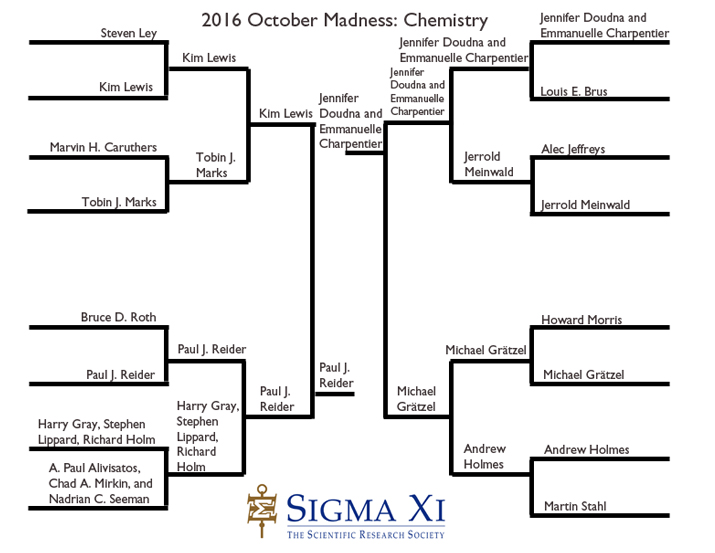
The final chemistry match-up is:
Jennifer Doudna and Emmanuelle Charpentier for the CRISPR gene editing tool
VS.
Paul J. Reider for the discovery and development of approved drugs, including those for treating asthma and for treating AIDS
Economic Sciences
Vote here for your predictions for the Sveriges Riksbank Prize in Economic Sciences.
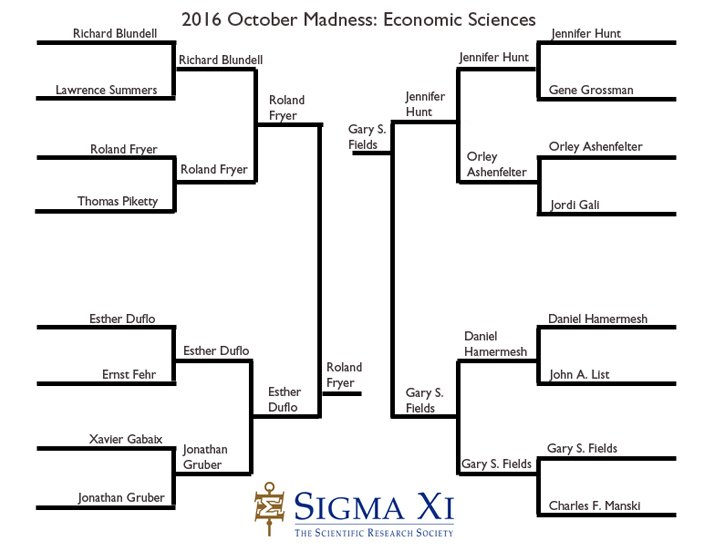
The final economic sciences match-up is:
Gary S. Fields for contributions on the importance of efficient labor markets to fight poverty and foster economic development in low- and middle-income countries
VS.
Roland Fryer for ground breaking quantitative analysis techniques that reveal causes and effects of economic and educational gaps based on racial discrimination and other inequities
Physics
Vote here for your predictions for the Nobel Prize in Physics.
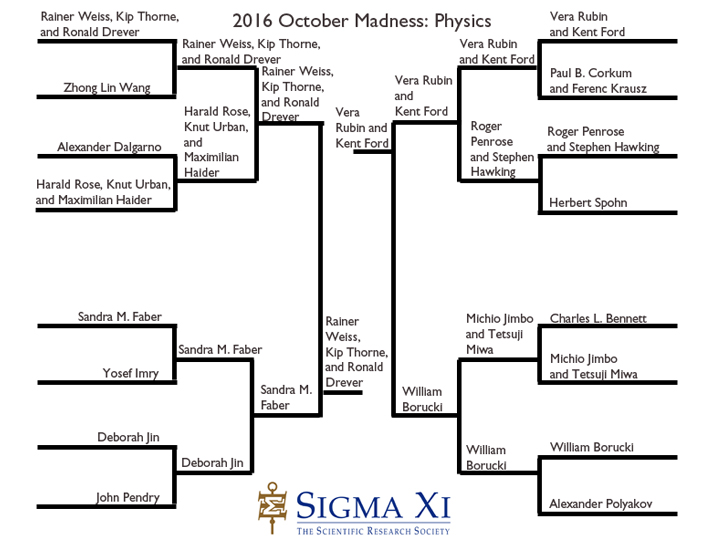
The final physics match-up is:
Vera Rubin and Kent Ford for dark matter
VS.
Rainer Weiss, Kip Thorne, and Ronald Drever for the direct detection of gravitational waves
Physiology or Medicine
Vote here for your predictions for the Nobel Prize in Physiology or Medicine.
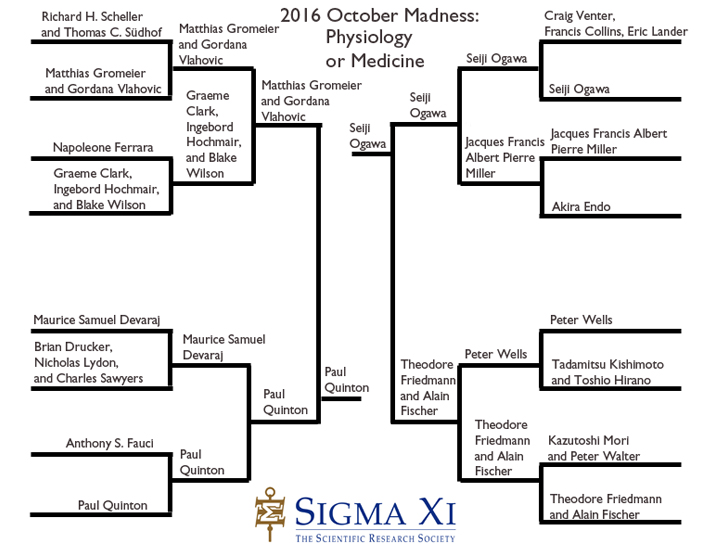
The final physiology or medicine match-up is:
Seiji Ogawa for the discovery of the principle for functional magnetic resonance imaging
VS.
Paul Quinton for significant contributions to the understanding of the mechanisms behind cystic fibrosis, particularly the discovery that the fundamental defect in cystic fibrosis is chloride impermeability
Heather Thorstensen is the manager of communications for Sigma Xi, The Scientific Research Society.
-
by
User Not Found
| Sep 19, 2016

By now we are aware of the dangers of the Zika virus, which the World Health Organization has classified as a public health emergency of international concern. When we face emerging health threats like this, it’s important that Sigma Xi members be the voice of clear and credible research to our family, friends, and communities. Below are reliable sources that I hope you will share with those around you to help them learn accurate information about Zika, and to act appropriately.
I also urge you to subscribe to Sigma Xi SmartBrief as a resource. If you are a Twitter user, look for Dr. Peter J. Hotez (@peterhotez) for really salient and up to the moment updates and background information. Dr. Hotez is in the process of being inducted into Sigma Xi.
Kids Science Reading Corner
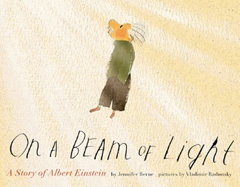 For this month’s Kids Science Reading Corner, I’ll start with some history. On September 27, 1905, the journal Annalen der Physik received Albert Einstein’s paper “Does the Inertia of a Body Depend upon Its Energy Content?” This work introduced the formula E = mc2 to the scientific community. The anniversary offers a great opportunity to introduce this visionary formula—and the scientist who envisioned it—to young readers.
For this month’s Kids Science Reading Corner, I’ll start with some history. On September 27, 1905, the journal Annalen der Physik received Albert Einstein’s paper “Does the Inertia of a Body Depend upon Its Energy Content?” This work introduced the formula E = mc2 to the scientific community. The anniversary offers a great opportunity to introduce this visionary formula—and the scientist who envisioned it—to young readers.
High schoolers (and grown-ups) may want to check out Einstein, an illustrated biography by Corinne Maier, with artwork by Anne Simon, which gives us a nuanced look at the physicist’s life and work. Albert Einstein and Relativity for Kids: His Life and Ideas with 21 Activities and Thought Experiments, by Jerome Pohlen, is a great read for kids 9 and up. And even very young readers can learn about Einstein and his discoveries, thanks to the terrific On a Beam of Light: A Story of Albert Einstein, written by Jennifer Berne and illustrated by Vladimir Radunsky. Berne and Radunsky show Einstein as an imaginative kid who follows his curiosity, growing up to become a great scientist who finds answers to questions many had thought unanswerable. This book is all about the spirit of inquiry, where it can lead, and the fulfillment it brings. What better way to kick off a new school year?
Sincerely,

John C. Nemeth, PhD
Sigma Xi Executive Director and CEO, Publisher of American Scientist
Sigma Xi Speaks is a monthly series of articles containing information to share. Find past articles on Sigma Xi's blog, Keyed In.
-
by
User Not Found
| Sep 13, 2016

We are down to the Final 4 for Sigma Xi's Nobel Prize prediction contest, October Madness. See below for the results from last week and then vote! Everyone can vote for who they think should win the Nobel Prizes in chemistry, physics, and physiology or medicine as well as the Sveriges Riksbank Prize in Economic Sciences.
Voting for the Final 4 round ends at 11:59 p.m. PDT on September 18.
Elite 8 Results
Chemistry
Economic Sciences
Physics
Physiology or Medicine
Final 4 Voting
Chemistry
Vote here for your predictions for the Nobel Prize in Chemistry.
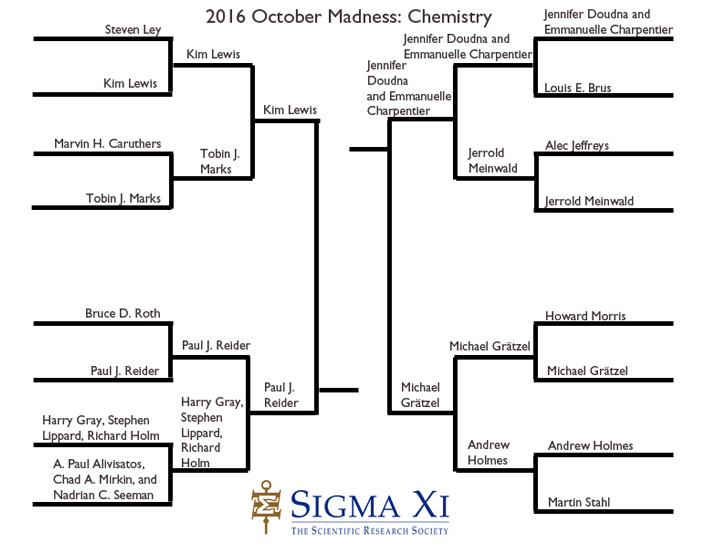
The Final 4 chemistry match-ups are:
1.
Jennifer Doudna and Emmanuelle Charpentier for the CRISPR gene editing tool
VS.
Michael Grätzel for discovering dye sensitized solar cells, a new type of solar cell for powering portable electronic devices with applications for building integrated photovoltaics
2.
Kim Lewis for the discovery of Teixobactin, the first antibiotic in 30 years
VS.
Paul J. Reider for the discovery and development of approved drugs, including those for treating asthma and for treating AIDS
Economic Sciences
Vote here for your predictions for the Sveriges Riksbank Prize in Economic Sciences.
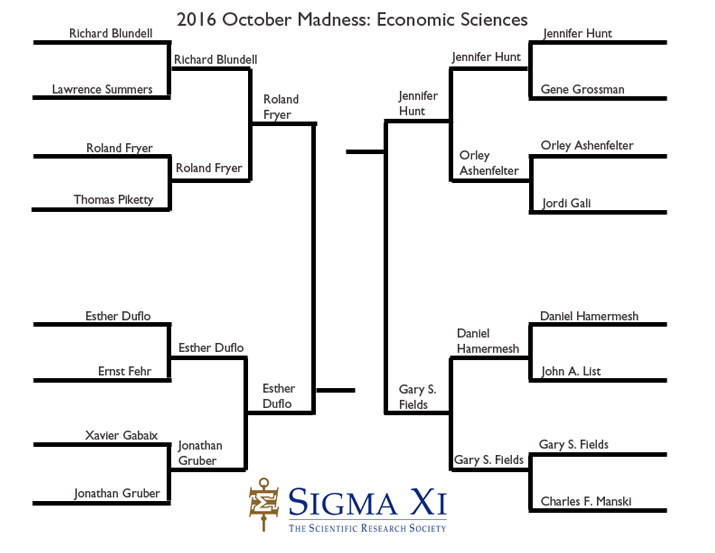
The Final 4 economic sciences match-ups are:
1.
Jennifer Hunt for analysis on immigration
VS.
Gary S. Fields for contributions on the importance of efficient labor markets to fight poverty and foster economic development in low- and middle-income countries
2.
Roland Fryer for ground breaking quantitative analysis techniques that reveal causes and effects of economic and educational gaps based on racial discrimination and other inequities
VS.
Esther Duflo for advances in applied economics through innovative field studies that examine how public policy affects microeconomic outcomes in developing nations
Physics
Vote here for your predictions for the Nobel Prize in Physics.
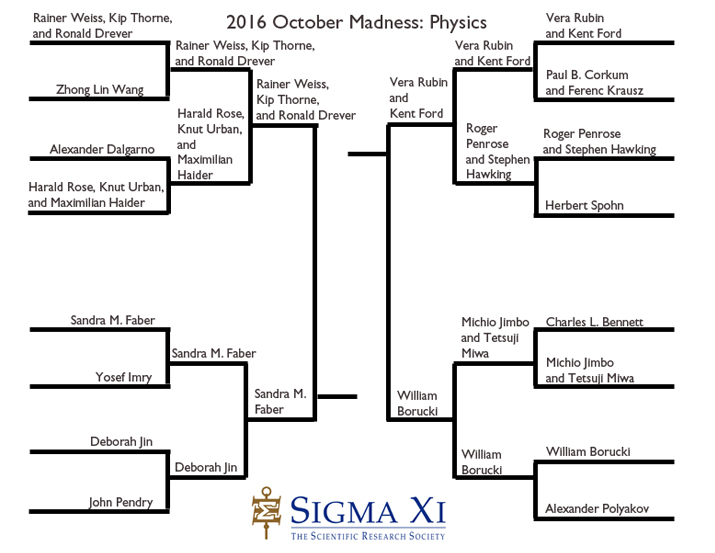
The Final 4 physics match-ups are:
1.
Vera Rubin and Kent Ford for dark matter
VS.
William Borucki for leadership of NASA's Kepler mission, which uncovered planets and solar systems
2.
Rainer Weiss, Kip Thorne, and Ronald Drever for the direct detection of gravitational waves
VS.
Sandra M. Faber for leadership in numerous path-breaking studies of extra-galactic astronomy and galaxy formation
Physiology or Medicine
Vote here for your predictions for the Nobel Prize in Physiology or Medicine.
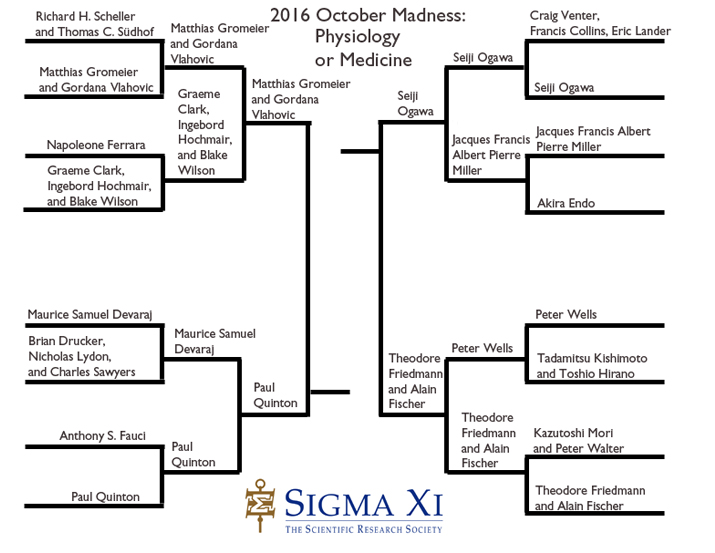
The Final 4 physiology or medicine match-ups are*:
1.
Seiji Ogawa for the discovery of the principle for functional magnetic resonance imaging
VS.
Theodore Friedmann and Alain Fischer for the proposal of gene therapy and its clinical applications
2.
Matthias Gromeier and Gordana Vlahovic for using a genetically engineered polio virus (PVS-RIPO) to attack glioblastoma, a brain cancer, and discovering that it seeks out and attaches to receptors that are highly common across tumor types, while leaving normal cells alone
VS.
Paul Quinton for significant contributions to the understanding of the mechanisms behind cystic fibrosis, particularly the discovery that the fundamental defect in cystic fibrosis is chloride impermeability
*The Elite 8 round resulted in ties between Seiji Ogawa and Jacques Francis Albert Pierre Miller as well as between Maurice Samuel Deveraj and Paul Quinton. The ties were broken based on how many votes each person received in the Sweet 16 round.
Heather Thorstensen is the manager of communications for Sigma Xi, The Scientific Research Society.
-
by
User Not Found
| Sep 07, 2016

Thanks to everyone who helped the 2016 edition of October Madness get started! Today we're announcing the results of our Sweet 16 round and kicking off voting for the Elite 8 round.
Are you new to October Madness? It's a Nobel Prize prediction contest from Sigma Xi, The Scientific Research Society. It's easy: everyone can vote for who they think will win! Refer to our contest announcement for the schedule and prizes.
Voting for this round will be open until 11:59 p.m. PDT on September 11. Check back on this blog or on Sigma Xi's social media on September 13 for the results.
Sweet 16 Voting Results
Chemistry
Economic Sciences
Physics
Physiology or Medicine
Elite 8 Voting
Chemistry
Vote here for your predictions for the Nobel Prize in Chemistry.
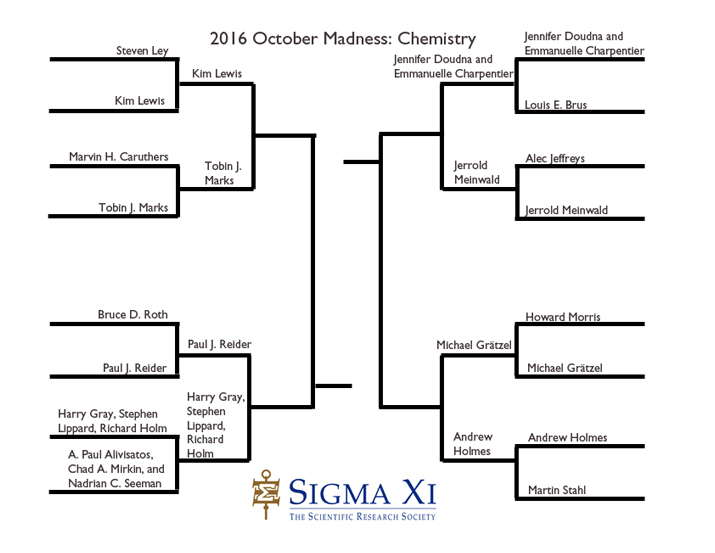
The Elite 8 chemistry match-ups are:
1.
Jennifer Doudna and Emmanuelle Charpentier for the CRISPR gene editing tool
VS.
Jerrold Meinwald for his work leading to the establishment of the field of chemical ecology and his fundamental studies of how chemicals act as repellents and attractants between organisms, leading to the use of these chemicals in a variety of biomedical, agricultural,forestry, and household applications
2.
Michael Grätzel for discovering dye sensitized solar cells, a new type of solar cell for powering portable electronic devices with applications for building integrated photovoltaics
VS.
Andrew Holmes for his contributions to chemical synthesis at the interface between materials and biology and pioneering the field of organic electronic materials
3.
Kim Lewis for the discovery of Teixobactin, the first antibiotic in 30 years
VS.
Tobin J. Marks for contributions to understand catalysts, useful in the production of environmentally-friendly plastics and new materials
4.
Paul J. Reider for the discovery and development of approved drugs, including those for treating asthma and for treating AIDS
VS.
Harry Gray, Stephen Lippard, Richard Holm for work in bioinorganic chemistry
Economic Sciences
Vote here for your predictions for the Sveriges Riksbank Prize in Economic Sciences.
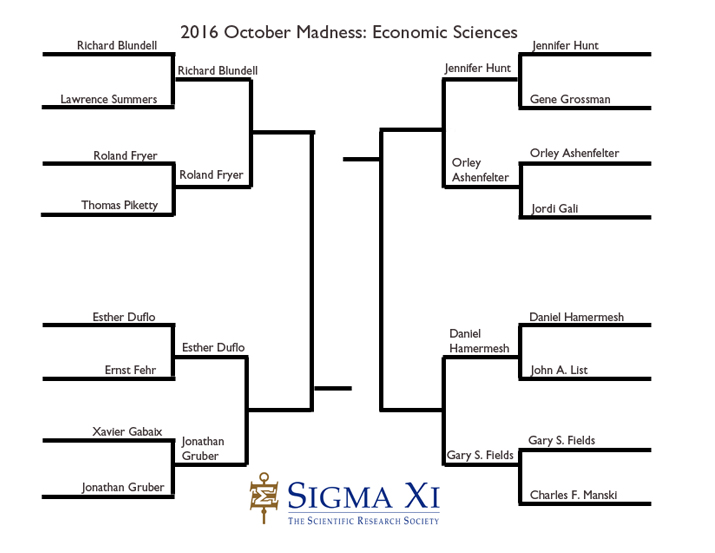
The economic sciences Elite 8 match-ups are:
1.
Jennifer Hunt for analysis on immigration
VS.
Orley Ashenfelter for analysis on labor economics
2.
Daniel Hamermesh for his contributions to the study of labor demand
VS.
Gary S. Fields for contributions on the importance of efficient labor markets to fight poverty and foster economic development in low- and middle-income countries
3.
Richard Blundell for his important contributions to labor economics, public finance, and applied econometrics
VS.
Roland Fryer for ground breaking quantitative analysis techniques that reveal causes and effects of economic and educational gaps based on racial discrimination and other inequities
4.
Esther Duflo for advances in applied economics through innovative field studies that examine how public policy affects microeconomic outcomes in developing nations
VS.
Jonathan Gruber for his work in crafting public health policy
Physics
Vote here for your predictions for the Nobel Prize in Physics.
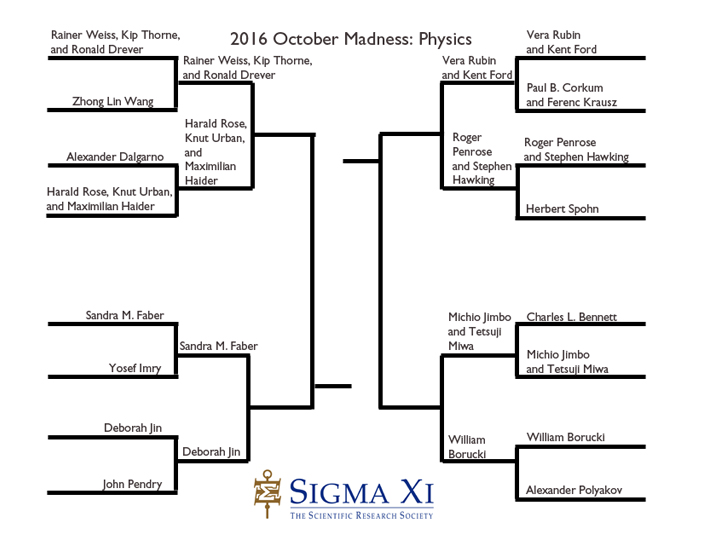
The Elite 8 physics match-ups are:
1.
Vera Rubin and Kent Ford for dark matter
VS.
Roger Penrose and Stephen Hawking for their contribution to our understanding of the universe
2.
Michio Jimbo and Tetsuji Miwa for developments in integrable systems and their correlation functions in statistical mechanics and quantum field theory, making use of quantum groups, algebraic analysis, and deformation theory
VS.
William Borucki for leadership of NASA's Kepler mission, which uncovered planets and solar systems
3.
Rainer Weiss, Kip Thorne, and Ronald Drever for the direct detection of gravitational waves
VS.
Harald Rose, Knut Urban, and Maximilian Haider for their development of abberration-corrected electron microscopy, allowing the observation of individual atoms with picometer precision
4.
Sandra M. Faber for leadership in numerous path-breaking studies of extra-galactic astronomy and galaxy formation
VS.
Deborah Jin for her pioneering investigations of the quantum properties of an ultracold gas of fermionic atoms, and for the creation of the first quantized gas of fermionic atoms
Physiology or Medicine
Vote here for your predictions for the Nobel Prize in Physiology or Medicine.
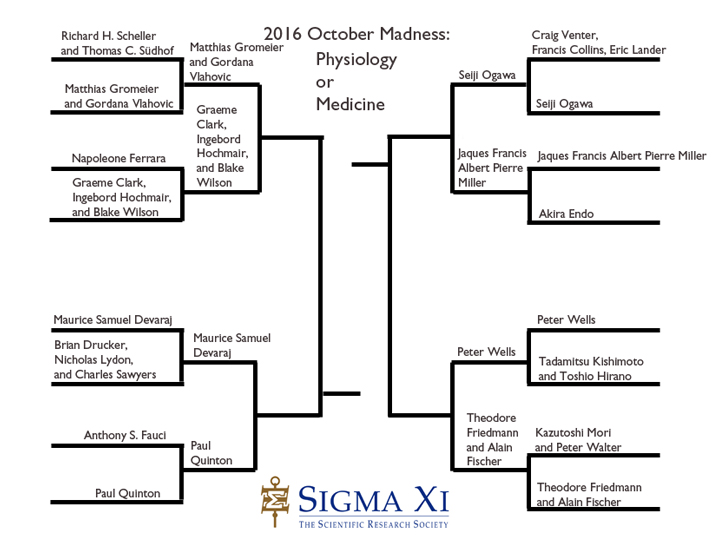
The Elite 8 physiology or medicine match-ups are:
1.
Seiji Ogawa for the discovery of the principle for functional magnetic resonance imaging
VS.
Jaques Francis Albert Pierre Miller for his work on the immunological function of the thymus and of T cells, which has revolutionized the science of immunology
2.
Peter Wells for pioneering the development of ultrasonics as a diagnostic and surgical tool
VS.
Theodore Friedmann and Alain Fischer for the proposal of gene therapy and its clinical applications
3.
Matthias Gromeier and Gordana Vlahovic for using a genetically engineered polio virus (PVS-RIPO) to attack glioblastoma, a brain cancer, and discovering that it seeks out and attaches to receptors that are highly common across tumor types, while leaving normal cells alone
VS.
Graeme Clark, Ingebord Hochmair, and Blake Wilson for developing the modern cochlear implant
4.
Maurice Samuel Devaraj for the discovery of a method of suppressing mutations in pathogens such as tuberculosis
VS.
Paul Quinton for significant contributions to the understanding of the mechanisms behind cystic fibrosis, particularly the discovery that the fundamental defect in cystic fibrosis is chloride impermeability
Heather Thorstensen is the manager of communications for Sigma Xi, The Scientific Research Society.
-
by
User Not Found
| Aug 30, 2016

Voting begins today for the 2016 edition of October Madness, a public Nobel Prize prediction contest from Sigma Xi, The Scientific Research Society.
Please click the links below to vote for who you think could win this year's Nobel Prizes in Chemistry, Physics, and Physiology or Medicine. We're also voting for the Sveriges Riksbank Prize in Economic Sciences.
Voting for this round ends at midnight PDT on September 5, 2016. We will announce the researchers moving on to the Elite 8 round on September 7. Weekly voting will continue until we announce our most popular choices for this year's Nobel Prizes and the Prize in Economic Sciences on September 27.
Thank you to everyone who submitted nominations. Let's start voting!
Chemistry
Vote here for your predictions for the Nobel Prize in Chemistry.
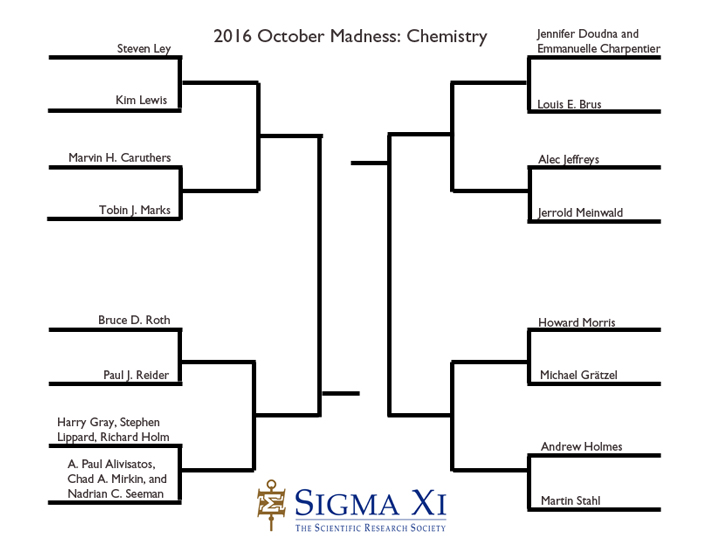
The October Madness Chemistry Sweet 16 match-ups are:
1.
Jennifer Doudna and Emmanuelle Charpentier for the CRISPR gene editing tool
VS
Louis E. Brus for his discoveries in semiconductor nanocrystals
2.
Alec Jeffreys for his work on variation and mutation in the human genome
VS.
Jerrold Meinwald for his pioneering work leading to the establishment of the field of chemical ecology and his fundamental studies of how chemicals act as repellents and attractants between organisms, leading to the use of these chemicals in variety of biomedical, agricultural, forestry, and household applications
3.
Howard Morris for improving our understanding of living systems at the molecular level by pioneering work in biomolecular mass spectrometry
VS.
Michael Grätzel for discovering dye sensitized solar cells, a new type of solar cell for powering portable electronic devices with applications for building integrated photovoltaics
4.
Andrew Holmes for his contributions to chemical synthesis at the interface between materials and biology and pioneering the field of organic electronic materials
VS.
Martin Stahl for his impact on the field of drug discovery with novel contributions that are used routinely to develop new medicines
5.
Steven Ley for his research in organic chemistry and contributions to the methodology of synthesis
VS.
Kim Lewis for the discovery of Teixobactin, the first antibiotic in 30 years
6.
Marvin H. Caruthers for contributions to the chemical synthesis of DNA and RNA that made it possible to decode and encode genes and genomes
VS.
Tobin J. Marks for contributions to understand catalysts, useful in the production of environmentally-friendly plastics and new materials
7.
Bruce D. Roth for he discovery, synthesis, and commercial development of the cholesterol-lowering medicine atorvastatin (Lipitor)
VS.
Paul J. Reider for the discovery and development of approved drugs, including those for treating asthma and for treating AIDS
8.
Harry Gray, Stephen Lippard, Richard Holm for work in bioinorganic chemistry
VS.
A. Paul Alivisatos, Chad A. Mirkin, and Nadrian C. Seeman for contributions to DNA nanotechnology
Economic Sciences
Vote here for your predictions for the Sveriges Riksbank Prize in Economic Sciences
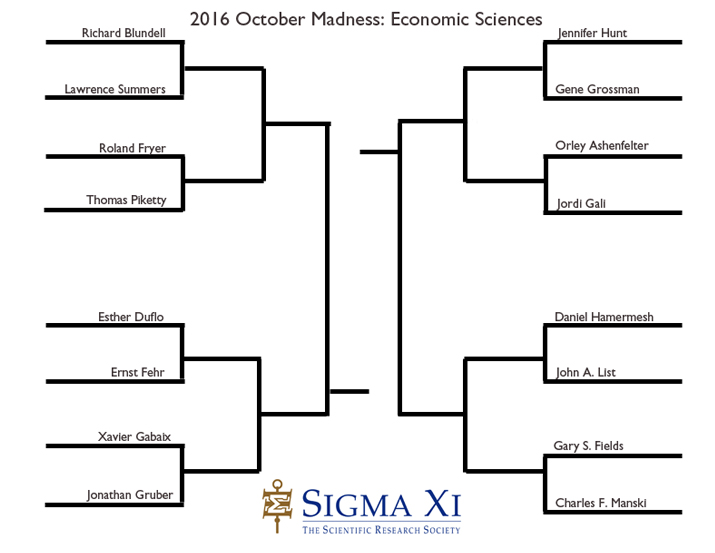
The October Madness Economic Sciences Sweet 16 match-ups are:
1.
Jennifer Hunt for analysis on immigration
VS.
Gene Grossman for work on the political economy of trade policy, using the environmental Kuznet’s curve to better understand the relationship between economic development and environmental quality
2.
Orley Ashenfelter for analysis on labor economics
VS.
Jordi Gali for advances in New Keynesian macroeconomic modeling that indicate the relationship between inflation stabilization and output gap stabilization is more complex than previously understood
3.
Daniel Hamermesh for his contributions to the study of labor demand
VS.
John A. List for innovations in field experiments that have resulted in breakthrough analyses of microeconomic behavior
4.
Gary S. Fields for contributions on the importance of efficient labor markets to fight poverty and foster economic development in low- and middle-income countries
VS.
Charles F. Manski for work in prediction, judgment, and decision, including identification of discrete choice models and identification of social interactions, and how they connect to policy outcomes
5.
Richard Blundell for his important contributions to labor economics, public finance and applied econometrics
VS.
Lawrence Summers for his important contributions in many areas of economics, primarily public finance, labor economics, financial economics, and macroeconomics
6.
Roland Fryer for groundbreaking quantitative analysis techniques that reveal causes and effects of economic and educational gaps based on racial discrimination and other inequities
VS.
Thomas Piketty for work on wealth and income inequality
7.
Esther Duflo for advances in applied economics through innovative field studies that examine how public policy affects microeconomic outcomes in developing nations
VS.
Ernst Fehr for pioneering research on the role of fairness in markets, organizations, and in individual decisions
8.
Xavier Gabaix for insights into connections between behavior and macroeconomics, leading to breakthrough analysis on discerning the true economic effects of low interest rates
VS.
Jonathan Gruber for work in crafting public health policy
Physics
Vote here for your predictions for the Nobel Prize in Physics.
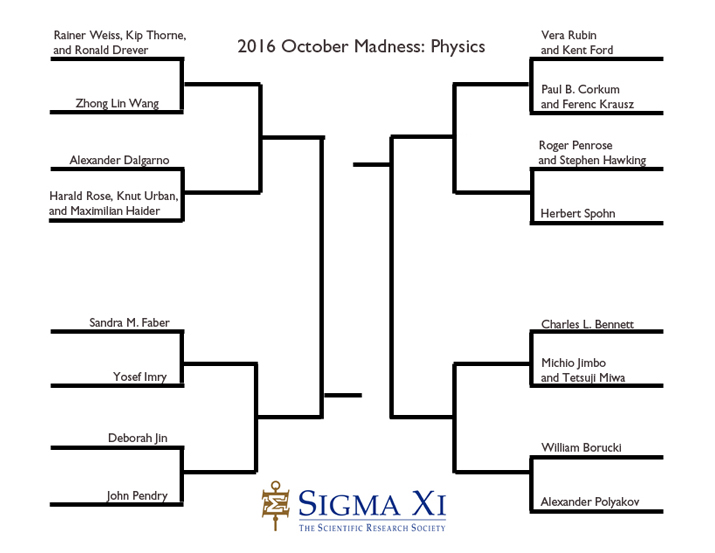
The October Madness Physics Sweet 16 match-ups are:
1.
Vera Rubin and Kent Ford for dark matter
VS.
Paul B. Corkum and Ferenc Krausz for pioneering attophysics, which uses lasers to detect molecular phenomena in a quintillionth of a second
2.
Roger Penrose and Stephen Hawking for their contribution to our understanding of the universe
VS.
Herbert Spohn for his seminal contributions to nonequilibrium statistical mechanics as exemplified by his exact solutions of growth models and stationary states of open systems
3.
Charles L. Bennett for mapping the cosmic microwave background and helping us learn about our universe
VS.
Michio Jimbo and Tetsuji Miwa for developments in integrable systems and their correlation functions in statistical mechanics and quantum field theory, making use of quantum groups, algebraic analysis and deformation theory
4.
William Borucki for leadership of NASA's Kepler mission, which uncovered planets and solar systems
VS.
Alexander Polyakov for his discoveries in field theory and string theory
5.
Rainer Weiss, Kip Thorne, and Ronald Drever for the direct detection of gravitational waves
VS.
Zhong Lin Wang for the invention of nanogenerators, a self-sufficient power source that can harvest energy from the human body or environment
6.
Alexander Dalgarno for his contributions to the development of the field of molecular astrophysics, which led to a better understanding of interstellar space and the formation of stars and planets
VS.
Harald Rose, Knut Urban, and Maximilian Haider for their development of abberation-corrected electron microscopy, allowing the observation of individual atoms with picometer precision
7.
Sandra M. Faber for leadership in numerous path-breaking studies of extra-galactic astronomy and galaxy formation
VS.
Yosef Imry for pioneering studies of the physics of mesoscopic and random systems
8.
Deborah Jin for pioneering investigations of the quantum properties of an ultracold gas of fermionic atoms, and for the creation of the first quantized gas of fermionic atoms
VS.
John Pendry for his seminal contributions to surface science, disordered systems, and photonics
Physiology or Medicine
Vote here for your predictions for the Nobel Prize in Physiology or Medicine.
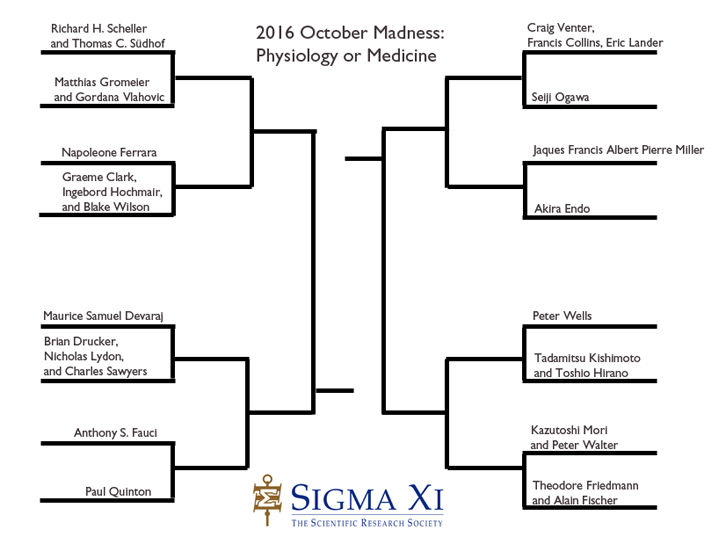
The October Madness Physiology or Medicine match-ups are:
1.
Craig Venter, Francis Collins, Eric Lander for the human genome sequence
VS.
Seiji Ogawa for the discovery of the principle for functional magnetic resonance imaging
2.
Jaques Francis Albert Pierre Miller for work on the immunological function of the thymus and of T cells, which has revolutionized the science of immunology
VS.
Akira Endo for the discovery of statins and their development
3.
Peter Wells for pioneering the development of ultrasonics as a diagnostic and surgical tool
VS.
Tadamitsu Kishimoto and Toshio Hirano for the discovery of interleukin-6 and its application in treating diseases
4.
Kazutoshi Mori and Peter Walter for identifying key components of the unfolded protein response
VS.
Theodore Friedmann and Alain Fischer for the proposal of gene therapy and its clinical applications
5.
Richard H. Scheller and Thomas C. Südhof for their discoveries in rapid neurotransmitted release
VS.
Matthias Gromeier and Gordana Vlahovic for using a genetically engineered polio virus (PVS-RIPO) to attack glioblastoma, a brain cancer, and discovering that it seeks out and attaches to receptors that are highly common across tumor types, while leaving normal cells alone
6.
Napoleone Ferrara for the discovery of vascular endothelial growth factor and devising an effective treatment for wet age-related macular degeneration
VS.
Graeme Clark, Ingebord Hochmair, and Blake Wilson for developing the modern cochlear implant
7.
Maurice Samuel Devaraj for the discovery of a method of suppressing mutations in pathogens such as tuberculosis
VS.
Brian Drucker, Nicholas Lydon, and Charles Sawyers for the development of novel treatments for chronic myelogenous leukemia
8.
Anthony S. Fauci for work on dissecting the mechanisms of pathogenesis of human immunodeficiency virus (HIV) that has served as the underpinning for strategies for the treatment of HIV
VS.
Paul Quinton for significant contributions to the understanding of the mechanisms behind cystic fibrosis, particularly the discovery that the fundamental defect in cystic fibrosis is chloride impermeability
Heather Thorstensen is the manager of communications for Sigma Xi, The Scientific Research Society.
-
by
User Not Found
| Aug 22, 2016
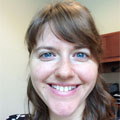
Sigma Xi, The Scientific Research Society led the first October Madness, a Nobel Prize prediction contest, last year. We had a blast (and even got a mention in Nature) as we crowdsourced nominations and ran weekly voting, moving researchers forward on our sports-style brackets until we reached our final predictions.
Now we are back for the second year and looking for your nominations as we wait for the official Nobel Prize winner announcements in October. It's another chance to honor extraordinary research accomplishments.
Nominations will be accepted through August 28, 2016.
We are calling for 16 nominations each for the:
- Nobel Prize in Chemistry
- Nobel Prize in Economic Sciences
- Nobel Prize in Physics
- Nobel Prize in Physiology or Medicine
How to Nominate and Vote
Send in your picks by 11:59 p.m. PDT on August 28 by using our nomination form or email me at hthorstensen@sigmaxi.org.
Please include:
- Your nominee's name (you can submit as many nominations as you would like and you can submit a group of researchers who worked on a project together)
- Which Nobel Prize you think this person, or group, should win
- The reason why you think the person or group should win (such as, "for the discovery of XYZ")
- The institution of employment or affiliation for your nominee(s)
- Your name and email address
On August 30, we will announce the October Madness nominees* and open the four brackets for public voting on Sigma Xi's social media. You can find us on Facebook, Twitter, Google+, and LinkedIn. Remember to use our hashtag, #OctoberMadness. We will also have links to the ballots on Sigma Xi's blog, Keyed In. Vote each week on Tuesdays (except for Labor Day week, when voting will be held on September 7) until your top picks are announced on September 27!
You Could Win
If you nominate someone who goes on to win a Nobel Prize, you will be entered into a raffle. If you win the raffle, and you're not a Sigma Xi member, you will receive a free year of membership in the Sigma Xi Affiliate Circle** for one year (a $70 value), which includes a one-year subscription to American Scientist magazine. Members who win the raffle will have their membership dues paid by Sigma Xi for 2016–17. Those who already renewed their membership will have their dues paid for 2017–18. We will select one winner per Nobel Prize category for a total of four winners.
Contest Schedule
August 22–August 28: Send in your nominations
August 30: Nominees announced; Sweet 16 voting begins and runs through 11:59 p.m PDT on September 5.
September 7: Sweet 16 winners announced; Elite 8 voting begins and runs through 11:59 p.m PDT on September 11.
September 13: Elite 8 winners announced; Final 4 (Semifinals) voting begins and runs through 11:59 p.m. PDT on September 18.
September 20: Final 4 winners announced; Finals voting begins and runs through 11:59 p.m. PDT on September 25.
September 27: Announcement of 2016 October Madness Winners.
October 3–10: Official Nobel Prize Winners named.
October 11: Winners announced from the raffle for a year in the Sigma Xi Affiliate Circle or a free year of Sigma Xi membership dues.
*If Sigma Xi receives less (or more) than 16 nominations per prize, then its staff will select the nominees who are put on the bracket. But we prefer to use your nominations! Please nominate anyone you feel is worthy of the prize. Potential candidates might be found here, here, here, or here. October Madness is not affiliated with the Nobel Prize.
**Affiliate Circle membership does not quality one for full or associate membership in Sigma Xi's nomination-based honor society.
Example of last year's final bracket for Physiology or Medicine
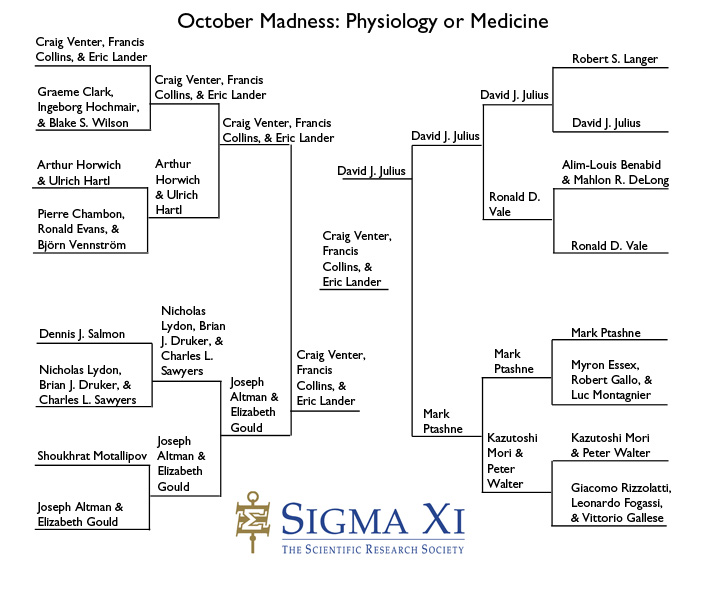
See other 2015 brackets.
-
by
User Not Found
| Aug 16, 2016
This is a guest post by Sigma Xi Executive Director and CEO John C. Nemeth.
Dear Sigma Xi Members,
 I hope your summer has been going well. We are busy here at Sigma Xi, and I have a few new initiatives at the intersection of research and policy to share.
I hope your summer has been going well. We are busy here at Sigma Xi, and I have a few new initiatives at the intersection of research and policy to share.
Research Communications Initiative
Sigma Xi recently launched the Research Communications Initiative (RCI) to help researchers and research institutions improve the way they spread the news about their work. Sigma Xi will work with its RCI partners to develop communication strategies, create content, publish the content in American Scientist if they so choose (as a fully disclosed product of the partnership), and provide a data-driven assessment of the success of their communications. RCI content will be published under a Creative Commons license, making it free to be republished.
This new program is central to the core values of Sigma Xi: honesty, integrity, and ethics in research. Our research is only helpful to society and public policymakers if we effectively communicate it, and that’s what this program aims to do. I hope you will take advantage of this opportunity and that you spread the word. You can find more details in the program announcement.
Science Questions for Presidential Candidates
This month, Sigma Xi joined ScienceDebate.org and 54 other nonpartisan organizations―including the American Association for the Advancement of Science and the National Academies of Sciences, Engineering, and Medicine―in sending 20 questions about science to U.S. presidential candidates Hillary Clinton, Donald Trump, Gary Johnson, and Jill Stein. The candidates were asked to answer the questions in writing and the media were invited to pose the questions to the candidates in televised debates. Sigma Xi members sent in their ideas for the questions, and many of their themes made it into the final questions. Thank you to those who participated. Now let’s see how the candidates respond.
Kids Science Reading Corner
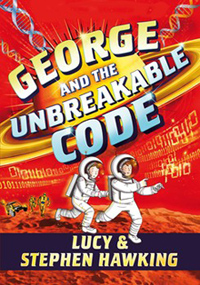 With this issue of Sigma Xi Speaks, I’m kicking off a new feature: the Kids Science Reading Corner. Each month I'll recommend a STEM-related book geared for kids. Over time, I expect to share books that will appeal to a range of ages, from the youngest readers through teenagers and young adults. I hope you and yours find the ideas fun and educational. If we can get kids interested in science and engineering, we can help them pursue it as a career or prepare them to support research as adults.
With this issue of Sigma Xi Speaks, I’m kicking off a new feature: the Kids Science Reading Corner. Each month I'll recommend a STEM-related book geared for kids. Over time, I expect to share books that will appeal to a range of ages, from the youngest readers through teenagers and young adults. I hope you and yours find the ideas fun and educational. If we can get kids interested in science and engineering, we can help them pursue it as a career or prepare them to support research as adults.
This first time out, I am suggesting that an adventurous pair, George and his best pal Annie, from the George’s Secret Key collection will become the dear friends of the kids in your life. Stephen Hawking and his daughter Lucy Hawking have written a marvelous series: George’s Secret Key to the Universe, George’s Cosmic Treasure Hunt, and George and the Big Bang, available through Simon and Schuster Books for Young Readers. Now, the fourth in the series, George and the Unbreakable Code, is due on bookstore and library shelves in September. Happy reading and learning!
Sincerely,

John C. Nemeth, PhD
Sigma Xi Executive Director, CEO, and Publisher of American Scientist
Sigma Xi Speaks is a monthly series of articles that connects research and policy. Find past articles on Sigma Xi’s blog, Keyed In.
-
by
User Not Found
| Jul 27, 2016
This is a guest post written by Sigma Xi President Tee Guidotti.
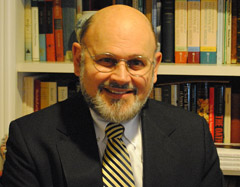 Vox, the popular online culture and news content provider (“magazine” is so passé!), has just published “The 7 Biggest Problems Facing Science, According to 270 Scientists,” by three of its top science writers. Our aspiring students, graduate students, postdocs, junior faculty, future administrators, and many others in the Vox demographic are reading that “science is in big trouble” and “many scientists are afflicted with a serious case of doubt—doubt in the very institution of science.”
Vox, the popular online culture and news content provider (“magazine” is so passé!), has just published “The 7 Biggest Problems Facing Science, According to 270 Scientists,” by three of its top science writers. Our aspiring students, graduate students, postdocs, junior faculty, future administrators, and many others in the Vox demographic are reading that “science is in big trouble” and “many scientists are afflicted with a serious case of doubt—doubt in the very institution of science.”
Briefly, Vox Media did a survey asking 270 scientists (including some unstated proportion of graduate students) from “all over the world” one question: “If you could change one thing about how science works today, what would it be and why? The survey obviously has big methodological and sampling problems but the findings, reordered here for logical flow, will not surprise career scientists.
1. “Academia has a huge money problem.”
Well, duh. Vox correctly identifies universities as the pinch point, because they are the home of investigator-initiated scientific research and the boot camp for basic training in research. Vox describes the current funding situation well but stops short of the deeper implications for academia: Universities are essentially rental units providing housing and infrastructure to cottage-industry research enterprises that depend for survival on sponsors, chiefly the U.S. federal government. When support falters or is unpredictable, it shakes the entire system: research faculty appointments, evaluation and promotion, continuity of research and training, and return on investment in research infrastructure. Investigators naturally become averse to taking risks. Arguably, research grants from the major funding agencies are no longer a solid foundation for a serious academic career. In biomedical sciences, especially, the system now leaves most talented scientists behind and often strands them in mid-career, diverting them from other careers or fields where their contributions might be greater.
2. “Too many studies are poorly designed. Blame bad incentives.”
True again. A significant portion of published science is poor quality or misleading to uncritical readers, usually junior investigators or lay readers. The volume of mediocre work clogs the literature.
The pressure to publish is intensifying worldwide because research activity is equated with quality and value in faculty advancement. At present, the only practical way to evaluate and grade research on a mass scale is for faculty to submit their work in the form of manuscripts for peer review and to use publication as a proxy measure for quality.
3. “Peer review is broken.”
Not exactly news. The fundamental problem behind mediocre studies debasing the literature is that there is only one acceptable way to evaluate quality, and that is peer review. STEM publications have become so specialized that peer review can only be done by a colleague in the same or a closely related field, which leads not only to conflicts of interest but to reviewer fatigue, cursory reviews, and bias born of heuristics (mental shortcuts), because few reviewers have time to look at the problem deeply from the investigator’s nuanced point of view. Other problems of peer review are equally manifest and well known. (As a journal editor, managing peer review is my single biggest challenge.)
4. “Too much science is locked behind paywalls.”
Yes, there are commercial barriers to accessing much important science: user and pay-per-view fees, subscription costs, licensing fees and royalties, proprietary data restrictions, patents, and other obstacles. The open access movement is an attempt to break through all this, a revolution with the rallying cry “information wants to be free!” Sigma Xi supports open access. Still, before universal open access can flourish unfettered, important issues of the gatekeeper roles of editors, the quality assurance function of reviewers, and the interests of authors remain to be sorted out.
5. “Replicating results is crucial. But scientists rarely do it.”
Kind of true, but strict replication is not always practical. It was once common for scientists to replicate their experiments themselves several times before publishing.
There are only two situations today in which scientists would want to replicate someone else’s study exactly and that is 1) when they are starting a new line of investigation and have to master the technique, and 2) when the original study is already suspect or incompatible with new evidence. Otherwise, replication is time and funding lost. More often today, scientists rely on convergent evidence, in which a study using different methods produces a similar result that supports the finding.
The main factor that discourages replication today, however, is probably the strong management pressure and policies to avoid “duplication,” which seems wasteful and unnecessary to managers, funding agencies, and Congress.
6. “Science is poorly communicated to the public.”
Absolutely, undeniably true. Sigma Xi has been addressing this problem for years through its magazine, American Scientist, and through events run by its chapters that bring science to the public.
7. “Life as a young academic is incredibly stressful.”
Well, yeah. No argument there.
-
by
User Not Found
| Jul 19, 2016
Moving the Needle on Research
This is a guest post written by Sigma Xi Executive Director and CEO John Nemeth.
 A poll conducted earlier this year by Research!America found that only 17 percent of Americans could name a living scientist. We, as Sigma Xi members, can and should help move the needle in a more positive direction.
A poll conducted earlier this year by Research!America found that only 17 percent of Americans could name a living scientist. We, as Sigma Xi members, can and should help move the needle in a more positive direction.
This month, I encourage you to contact your friends, civic clubs, colleagues, and elected officials―all your non-scientist relationships―to let them know that you are a researcher and invite them to come to you and Sigma Xi when they have a question about science, technology, engineering, and math (STEM). If you’re on social media, spread the news using #AskAScientist.
Putting that invitation out there is an important way that we can engage with our communities and help our neighbors put a face to research. It also opens the door to helping people trust in research results. That way, they can come to understand our work and know that research is a requirement for the wellbeing of humanity.
Trust is a key issue here. Our societies need research to be used in the process of making public and private policies. In order to make that happen, research needs to already have a place at the table. The way we get there is by building relationships now.
An example of what I’m asking of you might be to volunteer to give a presentation at your Lions Club or respond to a question on Facebook. I knew someone for 10 years before she realized I was a scientist, and then she started asking me questions. And you know what? It was fun to answer them. Perhaps by sharing your knowledge you will inspire a student to pursue a STEM career or help someone understand our world a little bit better.
Don’t forget to encourage those you know to subscribe to Sigma Xi SmartBrief so they can get a free email regularly about research news. Sigma Xi also has Google Hangouts featuring distinguished researchers sharing their work, and we invite the public to participate in the live broadcasts or to watch the recordings.
I’d like to hear the questions you receive from your community. Let me know at executiveoffice@sigmaxi.org.
Sincerely,

John C. Nemeth, PhD
Sigma Xi Executive Director, CEO, and Publisher of American Scientist
Sigma Xi Speaks is a monthly series of articles that connect research and policy. Find past articles on Sigma Xi’s blog, Keyed In.
-
by
User Not Found
| Jun 21, 2016
Help Build the Voice for Credible Research
This is a guest post by Sigma Xi Executive Director and CEO John C. Nemeth.
 Many members want Sigma Xi to be the voice for credible research in the United States. And it should. Supporting the public’s understanding of research and influencing policy is central to Sigma Xi’s mission.
Many members want Sigma Xi to be the voice for credible research in the United States. And it should. Supporting the public’s understanding of research and influencing policy is central to Sigma Xi’s mission.
I need your help to create that voice on a national, and even international, scale. You are Sigma Xi’s voice in your local area and beyond. If you learn of an interesting study or research finding, pass it on through social media, send an email, or bring it up in conversation.
I encourage you and yours to subscribe to Sigma Xi SmartBrief, if you haven’t already. It will give you plenty of news to share. It is an email sent daily, Monday through Friday, with research news from sources such as Discover, the BBC, and The Washington Post. Anyone can subscribe and it’s free. Many count it as a major membership benefit.
Very importantly, please invite your family, friends, and elected officials to subscribe to Sigma Xi SmartBrief. We have a letter that you may send on behalf of Sigma Xi to invite them to subscribe.
As researchers, we need the public’s support so they trust our findings and fund our projects. The more that people know what research does for them, the more likely they are to be research supporters. Collectively, we can demonstrate how research plays a critical role in all of our lives.
Sincerely,

John C. Nemeth, PhD
Sigma Xi Executive Director and CEO
-
by
User Not Found
| May 03, 2016
This is a guest post written by Sigma Xi President-Elect Tee Guidotti, who recently completed a term as the Fulbright Visiting Research Chair in Environment and Sustainability at the University of Ottawa’s Institute for Science, Society, and Policy.
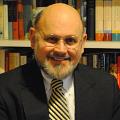 Sigma Xi has two main missions, to protect and strengthen the research enterprise, including protecting its integrity, and to make science accessible to, and useful for, society. Both require active involvement in public policy. Members can expect to see more activity coming in science policy.
Sigma Xi has two main missions, to protect and strengthen the research enterprise, including protecting its integrity, and to make science accessible to, and useful for, society. Both require active involvement in public policy. Members can expect to see more activity coming in science policy.
What is this “science policy” of which I speak?
Science policy is a well-established, coherent field of public service. It rests on the observation that there are two interacting relationships between science and public policy, commonly formulated (after Roger Pielke, Jr.) as “science for policy” and “policy for science.”
Science for policy is the application of scientific knowledge to problems in public policy. This implies that the scientific knowledge is understood, digested, and integrated into policy options by those who shape and make decisions. Acceptance of advice is profoundly influenced by public understanding, appreciation for, and acceptance of science, and even more by the level of comprehension and acceptance by decision-makers.
Policy for science is the formulation of public policy for the support and promotion of scientific research and STEM education. The natural tendency of governments and politicians is to look at research as an engine of economic growth and its output as the sum of its products, rather than the transformational power of science through awareness, understanding, and explanation. Funding agencies, scientific societies, and investigators in the basic sciences constantly resist pressure, usually from politicians, to judge all science solely on the industrial model of short-term return on investment, rather than the public good model of knowledge as a deep and growing resource.
A key insight of science policy studies is that the two sides of science policy interact, so that what is known and available as knowledge upon which to draw to solve problems in the present (in other words, science for policy) is limited by what support there has been in the past for research (in other words, the previous administration’s or regime’s policy for science). Similarly, current public support for scientific research is largely determined not by the achievements of science as a way of knowing about the world, which is what inquiry-driven science was designed to do, but by what has been deemed useful in the immediate past and has yielded wonder or familiar practical benefit.
Detractors of science and policy skeptics, and they are legion, reduce this formulation to caricature. To them, “science for policy” means “take my word for it because you can’t understand” and “policy for science” means “budget more money” because “more research is needed.” This caricature leads to the pernicious perception that scientists and engineers are nothing more than an interest group like all other self-serving interest groups, whose concerns should be managed politically. This may seem like just ordinary anti-intellectual posturing but it is much deeper than that. It has its roots in genuine confusion over the role of science and who benefits from it. It also has roots in a pernicious intellectual argument still raging in the humanities (the attack on “logical positivism”) that was aimed at scientism (the belief that all problems can be solved by science alone) but hit an innocent victim (the concept of objective reality) instead. Overcoming this perception of science as self-serving, particularly at a time when trust in scientists is declining, is one of our biggest challenges. Professionals in the STEM disciplines usually have little patience and no desire to engage in such arguments and so abandon the field.
Great scientists have distinguished themselves in public policy, separate from the contributions made through their scientific work and distinct from just expressing opinions: Einstein, Polanyi, Bush, Haldane, and Newton to name a few. Too often, however, science policy is viewed with disdain by scientists and engineers, who consider it to be no more than “science politics.”
Such attitudes equate to surrendering the future of science to those in positions of power who least understand it. Indifference to science policy is an abnegation of responsibility, an invitation for research and the interests of scholars in the STEM disciplines to be manipulated and exploited by politics, money, and power.
Rational public policy needs the input of science. Rationality in public policy requires a culture that appreciates objective truth, evidence, and logical thinking, in other words, the values of science. Science policy is therefore not just about good science well interpreted, but a culture of science.
Sigma Xi can play a constructive role in science policy in many ways. Sigma Xi can, if members support the idea, provide training for improving members’ skills in science communication, serving (not pontificating) as good, “honest brokers” for science policy, promoting nonpartisan political and sociotechnical awareness, invigilating integrity in science so that our own moral position is firm, and demonstrating effectiveness in advocating for support of, and analyzing policies for, science.
-
by
User Not Found
| Apr 28, 2016
This is a guest post written by Sigma Xi member Thorsen Wehr, a freshman at the University of Washington. Sigma Xi sent Thorsen to the USA Science & Engineering Festival thanks to support from DIRECTV.
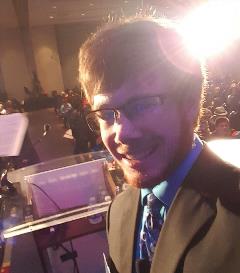 Recently I had the honor of representing Sigma Xi as a student researcher at the USA Science & Engineering Festival's X-STEM event in Washington, D.C.! The event is aimed towards educating K–12 students in current science endeavors as well as promote interest in STEM. It was absolutely amazing, full of great speakers from astronauts to startup company representatives.
Recently I had the honor of representing Sigma Xi as a student researcher at the USA Science & Engineering Festival's X-STEM event in Washington, D.C.! The event is aimed towards educating K–12 students in current science endeavors as well as promote interest in STEM. It was absolutely amazing, full of great speakers from astronauts to startup company representatives.
(A full speaker line-up is online.)
My presentation to these students was to inform them on how to get into science research, including where to start and how to create a successful research experiment. My goal for this event was to inspire students that might have been on the fence about research to commit and try it out! The presentation went very well, with a crowd of students lined up to ask additional questions after the time ran out. I am still taking email questions from students and trying to help them all figure out where to take their interest in STEM. I even got to sign the trading cards they made of me like some sort of celebrity!
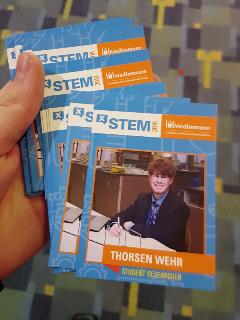 I was sure to mention the Chronicle of The New Researcher, Sigma Xi's online journal for high school research, which has been very beneficial for me, and am excited to see a flood of new, exciting research be submitted next year. I was excited when given this opportunity because after the success I have had with student research, I want every student to be aware of the plethora of support and recognition that is waiting for them. It is my honor to take my experiences through research and use them as an example for the future of student research. If my presentation convinced even just one student to take their passion for STEM and apply it towards research, I am glad that I went.
I was sure to mention the Chronicle of The New Researcher, Sigma Xi's online journal for high school research, which has been very beneficial for me, and am excited to see a flood of new, exciting research be submitted next year. I was excited when given this opportunity because after the success I have had with student research, I want every student to be aware of the plethora of support and recognition that is waiting for them. It is my honor to take my experiences through research and use them as an example for the future of student research. If my presentation convinced even just one student to take their passion for STEM and apply it towards research, I am glad that I went.
Through this presentation, I have learned just how engaged these students really are about science. I was expecting to see a room full of students brought in by their schools, unwillingly sitting through lecture after lecture. What I found was a room full of attentive students sitting on the edges of their seats, some even taking notes. I am very glad to see that there is such a large group of interested students for the future, and am glad I could be the one to help them on their road to success. The footage of my talk should be up soon on the USA Science & Engineering Festival site!
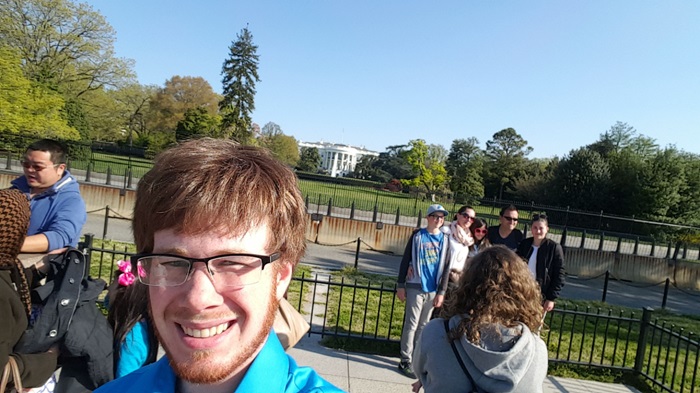
-
by
User Not Found
| Mar 16, 2016
/nemeth_new_240x187.tmb-thumbnail.jpg?sfvrsn=19fda458_1) I am pleased to welcome you to the second installment of Sigma Xi Speaks! This initiative provides you with policy-relevant information generated by the Society’s communications and publications staff. Sigma Xi Speaks is distributed on a regular basis to ensure that you have the most up-to-date facts and figures. I want to urge readers to pass the links (or even copy the articles) to family and friends through their social medium of choice. Let us know how you shared it and stay tuned.
I am pleased to welcome you to the second installment of Sigma Xi Speaks! This initiative provides you with policy-relevant information generated by the Society’s communications and publications staff. Sigma Xi Speaks is distributed on a regular basis to ensure that you have the most up-to-date facts and figures. I want to urge readers to pass the links (or even copy the articles) to family and friends through their social medium of choice. Let us know how you shared it and stay tuned.
First, I’d like to draw your attention to the recent publication of the areas of consensus and debate results from last year's Communicating Science for Policy conference. In August 2015, Sigma Xi and Institute on Science for Global Policy coordinated this event, which focused on linking scientifically credible information to the formulation and implementation of sound, effective policies.
The conference organizers and participants identified three main areas of consensus:
-
Publicly funded organizations have a responsibility to report the results of scientific research in a meaningful manner to nonexperts (i.e., the public or policy makers) in a timely and accessible format, using nontechnical language and having relevance to the audience’s respective lifestyles and policy decisions.
-
Storytelling is a valid and credible method of communicating science. The storyteller needs to deliver an accurate, transparent, and ethical interpretation of the scientific data.
-
Efforts must be made to improve public literacy concerning science by (i) training individuals in how to effectively communicate scientific information and (ii) teaching individuals how to more rationally evaluate the validity and relevance of the scientific information conveyed.
The March–April 2016 issue of American Scientist includes research and insights on three major topics—the effects of a changing climate on forestry, agriculture, gardening, tourism, and ecology; the increase in production and use of nanoparticles; and the recruitment and retention of underrepresented minorities in science, technology, engineering, or mathematics (STEM).
In the article, “Spring Budburst in a Changing Climate,” (Mar–Apr 2016, pages 102–109) authors Richard Primack and Amanda Gallinat describe the challenges we face as climate change causes leaf emergence times to desynchronize from evolved bird and insect activity patterns. Researchers at botanical gardens around the world are collectively monitoring leafing out times to understand this heretofore under-appreciated aspect of natural history, so that we can make better predictions about forest ecosystems as the climate changes. The forthcoming changes will affect a number of key industries, including forestry, agriculture, and tourism.
A Spotlight interview (Mar–Apr 2016, pages 70–72) with research chemist Bryant Nelson illuminates emerging issues related to the regulation of the booming nanoparticle production industry. Managing Editor Fenella Saunders spoke to Nelson about the possibility that nanoparticles may cause genetic damage. Nelson said that we need new methods and technologies to be able to detect and discriminate between the different types of nanomaterials that are potentially entering the environment.
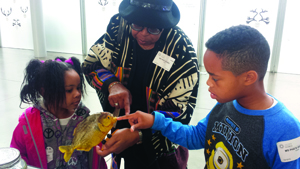 In the article, “How to Recruit and Retain Underrepresented Minorities” (Mar–Apr 2016, pages 76–81) Ashanti Johnson and Melanie Harrison Okoro share their experiences creating programs to attract people of color into marine science. Johnson, the assistant vice provost for faculty recruitment and associate professor of environmental science for the University of Texas at Arlington, and recipient of the Presidential Award for Excellence in Science, Mathematics, and Engineering Mentoring, and Okoro, a NOAA water quality specialist and Johnson’s former mentee, provide details about what works to attract and retain students, while emphasizing the need for additional resources to support underrepresented minorities in research.
In the article, “How to Recruit and Retain Underrepresented Minorities” (Mar–Apr 2016, pages 76–81) Ashanti Johnson and Melanie Harrison Okoro share their experiences creating programs to attract people of color into marine science. Johnson, the assistant vice provost for faculty recruitment and associate professor of environmental science for the University of Texas at Arlington, and recipient of the Presidential Award for Excellence in Science, Mathematics, and Engineering Mentoring, and Okoro, a NOAA water quality specialist and Johnson’s former mentee, provide details about what works to attract and retain students, while emphasizing the need for additional resources to support underrepresented minorities in research.
We hope you will use these resources to advance your science policy efforts. And let us know if you are looking for information about a particular policy issue.
Sincerely,

John C. Nemeth, PhD
Sigma Xi Executive Director and CEO
-
by
User Not Found
| Feb 29, 2016
This is a guest post written by Richard Watkins, the director of Sigma Xi’s Southeastern Region.
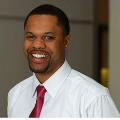
As the beneficiary of goodwill from my scientific mentors, I maintain a passion for increasing diversity in science and serving as a role model for future generations of scientific leaders. To this point, I owe my presence in the scientific community to those minority scientists who took me under their wing and introduced me to the broader scientific community. Now that I am advancing my own career, it seems natural for me to give back.
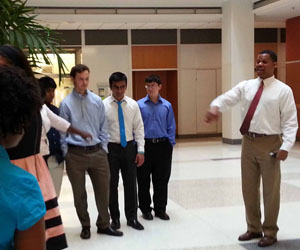 On several occasions while attending scientific conferences, I’ve been approached by aspiring minority scientists who unexpectedly thanked me. When I ask why they are thanking me, they respond by saying that seeing me—a young black researcher—reassures them that they too can become a scientist. Although this is personally fulfilling, I believe there is much more work to be done to improve minority participation in science, technology, engineering and mathematics (STEM) fields.
On several occasions while attending scientific conferences, I’ve been approached by aspiring minority scientists who unexpectedly thanked me. When I ask why they are thanking me, they respond by saying that seeing me—a young black researcher—reassures them that they too can become a scientist. Although this is personally fulfilling, I believe there is much more work to be done to improve minority participation in science, technology, engineering and mathematics (STEM) fields.
Historically, white men have dominated the scientific enterprise, but over the past several decades, many initiatives have been undertaken to increase diversity in science. Despite major initiatives designed to address the disparity, it has been difficult to determine whether the state of diversity in science has improved. To evaluate the progress toward this goal, several organizations have collected data regarding diversity in science, most notably is the U.S. Census.
The 2010 U.S. Census data paints a very sobering picture of the lack of gender diversity in science. Women represent over 47.5% of the residential population of the U.S., but represent only 25.8% of the STEM workforce. These statistics are for the most part reversed for STEM-related occupations, a classification from the U.S. Census that includes jobs such as medical and health services managers, registered nurses, and dental hygienists. STEM-related occupations are held predominately by women (26% to 74% men to women respectively). It is well-known that systemic barriers prevent women from STEM careers (National Survey Conducted by AAAS and Science Confirms Continuing Obstacles to Women in Science, Ginger Pinholster, September 28, 2010); however defining and eliminating those barriers has proven difficult. As a result, men represent 61% of all science and engineering graduates, whereas women only represent 39%.
Gender is not the only area of diversity in which the scientific community struggles to achieve balance; race is another glaring problem. According to the U.S. Census data, non-Hispanic whites and Asians are overrepresented in STEM occupations. While over 70% percent of the U.S. STEM workforce is composed of whites, less than 14% is black or Hispanic. Hispanics represent 14.9% of the total workforce but only 6.5% of the STEM workforce. Similarly, blacks represent 10.8% of the overall workforce but only 6.4% of the STEM workforce.
It is not clear why the representation of blacks and Hispanics in the STEM workforce fails to reflect their representation in the general workforce. The problem appears to manifest as a result of their underrepresentation in STEM degree programs. Blacks only represent 7.1% of those with bachelor degrees in science. Similarly Hispanics represent 6.8% of those with bachelor degrees in a science or engineering field. Therefore it seems there is a need to recruit at an early age and provide support as these students progress through STEM programs.
Recruiting minorities into the STEM workforce is about more than equal representation. Given that the median income for STEM occupations is consistently higher than the median income for U.S. workers, minority groups are missing out on an opportunity to address economic disparity. According to the U.S. Census data, the median income for black families is $20,000 less per year than the American median income. However, a woman who receives a bachelor’s degree in science and goes into the STEM workforce on average earns $75,000 annually, whereas the average annual income of the total workforce is $58,800. That’s a difference of $16,200. Therefore, a career in science becomes a means toward economic stability and progression. This is essential for the empowerment of economically disadvantaged groups. Thus it is paramount that all groups are initially given fair and equitable access to programs that develop proficiencies in science and technology and, ultimately, pathways to STEM careers.
The Chancellor’s Science Scholars Program at the University of North Carolina at Chapel Hill provides a pathway to success for highly able students who aspire to become leading PhD and MD/PhD scientists in our increasingly interdisciplinary world. Aiming to increase the diversity among future science leaders, CSS is modeled after the nationally recognized Meyerhoff Scholars Program at the University of Maryland-Baltimore County. The Chancellor’s Science Scholars Program provides a head start and continuous support for superb students, allowing them to succeed in math and science at the highest level (http://chancellorssciencescholars.web.unc.edu).
As the program coordinator for the Chancellor’s Scholars Program, I focus on preparing students for success in graduate school and beyond. Together with similar programs implemented at other institutions, we are working to cultivate and groom the world’s best talent. With an emphasis on diversity, the Chancellor’s Science Scholars Program is part of the University of North Carolina’s larger commitment to diversity in STEM (http://www.unc.edu/spotlight/diversity-in-stem/).
Richard Watkins is the program coordinator of the Chancellor’s Science Scholars Program at the University of North Carolina at Chapel Hill.
Photo caption: The author with students in the University of North Carolina at Chapel Hill's Chancellor's Science Scholars Program.
-
by
User Not Found
| Feb 26, 2016
What could help more African Americans be successful in science, technology, engineering, and math? Janelle Simmons, Sigma Xi's manager of programs, moderated a discussion on this topic that was held over a Google Hangout on February 22, 2016.
The panelists were Ashanti Johnson, assistant vice provost for faculty recruitment and associate professor of environmental science for the University of Texas at Arlington as well as executive director of the Institute for Broadening Participation; Melanie Harrison Okoro, water quality specialist with the National Oceanic and Atmospheric Administration and its National Marine Fisheries Service West Region aquatic invasive species coordinator; and Danielle Lee of Cornell University, a TED fellow and a biologist who studies animal behavior, mammalogy, and ecology.
Lee also writes the blog, The Urban Scientist. Johnson and Okoro co-wrote "How to Recruit and Retain Underrepresented Minorities," an article published in the March–April 2016 issue of Sigma Xi's magazine, American Scientist.
-
by
User Not Found
| Feb 09, 2016
/nemeth_new_240x187.tmb-thumbnail.jpg?sfvrsn=19fda458_1) On January 13, 2016, I invited you to become a voice for science by participating in a communication experiment. Today, as promised, I am pleased to welcome you to the first installment of Sigma Xi Speaks! Through this new initiative, we will provide you with policy-relevant information generated by the Society’s communications and publications staff. We encourage you to share this information with your friends, family, colleagues, and local and national elected officials via social media, email, or in-person. Please let us know how you shared it and stay tuned. We’ll be distributing new installments of Sigma Xi Speaks on a regular basis.
On January 13, 2016, I invited you to become a voice for science by participating in a communication experiment. Today, as promised, I am pleased to welcome you to the first installment of Sigma Xi Speaks! Through this new initiative, we will provide you with policy-relevant information generated by the Society’s communications and publications staff. We encourage you to share this information with your friends, family, colleagues, and local and national elected officials via social media, email, or in-person. Please let us know how you shared it and stay tuned. We’ll be distributing new installments of Sigma Xi Speaks on a regular basis.
Sigma Xi’s magazine, American Scientist, often contains unbiased, scientific information that can be shared with policymakers at all levels to inform policy decisions. Articles from the November–December 2015 and January–February 2016 issues include research and insights on four national issues—consideration of future energy options, the environmental impact of dam building, the problem of sexism in science, and the secondary benefits of federally funded innovations.
In the article, “The Rising Cost of Resources and Global Indicators of Change,” (Nov–Dec 2015, pages 410–417) author Carey King, assistant director at the Energy Institute at The University of Texas at Austin, explains the importance of considering the biophysical and socioeconomic context in which we make decisions about our energy future.
This may interest you because:
-
The author states that the turn of the 21st century marked an important societal milestone, as the time of the cheapest food and energy the world has ever known. However, the trend of increasing food and energy services consuming a declining proportion of our economic output (in terms of gross domestic product) seems to be over.
-
It is practically impossible for us to significantly alter many of the long-term causes of energy and food cost trends. As a consequence, the ability of our energy system to aid in the achievement of environmental and socioeconomic goals lies primarily in using technology to consume less energy and deal with the fact that Earth is a finite planet.
-
We have, and we will, continue to develop innovations in our food and energy systems, but we must be humble in what we expect to achieve in terms of the cost of these necessities.
 Work that contributes to understanding the impact of future megadams on global biodiversity is featured in “Where the Xingu Bends and Will Soon Break” (Nov–Dec 2015, pages 395–403). Mark Sabaj Pérez, interim curator of ichthyology at the Academy of Natural Sciences of Drexel University, served as co-principal investigator on the iXingu Project, a collaborative effort to help establish ecological and biological baselines for the Xingu River in Brazil. His team gathered a wealth of specimens and empirical data that, when combined with Brazilian-led studies, afford a valuable snapshot of the fauna and ecology of the middle and lower Xingu. Such knowledge is essential for assessing the eventual impacts of the Belo Monte megadam building project and will inform future efforts to conserve what remains of the Xingu.
Work that contributes to understanding the impact of future megadams on global biodiversity is featured in “Where the Xingu Bends and Will Soon Break” (Nov–Dec 2015, pages 395–403). Mark Sabaj Pérez, interim curator of ichthyology at the Academy of Natural Sciences of Drexel University, served as co-principal investigator on the iXingu Project, a collaborative effort to help establish ecological and biological baselines for the Xingu River in Brazil. His team gathered a wealth of specimens and empirical data that, when combined with Brazilian-led studies, afford a valuable snapshot of the fauna and ecology of the middle and lower Xingu. Such knowledge is essential for assessing the eventual impacts of the Belo Monte megadam building project and will inform future efforts to conserve what remains of the Xingu.
Pat Shipman, professor emerita of anthropology at the Pennsylvania State University, shares her experiences dealing with institutional sexism, in “Taking the Long View on Sexism in Science” (Nov–Dec 2015, pages 392–394). Decades after Shipman’s departure from academic science, too many others are still leaving for the same reasons. She states that as long as the leadership in science is so overwhelmingly oblivious to discrimination, the fight to root out conscious and unconscious bias against women will continue.
The applications of airborne LiDAR are growing ever more diverse. In their article, “Archaeology from the Air” (Jan–Feb 2016, pages 28–35), William Carter, Ramesh Shrestha, and Juan Fernandez-Diaz describe the scientific benefits of this technology. It was originally developed for use by state departments of transportation and environmental protection to reduce the time and cost of acquiring the information they needed to build new highways, measure beach erosion, delineate flood zones, and quantify damage from forest fires and other natural disasters. In addition to refining federal engineering projects, use of airborne LiDAR systems by archaeologists has revolutionized the mapping of remote ancient ruins hidden by vegetation. Today, airborne LiDAR is used to meet a range of research needs, from research designed to test geomorphic transport laws, map channel incision, explain hydrologic processes, define vegetation patterns and explore their controls, document snow accumulation, quantify floodplain sedimentation, document and discover active faulting, map landslides, predict fire hazards, characterize impact craters, quantify lava flow mechanics, document sediment transport and erosion, and monitor beach erosion. The prospects for LiDAR continue to expand thanks to continued investment by federal agencies.
We look forward to hearing about how you’re spreading the word and the feedback you’re receiving.
John C. Nemeth is the executive director and CEO of Sigma Xi, The Scientific Research Society.
Photo caption: Brazil's Xingu River, the third largest tributary to the Amazon, harbors rapids among the most extensive in the world. The man in the photograph above is from the Juruna ethnic group and, although posed, is showing a traditional form of fishing with bow and arrow in the Xingu's rapids. Image courtesy of Verena Glass/Xingu Vivo.
-
by
User Not Found
| Jan 26, 2016
This guest post was written by Christopher M. Graney.
Occasionally science outreach works and expands the audience of people attentive to science. One such occasion was on the evening of December 9, 2015, in Louisville, Kentucky. The Louisville Chapter of Sigma Xi sponsored a program at the Louisville Free Public Library that drew 600 people. They came to hear two scientists from two different centuries speak. The event was titled: “Beneath the Same Sky: A Vatican Astronomer and a Civil War General Speak to Louisville about the Heavens.”

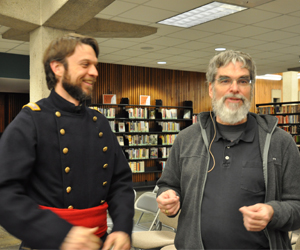 One of our speakers was Dr. Guy Consolmagno, a Jesuit Brother who Pope Francis recently appointed Director of the Vatican Observatory and who has written some very popular books on astronomy, including Turn Left at Orion (with Dan Davis), and most recently Would You Baptize an Extraterrestrial? (with Father Paul Mueller, SJ). The other was Kentucky-born Ormsby Mitchel, founder of the Cincinnati Observatory and a General in the Union Army in the Civil War (Mitchel was portrayed by teaching artist Tony Dingman of the Frazier History Museum).
One of our speakers was Dr. Guy Consolmagno, a Jesuit Brother who Pope Francis recently appointed Director of the Vatican Observatory and who has written some very popular books on astronomy, including Turn Left at Orion (with Dan Davis), and most recently Would You Baptize an Extraterrestrial? (with Father Paul Mueller, SJ). The other was Kentucky-born Ormsby Mitchel, founder of the Cincinnati Observatory and a General in the Union Army in the Civil War (Mitchel was portrayed by teaching artist Tony Dingman of the Frazier History Museum).
Dingman spoke first as Mitchel, describing the vast scale of the universe in a speech closely based on one given in 1847 by the real Mitchel. He noted that the universe was comprehensible by human beings, being governed by laws we can understand. Of the universe and its laws he stated, “God has given us these works for our examination, and He has given us this intellect by which we are enabled to comprehend their structures; and it is by this that we are able to rise—to climb—to soar, by our own efforts and by His aid.”
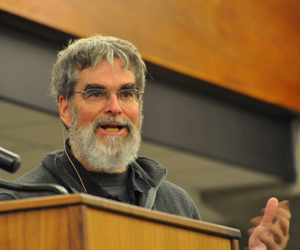 Consolmagno spoke about the Vatican Observatory and about the nature of science, focusing on ideas from the history of astronomy that were “almost correct”—ideas which ranged from the relationship between comets and meteor showers to the nature of the moons of Jupiter. “Sometimes,” he said, “science makes its most significant progress when it’s almost correct—which is to say, when it’s wrong.” He took questions from the audience, ranging from whether the recent flyby of Pluto changed his mind about the dwarf planet (he was on the committee that recommended that Pluto no longer be classified as a planet) to how he fit together his scientific knowledge and the book of Genesis. The speakers were regularly interrupted by laughter and applause, and the comments that both the library and our chapter received were unanimously positive.
Consolmagno spoke about the Vatican Observatory and about the nature of science, focusing on ideas from the history of astronomy that were “almost correct”—ideas which ranged from the relationship between comets and meteor showers to the nature of the moons of Jupiter. “Sometimes,” he said, “science makes its most significant progress when it’s almost correct—which is to say, when it’s wrong.” He took questions from the audience, ranging from whether the recent flyby of Pluto changed his mind about the dwarf planet (he was on the committee that recommended that Pluto no longer be classified as a planet) to how he fit together his scientific knowledge and the book of Genesis. The speakers were regularly interrupted by laughter and applause, and the comments that both the library and our chapter received were unanimously positive.
The full program can be viewed on Youtube.
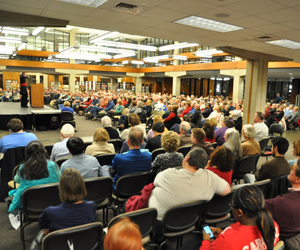 Our chapter wanted a program to raise Sigma Xi’s profile in the community, attract new members, and revive lapsed members. That meant a program featuring a noted scientist who would generate broad interest. Consolmagno is such a scientist. He has appeared on The Colbert Report. He received the American Astronomical Society’s 2014 Carl Sagan Medal for his ability to communicate with the public. Moreover, with the popularity of Pope Francis and the heavy media coverage of his recent U.S. visit, a Vatican astronomer seemed likely to draw interest (but we never expected to draw 600 people). Mitchel added a local connection and has also been compared to Sagan for his communication ability.
Our chapter wanted a program to raise Sigma Xi’s profile in the community, attract new members, and revive lapsed members. That meant a program featuring a noted scientist who would generate broad interest. Consolmagno is such a scientist. He has appeared on The Colbert Report. He received the American Astronomical Society’s 2014 Carl Sagan Medal for his ability to communicate with the public. Moreover, with the popularity of Pope Francis and the heavy media coverage of his recent U.S. visit, a Vatican astronomer seemed likely to draw interest (but we never expected to draw 600 people). Mitchel added a local connection and has also been compared to Sagan for his communication ability.
I made the acquaintance of both astronomers through my research on astronomy’s history. A focus of that research has been the seventeenth-century astronomer Giovanni Battista Riccioli. He studied gravity, gave lunar features the names we now use, and assembled strong scientific arguments against the Copernican system. He was also a Jesuit, which led me to a modern Jesuit astronomer: Consolmagno.
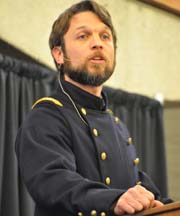 Acquaintance with Mitchel came through a conference at the University of Notre Dame this past summer. There Trudy Bell, an editor with Sky & Telescope, talked on Mitchel and his speaking ability. That brought to mind the Frazier History Museum. Their teaching artists excel at portraying historical figures using their own words. Long-standing contacts with the library and the Frazier, and the support of my college, brought it all together.
Acquaintance with Mitchel came through a conference at the University of Notre Dame this past summer. There Trudy Bell, an editor with Sky & Telescope, talked on Mitchel and his speaking ability. That brought to mind the Frazier History Museum. Their teaching artists excel at portraying historical figures using their own words. Long-standing contacts with the library and the Frazier, and the support of my college, brought it all together.
The program succeeded partly because of the partners—the Frazier and the library both had extensive community contacts. We also used chapter funds for advertising. But the biggest reason for its success was the speakers, who were scientists with “crossover appeal,” bringing in people whose interests lay in the areas of history, religion, oratory, and even theater (Dingman is known in the Louisville arts scene) as well as science.
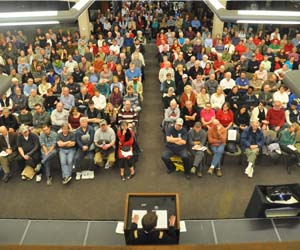 Two other points are worth mentioning. The library had to limit the number of tickets (free) given out for the program because of space concerns. Otherwise, the crowd would have been larger. Also, this is not our chapter’s first program to draw hundreds of people: in 2011 we packed the local planetarium to beyond overflowing with another science-and-history talk.
Two other points are worth mentioning. The library had to limit the number of tickets (free) given out for the program because of space concerns. Otherwise, the crowd would have been larger. Also, this is not our chapter’s first program to draw hundreds of people: in 2011 we packed the local planetarium to beyond overflowing with another science-and-history talk.
Thus the experience of our chapter suggests that one way to find success in science outreach and in expanding the audience of people attentive to science is to form partnerships with local institutions, to feature serious science speakers who also appeal to people with other interests, and to include history!
Christopher M. Graney is president of the Sigma Xi Louisville Chapter, a physics and astronomy professor at Jefferson Community & Technical College in Louisville, and author of the new book Setting Aside All Authority: Giovanni Battista Riccioli and the Science Against Copernicus in the Age of Galileo (University of Notre Dame Press, 2015). Pictures courtesy of Larry Gettleman, the Louisville Chapter's treasurer.
Photo captions
1st photo: The event's two speakers were Tony Dingman of the Frazier History Museum, left, who portrayed a Civil War general who founded the Cincinnati Observatory, and Guy Consolmagno, who Pope Francis recently appointed director of the Vatican Observatory and who has written books on astronomy.
2nd photo: Guy Consolmagno spoke of the Vatican Observatory, the nature of science, and ideas in history that were "almost correct."
3rd photo: Tony Dingman presents to the audience of 600 people that came to the Louisville Free Public Library to hear about science and history.
4th photo: Tony Dingman spoke first as Civil War General Ormsby Mitchel, describing the vast scale of the universe in a speech closely based on one given in 1847 by the real Mitchel.
5th photo: The Louisville Free Public Library, which hosted the event, offered free tickets to make sure they had enough space for the audience.
-
by
Jamie Vernon
| Dec 09, 2015
If my memory of graduate school serves me 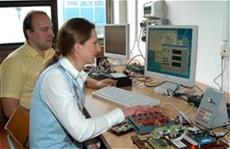 well, first-year graduate students are currently in the process of rotating through research laboratories with hopes of finding the perfect home, a lab where they will spend countless hours conducting experiments and forming professional relationships. The stakes are high. They’ll have to consider what type of research they would like to do and who their advisor will be.
well, first-year graduate students are currently in the process of rotating through research laboratories with hopes of finding the perfect home, a lab where they will spend countless hours conducting experiments and forming professional relationships. The stakes are high. They’ll have to consider what type of research they would like to do and who their advisor will be.
Their advisor will task them with a research project that will greatly influence their career trajectory and shape their personal and professional life for years to come. So, how should these students go about making this critical decision?
Considering that only 57% of individuals entering graduate school will complete their degrees and fewer will secure an academic position, students should be aware of the factors that contribute to their success. You might assume that the graduate advisor plays an important role, and you'd be correct. In a 2013 Cell article about selecting a graduate advisor, Ben Barres states, “Good mentorship is not only pivotal for career success, but it is pivotal for driving innovation and for the health of our universities.” He goes on to provide advice on how to pick a graduate advisor.
"One of the most important tasks of an advisor is to help his or her student to formulate a good and tractable question and then to gently guide a student to formulate good experiments to address this question while encouraging the student to be increasingly independent over time," Barres writes.
There is a general consensus that choosing a good mentor is critical to graduate student performance and that extends to the postdoctoral experience. In a recent American Scientist column, Rachel Levy explains that postdocs seeking academic careers appear to benefit professionally from well-designed professional development and structured oversight. One of the primary factors students should consider in choosing an advisor is the quality of mentorship they will receive. But, is there more to that decision?
In Sigma Xi’s member communities, Ali Baghchehsara, a student member from Iran, asked for advice from his fellow Sigma Xi members on finding an advisor.
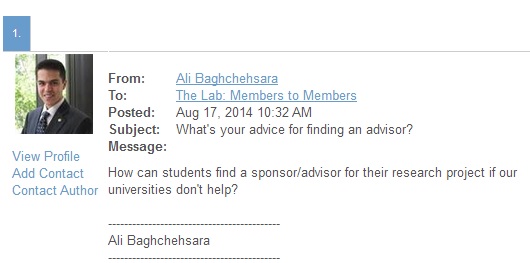
Sigma Xi members recommended these steps:
-
Determine what you would like to research.
Start your search by identifying the field of your discipline that is most interesting to you, then read the scientific literature to learn who is already working in that area.
“Try to narrow your field of interests within the discipline by remembering what papers, what lectures, what projects made you interested enough to apply to grad school in the first place. Find out who in the world is publishing in these areas in the last five to 10 years,” wrote John Smith of East Stroudsburg University of Pennsylvania.
Another way to find potential advisors is to become an active student member in the association for your field, suggested Ronald G. Shapiro, a speaker and consultant who works in career development.
-
Contact potential advisors and get to know them.
Don’t be shy. It’s up to you to get in touch with the person who you may want as an advisor and start building a relationship.
“Get to know professors by talking to them after talks or during department social events or even by taking a class they teach,” said another Sigma Xi member.
David A. Boothman of the University of Texas Southwestern Medical Center at Dallas advises rotating through at least three labs before joining one.
“Science is a people game, like everything else,” wrote Smith. “It requires interaction with a professor.”
-
Talk to people who are already in the lab.
Visit the potential advisor’s lab and pay close attention to how the graduate students who are already there act, even down to their body language, said Rajesh Ramakrishnan of Baylor College of Medicine.
“Most of all, understand [this] group of people will be your surrogate family for the time you are in the lab,” he wrote.
Philip K. Stoddard of Florida International University suggests taking the lab members out for a drink off campus, without the potential advisor, to get a sense of how they truly feel about their choice.
“If they start telling funny stories about their advisor, that’s a good sign; war stories are a bad sign,” Stoddard wrote.
-
Ask to join the lab.
If everything goes well up to this point, ask the advisor if space, and funding, exists for you to join the lab.
“Once you find a professor you’ve hit it off with, let them know you’re potentially interested in joining their lab,” wrote one Sigma Xi member. “Be sure to ask what their funding situation is and to find out what projects they might have in mind for a new lab member.”
What are your thoughts? Is mentorship the most important factor in choosing a graduate advisor?
Active Sigma Xi members, to join the conversation in the Sigma Xi membership communities, go to: http://community.sigmaxi.org/home or add to this particular discussion thread.
Additional reading:
http://www.phdcompletion.org/resources/CGSNSF2008_Sowell.pdf
https://hst.mit.edu/sites/default/files/Barres%20BA.Neuron.80.275.2013.pdf
http://www.americanscientist.org/issues/pub/2014/6/postdoc-mentorship-can-launch-careers/99999
Heather Thorstensen contributed to this post.
Image: VIC CVUT/ Wikimedia Commons / CC-BY-SA-3.0
-
by
User Not Found
| Oct 13, 2015

It's time to announce the inaugural October Madness raffle winner.
Congratulations to Alexis Verger! Alexis won a membership to Sigma Xi's Affiliate Circle, with the annual dues waived for one year (a $70 value). Membership in the Affiliate Circle includes a one-year subscription to Sigma Xi's magazine, American Scientist.
Anyone who nominated a 2015 Nobel Prize laureate to our October Madness prediction brackets could be entered in the raffle. In this first year, we had one successful nominator: Jamie Vernon, Sigma Xi's director of science communications and publications. Jamie nominated Arthur McDonald, who went on to share this year's Nobel Prize in Physics with Takaaki Kajita for the discovery of neutrino oscillations, which shows that neutrinos have mass.
Because Jamie is a member of our staff, he passed on his prize to one of the other nominators, and we picked Alexis randomly.
Congratulations again, Alexis! Look for my email for more details about joining Sigma Xi's Affiliate Circle.
Related Reading
October Madness: Announcement of Champions
October Madness: Final 4
October Madness: Elite 8
October Madness: Sweet 16
Are You Ready for October Madness?
Heather Thorstensen is the manager of communications for Sigma Xi, The Scientific Research Society.
-
by
User Not Found
| Sep 29, 2015

After crowd sourcing nominations and four rounds of voting, we have the inaugural October Madness Champions! Thanks to everyone who participated by voting in Sigma Xi's Nobel Prize prediction brackets for the 2015 prizes in physiology or medicine, chemistry, and physics.
Physiology or Medicine
Your prediction for the Nobel Prize in Physiology or Medicine is Craig Venter, Francis Collins, and Eric Lander for the human genome sequence.

|
 |
 |
| Craig Venter |
Francis Collins |
Eric Lander |
How you voted in the final round:
|
Craig Venter, Francis Collins and Eric Lander for the human genome sequence
|
57.1%
|
|
David J. Julius for investigations on the molecular basis for pain and thermosensation
|
42.9%
|

Chemistry
Your prediction for the Nobel Prize in Chemistry is Harry Gray, Stephen Lippard, and Richard Holm for work in bioinorganic chemistry.

|
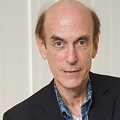 |
 |
| Harry Gray |
Stephen Lippard |
Richard Holm |
How you voted in the final round:
|
Harry Gray, Stephen Lippard, Richard Holm for work in bioinorganic chemistry
|
53.8%
|
|
Michael Grätzel for solar cells
|
46.2%
|
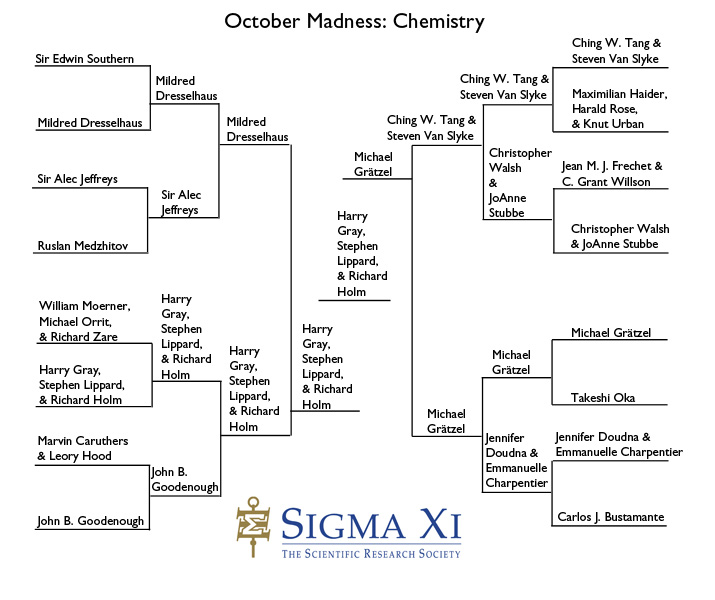
Physics
Your prediction for the Nobel Prize in Physics is Vera Rubin and Kent Ford for dark matter.
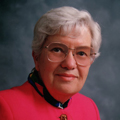
|
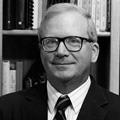 |
| Vera Rubin |
Kent Ford |
How you voted in the final round:
|
Vera Rubin and Kent Ford for dark matter
|
66.7%
|
|
Geoffrey Marcy, Michel Mayor, and Didier Queloz for discovery of extrasolar planets
|
33.3%
|
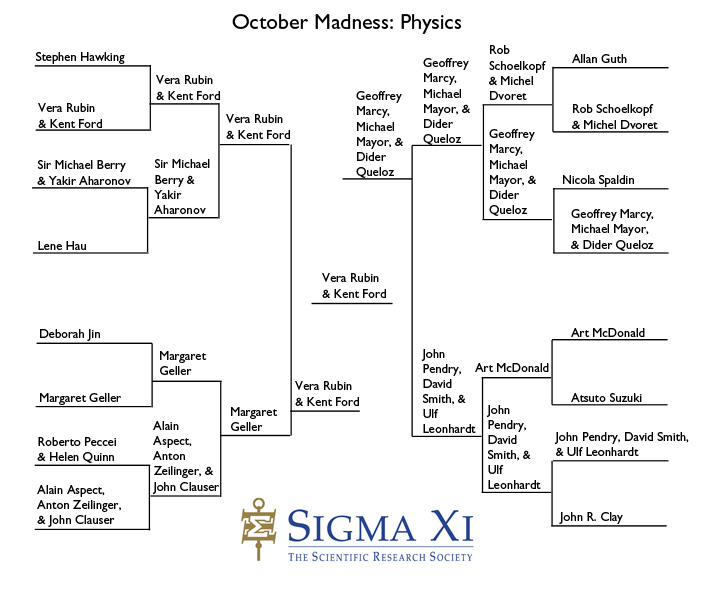
Who Will Officially Win?
Watch for the official Nobel Prize announcements from NobelPrize.org. According to their website, the announcements will be made at these dates and times (times are listed as local time in Sweden):
Physiology or Medicine: Monday, October 5, 11:30 a.m. at the earliest
Physics: Tuesday, October 6, 11:45 a.m. at the earliest
Chemistry: Wednesday, October 7, 11:45 a.m. at the earliest
October Madness Isn't Over
Anyone who nominated a researcher who goes on to win a Nobel Prize this year will be entered into our raffle for prizes. Stay tuned! We plan to announce winners on October 13. Plus, we will be back next year with the 2016 round of October Madness!
Looking Back on Voting
Sweet 16 Voting Results
Elite 8 Voting Results
Final 4 Voting Results
Other Predictions
We aren't the only one making predictions. See other's ideas in this article from Nature.
Heather Thorstensen is the manager of communications for Sigma Xi, The Scientific Research Society.
-
by
User Not Found
| Sep 15, 2015

We're down to the finals in October Madness, Sigma Xi's public Nobel Prize prediction contest! Vote through Sunday, September 27, until 11:59 p.m. EDT, for the researchers you think are worthy of becoming the inaugural October Madness Champions! We're predicting the Nobel Prizes for physiology or medicine, chemistry, and physics.
Final 4 voting results are at the bottom of this page. Please share this contest with anyone who may be interested. Remember to use #OctoberMadness on social media!
Physiology or Medicine
Vote here for your predictions for the Nobel Prize in Physiology or Medicine.
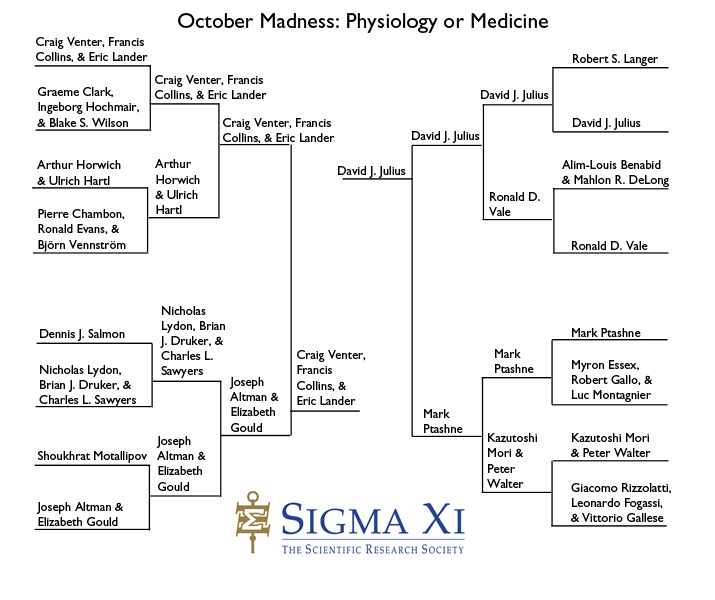
The Finals October Madness Physiology or Medicine match-up is:
J. Craig Venter, Francis Collins, and Eric Lander for the human genome sequence
VS.
David J. Julius for investigations on the molecular basis for pain and thermosensation
Chemistry
Vote here for your predictions for the Nobel Prize in Chemistry.
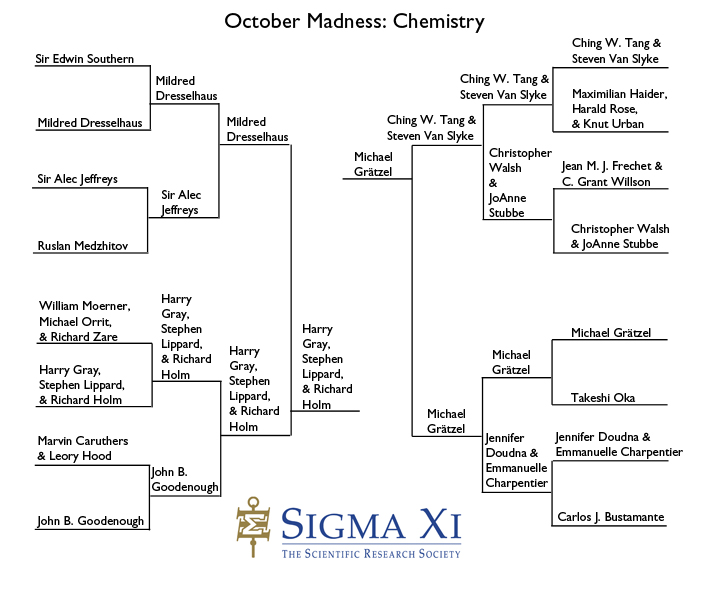
The Finals October Madness Chemistry match-up is:
Harry Gray, Stephen Lippard, Richard Holm for work in bioinorganic chemistry
VS.
Michael Grätzel for solar cells
Physics
Vote here for your predictions for the Nobel Prize in Physics.
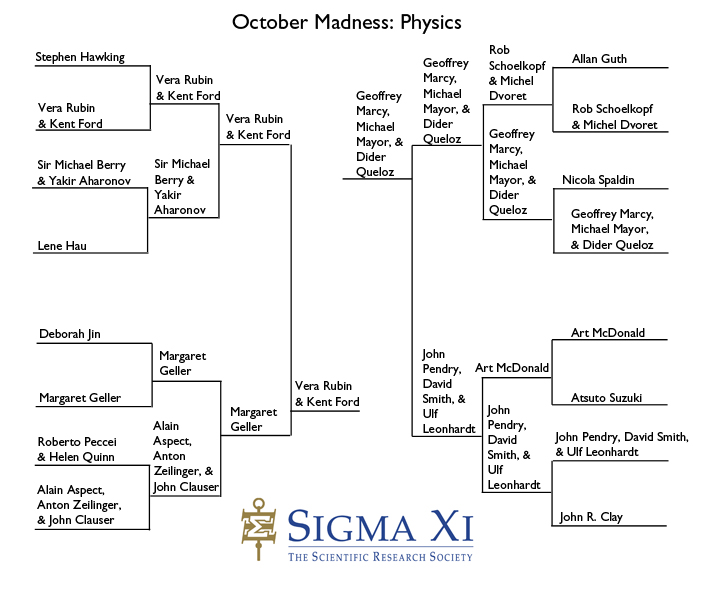 The Finals October Madness Physics match-up is:
The Finals October Madness Physics match-up is:
Vera Rubin and Kent Ford for dark matter
VS.
Geoffrey Marcy, Michel Mayor, and Didier Queloz for discovery of extrasolar planets
Final 4 Round Results
*We had a tie between David J. Julius for investigations on the molecular basis for pain and thermosensation and Kazutoshi Mori and Peter Walter for unfolded protein response pathway. To break it, we looked at how the these researchers would have done if matched in the Elite 8 round. Julius had more votes, so Julius advanced to the finals.
Looking Back
-
by
User Not Found
| Sep 09, 2015

We're down to the Final 4 in Sigma Xi's Nobel Prize prediction contest, October Madness. Check out the Elite 8 results, then vote in the Final 4 round until midnight EDT on September 13, 2015. Your votes will decide who will make it through to the semi-finals!
Please invite your family, friends, and colleagues to vote. If you're using social media, our hashtag is #OctoberMadness. Check back with Keyed In next week for the semi-finals.
Elite 8 Results
*We had our first tie in the Elite 8 round's Physiology or Medicine bracket. Voters were split equally between Nicholas Lydon, Brian J. Druker, and Charles L. Sawyers for development of chronic myelogenous leukemia treatments and Joseph Altman and Elizabeth Gould for adult neurogenesis. For the tie-breaker, we looked at how the two would have done if matched in the Sweet 16 round. Altman and Gould received 28 votes compared to 22 votes given to Lydon, Druker, and Sawyers. Altman and Gould advance.
**We also had our first unanimous winners! Vera Rubin and Kent Ford for dark matter in the Physics bracket advance to the Final 4 with 100% of the votes from the Elite 8 round.
Final 4 Voting
Physiology or Medicine
Vote here for your predictions for the Nobel Prize in Physiology or Medicine.
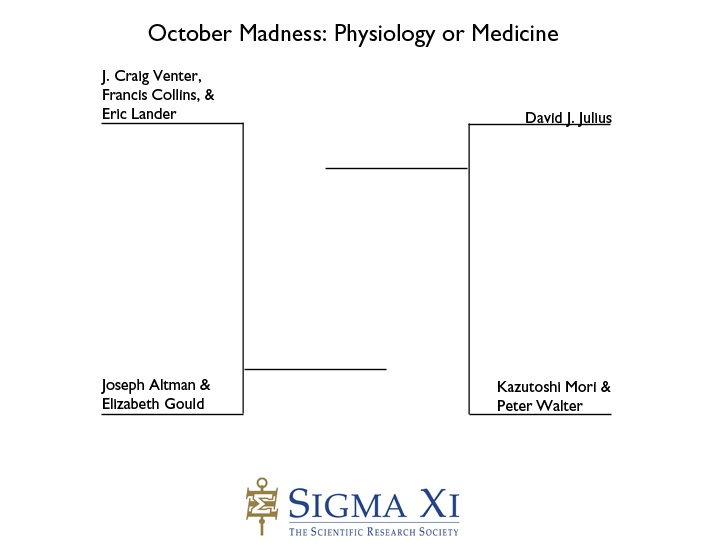
The Final 4 October Madness Physiology or Medicine match-ups are:
1.
J. Craig Venter, Francis Collins, and Eric Lander for the human genome sequence
VS.
Joseph Altman and Elizabeth Gould for adult neurogenesis
2.
David J. Julius for investigations on the molecular basis for pain and thermosensation
VS.
Kazutoshi Mori and Peter Walter for unfolded protein response pathway
Chemistry
Vote here for your predictions for the Nobel Prize in Chemistry.
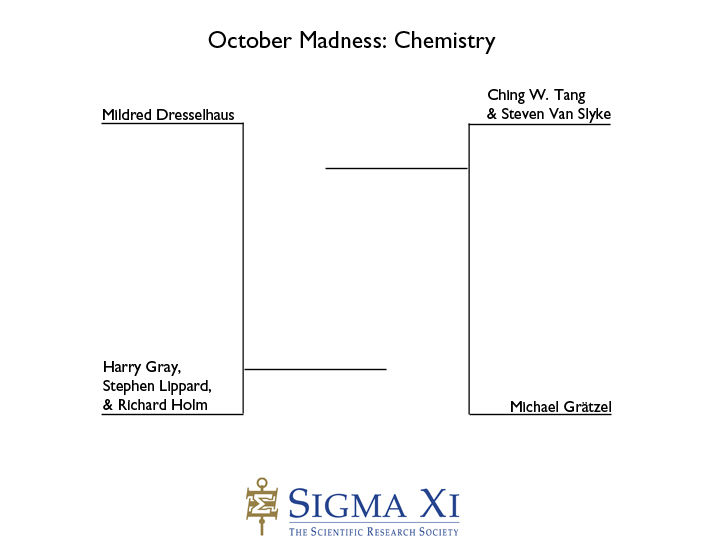
The Final 4 October Madness Chemistry match-ups are:
1.
Mildred Dresselhaus for carbon chemistry
VS.
Harry Gray, Stephen Lippard, Richard Holm for work in bioinorganic chemistry
2.
Ching W. Tang and Steven Van Slyke for organic light emitting diodes
VS.
Michael Grätzel for solar cells
Physics
Vote here for your predictions for the Nobel Prize in Physics.
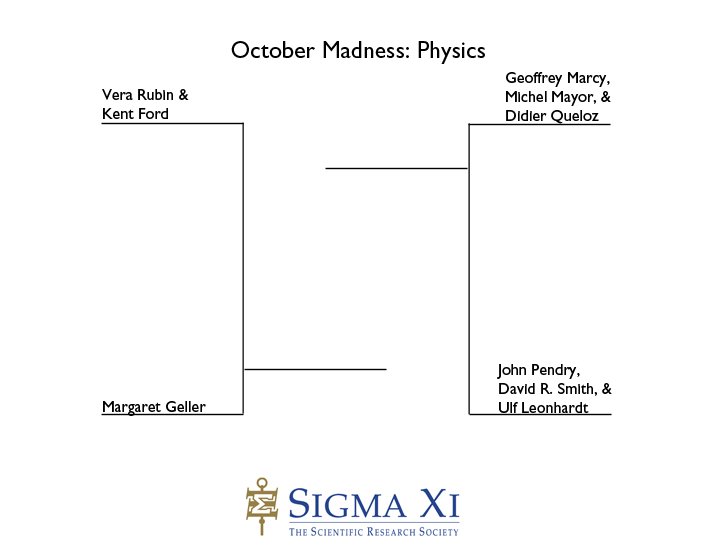
The Final 4 October Madness Final 4 match-ups are:
1.
Vera Rubin and Kent Ford for dark matter
VS.
Margaret Geller for mapping the universe
2.
Geoffrey Marcy, Michel Mayor, and Didier Queloz for discovery of extrasolar planets
VS.
John Pendry, David R. Smith, and Ulf Leonhardt for discovery of negative refraction
-
by
User Not Found
| Sep 03, 2015
 This guest post was written by Rick Borchelt, who participated in the Communicating Science for Policy Workshop held August 10–11, 2015, in Durham, North Carolina. The workshop was hosted by the Institute on Science for Global Policy and organized in cooperation with Sigma Xi, The Scientific Research Society.
This guest post was written by Rick Borchelt, who participated in the Communicating Science for Policy Workshop held August 10–11, 2015, in Durham, North Carolina. The workshop was hosted by the Institute on Science for Global Policy and organized in cooperation with Sigma Xi, The Scientific Research Society.
Veteran science blogger Ed Yong recently commented on live Twitter feeds originating from (yet another) conference on how to improve science communication:
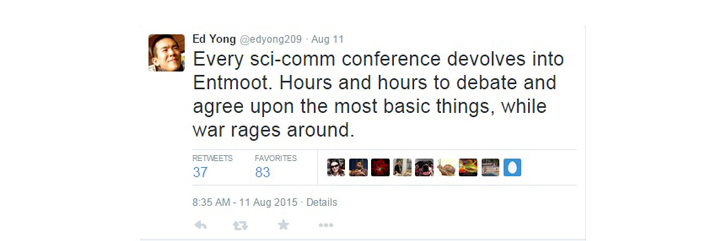
Remarkably discerning for someone who wasn’t even in the room! I was in the room, as I often am for these kinds of conversations, and while the discussion is always passionate, and intense, and vibrant, it’s often (almost always) … um, kind of pointless. Here’s why.
The conversations among the scientists and a surprisingly large number of science communicators almost always start with a reinvention of the wheel — the premise that more science communication is good. Can’t argue with that generally, assuming the quality is up to par and care is taken to make sure it’s an accurate reflection of the science involved. But then the discussants almost always go a step beyond to assert that better science communication will lead to increased science literacy. And other magnificent good things.
Here’s where the conversation starts going off the tracks. Because there is not a shred of good data to support this assertion.
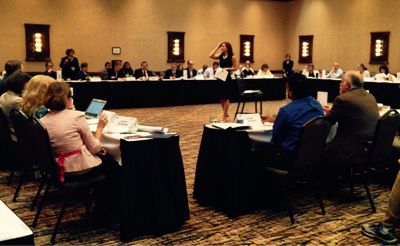 In fact, there is little evidence that anything we have done as science communicators since the end of World War II has moved the needle one mark on the science literacy scale — we’ve poured lots of money in it and literacy hasn’t changed, we’ve gone through lean times with almost no funding and literacy hasn’t changed, science journalism has been in the catbird seat for a while and then in a tailspin for a decade and science literacy hasn’t changed, Bill Nye the Science Guy came and went on television and science literacy didn’t change, we’ve launched initiative after adult, informal science education initiative after initiative from NSF, NASA, NOAA and the rest of the known science funding universe and science literacy remains stubbornly low. And we continue to agonize over this.
In fact, there is little evidence that anything we have done as science communicators since the end of World War II has moved the needle one mark on the science literacy scale — we’ve poured lots of money in it and literacy hasn’t changed, we’ve gone through lean times with almost no funding and literacy hasn’t changed, science journalism has been in the catbird seat for a while and then in a tailspin for a decade and science literacy hasn’t changed, Bill Nye the Science Guy came and went on television and science literacy didn’t change, we’ve launched initiative after adult, informal science education initiative after initiative from NSF, NASA, NOAA and the rest of the known science funding universe and science literacy remains stubbornly low. And we continue to agonize over this.
What the data do support is that there is a minority — a large minority, granted, somewhere around 20 percent of the American public — that could be classified as “science attentive.” They seek out some kinds of science information proactively, most often on health-related matters. But the audience that we assume is there to read with joy and awe and optimism about the wonders of science writ large is, well … there isn’t one. Or at least there isn’t one large enough to write a check to do science writing or science communication on any kind of large scale. If willingness to pay for science content is any kind of indication, then adult Americans by and large would much rather watch Game of Thrones. Or Cait Jenner. Or soccer.
We can write great stories, film PSAs, upload YouTube videos, host Google hangouts and Reddit AMAs, and send legions of scientists out into museums and science cafes until the cows come home and they’ll still only be talking to a very small number of adults. And usually the same people, over and over and over again. Nothing we are doing as science communicators is recruiting new people into the ranks of the science attentive. Or improving science literacy.
For this, in our meetings and conferences we typically blame the audience. If only they were smarter or better educated to begin with, they would obviously want to pay more attention to science. If only they understood how critical a role scientists play in our everyday lives, they would pay more attention to what we do. If only they would stop paying attention to Kim Kardashian and watch more PBS, they would obviously want to pay more attention to science. And science literacy would skyrocket.
And once we’re done blaming the audience, we blame the media, albeit there aren’t really enough traditional science media around to blame anymore. Media hype science stories, especially medical ones, until people don’t know what to believe anymore. PR people at federal agencies and corporations spin stories to make their missions and their products more important or more credible than they are, and the media eat this pabulum up like marmalade on toast. Even though we are sure people actually want to see hard-hitting, scientifically based nature footage of calm sharks going about their business in murky surf, the media persist in showing us Shark Week and Sharknado. If they didn’t, people would be more scientifically literate.
And for good measure, we whip the scientists a little too, lest we be accused of favoritism. Scientists don’t understand how to talk to normal people. Scientists put the stink eye on any of their fraternity who deign to popularize science. Scientists have to be dragged kicking and screaming away from the bench to talk to the unwashed masses. Scientists need to be taught how to tell a story rather than recite a thesis.
These conversations are about 90 percent of the discussion at conferences on science communication — usually all but the last 15 minutes of a two-day talk-fest. Granted, there’s usually one evidence-based outlier invited in to talk social science findings, but that’s usually sandwiched somewhere between lunch and the time the first folks start heading for the door for an early airplane flight. Hence Ed’s Entmoot.
No productive recommendations can come from these discussions, because they are flawed from the get-go. We need to face the facts that science is a low-salience issue for most Americans, Kim Kardashian is more salient, and very little we can ever do is going to change that. Wishing will not make it so. A legion of Carl Sagans will not make it so. A 40-page Tuesday Science Times delivered to your doorstep or to your iPad every week will not make it so. A mandatory two-hour block of science programming every night on the CW channel will not make it so. Adult Americans pay attention to science only when they think it directly affects them, not when we think they should pay attention. And their minds, lives, and careers are generally packed with plenty of other stuff that they think is more important. In no universe I know of will science out-compete this other stuff.
The good news is, it’s been this way for three generations and the world has not come to an end. Federal science budgets, although every scientist will tell you we don’t have enough money ever to do enough science, are pretty robust. New technologies and innovations are rolling out of American universities and corporations every minute. The goose that lays the golden eggs of basic research that hatch into medical cures and energy supplies and the Higgs boson hasn’t run out of yolk yet.
The truth is, public science literacy is not now, nor has it ever been, the driving factor behind science budgets or national science policy. No national level election has ever turned on an issue of science. Grassroots action seldom translates into national science policy; policy is formulated as a compromise between different perspectives by different stakeholders at the policy table, and science is seldom dealt the cards that trump all other societal concerns.
So: We don’t know what kinds or quantities of science communication actually affect general scientific literacy. What little evidence we do have is that science communication and other informal science learning are at best of marginal value to boosting adult scientific literacy—way, way, way behind such factors as years of total educational attainment and number of college science classes taken. And even if there were better correlations between science communication and scientific literacy, we have no evidence at all that scientific literacy is connected even loosely with the quality of scientific decision making, science budgets, or science policy. And of course we lack any evidence that civilization as we know it will crumble the next time Dr. Oz hawks a vitamin supplement.
If I take issue with Ed Yong’s tweet — which provided a moment of levity and welcome self-reflection after two days of debate — it’s that there is no war raging except among our own ranks. There is no anti-science conspiracy, we haven’t become a nation of Luddites tossing our iPhones into the nearest dumpster, and we are in no danger of running out of adolescent geeks — male and female — ready to lead the next generation of scientists.
So why do I continue to engage in this discussion about how to do better science communication, raise scientific literacy, and improve science policy? It’s because they are all worthy goals in a democratic society in their own right, not as flagstones along a straight path toward the day that “scientific truth” is the arbiter of every policy outcome. Science will always need to jostle and spar with other parts of society to be heard, understood, and listened to — and even then won’t always prevail. But we owe it to ourselves to make sure that when we want to understand science, there is compelling and engaging science communication to inform us. When we want to engage in a policy or funding debate, we owe it to ourselves to have at our fingertips — if not already in our brain cells — the data and the perspectives to bring the issues into focus.
And when we want to watch Kim Kardashian instead of Neil deGrasse Tyson, well… that’s a choice a democratic society respects.
Rick Borchelt is communications director for science at the U.S. Department of Energy. He has enjoyed a 30-year career in federal — including Congressional, White House, and agency service — and university science writing, science communications, and science policy. He is a past president of the DC Science Writers Association and serves on the editorial board of the journal Science Communication.
Photo captions:
Top: A screen shot of Ed Yong's tweet.
Bottom: The Communicating Science for Policy Workshop included three speakers who debated their ideas with participants. Here, Liz Neeley, executive director of The Story Collider, shares her ideas about using narrative persuasion for ethical science communication.
-
by
User Not Found
| Sep 02, 2015

Results are in for the Sweet 16 round of October Madness, Sigma Xi's 2015 public Nobel Prize prediction contest! Thanks to everyone who voted for your top picks for the Nobel Prize in physiology or medicine, chemistry, and physics.
See who made it through to the Elite 8 round, then vote to secure your favorites in the Final 4. Voting for the Elite 8 ends on midnight EDT on Monday, September 7. Due to the Labor Day holiday, we plan to post results and kick off Final 4 voting on September 9.
Sweet 16 Voting Results
* William Moerner, Michael Orrit, and Richard Zare won the popular vote for the chemistry prize for single-molecule spectroscopy and application of lasers. However, because we realized Moerner already won a Nobel Prize in 2014 for his work on super-resolved fluorescence microscopy, which relates to his work in single-molecule spectroscopy, his group does not advance to the Elite 8 round.
Elite 8 Voting
Physiology or Medicine
Vote here for your predictions for the Nobel Prize in Physiology or Medicine
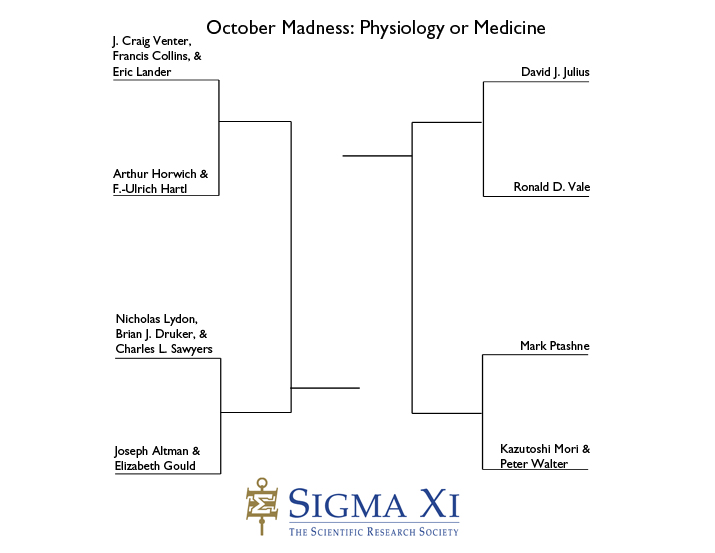
The October Madness physiology or medicine Elite 8 match-ups are:
1.
J. Craig Venter, Francis Collins, and Eric Lander for the human genome sequence
VS.
Arthur Horwich and F.-Ulrich Hartl for protein folding
2.
Nicholas Lydon, Brian J. Druker, and Charles L. Sawyers for development of chronic myelogenous leukemia treatments
VS.
Joseph Altman and Elizabeth Gould for adult neurogenesis
3.
David J. Julius for investigations on the molecular basis for pain and thermosensation
VS.
Ronald D. Vale for work on molecular motor proteins kinesin and dynein
4.
Mark Ptashne for molecular studies of gene recognition
VS.
Kazutoshi Mori and Peter Walter for unfolded protein response pathway
Chemistry
Vote here for your predictions for the Nobel Prize in Chemistry
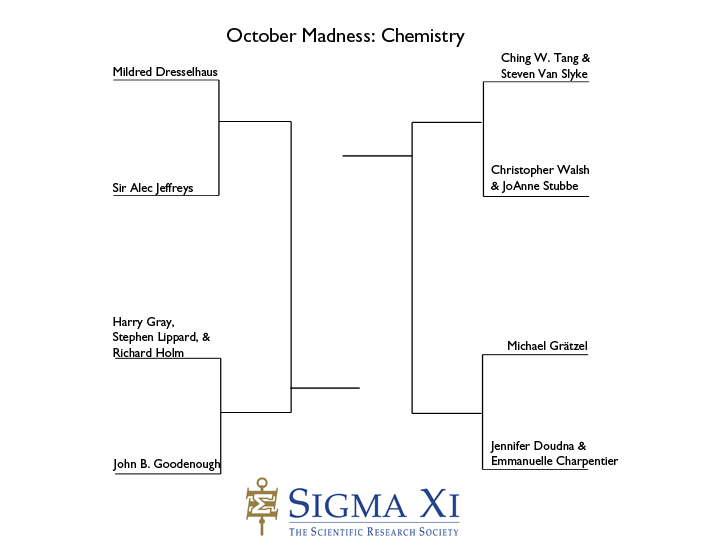
The Elite 8 October Madness chemistry match-ups are:
1.
Mildred Dresselhaus for carbon chemistry
VS.
Sir Alec Jeffreys for DNA profiling
2.
Harry Gray, Stephen Lippard, Richard Holm for work in bioinorganic chemistry
VS.
John B. Goodenough for lithium-ion batteries
3.
Ching W. Tang and Steven Van Slyke for organic light emitting diodes
VS.
Christopher Walsh and JoAnne Stubbe for mechanistic enzymology
4.
Michael Grätzel for solar cells
VS.
Jennifer Doudna and Emmanuelle Charpentier for the CRISPR gene editing tool
Physics
Vote here for your predictions for the Nobel Prize in Physics
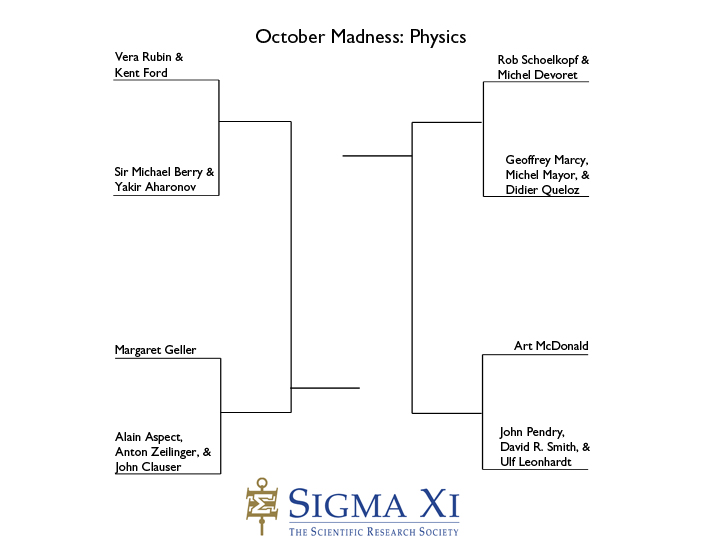
The Elite 8 October Madness physics match-ups are:
1.
Vera Rubin and Kent Ford for dark matter
VS.
Sir Michael Berry and Yakir Aharonov for quantum mechanics
2.
Margaret Geller for mapping the universe
VS.
Alain Aspect, Anton Zeilinger and John Clauser for quantum entanglement
3.
Rob Schoelkopf and Michel Devoret for superconducting qubits and microwave photons
VS.
Geoffrey Marcy, Michel Mayor, and Didier Queloz for discovery of extrasolar planets
4.
Art McDonald for neutrino oscillations
VS.
Sir John Pendry, David R. Smith, and Ulf Leonhardt for discovery of negative refraction
Heather Thorstensen is the manager of communications for Sigma Xi, The Scientific Research Society.
-
by
User Not Found
| Aug 25, 2015
 Voting begins today for October Madness, Sigma Xi's just-for-fun, public Nobel Prize prediction contest! We're kicking things off with the Sweet 16 round. Please click the links below to vote for who you think will win this year's Nobel Prizes in Physiology or Medicine, Chemistry, and Physics.
Voting begins today for October Madness, Sigma Xi's just-for-fun, public Nobel Prize prediction contest! We're kicking things off with the Sweet 16 round. Please click the links below to vote for who you think will win this year's Nobel Prizes in Physiology or Medicine, Chemistry, and Physics.
Voting ends for this round at midnight EDT on Monday, August 31. We will announce our top picks from each round and kick off the following round of voting every Tuesday until September 29. On that day, we will announce our most popular choices for this year's Nobel Prizes.
Thank you to everyone who submitted nominations. Let the voting begin!
Physiology or Medicine
Vote here for your predictions for the Nobel Prize in Physiology or Medicine
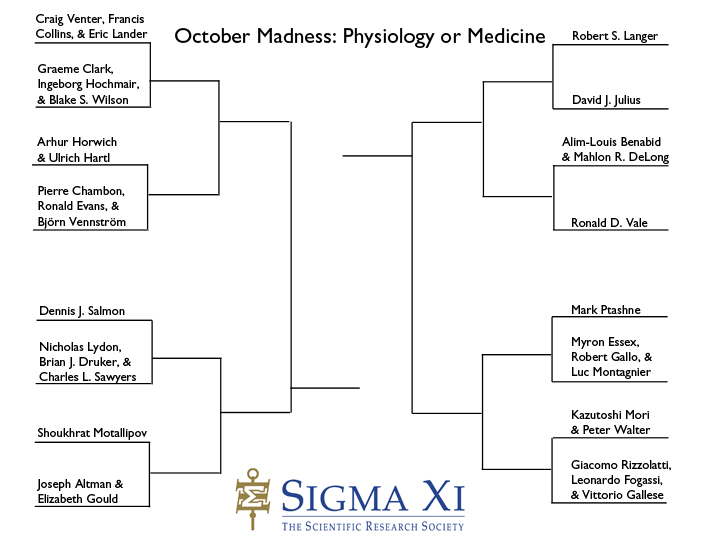
The October Madness physiology or medicine Sweet 16 match-ups are:
1.
Craig Venter, Francis Collins, and Eric Lander for the human genome sequence
VS.
Graeme Clark, Ingeborg Hochmair, and Blake S, Wilson for the cochlear implant
2.
Arthur Horwich and Ulrich Hartl for protein folding
VS.
Pierre Chambon, Ronald Evans, Björn Vennström for nuclear hormone receptors
3.
Dennis J. Salmon for discovery of HER2Neu gene
VS.
Nicholas Lydon, Brian J. Druker, and Charles L. Sawyers for development of chronic myelogenous leukemia treatments
4.
Shoukhrat Motallipov for spindle-chromosomal complex transfer
VS.
Joseph Altman and Elizabeth Gould for adult neurogenesis
5.
Giacomo Rizzolatti, Leonardo Fogassi, and Vittorio Gallese for the discovery of mirror neurons
VS.
Kazutoshi Mori and Peter Walter for unfolded protein response pathway
6.
Myron Essex, Robert Gallo, and Luc Montagnier for the discovery of HIV
VS.
Mark Ptashne for molecular studies of gene recognition
7.
Robert S. Langer for drug delivery/tissue engineering
VS.
David J. Julius for investigations on the molecular basis for pain and thermosensation
8.
Alim-Louis Benabid and Mahlon R. DeLong for Parkinson's disease research
VS.
Ronald D. Vale for work on molecular motor proteins kinesin and dynein
Chemistry
Vote here for your predictions for the Nobel Prize in Chemistry
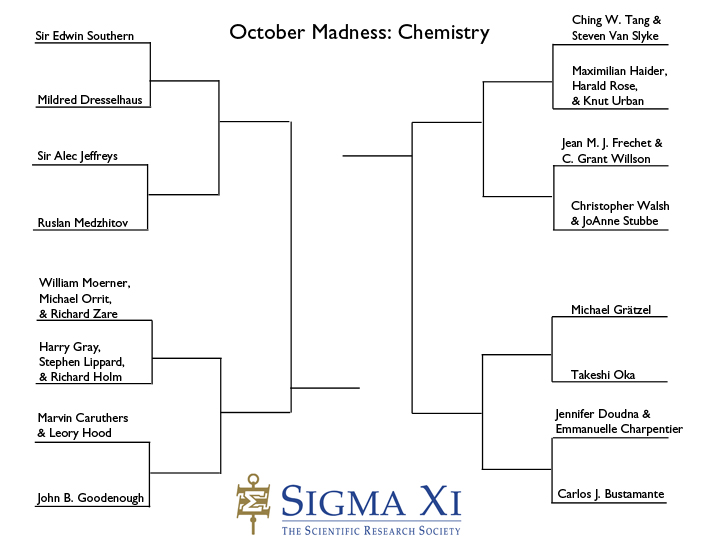
The Otober Madness chemistry match-ups are:
1.
Sir Edwin Southern for the Southern blot
VS.
Mildred Dresselhaus for carbon chemistry
2.
Sir Alec Jeffreys for DNA profiling
VS.
Ruslan Medzhitov for discovery of mammalian Toll-like receptors
3.
William Moerner, Michael Orrit, Richard Zare for single-molecule spectroscopy & application of lasers
VS.
Harry Gray, Stephen Lippard, Richard Holm for work in bioinorganic chemistry
4.
Marvin Caruthers and Leroy Hood for techniques in DNA synthesis
VS.
John B. Goodenough for lithium-ion batteries
5.
Ching W. Tang and Steven Van Slyke for organic light emitting diodes
VS.
Maximilian Haider, Harald Rose, and Knut Urban for transmission electron aberration-corrected microscopy
6.
Jean M. J. Frechet and C. Grant Willson for chemically-amplified photoresists
VS.
Christopher Walsh and JoAnne Stubbe for mechanistic enzymology
7.
Michael Grätzel for solar cells
VS.
Takeshi Oka for work in astrochemistry
8.
Jennifer Doudna and Emmanuelle Charpentier for the CRISPR gene editing tool
VS.
Carlos Bustamante for Single Molecule Kinetics
Physics
Vote here for your predictions for the Nobel Prize in Physics
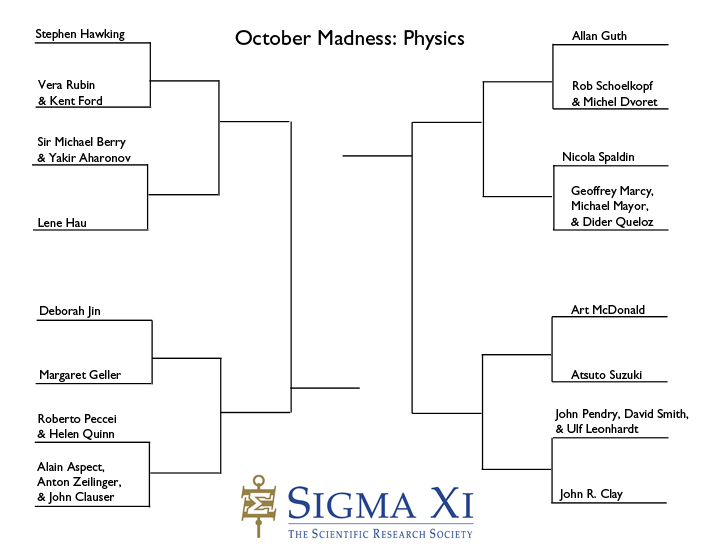
The October Madness physics match-ups are:
1. Stephen Hawking for black hole death
VS.
Vera Rubin and Kent Ford for dark matter
2.
Sir Michael Berry and Yakir Aharonov for quantum mechanics
VS.
Lene Hau for electromagnetically induced transparency
3.
Deborah Jin for fermion condensates
VS.
Margaret Geller for mapping the universe
4.
Roberto Peccei and Helen Quinn for the Peccei-Quinn Theory
VS.
Alain Aspect, Anton Zeilinger and John Clauser for quantum entanglement
5.
Allan Guth for the Inflation Theory
VS.
Rob Schoelkopf and Michel Dvoret for superconducting qubits and microwave photons
6.
Nicola Spaldin for multiferroics
VS.
Geoffrey Marcy, Michael Mayor and Dider Queloz for discovery of extrasolar planets
7.
Art McDonald for neutrino oscillations
VS.
Atsuto Suzuki for the Super-Kamiokande experiment
8.
John Pendry, David Smith and Ulf Leonhardt for discovery of negative refraction
VS.
John R. Clay for ionic current mechanisms underlying neuronal bistability
Heather Thorstensen is the manager of communications for Sigma Xi, The Scientific Research Society.
-
by
User Not Found
| Jul 24, 2015
 Join us on the road to Stockholm! Here at Sigma Xi, we want to keep doing what we do best—recognizing incredible research—while having some fun as we wait for the announcement of this year’s Nobel Prize winners in October. The Nobel Prize has a deep connection with Sigma Xi: More than 200 members are, or have been, Nobel laureates since the Society formed in 1886.
Join us on the road to Stockholm! Here at Sigma Xi, we want to keep doing what we do best—recognizing incredible research—while having some fun as we wait for the announcement of this year’s Nobel Prize winners in October. The Nobel Prize has a deep connection with Sigma Xi: More than 200 members are, or have been, Nobel laureates since the Society formed in 1886.
Let’s see who we think has made the greatest benefits to mankind! We’re going to run October Madness, a contest in which we, the people, get to vote for our picks for this year’s science-related Nobel Prize winners. You do not need to be a member of Sigma Xi to participate.
We’re looking for 16 nominations each for the:
- Nobel Prize in Physics
- Nobel Prize in Chemistry
- Nobel Prize in Physiology or Medicine
Our Prizes (pun intended)
If you nominate someone who goes on to win a Nobel Prize, you will be entered into a raffle. If you win the raffle, and you're not a Sigma Xi member, you will receive all the benefits of the Sigma Xi Affiliate Circle* for one year (a $70 value), which includes a one-year subscription to American Scientist magazine. Members who win the raffle will have their dues paid by Sigma Xi for 2015–16. Those who already renewed their membership will have their dues paid for 2016–17. We will select one winner per Nobel Prize category for a total of three winners.
Submit Your Nominations
Send in your picks by August 11 online or directly to me: hthorstensen@sigmaxi.org.
Remember to include:
- Your nominee’s name (send in as many as you want)
- Which Nobel Prize you think this person should win
- His or her area of research
- His or her institution or affiliation
- Your name and email address
On August 25, we will announce October Madness nominees** and open the three brackets for public voting on Sigma Xi’s social media. You can find us on Facebook, Twitter, and Google+. Keep your favorites in the running with weekly voting on Tuesdays until our top picks for each prize are announced on September 29!
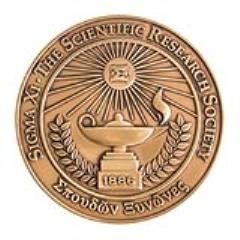
|
| Yeah, I know. This picture doesn't show the Nobel Prize. It's the medal that top presenters will earn this October in Sigma Xi's Student Research Conference. Close enough, right? |
Contest Schedule
July 24–August 11: Send in your nominations
August 25: Nominees announced; Sweet 16 voting begins.
September 1: Sweet 16 voting ends, winners announced. Elite 8 voting begins.
September 8: Elite 8 voting ends, winners announced. Final 4 voting begins.
September 15: Final 4 voting ends, winners announced. Semi Finals voting begins.
September 22: Semi Finals voting ends, winners announced. Finals voting begins.
September 29: Sigma Xi’s October Madness Picks announced.
October 5–12: Official Nobel Prize Winners named.
October 13: Winners announced from the raffle for membership in the Sigma Xi Affiliate Circle or a free year of membership dues.
* Affiliate Circle status does not qualify one for full membership in Sigma Xi's nomination-based honor society.
** If Sigma Xi receives less (or more) than 16 nominations for any of the prizes, then its staff will select the nominees who are put on the bracket. That’s not as fun. Please nominate anyone you feel is worthy of the prize. If you need some inspiration, potential candidates might be found here, here, here, or here. October Madness is not affiliated with the Nobel Prize.
Heather Thorstensen is the manager of communications for Sigma Xi, The Scientific Research Society.
-
by
User Not Found
| Jul 08, 2015
This is a guest post written by Sigma Xi Past President Kelly O. Sullivan. Keyed In invited her to write the post based on a Twitter conversation.
When I was in high school a friend’s father came and talked to our chemistry class about his career as a chemical engineer. It sounded interesting and thus I decided I’d major in chemical engineering in college and go work for a large company. That would be my career.
Then in college I found out what I liked about what he did was the chemistry and not the engineering part—I liked thinking about the fundamental question “why?” and so I decided I would major in chemistry and I would be a high school teacher. That would be my career.
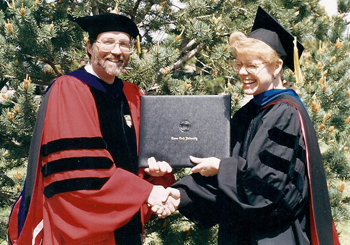 Then I found out that I’d have to add a bunch of courses to my chemistry paradigm to get teaching certification and that I’d only be certified in one state. I didn’t want to live in one state forever and by this time I found out I was really fascinated by quantum mechanics. So I decided to get a PhD and become a college chemistry professor at a primarily undergraduate university. That would be my career.
Then I found out that I’d have to add a bunch of courses to my chemistry paradigm to get teaching certification and that I’d only be certified in one state. I didn’t want to live in one state forever and by this time I found out I was really fascinated by quantum mechanics. So I decided to get a PhD and become a college chemistry professor at a primarily undergraduate university. That would be my career.
I did go do that. For a while, that was my career.
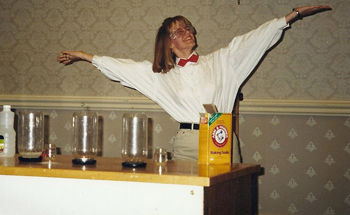 Then I got an offer to join a national laboratory and handle the administrative arm of their internship programs. It was a new and interesting challenge and I accepted. Suddenly, I had an “alternative career.”
Then I got an offer to join a national laboratory and handle the administrative arm of their internship programs. It was a new and interesting challenge and I accepted. Suddenly, I had an “alternative career.”
Over the years since I joined the national lab, I have changed positions and roles multiple times—building partnerships, managing our postdoc program, and now working on managing our internal discretionary investments and developing institutional strategy. All of these things build on the same strengths I had as a scientist. I can see the big picture and I can look at data and tell a story about what it means.
And over the years I’ve been invited multiple times to speak at conferences about my “alternative career” in chemistry. At first I agreed with the implied fact—my career was “alternative.” After all, I wasn’t a professor any more. Clearly I had moved out of bounds.
But then I really thought about it. If there are on the order of 25,000–30,000 new PhDs in science and engineering each year (true according to National Science Foundation data), where are they all going?
There are certainly not that many academic positions each year. The majority of PhDs are working in industry. So why is that an “alternative career?” No doubt this perception is in part (possibly in large part) because we are trained by people who are in academia. Many (most, probably) of those people have been in academia their whole career; it’s what they know and consider to be “normal.” It’s what they model as the ideal career path. In fact, my advisor considered my move to a primarily undergraduate institution an “alternative” path because it wasn’t a major research institution.
New Faculty Positions versus New PhDs
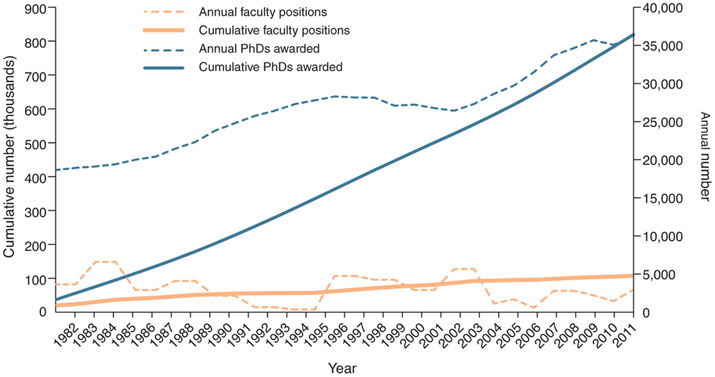
Graph reprinted by permission from Macmillan Publishers Ltd: [Nature Biotechnology] (Maximiliaan Schillebeeckx, Brett Maricque, Cory Lewis. "The Missing Piece to Changing the University Culture." 31 (10): 938—941. doi:10.1038/nbt.2706) Copyright 2013.
After realizing all of this, I’ve stopped asking “where do you see yourself” kinds of questions when interviewing job candidates. Why? Because quite honestly ten years ago (or even five) I could not have answered accurately because I didn’t even know this career existed. Instead I try to learn people’s passions, and I think about how those might match up with the position we’re looking to fill.
I had a young postdoc talk to me once about the various options she had in front of her. She was concerned people would think less of her for the choices she made. I gave her the best advice I have probably ever given anyone and I continue to work towards this myself:
No matter what you do, someone somewhere will be disappointed. Make sure it isn’t you.
There are no “alternative” careers. There are careers. Make your own path and don’t let anyone tell you otherwise.
Photos: Top, Kelly O. Sullivan, with her advisor Greg Gellene, on the day she earned her PhD. Bottom, the author when she was a professor and director of a chemistry demonstration show. “It was choreographed and set to music; we didn’t actually talk at all,” she said.
Kelly O. Sullivan is the interim director of institutional strategy at the Pacific Northwest National Laboratory in Richland, Washington. She was president of Sigma Xi, The Scientific Research Society from July 1, 2012–June 30, 2013.
-
by
User Not Found
| Jun 11, 2015
This is a guest post written by Sheril Kirshenbaum. Keyed In invited her to submit this post as part of a series of guest posts focused on solutions to the “war on science.”
“Whenever the people are well-informed, they can be trusted with their own government." ~ Thomas Jefferson, Scientist-statesman
The recent discussion among Sigma Xi members about the so-called “war on science” underscored the importance of science to the policymaking process. In the Fall of 2016, Americans will vote for the next president of the United States. He or she will be responsible for making critical decisions related to science policies that will influence the way we—and our children—live in the coming decades.
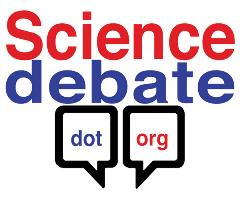 But will we have a chance to hear the candidates’ science-related priorities before going to the polls? That’s the primary mission of ScienceDebate. Launched in 2008, this 501c3 nonpartisan, nonprofit initiative works to encourage presidential candidates to attend live science debates. We are not interested in quizzing those seeking office about specific scientific facts, but we do expect to hear what their science policy priorities would be if elected.
But will we have a chance to hear the candidates’ science-related priorities before going to the polls? That’s the primary mission of ScienceDebate. Launched in 2008, this 501c3 nonpartisan, nonprofit initiative works to encourage presidential candidates to attend live science debates. We are not interested in quizzing those seeking office about specific scientific facts, but we do expect to hear what their science policy priorities would be if elected.
The issues that ScienceDebate focuses on, from energy and climate change to health and drought, are not only “science” challenges, they are humanity’s challenges, inherently connected to how we live and who we are. Regardless of party affiliation, the future of food, water, human health, and safety will affect every one of us.
Today over 44,000 supporters including Congresspeople, Nobel laureates, over 100 university presidents, actors, writers, and many organizations—including the American Association for the Advancement of Science and the National Academies—have added their names to this nonpartisan statement:
“Given the many urgent scientific and technological challenges facing America and the rest of the world, the increasing need for accurate scientific information in political decision making, and the vital role scientific innovation plays in spurring economic growth and competitiveness, we call for public debates in which the U.S. presidential and congressional candidates share their views on the issues of science and technology policy, health and medicine, and the environment.”
ScienceDebate has had some success already. During the past two presidential elections, President Obama, Senator McCain, and former Governor Romney responded in writing to 14 questions cultivated and reviewed by our team on science and technology policy. The candidates’ answers were widely distributed in print and online prior to the elections through partnerships with popular magazines and journals. President Obama formed his science policy team to help him respond. Voters made decisions with knowledge they would not otherwise have had, and the president arrived in office with a clear idea of how science fit into his overall strategic objectives.
What’s different about 2016?
Consider: When we launched in 2008, just six of 2,975 interview questions to presidential candidates mentioned "climate change" or "global warming." (For comparison, three mentioned UFOs).
Now as the next election approaches, candidates from both major parties are already talking about climate change. In fact, Hillary Clinton’s is the first major presidential campaign to make it a central campaign topic on day one.
In other words, times are changing, culture is changing, and we are changing…ScienceDebate is currently scaling up our efforts and we want your support. By signing on at www.sciencedebate.org, you can help leverage the national conversation toward real solutions to our most pressing national and global challenges. By adding your name to the growing list of supporters on our website, you can help us make the case that science isn’t just a special interest group, but important to a significant portion of the American public and should be part of the campaign trail conversation. You can find more at our Facebook page as well, which features regular updates. We also encourage you to submit questions you would like to hear presidential candidates address on such topics as science education, climate change, food security, mental health research, drought, oceans, and human health in general.
Science isn’t a special interest, but central to how we live and the kind of world we’ll leave for children over the coming decades. So let’s work together to make sure that we know where candidates stand on significant science policies before Election Day.
Update:
Sheril recently spoke to Huffington Post Live about ScienceDebate.org:
To watch the video, click here.
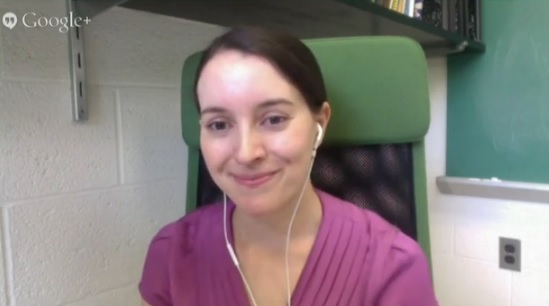
-
by
User Not Found
| May 31, 2015
Sigma Xi, The Scientific Research Society gave a boost of support on May 14 to four teams of high school students at the Intel International Science and Engineering Fair. Collectively, the teams received $6,000 from Sigma Xi for their outstanding demonstrations of interdisciplinary research.
Twenty-five Sigma Xi members volunteered to select which teams would get the Society’s Team Science Awards. They served as judges for two days in Pittsburgh, Pennsylvania, evaluating team projects to narrow 286 hopefuls down to four winners.
What was it like to judge at the largest pre-college science competition in the world? Ask the Sigma Xi members who were there and they will tell you it was inspiring, a glimpse into the future of science, and a privilege. Here is more of what some of them had to say about their experience.
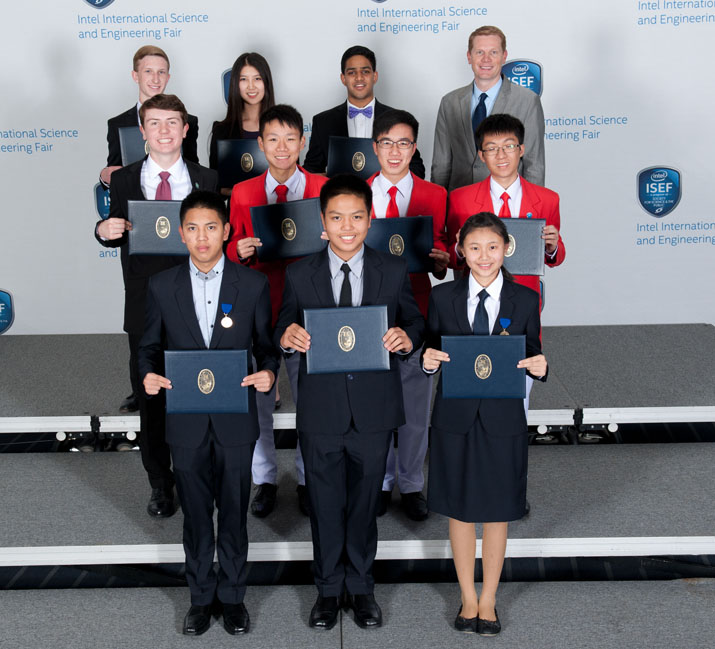
Photo: Sigma Xi sponsored the Special Award for Team Science at the 2015 Intel International Science and Engineering Fair in Pittsburgh, Pennsylvania. The winners, pictured above with Jamie Vernon, Sigma Xi director of science communications and publications, received a total of $6,000. They ranged in age from 15 to 17 and traveled from Thailand, Virginia, Texas, and Singapore to participate.
Dr. Stephanie Tristam-Nagle: I have been a member of Sigma Xi, Carnegie Mellon Chapter, since 1983, when I joined as a postdoc at CMU. My father, a Ph.D. organic chemist at Merck for most of his career, was also a member of Sigma Xi. As I rose up through the ranks to my current position of research professor, I began to participate in local science fairs. One was the Pittsburgh Regional Science and Engineering Fair (PRSEF, now SciTech) and then I founded a Sigma Xi award at the Pennsylvania Junior Academy of Sciences (PJAS) science fair in 2002.
In 2012, I volunteered to judge at the Intel ISEF (Intel International Science and Engineering Fair), where I was overwhelmed with the quality of the projects. Both of my daughters had participated in the local science fairs, and one of them was selected for the Intel ISEF as a 10th grader, held that year in Detroit.
This year, the quality of the projects at the Intel ISEF was stellar, and I was proud to judge again for Sigma Xi. As our group of judges left the hallway at 5 p.m. on Wednesday, May 13, the parents waiting for their kids were applauding—not only for their children but for us, the judges, and they thanked us. That really warmed my heart.
Dr. Tristam-Nagle is a member of the Carnegie Mellon University Sigma Xi Chapter in Pittsburgh, Pennsylvania. She is a research professor of physics at CMU.
Dr. Gloria Silva: This has been a unique and unexpected experience for me. It was not only the quality of the work presented but also the culture and ingenuity these kids brought to the event. I always preferred to work with advanced college students and graduate students but this event showed me that there is a lot of inspiration and serious devotion to science in high school students. It was inspiring!
Their presentation skills were outstanding, their work showed creativity, innovation, knowledge, serious research, good note-taking and documentation of their observations and progress; a quality of work that justifies their inclusion in this event.
I took my husband to the Special Awards ceremony; he was so impressed that he was looking for more information to help students from our home country to achieve the needed quality to participate in the Intel ISEF some time in a near future.
I hope I can help again next year!
Dr. Silva is a member of the Carnegie Mellon University Sigma Xi Chapter. She is an assistant teaching professor in the Department of Chemistry at CMU.
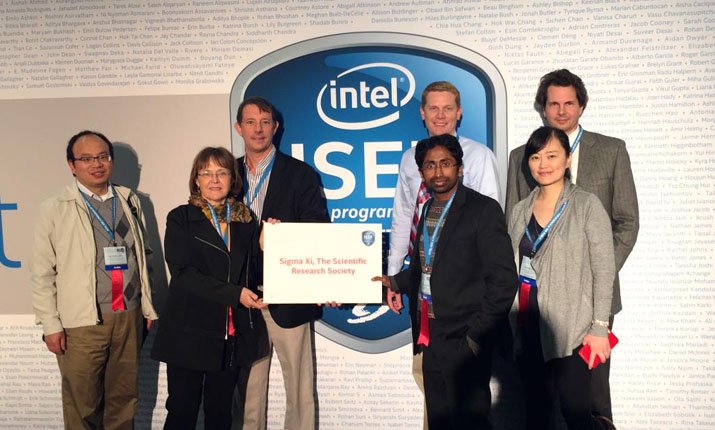
Photo: These are some of the Sigma Xi members who volunteered to select the winners of the Society’s Team Science Award.
Dr. Linda Winkler: The 2015 Intel International Science and Engineering Fair was a place of overwhelming excitement and talent, brimming with diversity, awash in talent and creativity, and a tremendous privilege to be a part of. The awards that Sigma Xi gives to team projects represent the tremendous potential of interdisciplinary work in the sciences.
As a scientist, I have spent much of my adult career supervising student research at universities and being energized by it. Therefore, I expected to greatly enjoy serving as one of the volunteer life judges at the Intel fair.
However, it quickly became apparent that this was an opportunity to see beyond the present, a spotlight into the future. As I wandered the fair exhibit halls, I was absolutely struck by the incredible wealth of potential. It was a window into the future of science and the scientists who are emerging as leaders and entrepreneurs. As I read poster after poster created by high school students from across the globe, I was struck by the similarities in “doing” good science: observation, hypothesis generation, hours of dedicated careful research, results, and interpretation. However, many of these high school students did far more in using their science to explore solutions to global problems, to seek sustainable solutions for the environment, energy and for human needs, and to create novelty.
I was in awe of all of the possibilities and new directions that were represented in the work of these 1,700 students. I would gladly volunteer again for this or other similar events and recommend that other Sigma Xi members consider it.
Dr. Winkler is a Sigma Xi member and a professor in international affairs at Wilkes University in Wilkes-Barre, Pennsylvania.
Mr. Craig Everhart: It's breathtaking to appreciate the incredible sweep of the students' work, but what surprised me was how congenial it is to work with colleagues that I met only through Sigma Xi and the judging process.
Mr. Everhart is a member of the Carnegie Mellon University Sigma Xi Chapter. He is a principal engineer at NetApp and lives in Pittsburgh.
Dr. Jamie Vernon: Sigma Xi sponsors this event as part of our mission to enhance the health of the research enterprise for the purpose of improving the human condition. By supporting these young scientists, we are contributing to vibrant research in the future.
Dr. Vernon is Sigma Xi, The Scientific Research Society’s director of science communications and publications, based in Research Triangle Park, North Carolina. He is also editor-in-chief of its magazine, American Scientist, and the Society’s interim co-director of operations.
-
by
User Not Found
| May 28, 2015
This post was written by Theodora Pinou.
On April 18, approximately 300 guests from more than 22 Sigma Xi chapters came together for the 2015 Sigma Xi Northeastern Regional Research Conference at Western Connecticut State University. The meeting was held to celebrate interdisciplinary scholarship.
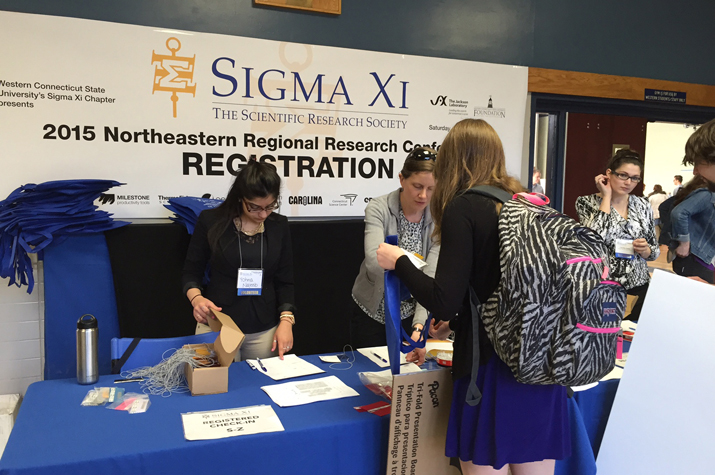
Photo: Participants sign in to the Northeastern Regional Research Conference April 18 at Western Connecticut State University.
Three keynote speakers—Dr. Kavita Ramanan of Brown University, Dr. Adam Williams of The Jackson Laboratory for Genomic Medicine, and Dr. Kent Holsinger of University of Connecticut—reinforced the importance of mathematics and computer science in scientific reasoning.
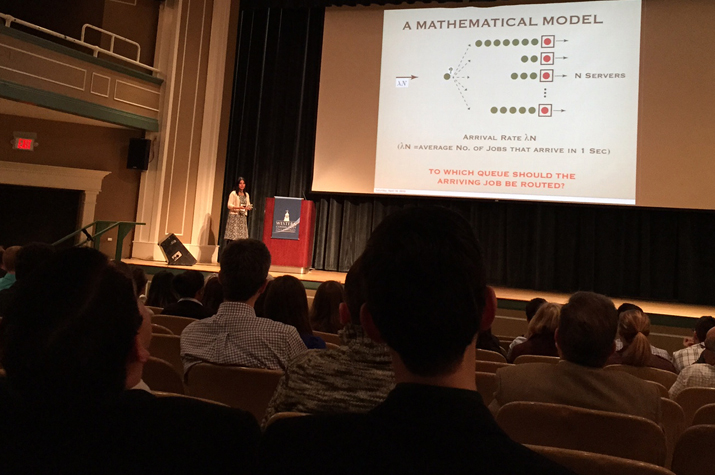
Photo: Dr. Kavita Ramanan, a professor of applied mathematics at Brown University, gave a keynote address on the power of randomness.
Researchers of more than 100 investigative projects in math, science, and engineering—and their students—shared ideas and insight that promoted science and the spirit of mentorship. Awards were given for student research posters.
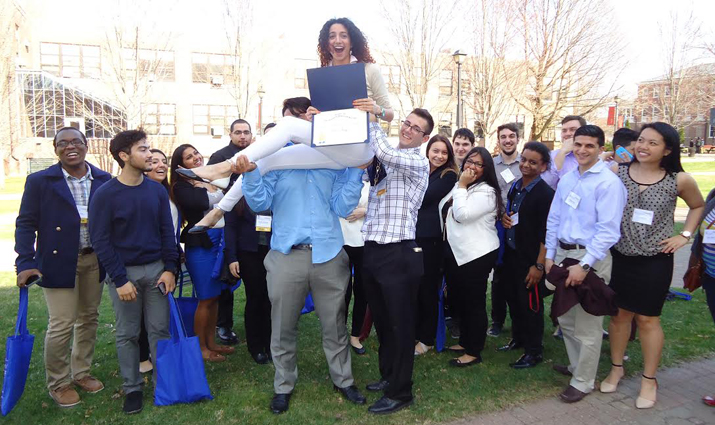
Photo: The College of Mount Saint Vincent sent students and faculty to the Sigma Xi Northeastern Regional Research Conference. Valerie Khayyo, who is holding her award, earned second place in the physical sciences category.
This regional meeting unified stakeholders from community colleges, undergraduate programs, graduate schools, and industry. The meeting highlighted the importance of the American Journal of Undergraduate Research, edited by Dr. Kestas Bendinskas, and emphasized the journal’s role in promoting the next generation of researchers.
The Western Connecticut State University Sigma Xi Chapter honored two Sigma Xi members. Dr. Bendinskas was honored for founding the Northeastern Regional Meeting and coordinating seven of these meetings. Dr. Howard Russock, professor emeritus in the Department of Biological and Environmental Sciences at Western Connecticut State University, was honored for his 40 years of service to Sigma Xi.
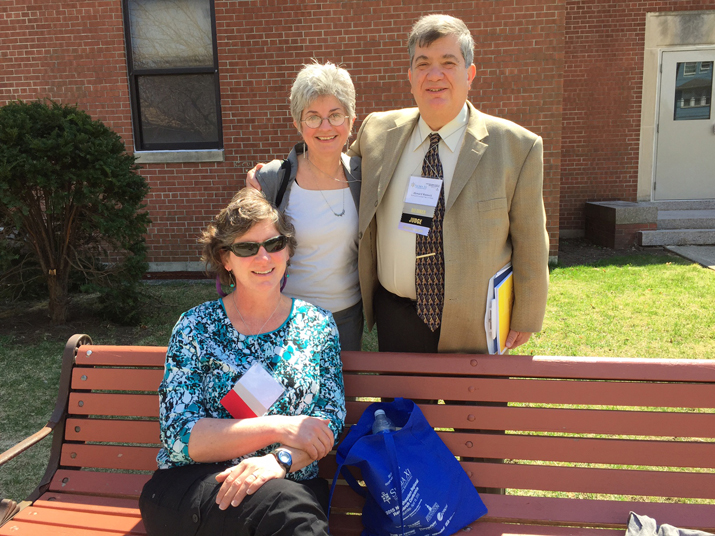
Photo: Dr. Howard Russock, on right in back, was honored during the regional meeting for his 40 years of service to Sigma Xi and his continuous support for the Western Connecticut State University Chapter.
The Institute on Science for Global Policy was represented at the meeting. Sigma Xi partnered with this institute in April to help put on two conferences so that credible scientific information could be part of the creation of effective policies.
The 2015 Northeastern Regional Research Conference was an opportunity for local scientists to come together and discuss their work. Thank you to all who attended!
Theodora Pinou is president of the Western Connecticut State University Sigma Xi Chapter and was the planning committee chair for this year’s Northeastern Regional Research Conference. She is a professor of biology at Western Connecticut State University.
-
by
User Not Found
| May 20, 2015
This is a guest post written by Sigma Xi member David Garfinkle, pictured below. He wrote this post to expand on his input to a conversation among Sigma Xi members about the "war on science."
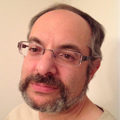
These days we scientists tend to bemoan the fact that large segments of the general public don’t believe our findings on such topics as evolution, climate change, and the safety of vaccines. Sometimes this disbelief is described as a "War on Science" but I don’t think that is quite the right term. It might be helpful to note the following: We talk a lot about reason and the scientific method, and mention that the data relevant to such issues as evolution and climate change is freely available. However, the vast majority of the general public has neither the time nor the ability to sift through those data and arrive at an independent and reliable conclusion.
 Thus, when we ask that the general public believe scientific conclusions about evolution and climate change, we are essentially asking them to trust us. And we are asking for two kinds of trust: (1) trust that we (collectively) do have the expertise to come to reliable conclusions on these issues and (2) trust that we are being honest about our conclusions.
Thus, when we ask that the general public believe scientific conclusions about evolution and climate change, we are essentially asking them to trust us. And we are asking for two kinds of trust: (1) trust that we (collectively) do have the expertise to come to reliable conclusions on these issues and (2) trust that we are being honest about our conclusions.
Why wouldn't they trust us to be honest? Well, this is an age of general distrust, and we shouldn’t expect science to be exempt. But there is another reason why (some segments of) the general public might not trust us: Polls show that on average scientists are both more liberal than the general public and less religious than the general public. It's not too large a step from that fact to the suspicion among the public that some statements by scientists might be politically or (anti)religiously motivated rather than dictated by reason and evidence. Nor does it help when such suspicions are exacerbated by various politicians and talk radio hosts.
As for suspicions about vaccines, moon landings, and genetically modified foods, it seems to me that these are based on the following well known trait of human nature: money can provide a motive for dishonesty. The large amounts spent on NASA, and the large amount of profit in the pharmaceutical industry and in agribusiness can be used to hire (or fund) many scientists. (Though admittedly the salaries and grant amounts provided to individual scientists are not large, the motive to keep that salary or grant should not be underestimated).
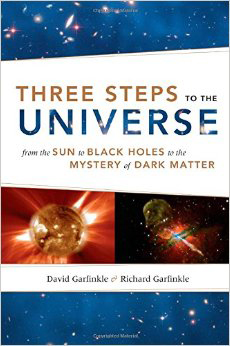 What should be done to allay these suspicions? Certainly we should do more to explain how science is done. I have written a book titled Three Steps to the Universe which explains black holes and dark matter to general readers, and also has a lot of explanation of how science is done. However, in terms of reducing suspicion, it might be even more useful to emphasize that science is not monolithic, that on the contrary scientists are a fractious bunch who often like nothing better than to prove other scientists wrong. Because of that fractiousness, in the long run it is very difficult to get away with scientific fraud. Any attempt at fraud will eventually be found out and exposed. The general availability of data and the independence of scientific researchers make it very difficult to have a “conspiracy of scientists.” Someone not part of such a conspiracy will always be in a position to find out about the fraud and blow the whistle.
What should be done to allay these suspicions? Certainly we should do more to explain how science is done. I have written a book titled Three Steps to the Universe which explains black holes and dark matter to general readers, and also has a lot of explanation of how science is done. However, in terms of reducing suspicion, it might be even more useful to emphasize that science is not monolithic, that on the contrary scientists are a fractious bunch who often like nothing better than to prove other scientists wrong. Because of that fractiousness, in the long run it is very difficult to get away with scientific fraud. Any attempt at fraud will eventually be found out and exposed. The general availability of data and the independence of scientific researchers make it very difficult to have a “conspiracy of scientists.” Someone not part of such a conspiracy will always be in a position to find out about the fraud and blow the whistle.
This general principle is well illustrated by the recent arguments between biologists and the forensic scientists of the FBI. Identification using DNA is very reliable due to the digital nature of sequences of nucleotides in DNA. Earlier methods of identification, such as fingerprints, hair samples, ballistics, etc., are much less reliable because they rely on subjective pattern recognition. Recently, FBI testimony in old cases based on hair samples has been reviewed, and the testimony of the forensic scientists in those old cases has been shown to be unreliable. This debunking of hair sample analysis is similar to the debunking done by an earlier generation of biologists and psychologists of the use of polygraph machines as “lie detectors.”
When we ask the general public to trust conclusions arrived at by scientific consensus, we are not asking them to believe that each and every scientist is a person of such sterling character as to be completely unswayed by any considerations of political ideology, religious belief, or money. Rather, we are just saying that any erroneous conclusions brought about either by mistakes, bias, or dishonesty will eventually be corrected. Thus, when a consensus in the scientific community is widespread and longstanding, it can be treated with a greater degree of trust despite the fact that individual scientists are just as subject to ordinary human failings as anyone else.
Therefore, I contend that the concept of a "War on Science" actually reflects a dichotomy of what the public thinks science is and what scientists know science to be. New scientific results are simply data for other scientists to prove false or confirm. It’s through this process that science can be trusted over time.
David Garfinkle is a life member of Sigma Xi and a professor in Oakland University’s Department of Physics in Rochester, Michigan.
Photo credit for the picture of the plaque that reads "trust": By Terry Johnston from Grand Rapids, USA (Trust) [CC BY 2.0 (http://creativecommons.org/licenses/by/2.0)], via Wikimedia Commons. No changes were made.
-
by
User Not Found
| May 15, 2015
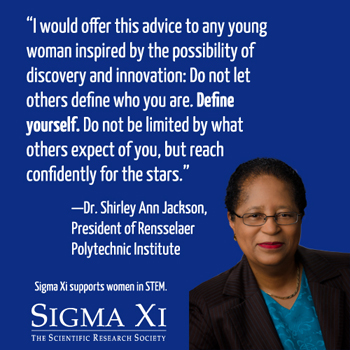 “Sigma Xi supports women in STEM”—that was the tagline you saw, placed beneath quotes from six Sigma Xi female members, on the Society’s social media accounts in March. Why did the Society need to participate in Women’s History Month?
“Sigma Xi supports women in STEM”—that was the tagline you saw, placed beneath quotes from six Sigma Xi female members, on the Society’s social media accounts in March. Why did the Society need to participate in Women’s History Month?
A pillar of Sigma Xi’s culture is diversity. The Society has recruited women to become members since its very beginning, dating back to the 1880s. That’s more than 30 years before American women could vote. Women, and other underrepresented minority groups, bring their unique backgrounds and perspectives to scientific questions.Different perspectives can lead to new theories and new results.
We know there is a gender gap in all of science and engineering. In 2013, women held 46 percent of all U.S. occupations but were in only 29 percent of the science and engineering jobs. To address this, Sigma Xi’s magazine, American Scientist, has published multiple articles about the issue.
Despite the fact that Sigma Xi supports diversity, and we’ve been talking about it, we still observe a gender gap in our own membership. Approximately 25 percent of Sigma Xi’s active members are women.
We participated in Women’s History Month, a time to honor the contributions women have made to society, to help spread the word that women not only belong in science and technology, but are desperately needed. And, we want girls to see these women in STEM so more can begin to see themselves there, too.
We asked these six female members to share their career experiences, explain why they love science, and share their thoughts on being a woman in their field. You can read their responses on our Women in STEM page.
While I was working on this project, I was contacted by one of our participating members’ staff writers. She told me that when she was growing up, people said “women don’t do science.” Separately, in her responses, Dr. Shirley Ann Jackson, president of Rensselaer Polytechnic Institute and a life member of Sigma Xi, addressed this head-on. She said, “Young women are not encouraged sufficiently to pursue scientific careers; sometimes they actively are discouraged.”
There are reasons for optimism. Despite gross underrepresentation in the fields of computer and math science (25.4 percent in 2013), engineering (14.8 percent), and physics and astronomy (11.8 percent), women in the U.S. dominate certain scientific career paths, like psychology (73.8 percent). Understanding why women are more prevalent in certain fields may lead to programs that achieve greater representation in others.
The recent focus that has been put on this problem suggests that solutions may be on the horizon. Research has identified biases that women encounter in STEM. Reports such as Stemming the Tide: Why Women Leave Engineering found women were more likely to stay in their jobs if they have supportive supervisors and colleagues as well as clear paths for advancement, among other things. We need more actionable recommendations like this to achieve institutional change. Who is going to do it? It will be a team effort, and Sigma Xi will continue to do our part.
Heather Thorstensen is manager of communications for Sigma Xi, The Scientific Research Society.
Additional reading:
“Diversity in STEM: What It Is and Why It Matters” By Kenneth Gibbs Jr.
“What is Gendered Innovations?” Schiebinger, L., Klinge, I., Sánchez de Madariaga, I., Schraudner, M., and Stefanick, M. (Eds.) (2011-2013). Gendered Innovations in Science, Health & Medicine, Engineering, and Environment (genderedinnovations.stanford.edu).
-
by
User Not Found
| May 12, 2015
This is a guest post written by Sigma Xi member Alan Emery. He wrote this post to expand on his input to a conversation among Sigma Xi members about the "war on science."

Science is only threatening when the results are inconvenient to government or special interests.
Canada’s economy has always been primarily extractive, but the current governmental focus is on fossil fuels, especially northern Alberta’s tar (oil) sands, rapid development of which has provided enormous economic benefit to Canada. Scientists noted the pollution, displacement of indigenous peoples, global warming effects, and the effects that will come of plans to situate pipelines across prime aquatic habitats and forest regions. Despite early warning signals, Canada’s present government has relentlessly promoted growth of this valuable resource. At the same time, voices of Canadian government scientists have almost been silenced on climate change, environmental protection and conservation policies or legislation, fossil fuel use, and especially on Canada’s tar sands, Arctic policies, nuclear safety, fisheries, tar sands leaks, even maternal health.
We watched as many large and important governmental research libraries were shuttered. Reports, books, and records were taken to dumps and burned. Advisory councils and positions were eliminated in scientific areas relevant to ecosystems and global warming: circumpolar ambassador; Canadian ambassador for the environment; national science advisor. Advisory councils on science, biotechnology, and technology were consolidated into one council, which now reports only confidentially. We lost Arctic ozone research and monitoring, maintenance of ice core archives, of ocean contaminants, many experimental farms, our marine toxicology program, and so on.
Elimination of the Experimental Lakes Area attracted worldwide attention. It is an internationally renowned freshwater research facility. Fortunately other sponsors stepped in, and it is presently run by the International Institute for Sustainable Development, an NGO.
Canada’s aggressive destruction of such “inconvenient science” has included changes to laws that favour select industries but are destructive scientifically. For example, changes to the Canada Fisheries Act eliminated environmental protection from all aquatic species except those valuable economically, and effectively removed ecosystem-based management of Canadian aquatic resources. A new act removed habitat protection from hundreds of thousands of lakes and rivers.
But “war” on science? There’s no war unless both sides are fighting. Remarkably, science is not fighting back. Instead, we complain about and protest the aggressive destruction of science the government believes is inconvenient to its interests. We took to the streets wearing white lab coats, wrote open letters to politicians, spoke on TV and radio, and reacted on social media. It didn’t work. We can’t fire or muzzle politicians, and we can’t unilaterally take away their funding. So how can science defend itself when it has no power, authority, or even inclination to retaliate in kind?
What would a real war look like if scientists were to fight back? Science needs powerful allies that do have the power to support science and to effect changes in policy and funding. Science must reach out to create allies by proactively developing public discourse that enlightens and enlivens without creating impossibly polarized positions. It is not enough to speak only with students, granting agencies, and university administration. Science may not be the arbiter of social justice, moral values, economic ideals, or spiritual values, but as scientists we can provide solid factual information and informed predictions based on logic and evidence. We can provide realistic risk assessments and “what if” scenarios. We can personally contribute at all levels and in all aspects of decision-making. To do that, we must bring the public into a two-way, even personal conversation about our activities, our hopes, fears, results and their implications. We can ally with science museums, and offer science education on a popular basis to the broad general public from a foundation of research, professional-level interpretation, exhibits, and outreach programs.
Some, but not many scientists are both active and effective with the public. Each time one of us interacts with news media, science has an opportunity to gain allies. But academia has not recognized we should be at war. Instead, the very structure of academia discourages public interactions. Academia rewards formal teaching, refereed technical papers, and internal committee work for hiring, promotion, and tenure. Time spent on outreach subtracts from a professor’s ability to move through the ranks. In fact, academic staff who attempt to reach out to the public are often pilloried by their colleagues, accused of losing touch with real research, or of misrepresenting the principles of science by over-simplifying. If science is to defend itself, it must dramatically restructure to effectively reward those who can and do develop alliances with broad interested and supportive publics.
Fortunately there is a not-so-impossible mechanism to restructure our reward system so that we can effectively fight back. Those folks who sit on hiring committees, judge grant proposals, decree promotion and tenure – they’re not bureaucrats, they are all academics! We can decide that science outreach is vitally important and must become a part of the criteria for hiring, promotion, and granting tenure.
As Pogo wisely told us, “We have seen the enemy and he is us.”
Alan Emery is an emeritus member of the University of Toronto Sigma Xi Chapter. He lives in Ontario, Canada.
Attribution for photo of Canadian flag: By Tony Webster from Portland, Oregon, United States (Canadian Flag) [CC BY 2.0 (http://creativecommons.org/licenses/by/2.0)], via Wikimedia Commons
-
by
User Not Found
| May 08, 2015
This is a guest post written by Sigma Xi member John Fennick. He wrote this post to expand on his input to a conversation among Sigma Xi members about the "war on science."
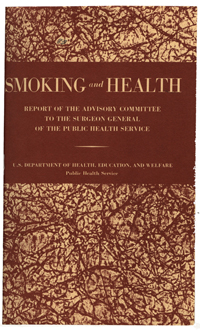
For roughly the first two thirds of the last century, scientists were heroes held in high esteem. The staggering increase in human longevity, practical elimination of tuberculosis, the miracle of antibiotics, the race to the moon, all made science wonderful. So what happened? A look at what the public hears, reads, and gets their attention will shed some light.
The fruits of science just mentioned met all requirements for public acclamation. Then, around the period of the Apollo missions, those fruits became old hat and new candidates arose. Epidemiology crept into the spotlight with the likes of The Seven Countries Study, the surgeon general's report on smoking, and the Framingham Heart Study. People fathomed: "This stuff is about my health and my life." Science was still one of the good guys.
What the public read and heard was not one or more journal articles or the surgeon general's report, but summaries and interpretations written by science reporters, screened by editors and published in the mass media. Reporters, though scientifically literate, are not experts, they must assume the scientist's reports are accurate, candid, and honest. In that time period there were few, if any, problems surrounding that assumption. The reports and their conclusions invariably considered weaknesses in the data, alternate reasons for results and frequently, caveats such as "more studies are needed." These kinds of statements properly tempered headlines and context in the daily paper and so, the reader's reactions.
Though U.S. science funding was increasing at that time, the number of scientists rose faster. For example, from 1960 to 1970 total doctorate degrees awarded increased 205 percent while constant dollar funding in research and development went up only 45 percent. In short, competition became fierce while the public became thirstier for the latest health news. Requests for journal space exploded, editors preferred shorter papers and became choosier. They developed a strong preference for articles with positive results, showing little interest for those refuting earlier studies. So reports shrank in size, candid discussion became ever more abbreviated, caveats morphed to imply beneficial or harmful consequences from meat, dairy products, pattern baldness, wine, coffee, etc. Exacerbating this was the fact that something cited as beneficial today could be declared harmful tomorrow and vice-versa. Studies with barely marginal positive results were dressed in unwarranted claims, e.g. "This work demonstrates . . ." The public was enthralled—for a time.
After years of spin-off remedies stumped by bandwagons that ultimately crashed, the public came to believe what "studies show" was rarely, if ever, true. That quoted phrase became a synonym for charlantry. The Forbes "Lies, Damned Lies and Medical Statistics" article of 1995 dramatically characterized this new attitude.
The war on science is an understandable rebellion fueled by the public's perceived "damned lies." In fact, the "lies" do not differ in character from early research reports in any discipline. They require further work and subsequent verification or rejection. But because they deal with our health and wellbeing they capture our attention and, though they emanate mostly from one branch of science, epidemiology, a scientist is a scientist is a scientist, so all scientists suffer the heat.
So who's at fault? Anyone examining this mess quickly finds the blame is wide-spread. Scientists, pushing for publication and grant renewal, squeezed for funding by competition and for space by journal editors, start the ball rolling with abbreviated reports and exaggerated claims. Journal policies reward a style that, while certainly not fraud, is marginal because of what is implied and what is left out. (What happened to conscientious reviewers?) Editors in turn are hard pressed to choose among the multitude of submitted papers, rising costs of publishing and more recently, by the proliferation of open access journals and similar online freebies.
Finally, science reporters and their editors, the public's source of health information, are squeezed by decreasing readership and falling revenue. Reporters have little choice. Pressures for column-inches are large so science news gets exaggerated as well as abbreviated. Other media suffer similar constraints.
Most curious in all this is the fact that scientists blame a "scientifically ignorant" public and we see a great push to make the public literate in science. Even if that were accomplished, would they then correctly interpret what is seen in the press or heard over the air? Of course not.
The desired return to acceptance will take a generation at least. But it must begin by scientists—in particular, epidemiologists whose work is of such public interest—returning to impeccable integrity in their writing as well as their research. They must keep in mind their audience is not just other scientists. And remember, while John Q. really doesn't care about cold fusion, vaccinations causing autism is another matter! Reports must once again be complete with all the ifs, ands, and buts accompanying all research. Funders will not penalize integrity. Editors must change their ways lest their products vanish to the likes of open access journals. Science reporters, craftsmen of the interface, have the toughest row to hoe. When these three groups reassess their tasks, this current fashion of war may revert to acclamation.
John Fennick is a member of the Virginia Polytechnic Institute and State University Sigma Xi Chapter. He is a retired member of technical staff at Bell Telephone Laboratories. Current interests include medical statistics and epidemiology. He lives in Roanoke, Virginia.
Photo: The cover page of the first report of the Surgeon General's Advisory Committee on Smoking and Health. This was released in 1964 and helped epidemiology take the public spotlight.
Additional reading:
The association between exaggeration in health related science news and academic press releases: retrospective observational study:
http://www.bmj.com/content/349/bmj.g7015
The Tragedy of the Risk-Perception Commons: Culture Conflict, Rationality Conflict, and Climate Change:
http://papers.ssrn.com/sol3/papers.cfm?abstract_id=1871503&http://papers.ssrn.com/sol3/papers.cfm?abstract_id=1871503
-
by
User Not Found
| May 08, 2015
National Geographic’s March cover called out “The War on Science,” leading to an article written by Washington Post science writer Joel Achenbach. In it, Achenbach explained why is there so much trouble with the public accepting the scientific community’s consensus on topics such as climate change, genetically modified food, and vaccines.
“It’s very clear the world of information has changed,” Achenbach said while recently talking about his article on the Diane Rehm Show. “There has been a disintegration of the old gatekeepers of knowledge. And now people get their information from the Internet, they get it from a variety of sources; it’s a small “d” democratic information world out there. And they often find exactly what they already believe and they end up in these echo chambers.”
The article prompted Dorothy Dunning, a retired member from West Virginia University’s biology department, to start a discussion in Sigma Xi’s online communityfor active members, The Lab: Members to Members.
The main themes of the discussion were:
1. Scientists want to be part of the public conversation about science but outreach efforts generally aren’t rewarded.
“Do we have a moral obligation to explain how science works? I certainly think so,” wrote Sigma Xi member Allen McGrew, of the Department of Geology at University of Dayton. “Regardless of obligation, however, we certainly have a vital stake. Why? Because the general public votes. And their votes affect every aspect of science from education to funding to public policy on things ranging from wetland preservation to whether we subsidize fossil fuel exploration or solar cells.”
Still, the academic mindset hasn’t accepted fully that engaging the public is a valuable effort, wrote Alan Emery, of Sigma Xi’s University of Toronto Chapter.
2. The public has come to distrust science but scientists might be able to do something about that.
Sigma Xi members Philipp Kornreich, of Syracuse University, and John Fennick, a member of the Virginia Polytechnic Institute and State University Chapter, pointed out that public distrust in science is nothing new. Negative articles about science, such as the 1995 Forbes article “Lies, Damned Lies and Medical Statistics” remind the public that science isn’t always right. And, like any sector, scientists aren’t, unfortunately, always ethical.
But scientists can change that by improving integrity in research, Fennick said.
“We should campaign for scientific reports that contain just the facts, uncluttered by speculation or fanciful observations and kept in perspective with honest caveats,” he wrote.
Too often today, he added, researchers, reviewers, and journal editors leave out caveats in scientific papers such as “preliminary finding” or “more work is needed.” The claims and interpretations of studies can be sensationalized and passed on to the public by science journalists, Fennick said, citing an article by Drs. David F. Ransohoff and Richard M. Ransohoff, in Effective Clinical Practice “Sensationalism in the Media: When Scientists and Journalists May be Complicit Collaborators.”
3. Sigma Xi members didn’t agree on who is responsible for distrust in science.
Journalists, journal editors and reviewers, the public, and scientists were all named as groups that need to do things differently.
4. Teaching the public about science will probably help.
While some members said that there will always be some people who will not change their beliefs, many said it is important to better educate the public about scientific results and how science works.
Kristi Multhaup, a professor of psychology at Davidson College, wants to see more dissemination of accurate information based on carefully conducted studies and, in some cases, efforts to give the public the outcome of the research they paid for with their tax dollars.
Multhaup cited Robert Sommer’s proposal of dual dissemination in which scientists would continue to publish peer-reviewed papers in scientific journals but also publish versions of their articles intended to be read by the public and published in popular outlets.
David Garfinkle, of Oakland University’s Department of Physics, added that one thing the public should know is how much the scientific community scrutinizes the findings of other scientists.
“…any erroneous conclusions brought about either by careless mistakes or by bias or dishonesty will eventually be corrected,” he wrote. “Thus, when a consensus in the scientific community is widespread and longstanding, it can be trusted despite the fact that individual scientists are just as subject to ordinary human failings as anyone else.”
5. Canadian members are already seeing a War on Science.
Canadian member Alan Emery, of the University of Toronto Chapter, said that a war on science is already happening in Canada—with cut funding, loss of science positions, and destroyed reference materials—and the only way to fight it is to work with the public.
“To combat this effectively requires that scientists and science writers engage the public in discourse that enlightens and enlivens without creating impossibly polarized positions,” Emery wrote.
We invited many of these Sigma Xi members to expand on their comments by submitting a blog post to Keyed In. We published these posts to extend this conversation to a broader audience and invite additional feedback. Read the guest posts by John Fennick, Alan Emery, and David Garfinkle.
We hope you’ll join in the conversation by sending us a comment via social media (Twitter, Facebook) or submitting your own blog post to keyedin “at” sigmaxi “dot” org.
Heather Thorstensen is manager of communications for Sigma Xi, The Scientific Research Society.
-
by
Jamie Vernon
| May 07, 2015
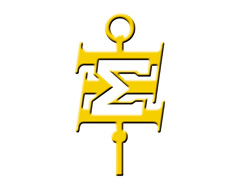 Welcome to Keyed In, the blog of Sigma Xi, The Scientific Research Society. This will be the go-to place for Sigma Xi members and others to learn about what’s happening in the science and engineering industry. We will share thoughts and perspectives related to Sigma Xi’s mission, including ideas that deal with the health of the research enterprise, integrity in science and engineering, and public understanding of science, as they contribute to improving the human condition. We will give updates about the remarkable work conducted by Sigma Xi chapters, which are spread across the globe. We will report on trends in research and anticipate where the industry is going. And, we will offer advice to young scientists and engineers. Our ultimate goal is to provide useful information that will lead to a more connected and more effective research community.
Welcome to Keyed In, the blog of Sigma Xi, The Scientific Research Society. This will be the go-to place for Sigma Xi members and others to learn about what’s happening in the science and engineering industry. We will share thoughts and perspectives related to Sigma Xi’s mission, including ideas that deal with the health of the research enterprise, integrity in science and engineering, and public understanding of science, as they contribute to improving the human condition. We will give updates about the remarkable work conducted by Sigma Xi chapters, which are spread across the globe. We will report on trends in research and anticipate where the industry is going. And, we will offer advice to young scientists and engineers. Our ultimate goal is to provide useful information that will lead to a more connected and more effective research community.
Over time, we expect this single blog to expand into multiple specialized blogs that address more defined topics. We look forward to that period of growth. For now, we will regularly publish posts on a variety of topics that we hope you will find to be interesting.
This blog will be a team effort, written by Sigma Xi members, staff, and others who volunteer to bring this information to you. Some of the blog posts will be based on conversations happening in Sigma Xi’s online Member Communities. We expect Keyed In to provide an opportunity to engage a broader audience and invite additional feedback on these matters. We will treat this as a conversation among friends and colleagues, so please leave a comment or send us a message via social media (Twitter, Facebook).
We will monitor the conversations surrounding the blog posts and we will remove comments and block commenters who use profane, obscene, abusive or otherwise inappropriate language. Our community guidelines will reflect those of our American Scientist blogs.
Content provided by non-staff authors will be treated according to Creative Commons Attribution-NonCommercial-No Derivs license. Posts by Sigma Xi staff are protected under Sigma Xi copyright, but may be shared under the same attribution-required-no-derivatives conditions as the Creative Commons license.
The opinions expressed in Keyed In blog posts are those of the author(s). Blog posts do not reflect Sigma Xi, The Scientific Research Society’s policy, endorsement, or action, and Sigma Xi does not verify the accuracy or science of the contents of the blog. However, we reserve the right to disqualify or reject a blog submission under our editorial discretion.
If you’re interested in writing for this blog or would like for us to address a specific topic, please send a message to us at keyedin “at” sigmaxi “dot” org.
Now, let’s get the conversations started!
Photo: This blog is named after Sigma Xi's key, an iconic symbol of the Society.
Jamie Vernon is Sigma Xi's director of science communications and publications. He is also editor-in-chief of the Society's magazine, American Scientist.